2016 Chevrolet Volt: What's It Like to Live With?
Read the latest updates in our long-term road test of the 2016 Chevrolet Volt as our editors live with this car for a year.
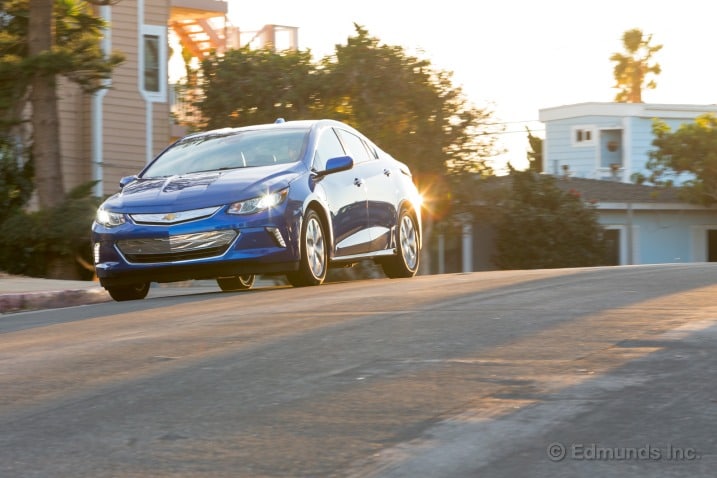
What do you want to know about?
- Introduction
- Paddle Versus Pedal
- Tech Now Seems Mainstream
- Santa's Blue Sleigh
- Three Ways to Brake
- High Liftover Height
- Awkward Dead Pedal Placement and Seating Position
- 70 Miles on a Charge — The Range Wars Begin Again
- Using the Brake Paddle Correctly
- Why I Didn't Buy One
- Quiet As a... Well, It's Just Quiet
- A Squeaky Quiet Cabin
- Electric Range That's in the Ballpark
- Impressions From a Vegas Hustler
- Love the Color
- Range King — For Now
- Give Me a Wipe
- Cargo Cover Hook Malfunction
- An All-Electric Week in a Plug-in Hybrid
- Performance Tested - A Deep Dive Into the Numbers
- Drilling Holes for a License Plate
- Every Car Should Be Like This
- Has a Real Engine and It's Good
- MyLink Android Auto Update
- Electric Range Games
- Still Has a Mountain Mode, but Seems Less Necessary
- Could Reduce the Guilt for Driving To Get the Mail
- How Efficient Is It as an EV?
- For Better or Worse, It Blends Right In
- 5 Reasons You'll Like the MyLink System Interface
- Brake Pedal Feel Is Consistent, Easy To Modulate
- Charge Time Surprise and the Importance of Power
- Well-Suited for Longer Road Trips
- Comfortable for Commuting
- Simple Controls on a Complicated Car
- 600 Miles of Driving Impressions
- Will the Luggage Fit?
- 2016 Chevrolet Volt vs 2016 Chevrolet Malibu Hybrid
- More Traditional Design Is an Improvement
- More Range Than You Might Expect
- It's Not a Five-Seater
- Using a Brand X Level 1 Charge Cord
- Xbox Mod For the Volt
- Quiet When You Need It
- Poor Rear Visibility
- No Place in the Future for Physical Media
- Smooth Service
- Greatly Improved For 2016
- Decent Rear Seat Comfort For Adults
- Mostly "One-Pedal" Driving Figured Out. But Is It Worth It?
- Interior Quality Disappoints
- Monthly Update for October 2016
- Monthly Update for November 2016
- Monthly Update for December 2016
- Trying Out the EV Life
- The Modern Driveshaft Tunnel
- Monthly Update for January 2017
- EV Life, Part 2
- Monthly Update for February
- Monthly Update for March 2017
- Monthly Update for April 2017
- Monthly Update for May 2017
- Another Flat Reminds Us Why Spare Tires Are Good
- Monthly Update for June 2017
- Monthly Update for July 2017
- Monthly Update for August 2017
- Monthly Update for September 2017
- Wrap-Up
Introduction
What Did We Get?
If you don't think General Motors has cutting-edge technology, you haven't been paying attention.
Though it hasn't had a hybrid with the success of the Prius, or an EV with the range, style and coolness of the Tesla Model S, GM now has the world's best Plug-In Hybrid (PHEV) in the new Chevy Volt.
All 2016 Volts start with the second-generation Voltec powertrain. The meat of the system is an 18.4-kWh battery pack powering two electric motors. The new batteries have more power than the old Volt, but they also get more help from the new internal combustion engine. Gone is the 84-horsepower, 1.4-liter engine that required premium fuel and returned middling fuel economy. In its place is a spiffy new 1.5-liter engine that runs on regular fuel, makes 101 hp and returns 42 mpg. It works in a new way, too. Instead of simply acting as a generator when the batteries are spent, the new setup uses the gas engine to propel the vehicle like a typical hybrid.
What Options Does It Have?
The 2016 Chevy Volt is available in two trim levels, LT and Premier. The base LT starts at $33,995 and includes a standard backup camera, 8-inch Chevrolet MyLink touch-screen, keyless entry, automatic climate control, dual USB ports and remote start.
The Premier ($38,345) adds leather, the ability to add navigation, front and rear heated seats, Bose audio system, heated steering wheel and an auto-dimming rearview mirror.
Opting for the Premier trim also opens the door to the optional forward collision alert, lane keep assist, rear cross-traffic alert and side blind-zone alert with lane change alert.
Since this isn't just a test of the powertrain, but the whole car, we picked the Premier and added options. Driver Confidence 1 Package ($495) adds the side blind zone and lane departure alerts and rear cross-traffic alert. Driver Confidence 2 Package ($495) adds lane keep assist, front automatic braking at low speed, Intellibeam headlights and forward collision alert. Further options include $495 for navigation, $395 for the Kinetic Blue paint, $225 for the illuminated charge port, $110 for an all-weather cargo mat and $60 for a cargo net because the Volt still doesn't have a real cargo cover.
All in, this 2016 Chevrolet Volt Premier Hatchback wears a sticker price of $40,620.
With either trim of the Volt, you qualify for up to a $7,500 federal tax break.
We purchased our Volt at Selman Chevrolet for $38,114 thanks in part to a $1,000 rebate.
Why We Bought It/Why We Got It?
Back when the Volt first came out, we had one in our in our Long-Term Test Fleet. We drove it for 13 months and put 15,063 miles on it. During that time we averaged 37.2 miles on EV range and 35 mpg out of the old-tech, iron-block gas engine. According to our calculations, 42 percent of our time was spent in EV mode.
At the end of the year, our "Cons" were few. It needed premium fuel. The brake pedal felt odd. The center stack was dumb and buttonless. The backseat only held two adults. It didn't have power seats and the spoiler scraped on everything. Not only did GM fix items 1, 2, 3 and 4 (5 and 6 are still present), but the 2016 Volt improves on things we had in the "Pros" column.
Ultimately, we concluded, "The 2011 Chevrolet Volt's medium-size battery gives it a decent amount of electric range, and you can use all of it every time because the gasoline engine allows the Volt to continue on like any normal car. Paradoxically, this is simultaneously the Volt's greatest strength and biggest weakness because the ability to manage this trick essentially requires two advanced drivetrains, with all the extra complexity, packaging difficulty and cost that implies. This, of course, is the first vehicle of its kind, so these weaknesses are likely to disappear — especially since the concept has so much promise."
And that's where we are today. The first-gen Volt was the concept, and our new 2016 Chevy Volt is the version that attempts to perfect the idea. Our initial driving impressions were positive, now it's time to see if that holds up over time. Follow along on our Long Term Road Test page to find out if this Volt delivers on the promise of the plug-in hybrid.
Edmunds purchased this vehicle for the purpose of evaluation.

There are many things to like about our new long-term 2016 Chevrolet Volt. For one, the general consensus is that it's an attractive car. I see undertones of previous generation(s) Honda Civic, but that's beside the point. I'm also impressed by its electric-only range. I could exist quite comfortably under its 53-ish-mile ceiling for the majority of the week, which means far fewer pesky stops at the pump. Single-occupancy carpool lane access also a huge plus.
One thing I haven't quite wrapped my head around though is how Chevy decided to integrate a control for maximum regenerative braking. It's the steering wheel paddle on the left, and its reason for existence is questionable at best.
Chevy has a recent habit of assigning unconventional functions to steering wheel paddles. The 7-speed, manual transmission-equipped 2014 Corvette Stingray was first to use them to toggle on/off the automatic rev-matching function. And on the other back side of the Volt's steering wheel are two large buttons, sizeable enough to at least be pseudo-paddles. Those nifty things are volume control buttons. The functions these buttons perform, however, happen to work well so there's no argument there.
The issue with the regenerative braking paddle is that it's an on/off switch, with no ability to vary the level of regen you dial in. It's all or nothing, which makes it a guessing game approaching every red light. Also, the slowing effect of the paddle is significant enough that it activates the brake lights every time you press it, but it won't actually bring you to a complete stop.
So as you gradually become better at timing your paddle-braking pulls, expect to be putting on a few light shows for the lucky cars behind you.
This begs the question of why the full generative braking function wasn't incorporated into the throttle pedal like it is the BMW i3. Lift off the throttle completely means max regen. Lift off the throttle partially, partial regen. It's a function that takes some adjustment initially, but makes complete sense in practice.
My supposition for Chevy not going the BMW route has to do with our Volt being a plug-in hybrid instead of a dedicated EV. Perhaps there are some challenges with this layout when operating in a hybrid mode. If this is the case, the regen paddle needs to be variable, even if it's just one more level at 50 percent without activating the taillights.
Until then, I'll stick to the brake pedal.
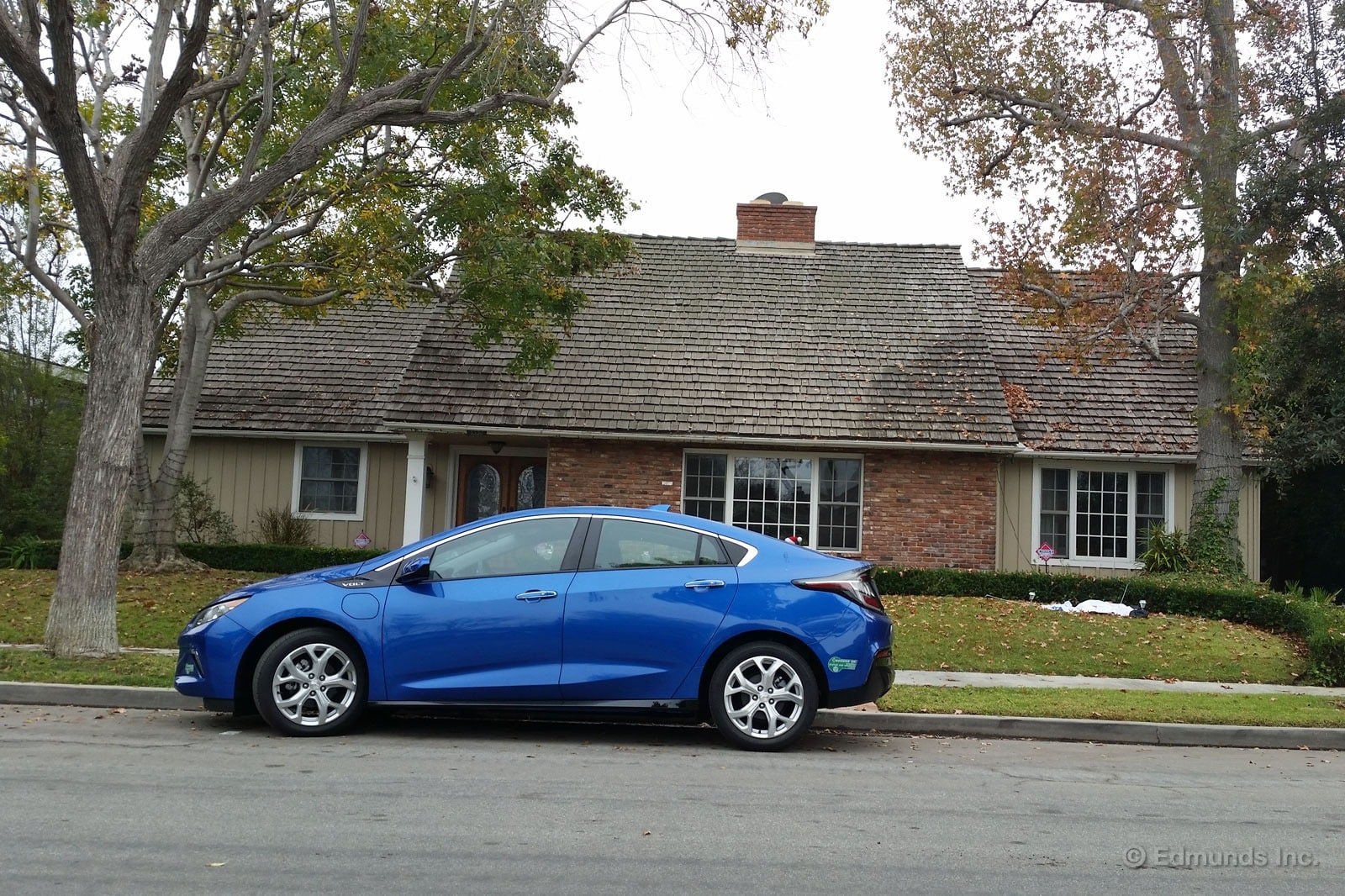
Back in 2011, when we took delivery of our first long-term Chevrolet Volt test car, the Chevy seemed so glamorous and high-tech. Until then we were mostly driving around in hybrids that looked like hybrids (read Toyota Prius), and the Volt seemed like a far more exciting option.
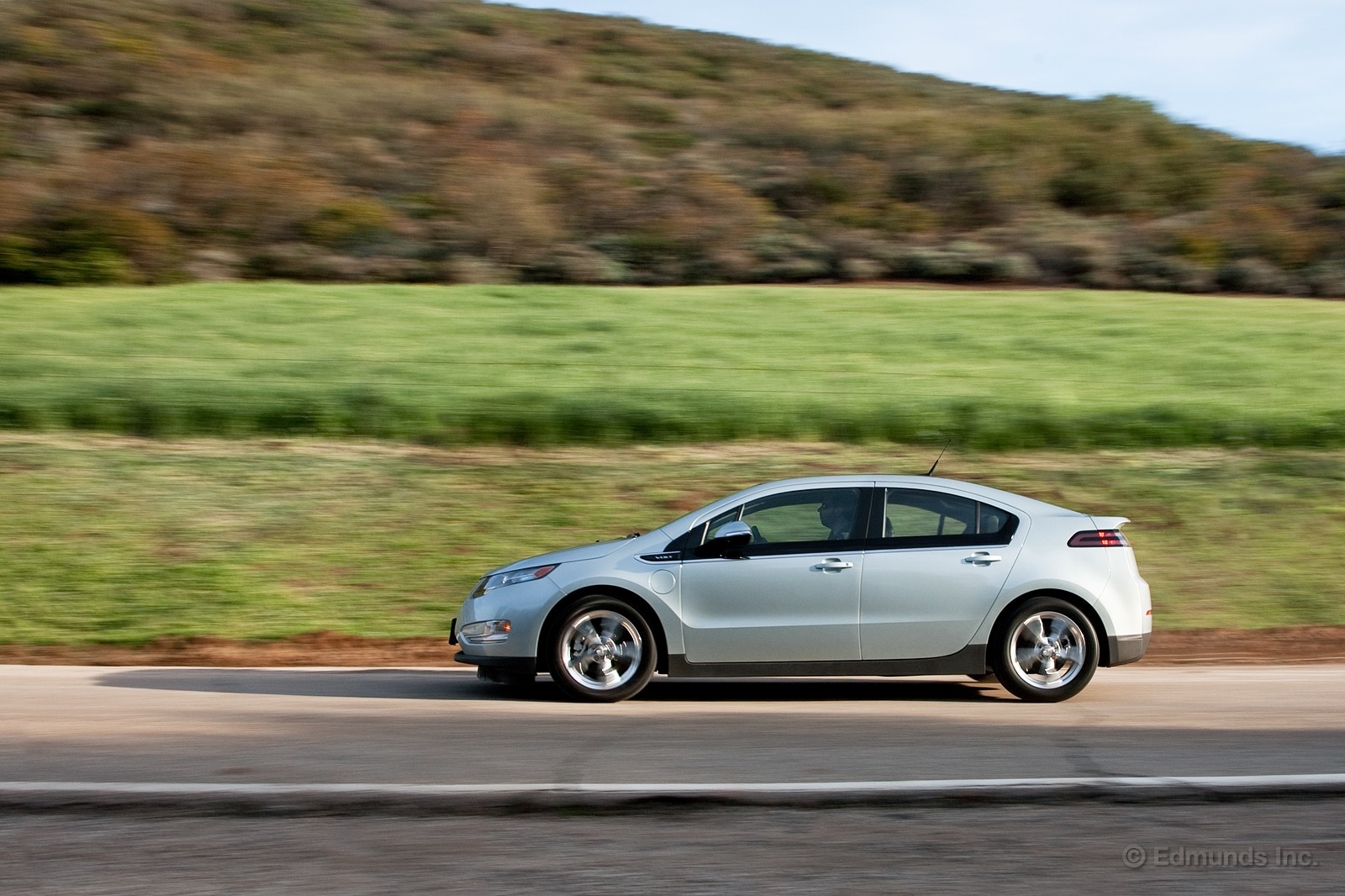
Fast forward a mere five years, and our new 2016 Chevrolet Volt test car doesn't feel so foreign anymore. We're all used to pushbutton start, plugging-in and watching for the "switchover" indication that you've just moved from electric power to gasoline.
Sure, the Volt's driving range has grown, but so have our expectations. With more alternative-fuel vehicles on the market, including the BMW i3 we're currently testing, the 2016 Volt faces more competition, and perhaps a tougher audience, this time around.

With the key to our new 2016 Chevrolet Volt in my pocket, I headed out to the garage to take a good look at the Chevy's cargo capacity.
Each year, our Girl Scout troop "adopts" a family for the holidays, and today was the deadline to deliver the goods to the women's shelter's outreach office.
"Not terrible," I thought, as I popped the hatch, opened the rear doors, and started to fold forward the Volt's 60/40-split rear seats.
Chevrolet lists the Volt's official cargo capacity as 10.6 cubic feet with all seats in place, but as I was driving solo on this mission, I didn't need to worry about saving room for passengers.
Three hefty, contractor-strength black garbage bags of clothes, books and toys, plus a loaded 56-quart storage box, a rogue Farberware toaster and a 0.9 cubic-feet microwave oven (in a lovely shade of....red?) fit safely in the Volt's rear cargo area, ready for transport.
Hopefully, this Volt-full of gifts helps make one family's holiday season a bit more merry and bright.
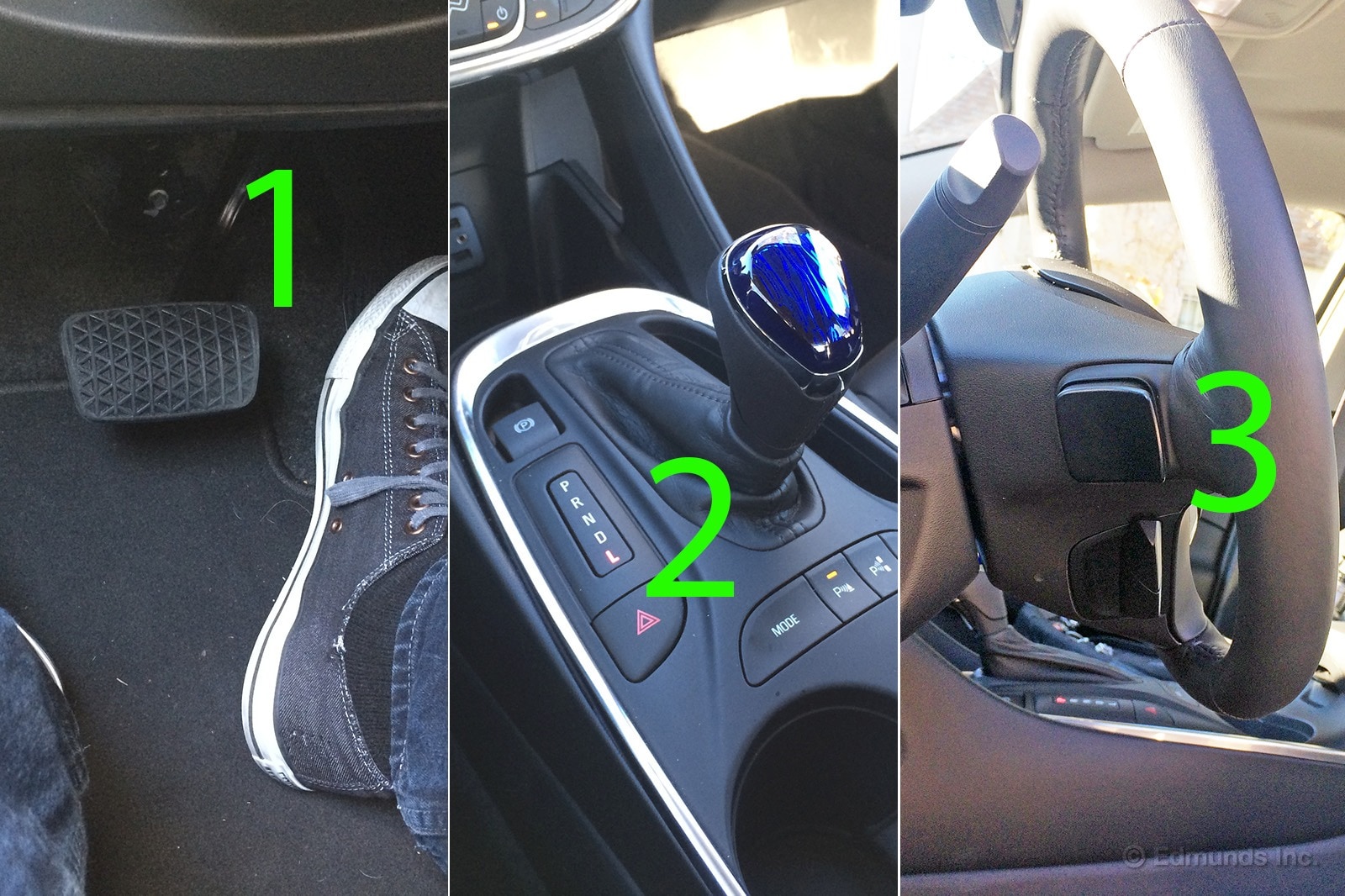
"That's one way to brake! Two ways to brake! That's, three! Three ways to brake, mwah hah hah hah!"
And so would go the Count's review of the 2016 Chevrolet Volt.
The first would be the old-fashioned way: push down on the big fat middle pedal.
The second would be the heavy regenerative braking (still not as wonderfully heavy as the i3's) engaged when you put the Volt's shifter into L. Lift off the gas and the car starts to slow down like you're driving a Disney Autopia/Tomorrowland Raceway car.
And the third is new to the Volt and borrowed from the Cadillac ELR. That big steering wheel paddle, only on the left side, engages even heavier regenerative braking when pulled.
I've found myself using all three at any given time, usually in the order of 2-3-1, with the old-fashioned one only used as a last resort when a complete stop or heavy braking is needed. It's honestly a bit of a juggle, but it's also rather involving, curiously enjoyable and nice in traffic since it cuts down on the need to constantly pivot my foot back and forth. Plus, it's not like you have to use anything beyond No. 1.
Not to put any crazy ideas into the head of our Director of Vehicle Testing Dan Edmunds, but I'd also be interested to test if one of these braking means (or a combination of them) is more efficient than another at maintaining/recharging the battery. My money's on the combo.
Oh! I just thought of a fourth! The electronic parking brake!
"That's four, four ways to brake! Mwah hah hah hah!"
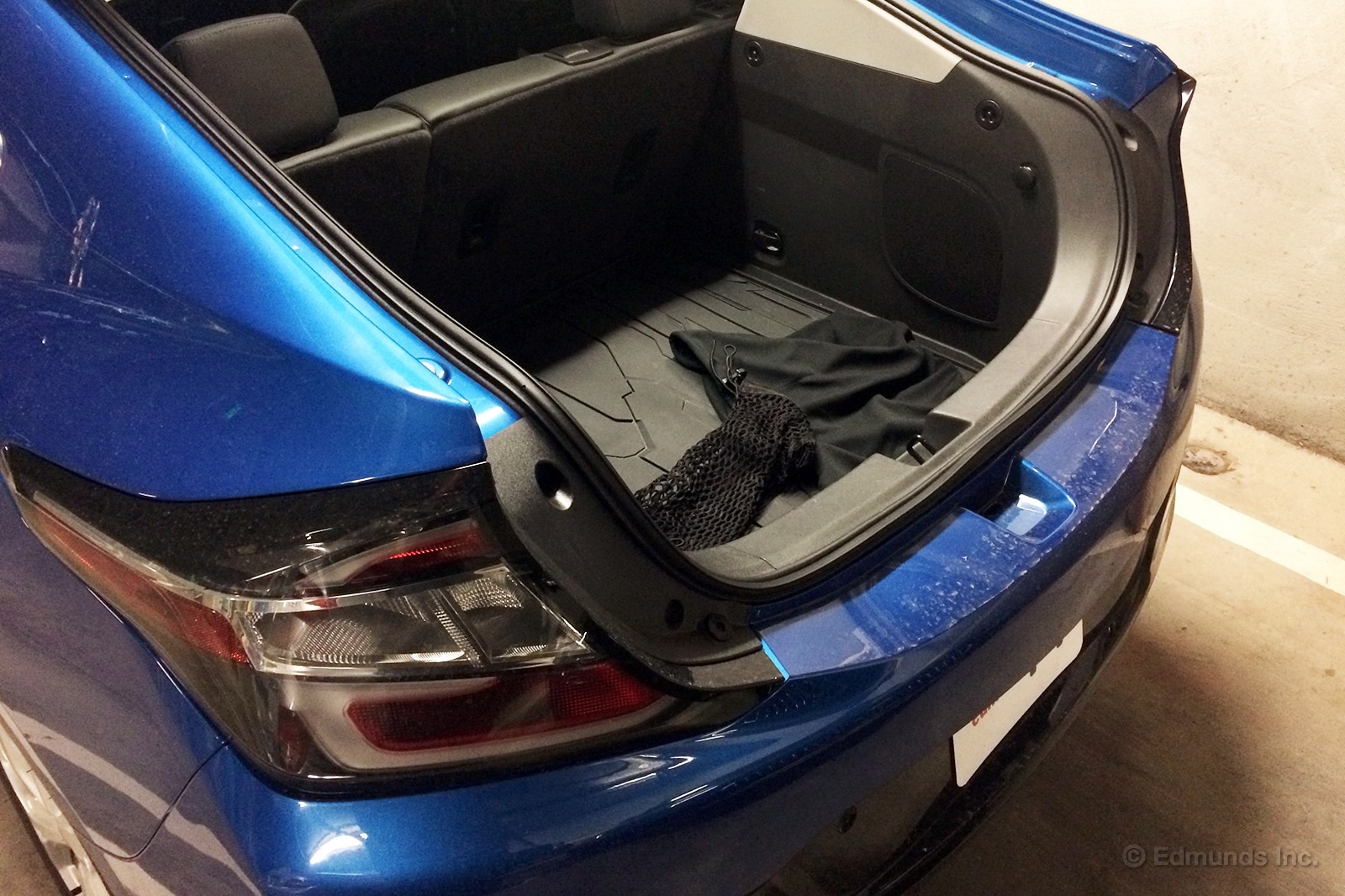
Yes, the 2016 Chevrolet Volt is a hatchback. Yes, consequently it has a more versatile cargo area than a compact sedan. Unfortunately, unlike other hatchbacks, the Volt has a significant liftover height. One must hoist whatever up and over the bumper and then lower it onto the cargo floor.
In a way, it's almost more like an old-school hatchback (hmm, if only we had one of those around) than the truncated wagons modern hatches have become.
Awkward Dead Pedal Placement and Seating Position

I always remember being comfortable in our long-term 2010 Chevrolet Volt. Not so with its successor. I find the 2016 Chevrolet Volt's driver seat is mounted too high, or rather, I can't crank the rear portion of the seat bottom down enough using the manual height adjustment. And unfortunately, there is still no power driver seat available, which strikes me as odd given how much other equipment is available.
Another issue is the dead pedal. I find it's at a slightly awkward angle and not on the same plane as the accelerator. As a result, I find myself resting my foot just a bit further ahead on the firewall. It's not ideal, but it is more comfortable.
This is all rather unfortunate because I would otherwise find the Volt to be an extremely pleasant commuter car.
70 Miles on a Charge — The Range Wars Begin Again

Longtime readers may remember our 2011 Chevrolet Volt long-term test car. You may also remember that Magrath and I got into a cut-throat maximum range competition. I ended up winning that no-holds-barred geek-off with an all-electric run of 54.6 miles, a figure that exceeded that Volt's 35-mile electric range rating by a full 56 percent.
My commute tends to have the right conditions for prolonged EV range; primarily, slow-and-go freeway traffic that never quite stops, never quite gets going faster than 50 or 55 mph. So I applied all the lessons I learned driving the old Volt and promptly went 70 miles on a full charge in our new 2016 Chevrolet Volt on my first attempt.
Your move, Magrath.
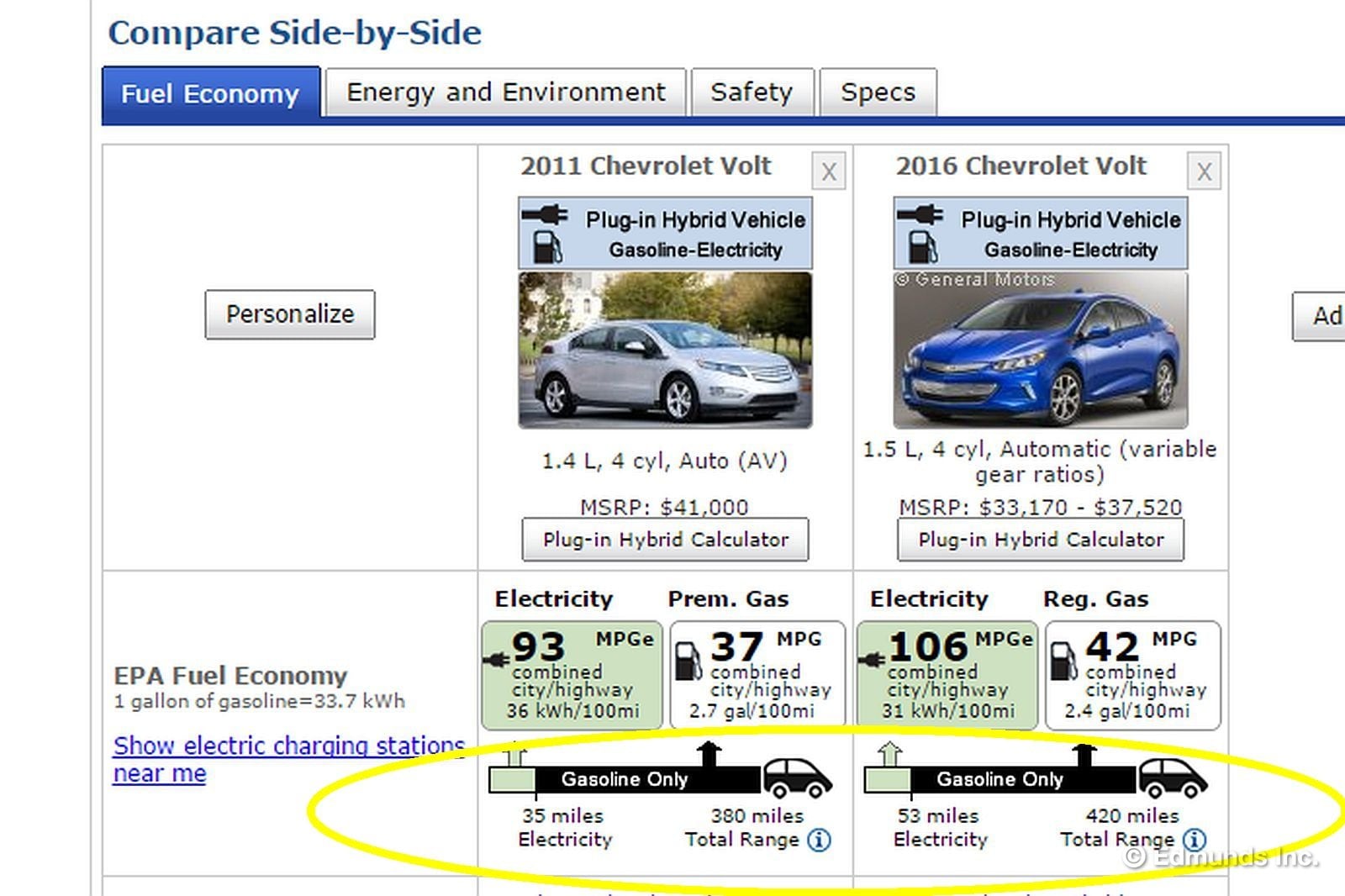
I fully expect that number to fall. Seventy miles in the new Volt is not as impressive as 54.6 miles was in the old one. The new Volt's rated EV range is 53 miles on a charge, a very useful and transformative increase of 18 miles. What this means, though, is that I only beat the new rating by 32 percent.
But I don't need to break down the numbers to know there's more in there. It felt like I could do better. I have almost a year to find out.
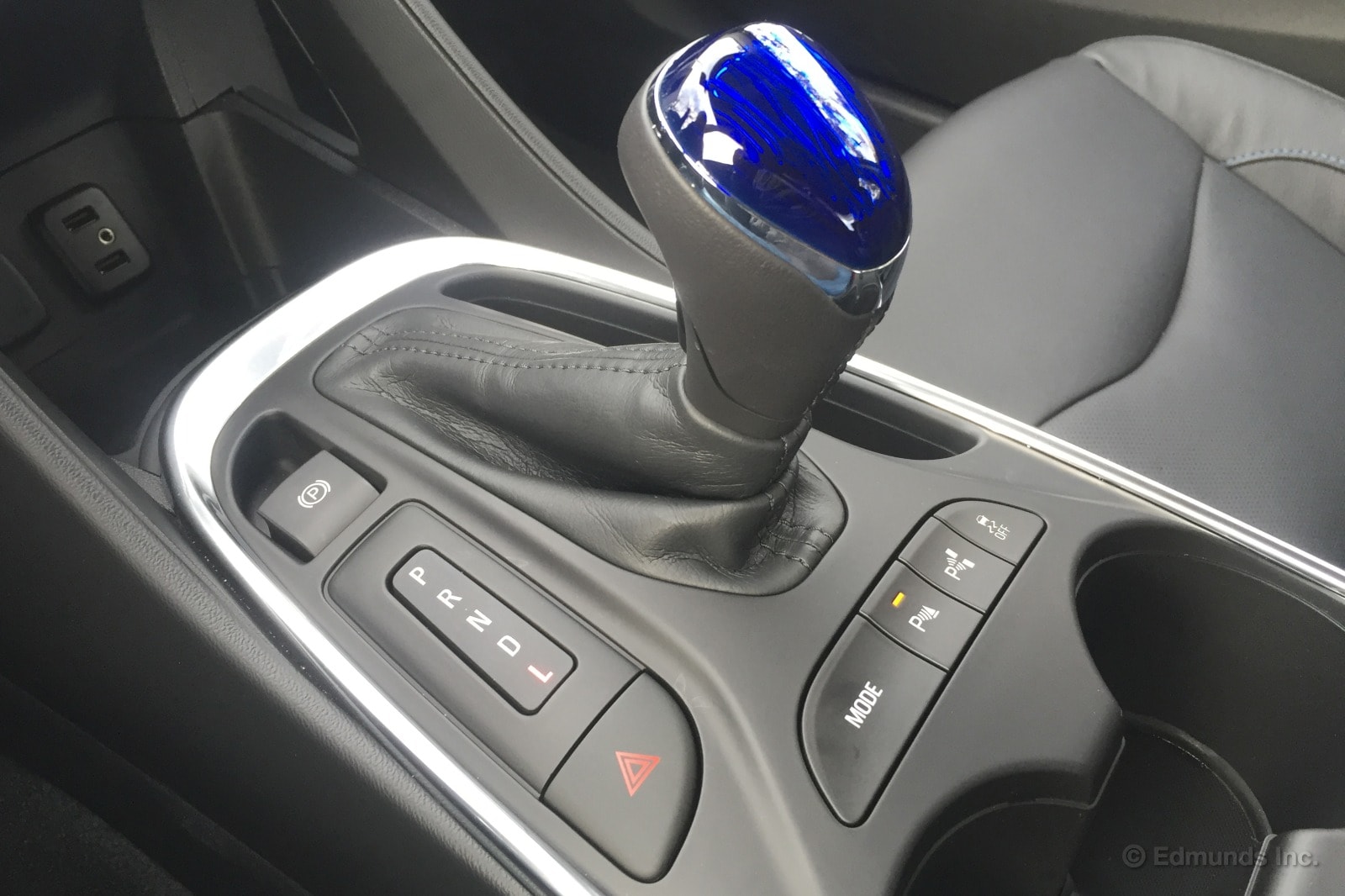
Scroll down and you'll notice a few posts about the curious brake paddle on the steering wheel of our 2016 Chevrolet Volt. I should have read the blog before I signed the Volt out for a week, as I was utterly confounded when I pulled the paddle for the first time and nothing happened. Note that I played with the paddle when the car was stopped and the transmission selector was in the typical "D" drive mode.
I tried it several more times. No lights or messages on the dash. No noticeable difference in the way the car drove. I paged through the owner's manual and read that the paddle activates the "Regen on Demand" feature. I assumed it toggled brake regeneration between unobtrusive and halting, like the menu setting in our old long-term 2013 Tesla Model S.
But the Volt always came to a stop in the same way. Lift off throttle and the car coasted until I hit the brakes. I thought the paddle was broken. Then I tried using it when the car was in motion.
And I instantly flashed back to my first time behind the wheel. The paddle triggers the Volt's most aggressive regenerative braking setting, and it slows the car rapidly. If you make the mistake of using the paddle to slow from a high speed, the driver following better have quick reflexes. I had no intention of starting my Christmas staycation with an accident, so I left it alone.
It wasn't until I read James's post about the multitude of ways to brake that I revisited the paddle, this time with the transmission in "L". Rather than cruising on throttle lift-off like in a normal car in "D," the Volt exhibits the regenerative braking feeling we've all come to know and love in hybrid and electric vehicles. When you pull the paddle in "L" after lifting your foot off the throttle, the slowing effect is much less severe since the car is already slowing. It feels similar to when you press the brake pedal harder in the last few feet of a regular stop.
Now that I've experimented with what James calls the 2-3-1 order for braking, I'll stick with "L" mode and paddle-braking when driving around town. Since minute variations in throttle position produce a profound effect on velocity in that mode, I'll go with "D" for highway driving.
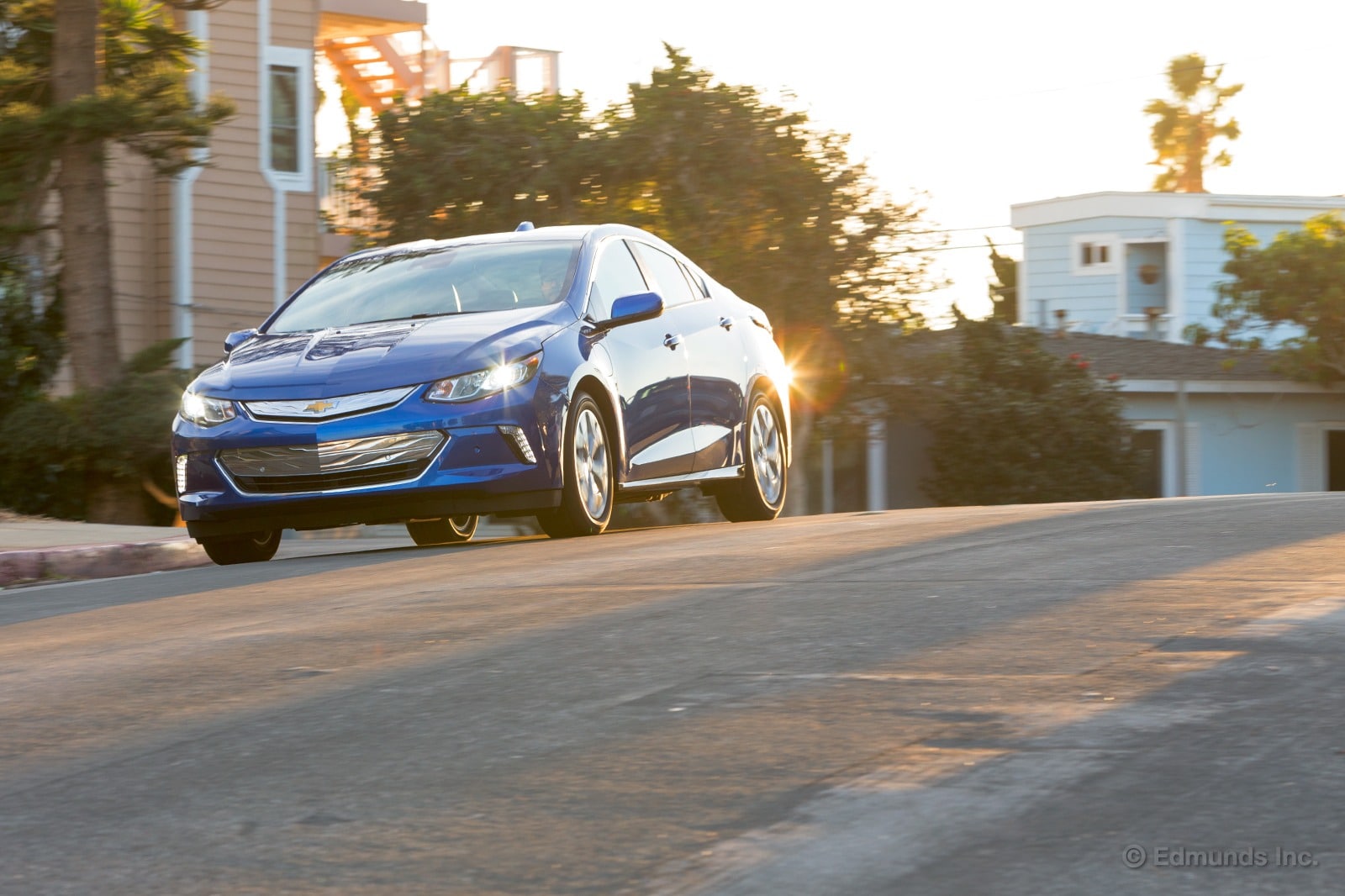
Access to our long-term fleet is usually awesome, but once in a while it just gets tiring. Having a clean car every night is great. Having to bring your gym bag up to your desk, along with your parking pass, all your change, and whatever other miscellanea has accumulated is not.
And then you've got to worry if the person who has the car you want will be in the office by the time you want to leave. Or if they've gassed it. Or if they wear terrible cologne. I had a string of bad luck and was ready to trade out of the fleet and into my own new daily driver. So a few weeks ago, before we bought our long-term 2016 Chevrolet Volt, I walked into a Chevy dealer to buy one for myself.
I didn't.
Let's first look at why I would like to own a Volt: The powertrain. I live in an urban area, have a 16-mile round-trip commute, and rarely see speeds above 35 mph. I've got chargers at my home, office and frequented shopping centers and I've got disposable income. I'm the ideal EV candidate except that I like road trips and I'm not always so good at paying attention to charge level. That's why the Volt is so exciting. On paper, it's perfect for me.
So I walked into a local Chevy dealer excited. I hadn't driven the Volt before, but Dan had and he liked it. That's a solid recommendation. The salesman and I headed out to the lot to inspect their first delivery of Volts. We hopped into a blue one that was nearly identical to our long-termer and that's where things started to go wrong.
Let's save us all some time and just do this as a list. Some of the items are deal-breakers (labeled DB) on their own. Others simply coalesce into a big pot of nope.
1: Seats: Seat bottoms are too short, as in two hand-widths from seat bottom to my knee short. No adjustability in that area. (DB)
2: Forward visibility: Not great. The front of the car is out there. Somewhere. It's got parking sensors that help, but I'd like a little more actual visibility.
3: When you shift into drive, the Volt locks itself. I don't want a car to do that to me. There's no way to turn this off. (DB)
4: There's nowhere to put my arms. Just like with the Corvette, GM doesn't want my arms to have any space. On every turn, I thwacked either the center console or the armrest with an elbow.
5: Too much chrome. Outside and inside.
6: Ride's not great over bumps. We pay all the taxes in the world here in California and the roads are all terrible.
7: The front air dam scrapes over EVERYTHING.
8: There's no way to turn off the air-conditioning. You can disable it most of the time, but if the battery needs A/C, the whole car gets A/C. We've got cars today with multiple zones of climate control, each with its own fan speed. In the Volt, I'm at the mercy of a battery's temperature fluctuation.
9: Interior quality. All of the money spent on the Volt went to the powertrain and chroming some interior bits. The shifter feels hollow, the switches aren't great and the whole thing has a very low-rent feel. I could live with it, but I'd rather not. (DB)
10: Style. Subjective sure, but this thing is tacky. Cool it with the surface treatments and brightwork, GM.
11: Stupid regen paddle. As Mr. Elfalan said, the Volt has a regen paddle instead of an aggressive regen system built into the brake pedal itself. Lifting off in the Volt is like lifting off in a normal car, not an EV. Further, the trouble with the paddle is that a brake pedal has many degrees of modulation and your foot is really good at using it. The paddle is on/off. It's like stabbing the brakes. VW's multi-stage, paddle-adjustable regen is an example of how to do this right.
So that's why I didn't buy a Volt. I thanked the salesman, told him there wasn't a sane lease rate low enough to get me into one (though he made a heckuva good attempt) and moved on with my life.
I still like driving ours when I get the chance, as this is the perfect powertrain for my lifestyle. Unfortunately I just don't like the car itself, at least not enough to put my own money on the line. Maybe if gas was $11 per gallon or if charging took six minutes, I'd be more willing to sacrifice. For now, my money's sitting around, waiting for someone to cram the Volt's powertrain into an i3.
To answer the question as to why I didn't buy an i3: too few gasoline miles and a weak motor. The i3 barely climbs out of Los Angeles. No way it's getting me to San Francisco, Vegas or Death Valley. The Volt could.
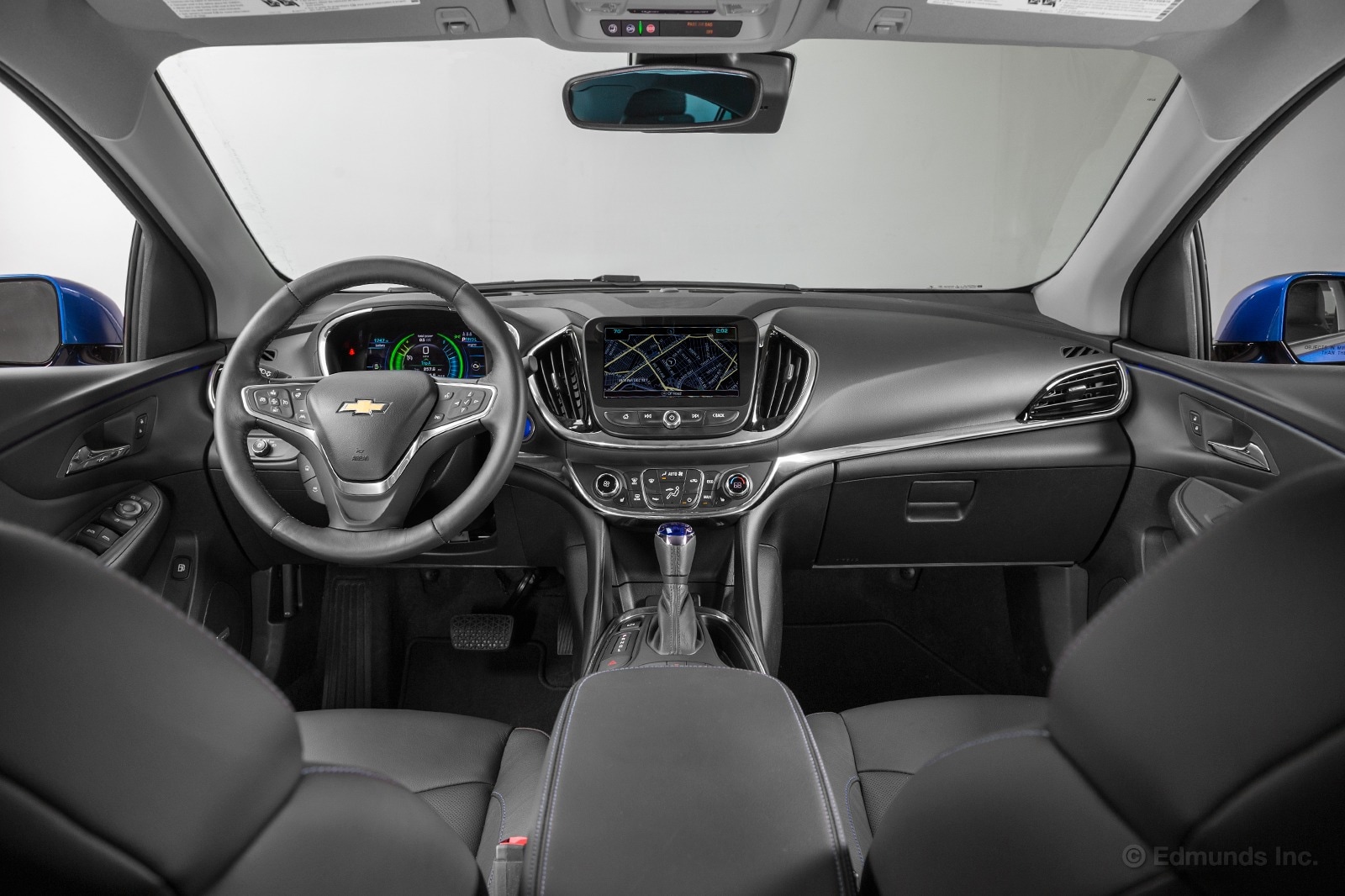
The 2016 Chevrolet Volt is quiet. That's one of the first things I notice about it during my first minutes behind the wheel. It's not silent in that "quiet like a vault" way that auto-journos like to use when describing large German sedans. There's still wind, road, and eventually engine noise, at least on my drive, which started with about a half-battery of charge and switched to engine for the rest of the way.
But it's still noticeable how the highway and engine hum is nicely damped and attenuated in the new Volt. When we decibel-tested our former first-generation long-term 2011 Volt, it generated 64.5 dB at a 70 mph cruise and 47.9 at idle. Not bad numbers, but more than you'd like from a car of the future. By comparison, a BMW 528i of the same vintage made 62.7 dB at 70 mph and 41.4 at idle. An Audi A4: 63.7 at cruise, 40.4 at idle.
The first Volt's grainy tractor engine sound, and the boisterous way it announced its handover from the electric motor, was one of our main gripes about it. We haven't track-tested our new Volt yet to compare, but my front seat impression is that Chevy took the last Volt's NVH seriously, either layering more sound deadening on the panels, refining engine sound (especially at handover from the electric motor), dialing out some frequencies in the suspension, or some other resonant voodoo.
Whatever they did worked. The Volt is a nice place to hear yourself think.
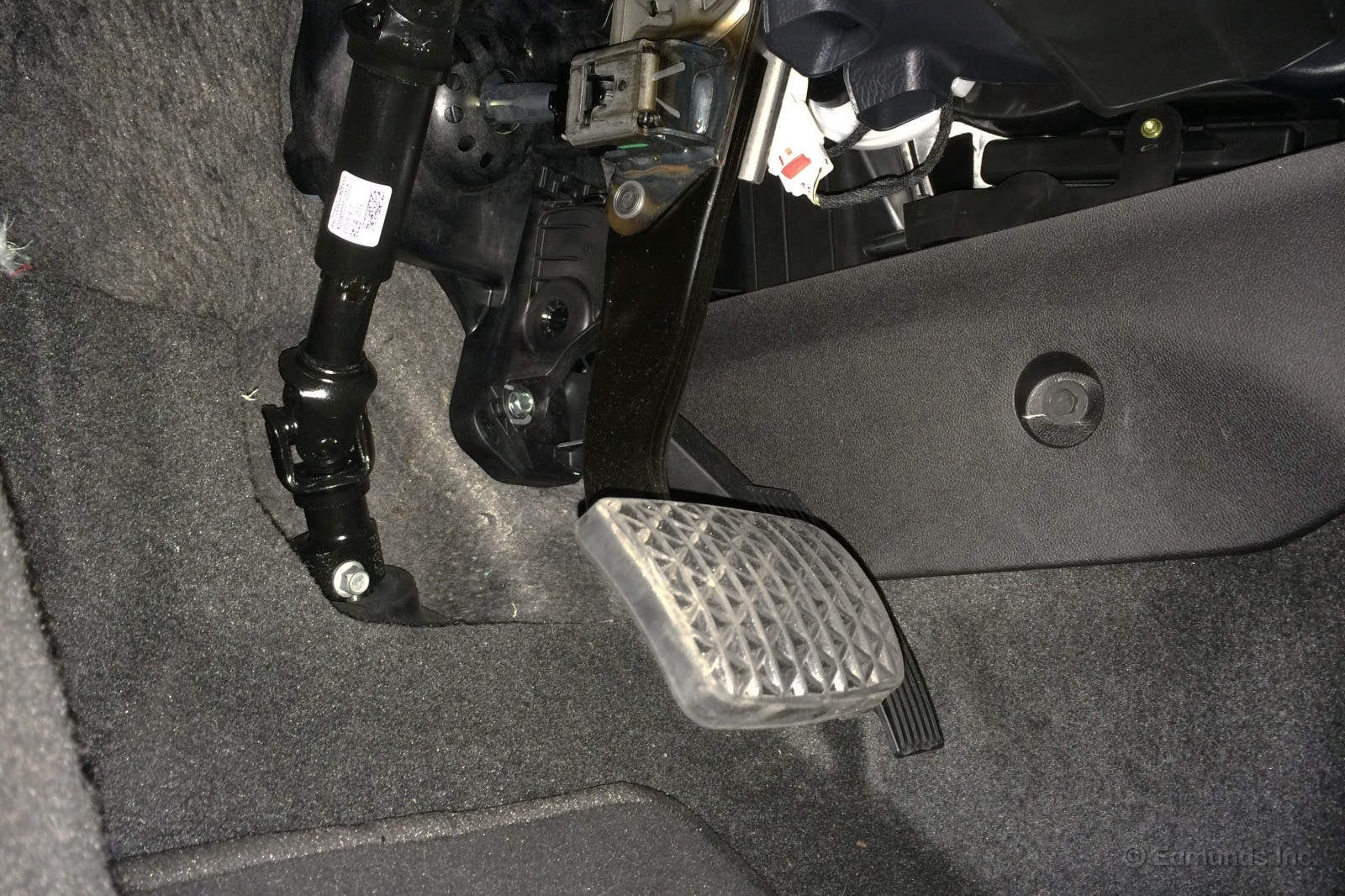
One of the great advantages of an electric car, or in this case a plug-in hybrid operating solely on electric power for some amount of miles, is how quiet it is inside and out. Whether it's executing the perfect holeshot across an intersection in virtual silence, having an effortless conversation with your passenger, or listening to music untainted by the melodies of internal combustion, our 2016 Chevrolet Volt lends itself well.
This cocoon of silence is also something that could possibly drive you mad.
Take away the conversation, the sound track, the background noise, and suddenly you're exposed to things you would've otherwise overlooked or ignored. Have you ever been lying awake in bed listening to a torturous faucet drip? Funny, it wasn't there earlier when you were watching Kimmel.
Drip. Drip. Drip.
Our Volt's "drip" manifests in the form of a squeaky brake pedal. It's hard to pinpoint the exact source of the squeak, but it sounds like a rubber bushing that is slightly out of tolerance.
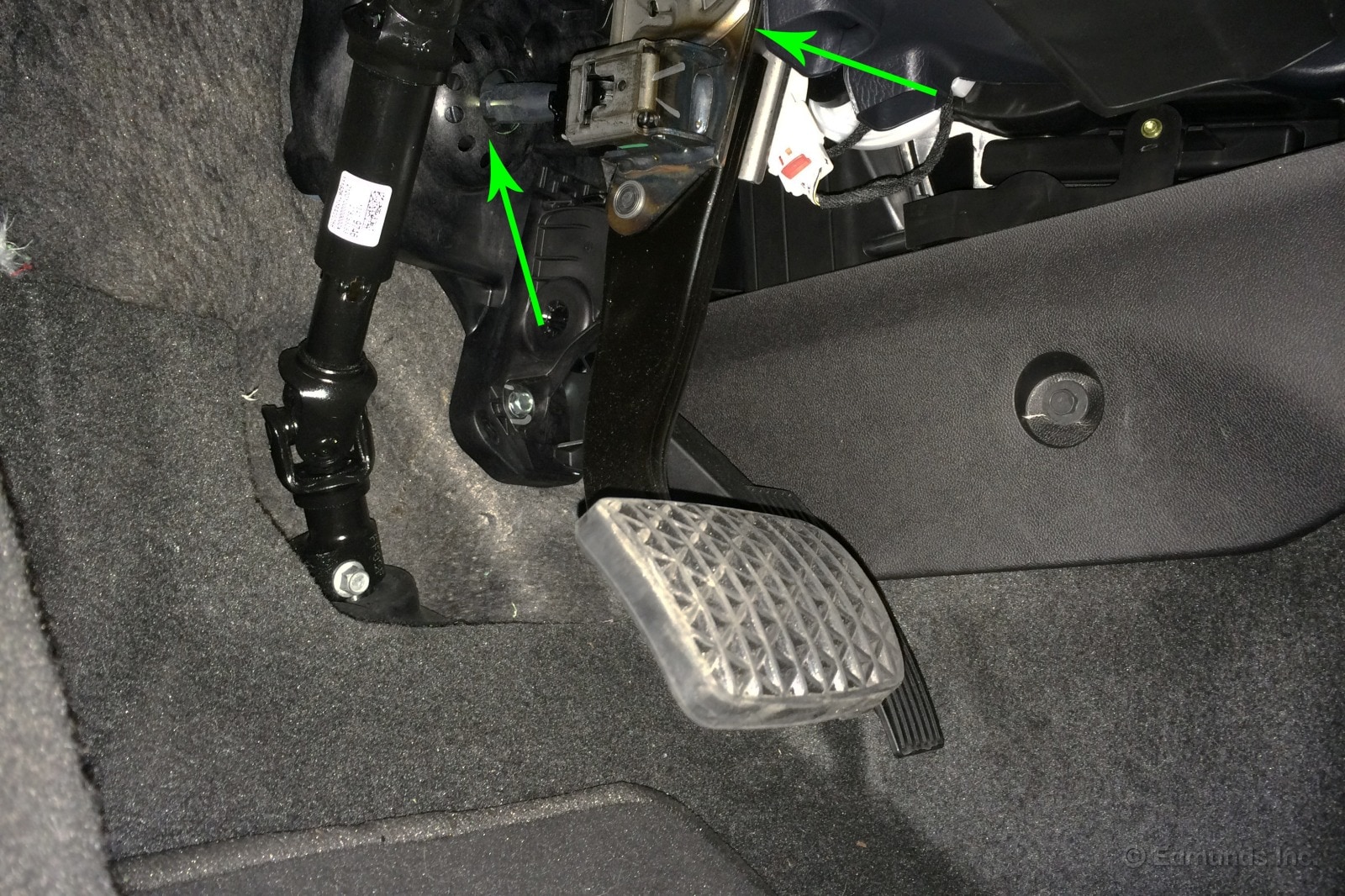
Above are shown two possible origins of the squeak.
Once you notice it, it can be hard to ignore, even as you turn up the radio volume again. Battling through rush hour traffic doesn't help, either.
Squeak. Squeak. Squeak.
I may also suffer from a mild level of OCD, so perhaps I'm in the minority. We'll have plenty of miles to find that out.
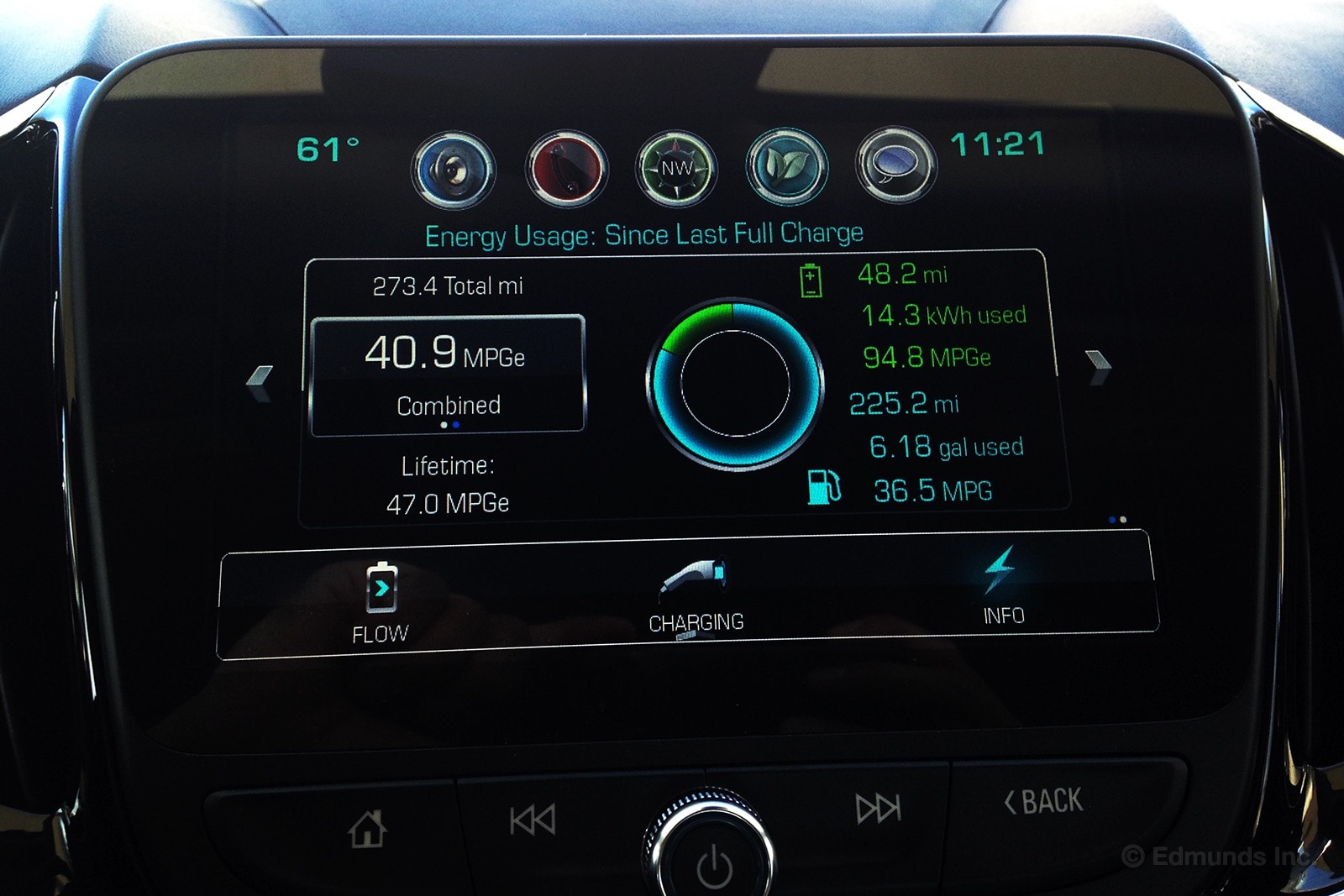
We're still gathering drive data on our 2016 Chevrolet Volt to compile meaningful numbers on our EV range and gas-engine mpg. But here's another early anecdotal result, taking the car's trip computer at its word. During my first drive with the Volt, I was able to eke out 48.2 EV miles before staying on gasoline for the remainder of the miles.
OK, so that falls short of the Volt's EPA rating of 53 electric miles, and it's well eclipsed by Dan's 70-mile outing and the 62-mile performance we managed in an initial road test. But I was mildly impressed just the same that it came within five miles of the EPA rating given conditions: A short-trip to the on-ramp, followed by open highway miles at open highway speeds.
Maybe I'm still too entrenched in the mpg mindset where efficiency promises are always viewed with suspicion, and anything in the ballpark is generally deemed acceptable. But where a five-mpg shortfall in gasoline engine efficiency can earn you a class-action lawsuit, electric miles are a whole different voodoo.
Anyway, this is one isolated leg. But it's a marked improvement on Volt 1.0. When we had our former 2011 Volt long-termer, we averaged 37.3 electric miles during a year of driving (EPA rating: 35 miles). Here again, Dan managed to extract some real range, twice reaching 54 electric miles in heavy traffic.
Further geeking on energy consumption, the EV miles burned on this leg required just 14.3 kilowatt-hours. That works out to 29.7 kWh per 100 miles. By comparison, our 2011 Volt averaged 34.2 kWh/100 miles.
Like Magrath explains, I'm not sure the Volt is the right car for me either, but I like several things about it. For one thing, since 48 miles represents about 80 percent of my one-way commute, I could spend most of my time driving to the office on electrons — in the HOV lane.
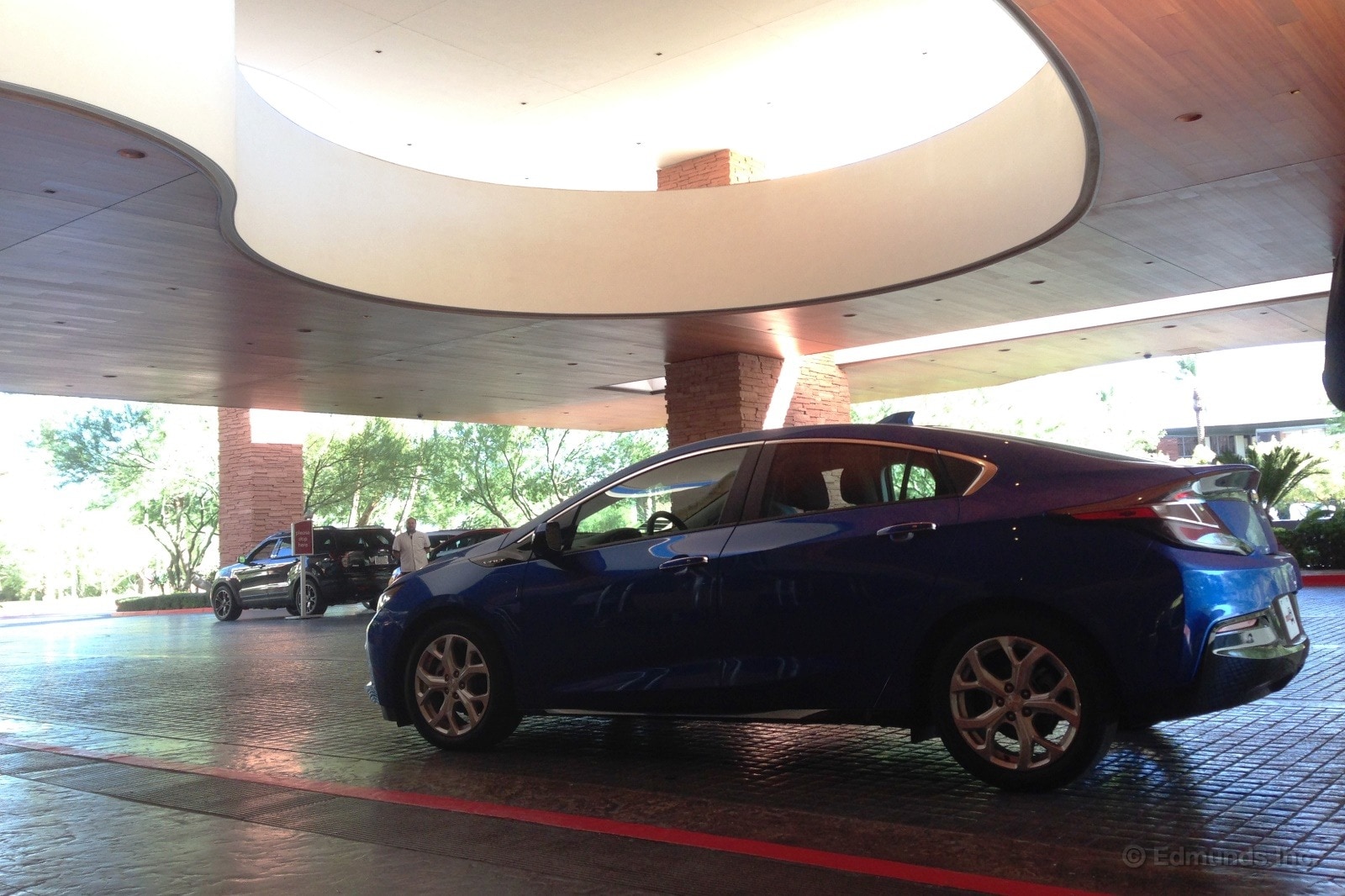
I recently took our long-term 2016 Chevrolet Volt on a straight-shot freeway drive from Los Angeles to Las Vegas and back. In keeping with the fast-talking, Vegas hustler theme, I'll present my impressions in rapid-fire fashion.
Looks more normal than the original Volt. More like a Civic. Not bad-looking. More invisible, though. I'm okay with that.
The new dash is a big improvement. Binning the monochromatic wall of touch-sensitive nonsense was the best idea of the entire program. Seriously.
Less noisy. Drives and rides better. Feels lighter on its feet. The brake feel, while still hybrid-y, is more natural than the outgoing car's.
Steering and handling at routine speeds promises an alertness that proves to be an illusion the first time you take a corner with any enthusiasm. The steering goes limp. Ah well, I get it. It's not that kind of car.
The backseat makes sense. No more items from the trunk can fly through the gap between the seats, because that gap isn't there.
I could do without the silly, zoomy jet-whine noise at startup. Cheesy.
Good punch off the line. Not crazy, but certainly adequate. Smooth, too.
This is a comprehensively better car than the one it replaces. I look forward to driving it again.
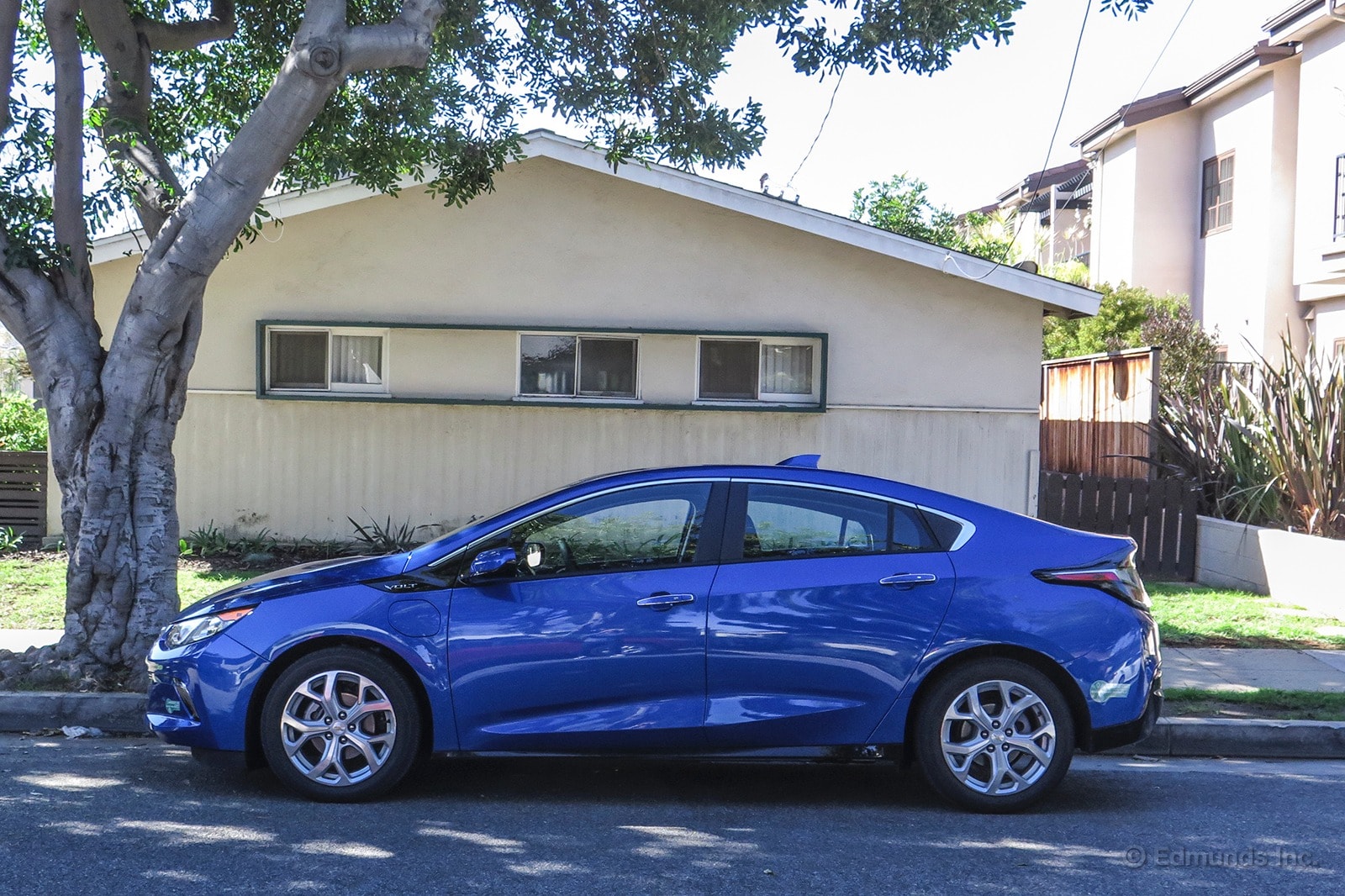
We got our long-term 2016 Chevrolet Volt in a paint color that Chevy calls Kinetic Blue Metallic. And it's fantastic.
Seriously, look at that color. It's awesome. I'm glad that we avoided colors like Heather Gray Metallic or Summit White (see: gray and white). The Kinetic Blue reminds me of one of my favorite colors ever, the Sonic Blue Pearl paint on the 1999 Honda Civic Si.
Another available color I'd consider for the Volt is "Siren Red Tintcoat" but in the end, it'd definitely be this lovely shade of blue.
Now if I can just find out where they hid the paint gun from me and get the keys to all the silver/gray/white cars in our fleet, I'll have some work to do.
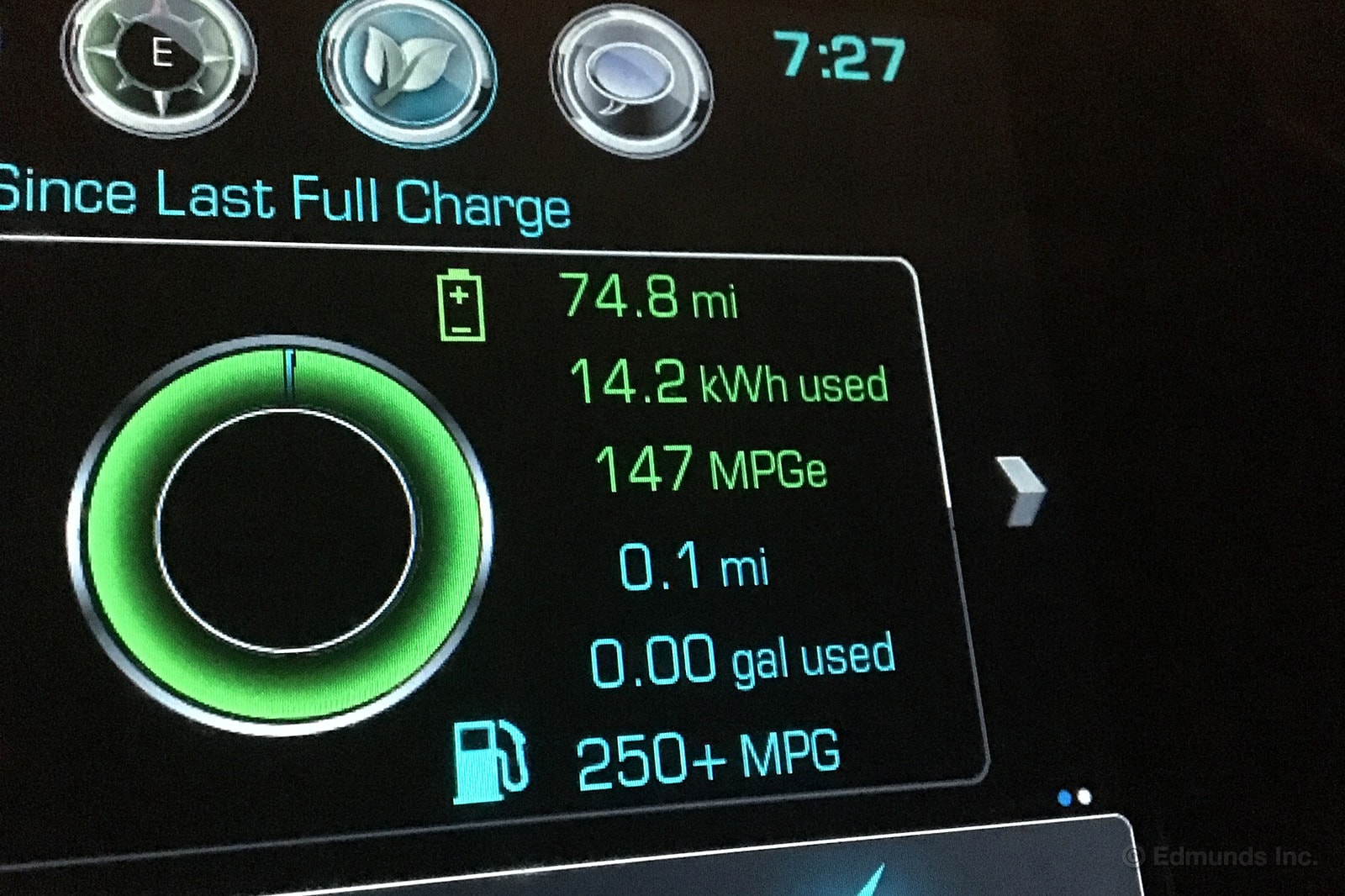
I'm a competitive person no matter the subject. So when we got our new 2016 Chevrolet Volt, I knew I'd be playing the "how far can we (reasonably) go in the real world on a charge?" game and I assumed it would be with Dan Edmunds. Again. (Carlos and I will later play the "How little distance can we reasonably cover in the real world?")
And then Dan got 70 miles and I had to beat it. I just didn't expect it to be so easy.
I wasn't expecting to break the record when I set out that night. I was leaving from a hotel, I had to stop for groceries about five miles into the trip, I had a fast section of freeway and, most importantly, I only planned to drive about 50 miles.
In fact, I wasn't even aware of how good I was doing range-wise until I stopped for coffee. I had been in "L" as I do, and using the regen paddle as I (reluctantly) do, but I'd been heavy with the throttle and even tried to see if the tires would spin full whack on a 90-degree turn (they do).
But once I was in the parking lot, I peeked down and saw the prediction. I texted Dan: On pace for a 75-mile run. Fingers crossed traffic keeps like this.
And it did. Traffic was heavy without stopping and running somewhere less than 45 mph.
Traffic was still moving perfectly when I zoomed past my destination, solely focused on driving 75 miles for no real reason. With 70 miles on the EV odometer, the car was projecting 80 miles, but history tells me these things fall fast.
For each mile I drove, two miles clicked off from the counter. Then there was an emergency vehicle that forced me to pull over. And then I caught a red light. This wasn't much of a concern as the Volt doesn't need much power to "idle" but it meant that I'd have to accelerate hard enough to not get beeped at — or crashed into. I managed to not get killed, either by crash or road rage, and back up to speed without draining too much. The Volt hovered at "one mile remaining" for about three miles, then the range ran out at 74.8 miles. This on a car rated at 53 miles of electric range.
Dan will beat this, I'm sure. But for now, I'm the champ and know exactly what to do (fewer burnouts, no coffee stops, ditch the highway section) to get 80.
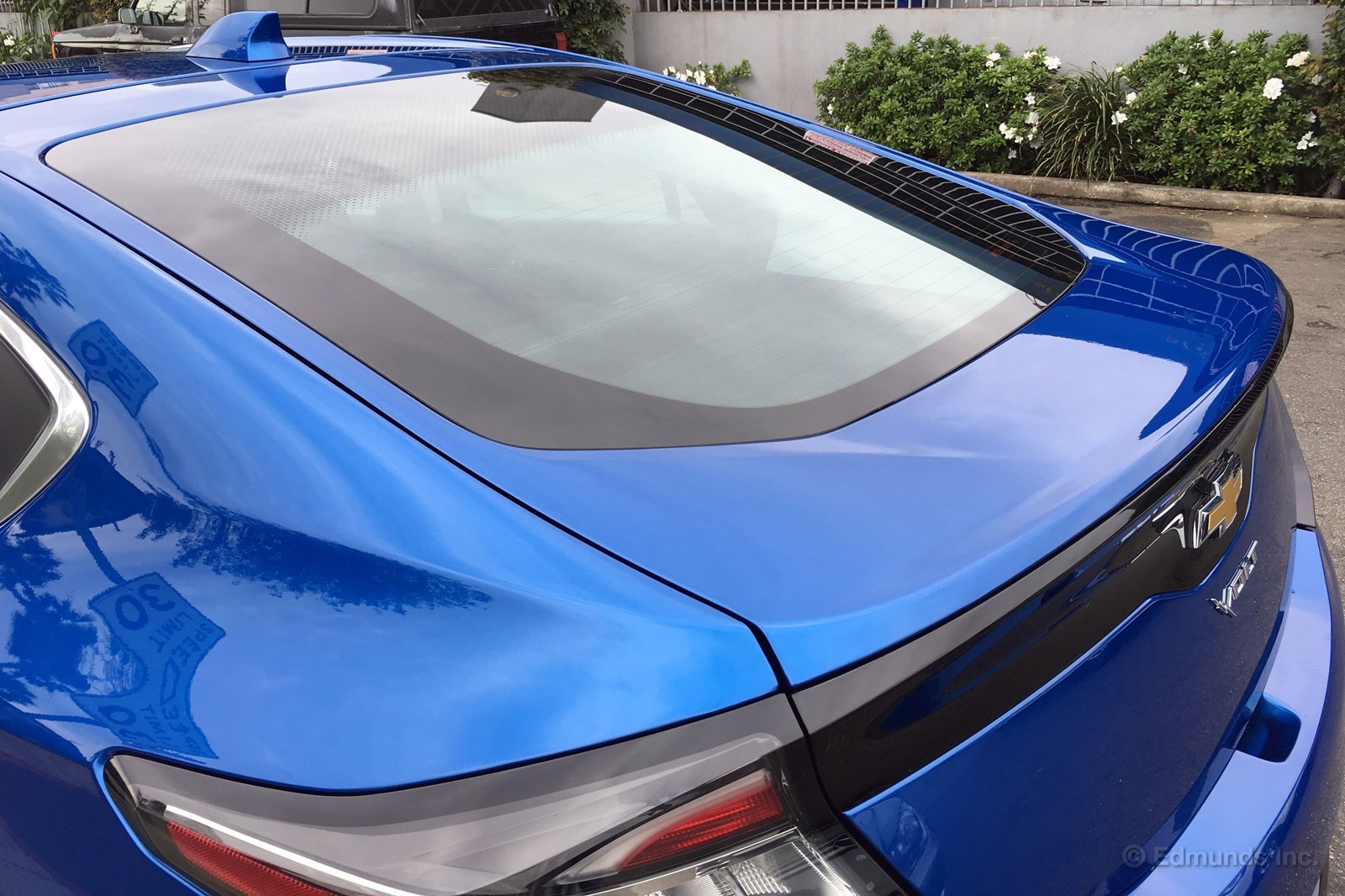
There was a thin layer of exterior grime on our 2016 Chevrolet Volt when I grabbed the key six days ago. Consecutive mornings of fog, wind and condensation elevated grunge levels to moderately-thick, but still well below the car wash threshold. A glance through the windows in any direction was obstructed only by a harmless layer of dust.
Or so it seemed.
I had no problem seeing through the glass when it was dry. Add moisture in the form of light rain or morning dew and that changed. It created enough haze to significantly limit visibility through the rear pane, which is minimal as it is.
Naturally I fumbled with the steering wheel stalks to activate the rear wiper. But the Volt doesn't have one. The Prius does. The Volt does not. I wonder why Chevy opted against this feature. The pitch of the rear glass is such that it would really benefit from a wiper.
I seem to remember us raising similar concerns about our long-term 2011 Chevrolet Volt. Maybe Chevy missed our memo.
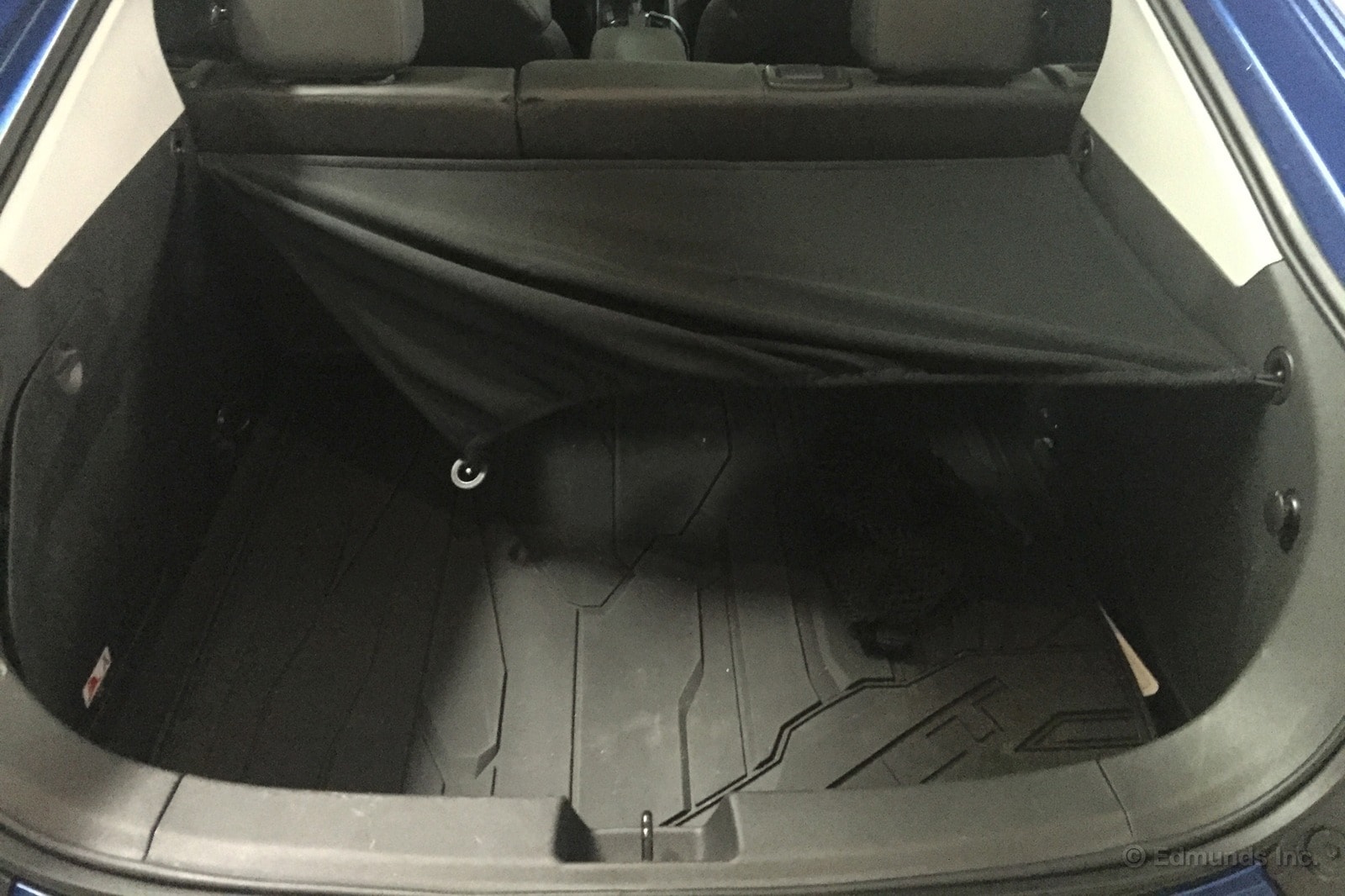
It's frustrating when something little like this happens.
I was staring at the cargo area in our long-term 2016 Chevrolet Volt with my hands on my hips. I was attempting to install the small sheet of fabric that Chevrolet deems fit to call a cargo cover when one off the hook points comes loose.
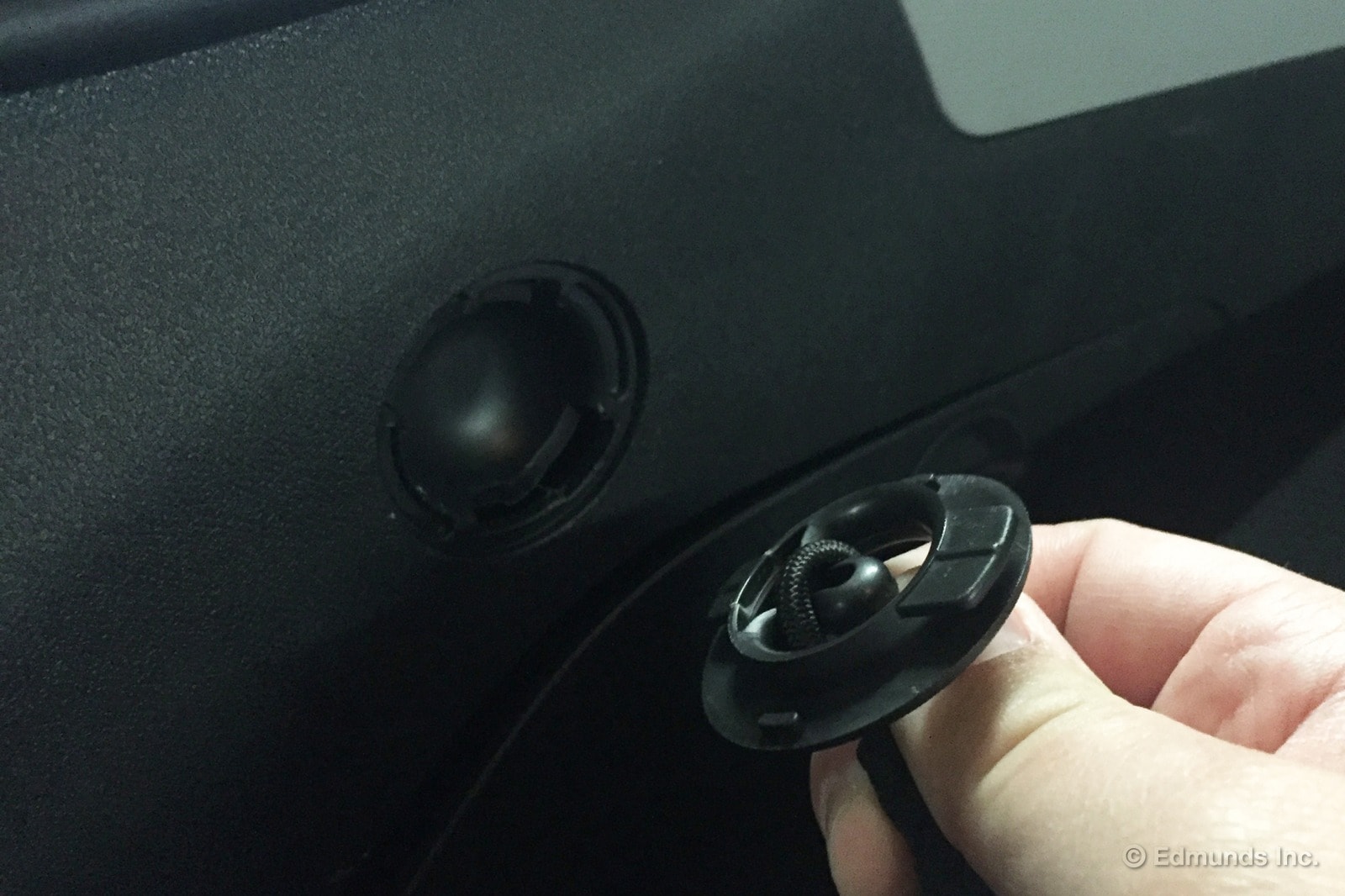
The cover has four points that loop onto hooks. These hooks just push into the trim and turn, but that turn requires more force than my fingers could apply. I ran upstairs to the office and grabbed a set of pliers out of the testing equipment. This gave me enough grip and leverage to turn the hook back into place.
This whole thing was more annoying than anything, considering the cargo cover doesn't tug too terribly hard on the hooks. I'll be counting the days until another hook decides to break free.
An All-Electric Week in a Plug-in Hybrid
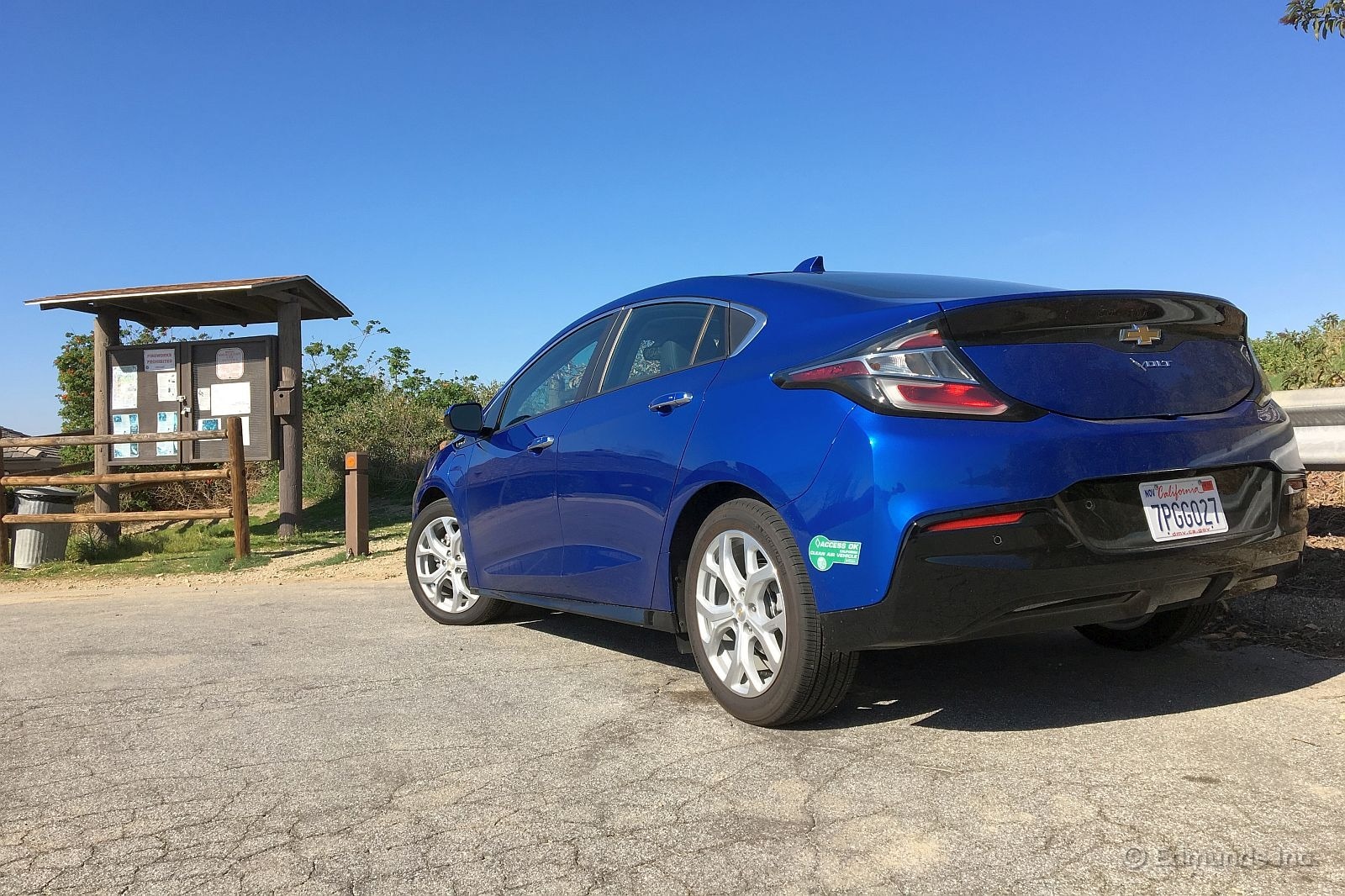
My commute is dreadful. It's 46.6 miles from Santa Ana to Santa Monica, and my route includes some of the worst L.A. freeway miles imaginable. To survive, I time-shift and work an East Coast schedule, setting my alarm at 4:15 am in order to get on the road at 5:00 am (OK, usually 5:15 am), at which point I have a decent chance of getting to work by 6:00 am. My early arrival allows for an early escape that usually gets me out ahead of the worst of the afternoon commuting wave — theoretically, at least.
But a recent week was full of scheduled meetings that would stretch into late afternoon. I would have to work a normal schedule. My solution? Drive our 2016 Chevrolet Volt and take full advantage of its single-occupant HOV lane access stickers.
At first, freeway survival was my sole objective.

I first drove it home on a Thursday, my daughter's 20th birthday. We'd planned to celebrate at one of the swankier places inside Disneyland, so we drove the Volt to the Magic Kingdom and managed to obtain the last open spot among their 20 Chargepoint 240-volt Level 2 charge stations.
Including the stop at home to gather everyone, I'd driven the Volt 53 miles on electricity since setting off from work. Some 13 miles remained on the range meter when I plugged it in, at which point it dawned on me that I might be able to get through my coming week of meetings — which ended the following Thursday — driving the Volt on electricity alone.
But first I would have to get through the weekend.
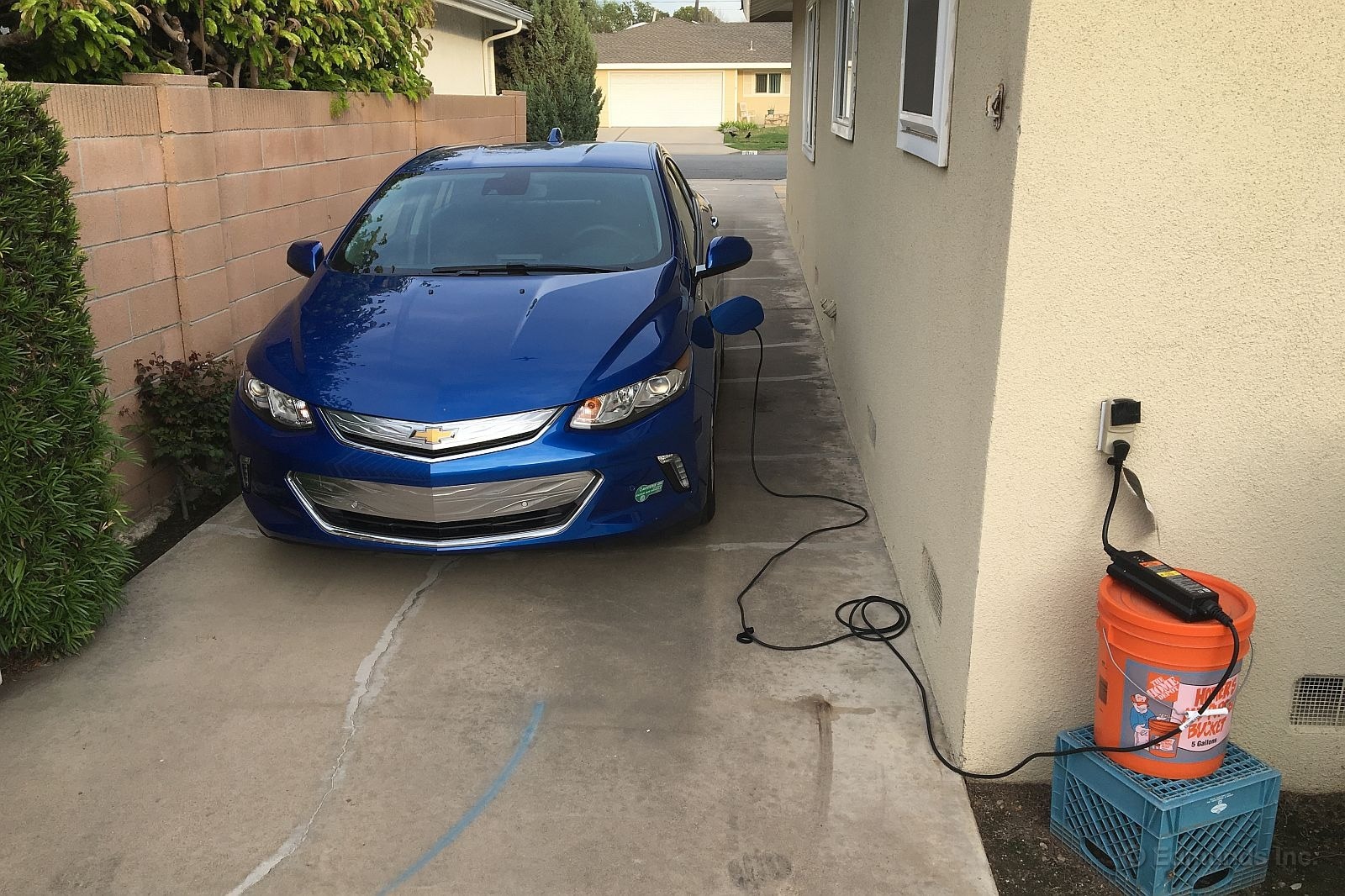
That turned out to be easier than I thought. I drove 44.1 city miles on Friday before I plugged in to a 120V Level 1 outlet at home with nine miles remaining. Saturday consisted of 28.8 miles and 25 miles remaining before I plugged it in again. And I drove 27.4 miles on Sunday before recharging it with 29 miles remaining. All of those miles-driven and miles-remaining combinations added up to 53 miles or more, by the way.
A 120V Level 1 charge takes a long time; no more than three or four miles of driving range are accumulated each hour. But the Volt was full Monday morning because I hadn't started with a completely drained battery. That would prove to be important in the coming week.
On Monday, I drove the 46.6 miles to work and arrived with six miles to spare when I plugged into our own 240V Level 2 charger. The subsequent trip home was 50.3 miles long because of a side trip, but I rolled into my driveway with nine miles in reserve anyway. And so it went on Tuesday and Wednesday. Each day I arrived at work with 11 miles remaining, recharged and arrived home with 20 miles in reserve.
Arriving home with 20 miles made it easy to feel confident that the battery would be full enough on the slow-motion 120-volt charge to make it in the following morning.
Sure enough, I arrived at the office Thursday morning with nine miles remaining. I had driven the Volt seven consecutive days and 485.4 miles on electricity alone. There's never any range anxiety with a plug-in hybrid, but I never once felt that my symbolic EV-only week was in much jeopardy, either.
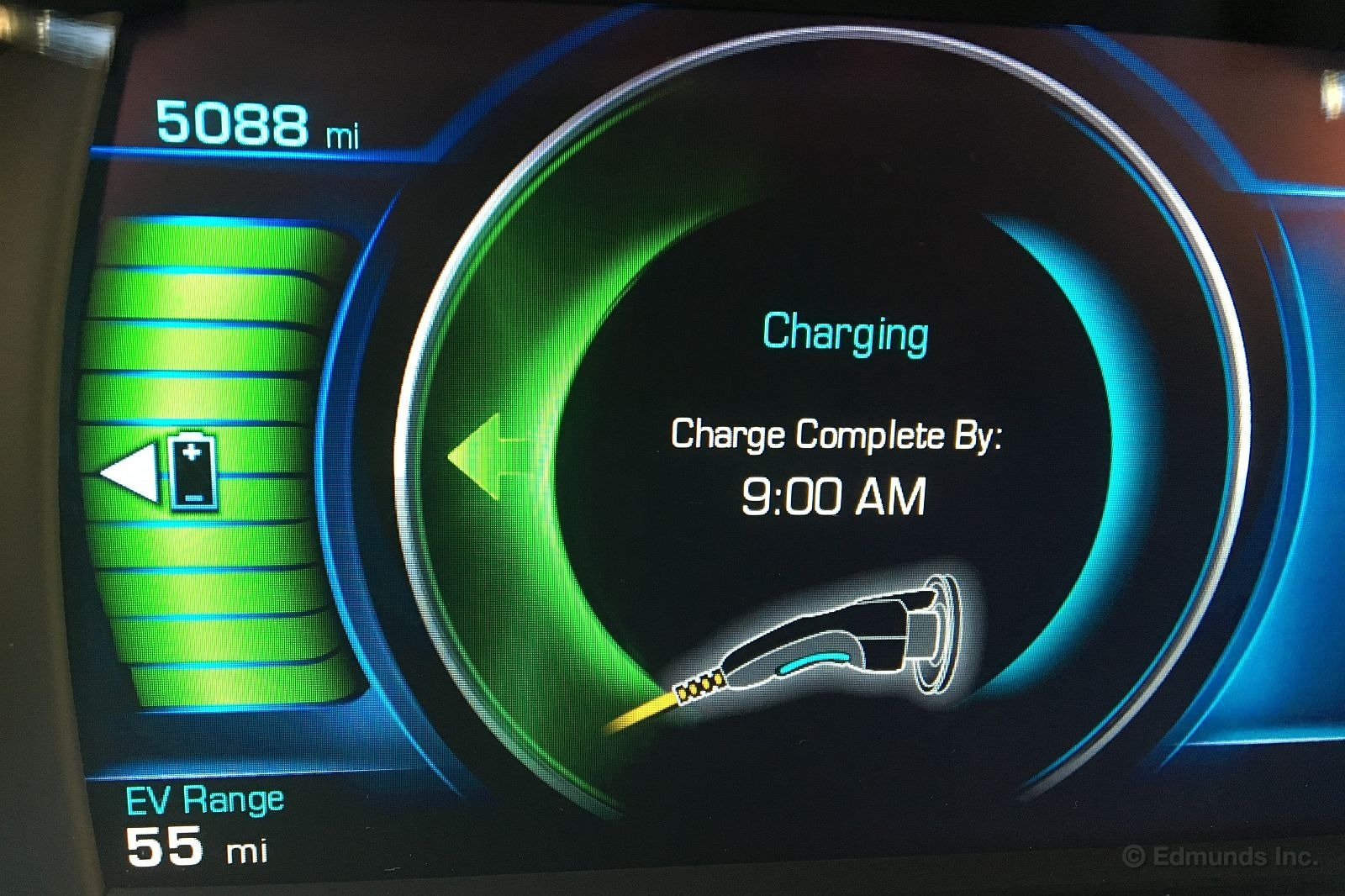
It helped that I had access to a 240-volt charger at work to go along with the 120-volt top-up charging I could do at home. But if I was going to own one of these I'd want to install a 240-volt Level 2 charge station at home. The slow trickle of 120 volts made it necessary to put the Volt to bed by 6:00 p.m. to get the charge started and use a different car if we wanted to see a movie or go to dinner. A 240-volt home charger would allow me to straggle in after midnight, plug in, and still have enough charge time to fill the battery by morning.
Most commute statistics say that the majority of people drive no more than 20 miles each way to work. For them the new Volt could be an EV 100 percent of the time even if they only charged at one end of their trip. Fifty-three miles of rated range really changes the game, and it doesn't take a lot of effort to coax it to go even farther.
The 2016 Volt is a far more compelling choice than it was one year ago.
Performance Tested - A Deep Dive Into the Numbers
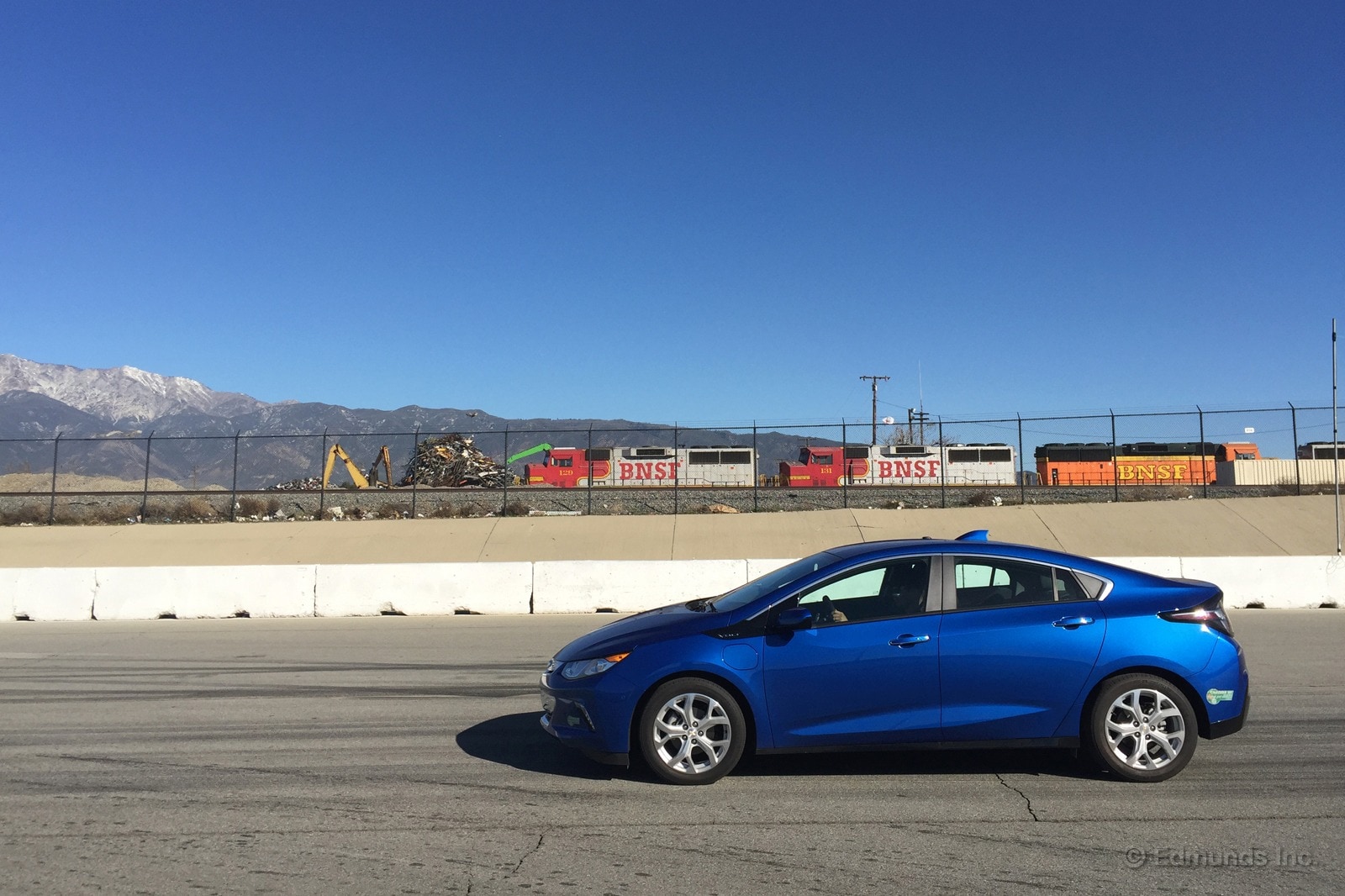
Testing a plug-in hybrid electric vehicle like our long-term 2016 Chevrolet Volt requires adjusting our testing procedure. Usually we test a vehicle's braking before diving into our acceleration runs, but we want to test battery-powered vehicles with a full charge. It's not a huge change, but it's an important one.
This new Volt is a substantially better performer than our previous long-term car, though 0-60 times are not what a car like the Volt is all about. Read on to see how this new generation model fares when pushed to its limits.
Vehicle: 2016 Chevrolet Volt
Odometer: 4,039
Date: 2/9/2016
Driver: Jonathan Elfalan
Price: $40,620
Specifications:
Drive Type: Front-wheel drive
Transmission Type: Electric-drive transaxle
Engine Type: Electric motor with inline-four cylinder gasoline engine
Displacement (cc/cu-in): 1,490/91
Redline (rpm): None Indicated
Horsepower (hp): 149
Torque (lb-ft): 294
Brake Type (front): One-piece ventilated discs with two-piston sliding calipers
Brake Type (rear): One-piece solid discs with single-piston sliding calipers
Suspension Type (front): independent MacPherson strut-type with side-loaded strut modules, specially tuned coil springs, direct-acting hollow stabilizer bar; hydraulic ride bushings
Suspension Type (rear): specially adapted compound crank (torsion beam) with double-walled, U-shaped profile at the rear; specifically tuned coil springs, hydraulic bushings
Tire Size (front): 215/50R17 91H
Tire Size (rear): 215/50R17 91H
Tire Brand: Michelin
Tire Model: Energy Saver All-Season
Tire Type: Low rolling resistance
As tested Curb Weight (lb): 3,543
Test Results
Acceleration
0-30 (sec): 2.7 (w/ TC on 2.6)
0-45 (sec): 4.7 (w/ TC on 4.7)
0-60 (sec): 7.5 (w/TC on 7.8)
0-60 with 1-ft Rollout (sec): 7.3 (w/TC on 7.5)
0-75 (sec): 11.2 (w/TC on 12.4)
1/4-Mile (sec @ mph): 15.6 @ 89.7 (w/TC on 15.9 @ 83.4)
Braking
30-0 (ft): 30
60-0 (ft): 119
Handling
Skid Pad Lateral acceleration (g): 0.85 (0.81 w/ESC on)
Comments
Acceleration:
(Electric-only mode) Accelerator response is immediate with nice amount of torque right off the line. Acceleration is strong until about 30 mph, then begins to drop off pretty significantly. In this mode, the Volt is quicker to 30 mph compared to running on the gas engine. As expected, the first run was the quickest with the batteries at full charge. It's also best going from brake to throttle with no pedal overlap in between (power braking). Each successive run was slower as the batteries depleted.
(Gas-only mode, batteries depleted) In this mode, acceleration runs are quickest and more repeatable, with most of the speed gains made at 35 mph and above. Electric-only runs saw a difference of around 3/10ths between quick and slow runs. Unlike the electric-only runs, there is some benefit to brief power braking, which ensures the engine is on and revving slightly before releasing the brakes. The engine runs at a moderately low rpm till around 35 mph (even longer ons some runs) until it kicks over to another mode and the rpm increases dramatically, providing much more thrust like a secondary cam. We weren't able to deduce a way to trick the engine into the higher rpm range sooner.
Braking:
The brake pedal has a soft effort and long travel, almost SUV-like. There's also some occasional instability under maximum braking, which resulted in some front end wiggle on a few runs. The tires don't seem to have great grip which could contribute to the instability characteristics. Despite the subjective instability, brake runs were incredibly consistent, all within a half-foot of each other. With the cooling in between, there wasn't any noticeable brake odor.
Handling:
Entering the skid pad, the Volt turns in quickly but immediately understeers a moderate amount. Stability and traction control is pretty invasive, dialing back engine torque as understeer is sensed, so it's easier to be smooth and consistent with the systems turned off. Steering feel is almost completely numb and a floaty suspension wouldn't be very confidence-inspiring driving at speed — Jonathan Elfalan
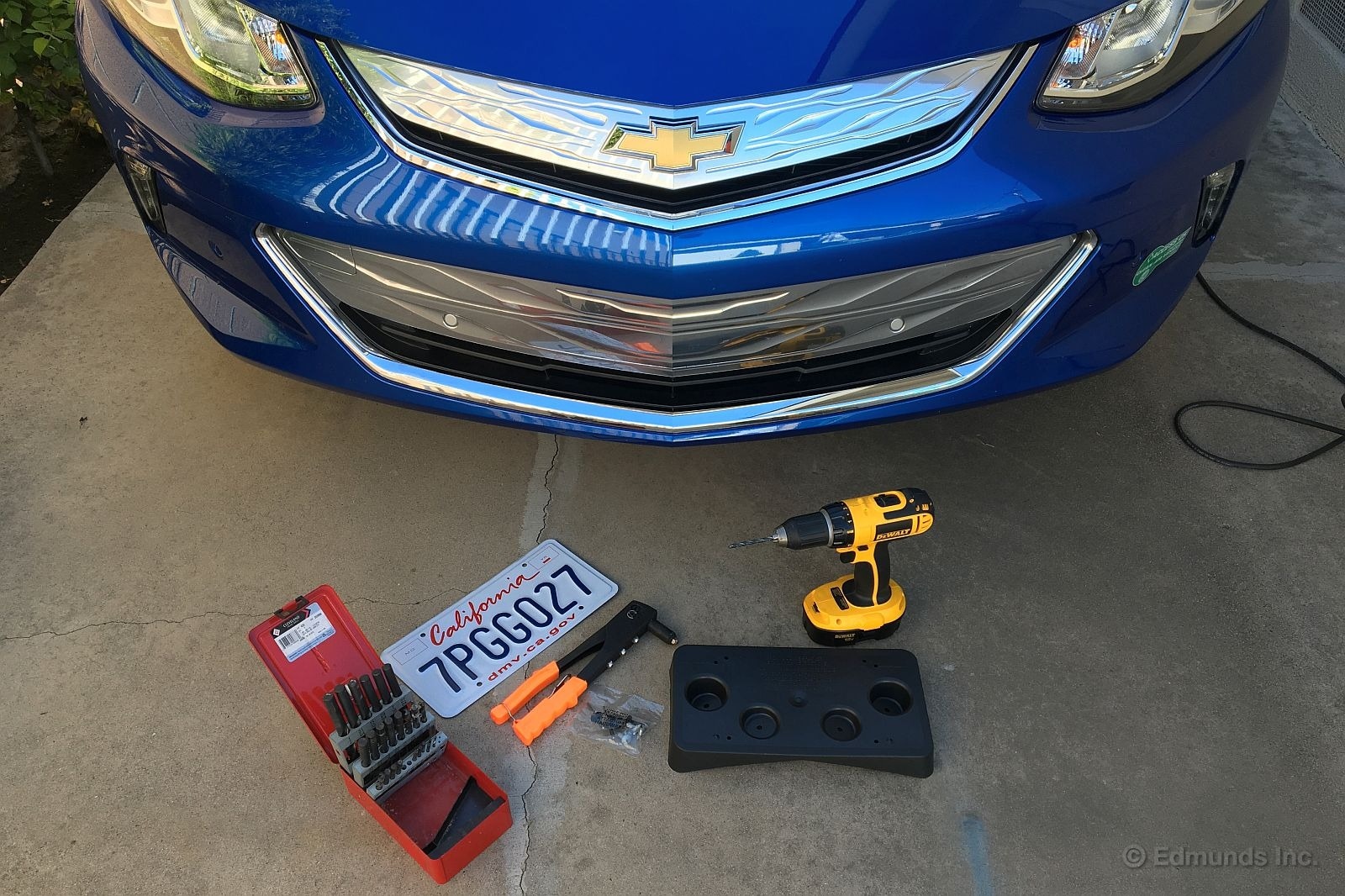
"You don't want to do that," said the guy at Selman Chevrolet, where we bought our 2016 Chevrolet Volt. We were surrounded by three pristine Corvettes in the showroom.
In my head I was nodding in agreement like Angus Young. But my mouth said, "Yeah, but this car spends a lot of time in West L.A. and Santa Monica, places where parking enforcement would gladly write us up for no front license plate."
Because it's a requirement in California (and 30 other states,) a front license plate bracket came with the car. But the necessary attachment hardware was nowhere to be found. It takes 6 to 8 weeks for license plates to be issued, so it didn't matter until now.
"I'm here to get the pop-rivets and screws that were supposed to come with the bracket," I continued.
"You don't want to do that," he repeated, meaning something slightly different this time. "Bring it around and we'll put it on for you."
This time he was wrong. "Thanks, but I want to do it myself. Can you see if you have the parts?"
"You're the first person who's wanted to do that," he said. But he soon returned with a baggie containing the four pop-rivets and four screws I needed.
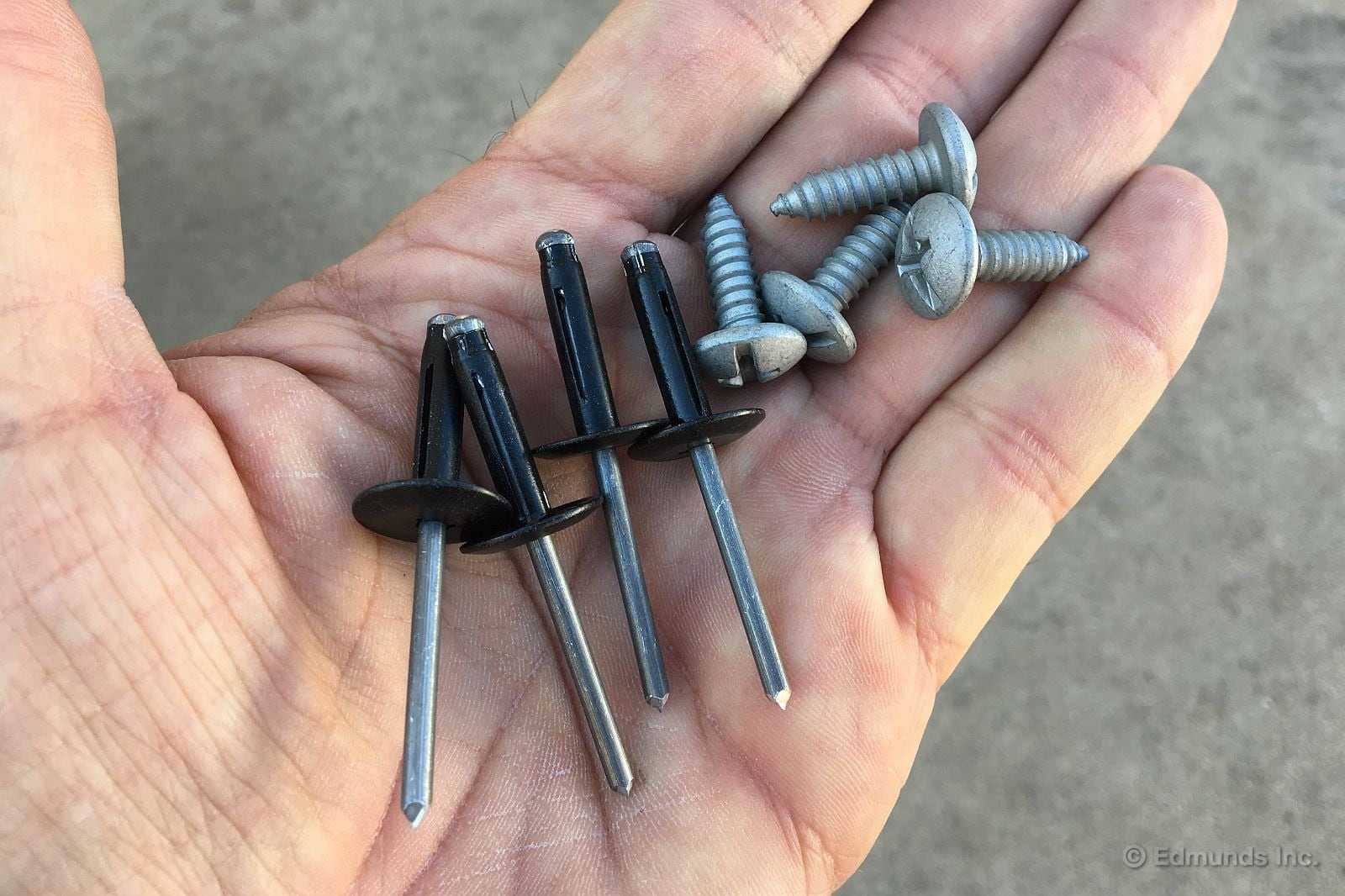
This is not a do-it-yourself piece. It's more of a fingernails-on-the-chalkboard exercise, a horror movie for those that admire a car's styling above all else.
I can't tell you how much I hate the front license plate requirement. But I understand the reality of it. And ultimately, this is no Lamborghini. Heck, it's not even a Miata.
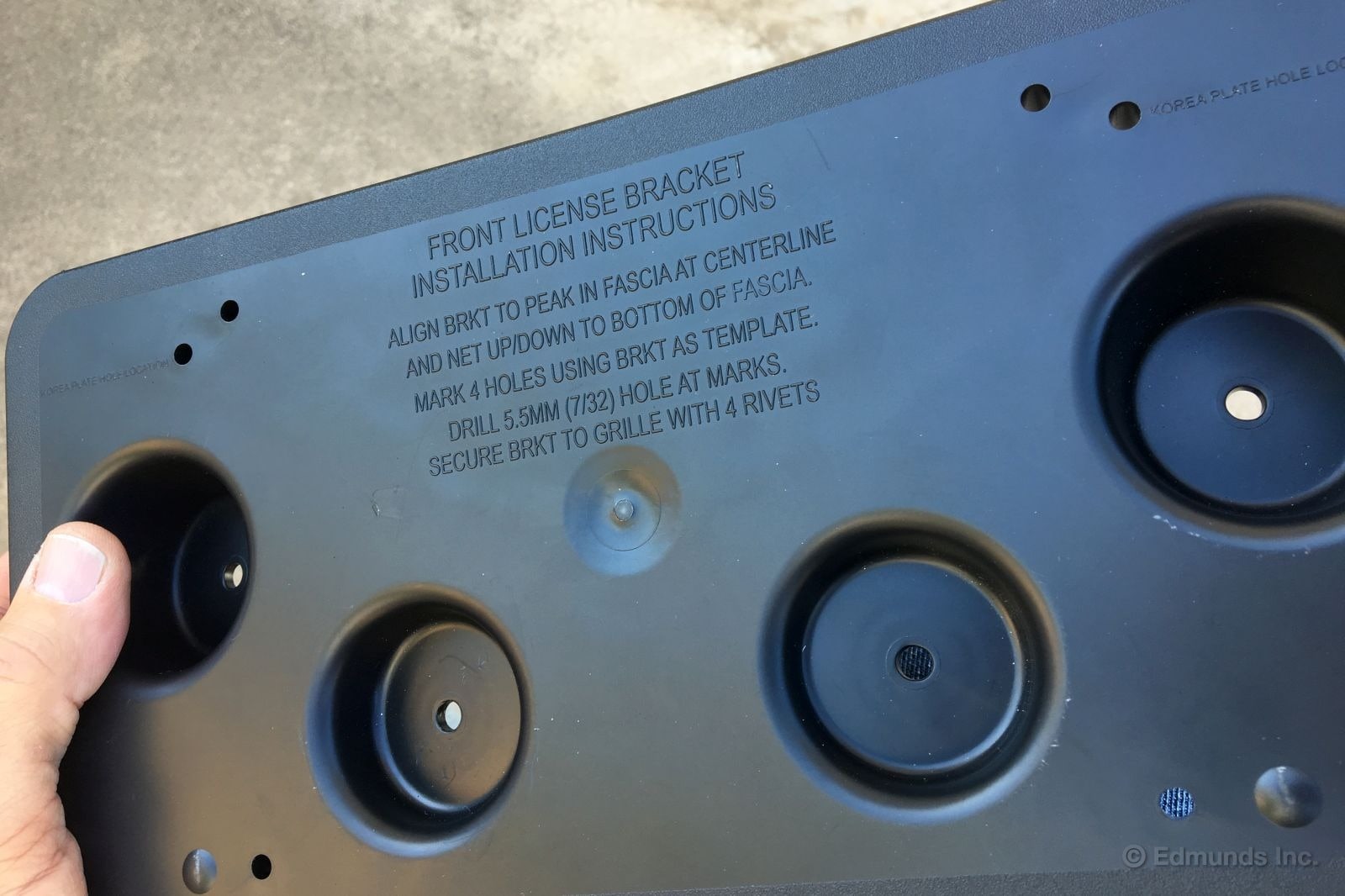
The plate bracket itself has all the necessary directions molded right into it.
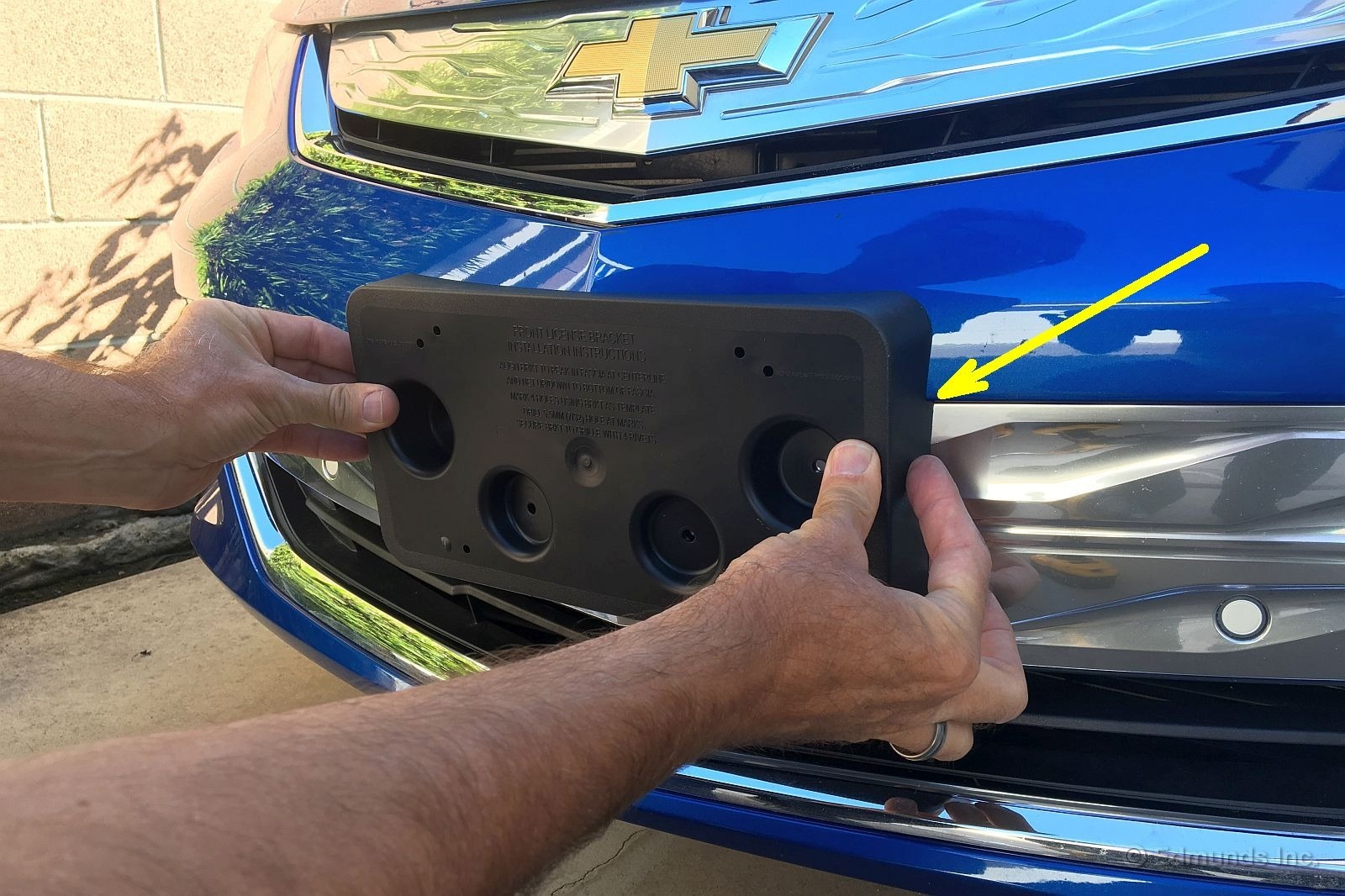
What you can't see is the Sharpie in my wife's hand, waiting for me to align the V-shape of the bracket with the nose of the car and fit the notches at either side up against a step in the fascia.
I have a spring-loaded center punch, and with it I placed a divot in the center of each of her Sharpie marks so the drill bit wouldn't "walk."
Speaking of drilling, this is the point at which the squeamish might want to look away.
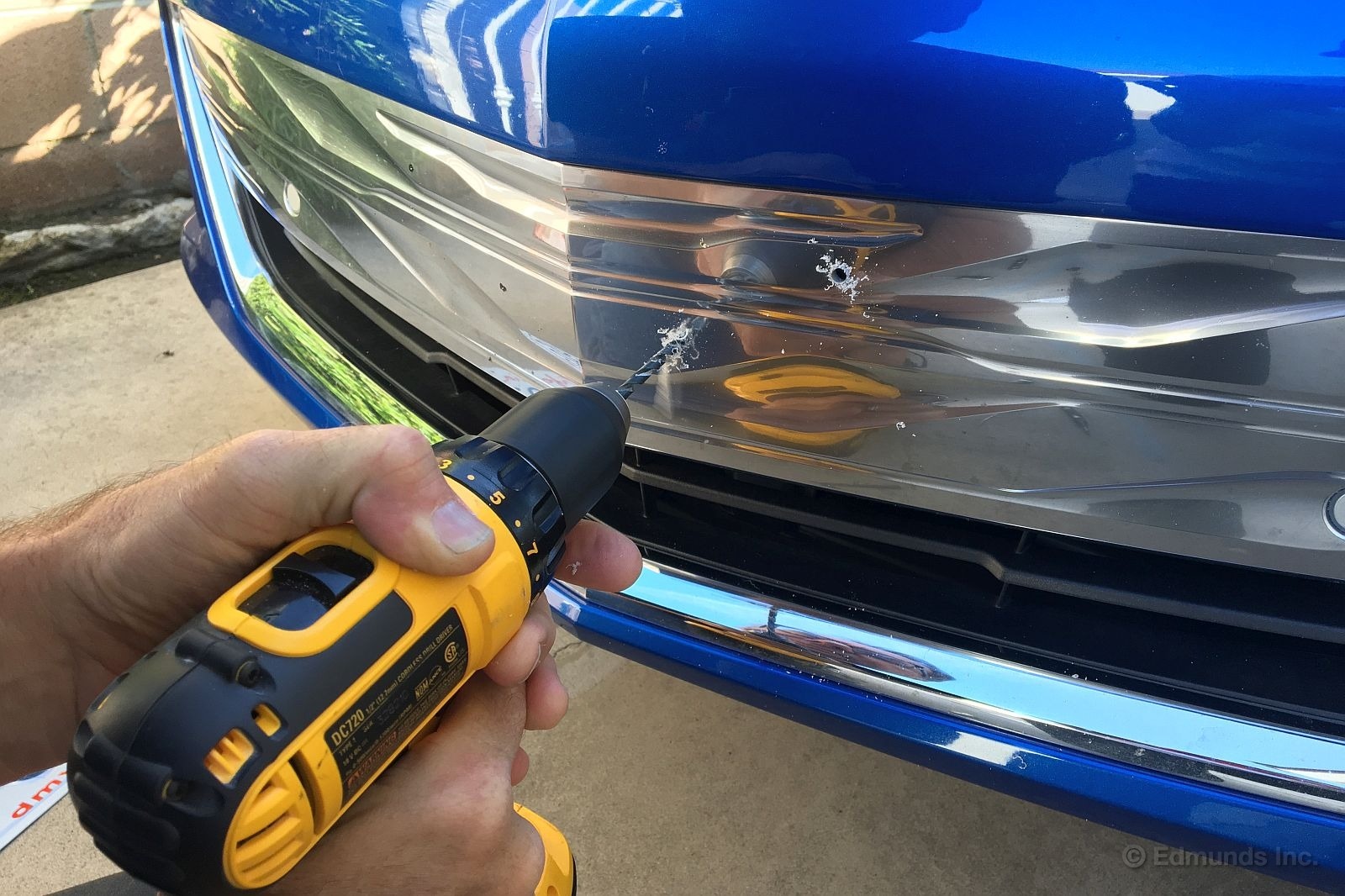
The horror. The plastic. Did you think it would be made of anything else?
Incidentally, the molded bracket instructions called for a 7/32" drill bit, but I found that the less-common 13/64" bit I had in my drill index was a snugger fit.
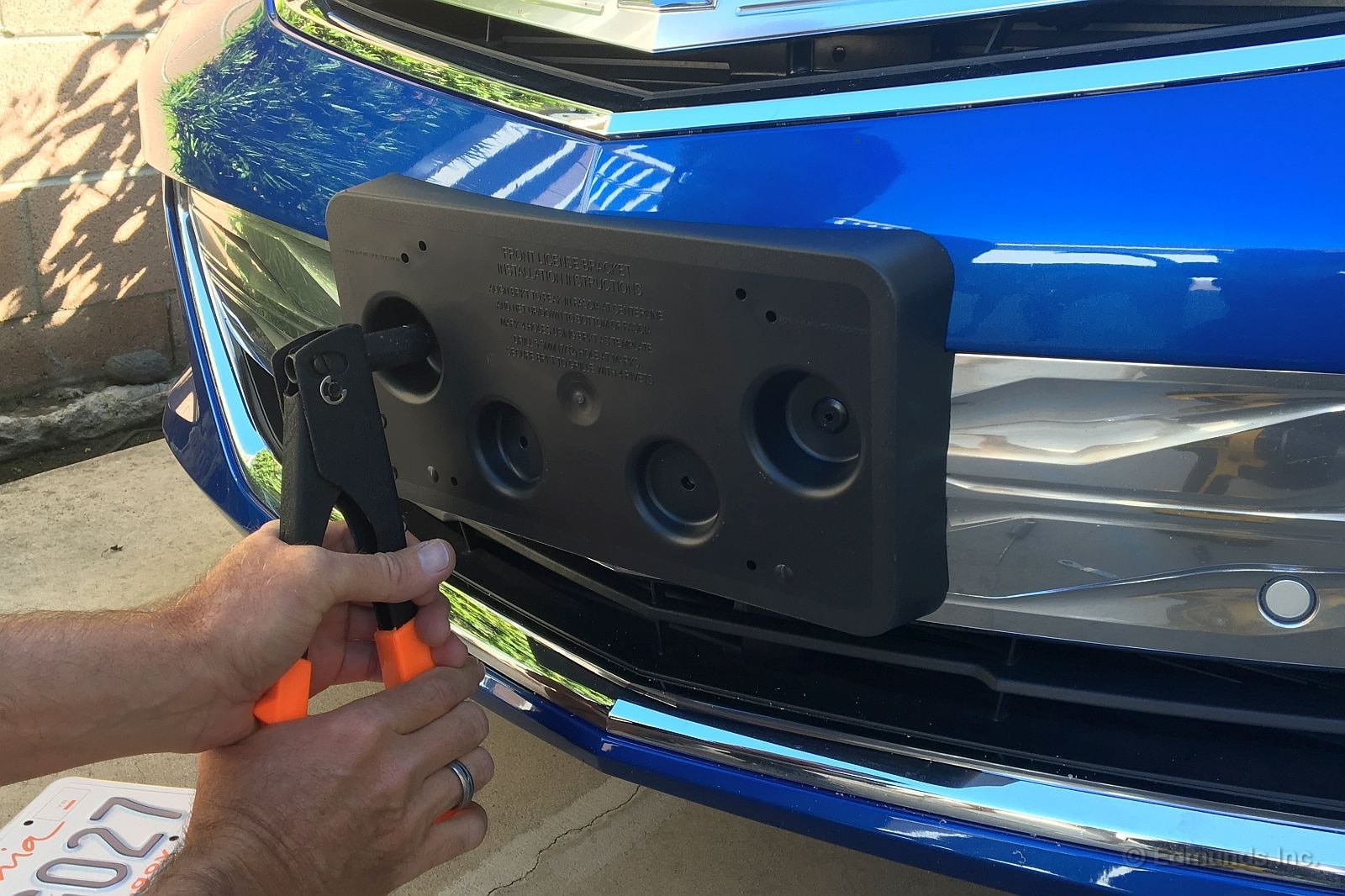
Pop. Pop. Pop. Pop.
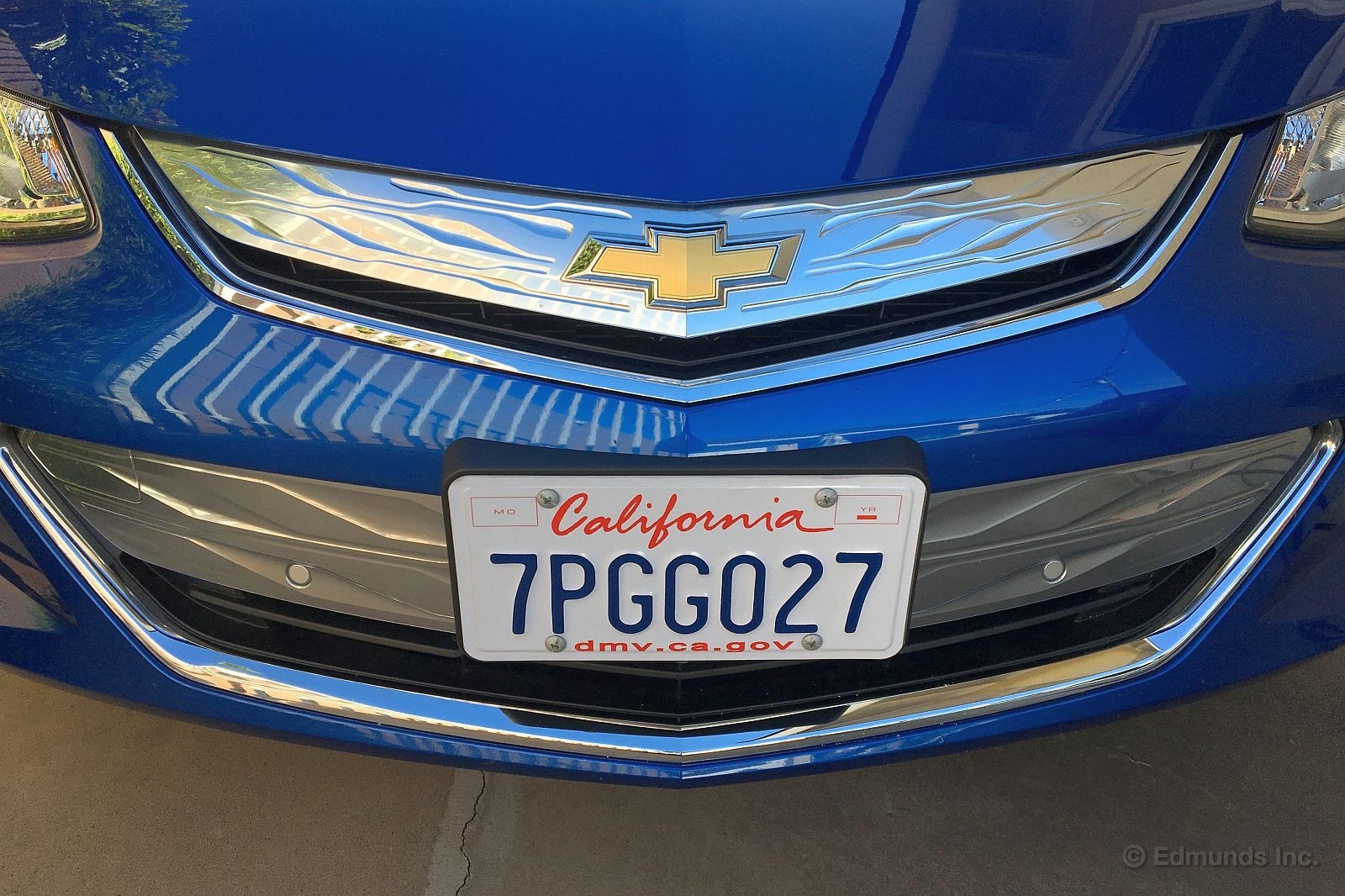
Like it or not, it's done. And it's nice and square. Best of all, I can't see it while I'm sitting inside driving our Volt.
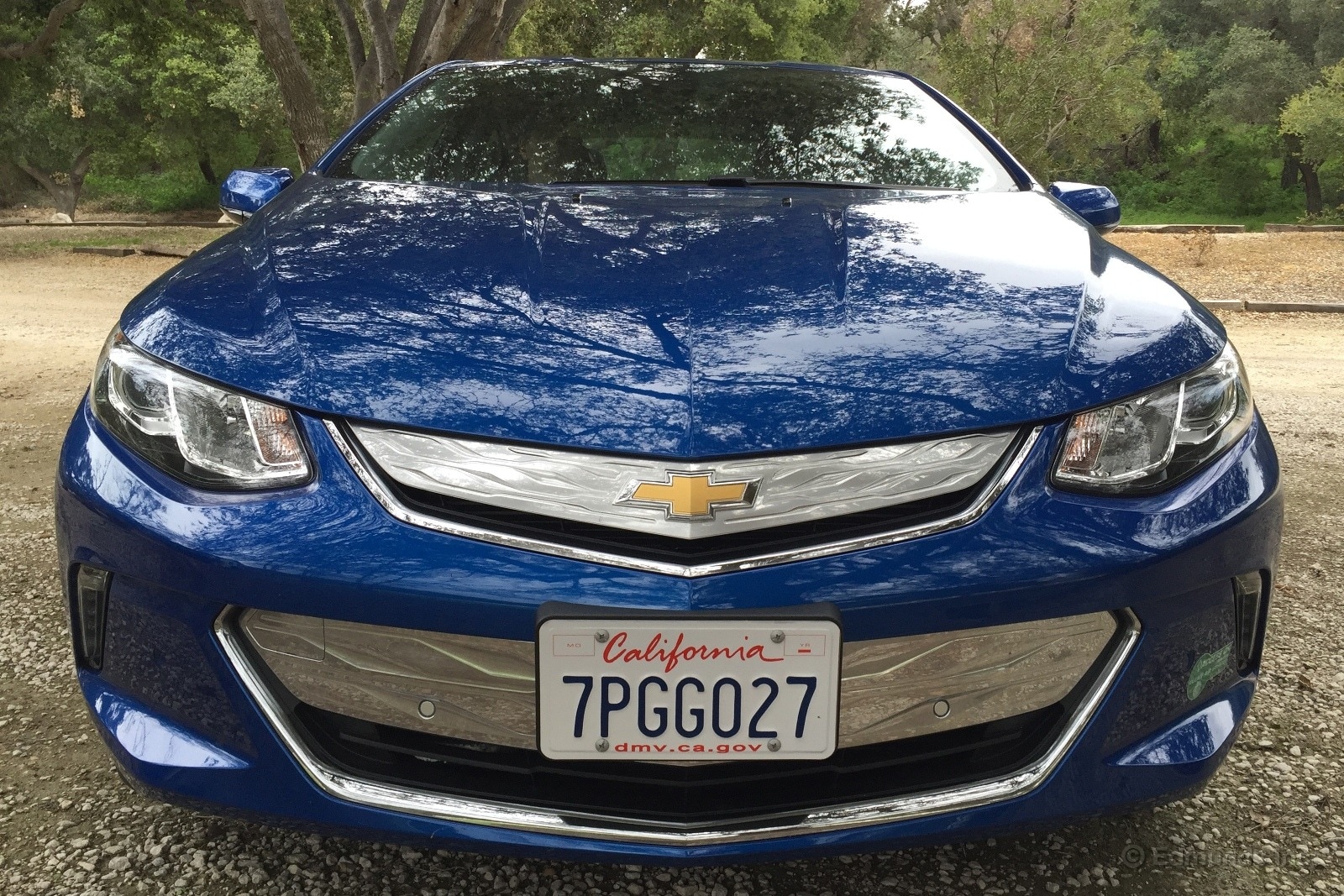
Let me start by immediately walking that assertion back. Not every car, of course. The world still needs Mustangs and Corvettes and 911s and things of that nature. Or I do, at least.
But what if every commuter car were like our long-term 2016 Chevrolet Volt? Urban fuel consumption — and thus pollution — would plummet. Gas-price anxiety would stop being a thing, yet there wouldn't be any range anxiety, either. Sure, electrical grids would have more to deal with, but that's not really a problem. And everyone would enjoy instant-on electric propulsion that really thumps in the heavily trafficked zero-to-40-mph range.
These were the thoughts I was having last weekend as I drove our Volt all over Los Angeles and Santa Barbara Counties. TLDR: If everyone had a Volt, I think the world would be a better place.
I began my Volt experience by running up an indicated 37.4 all-electric miles around the city, at which point the gasoline engine kicked in. It's capable of much more, but I got addicted to that electric torque, and electricity's cheap as hell, so who cares?

Also, and crucially, I knew I had a whole tank of gasoline waiting in reserve for the drive north to Rancho San Marcos, without the performance reduction you're stuck with in the BMW i3 REx or even the first-generation Volt, apparently (I somehow never drove one myself). I kept waiting for the 2016 Volt to stop feeling energetic once the battery was depleted, but it had no trouble whisking three men and their golf clubs up and over a number of mountain passes — Mountain Mode not required.

Speaking of golf clubs, it's a cinch to fit three bags' worth into the Volt's hatchback trunk if you flip down one of the seatbacks. And the 5-foot-8 rear passenger even remarked that there was decent legroom and headroom, which is not something I remember hearing about the first-generation car.
We were also pleasantly surprised by the Volt's composure on the road. This is a quiet and stable car on the highway, with refinement levels that fully match its price. Takes corners nicely, too. It may look like a Cruze/Civic mashup on the outside — that's the biggest weakness, in my opinion — but the driving character is appropriately upscale.
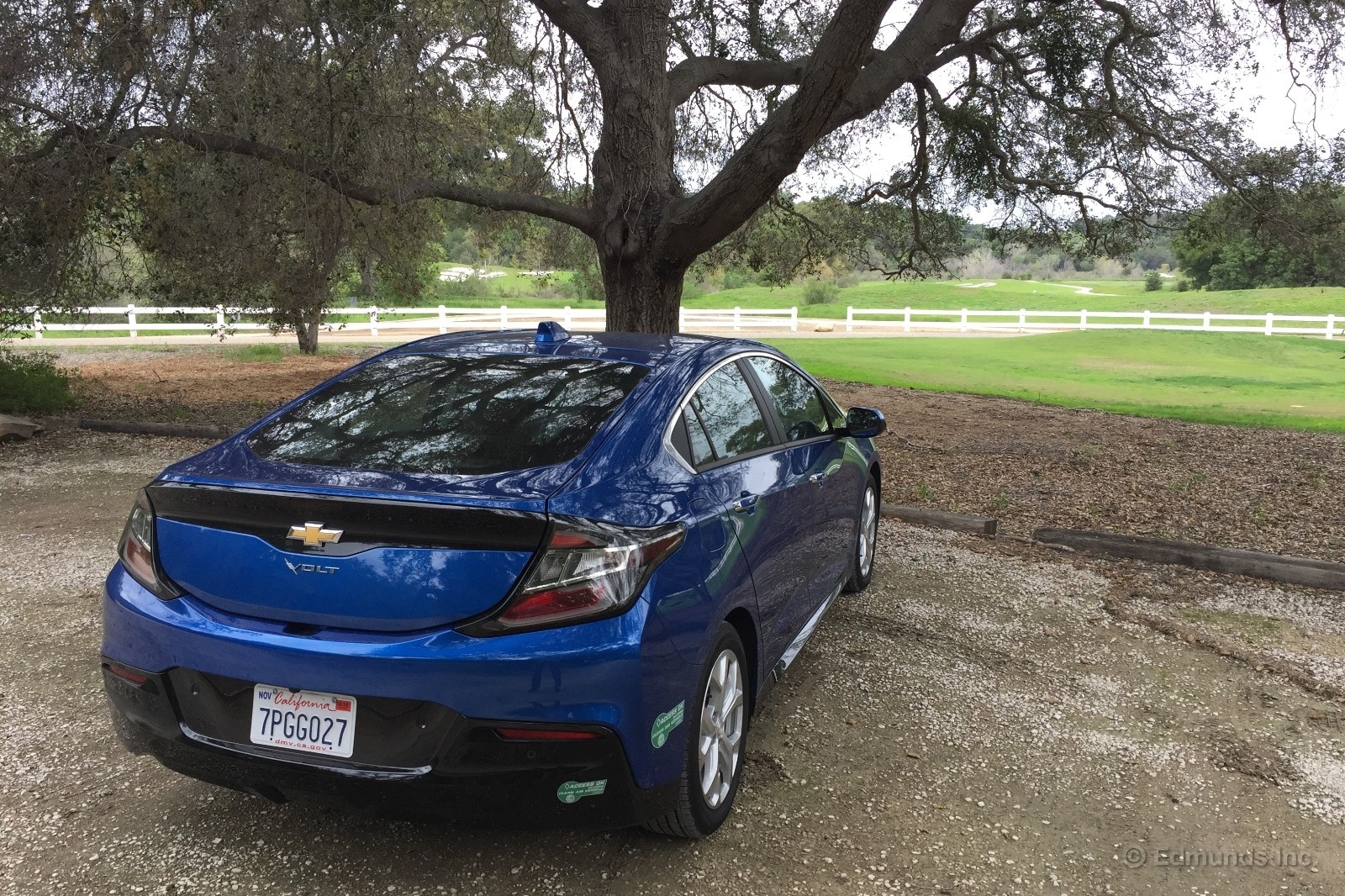
Here's the question I'm left with: Why aren't more car companies building cars like this? There's a handful of plug-in hybrids out there, but the Volt's combination of electric and gasoline range has been uniquely generous since 2011. I'd like to see other manufacturers go hard at the Volt with comparable capabilities and sexier designs. Seems like there's an opportunity here — think about Audi A3 Sportback e-Tron shoppers who are turned off by its relatively humble 17-mile ceiling in EV mode.
Am I wrong?
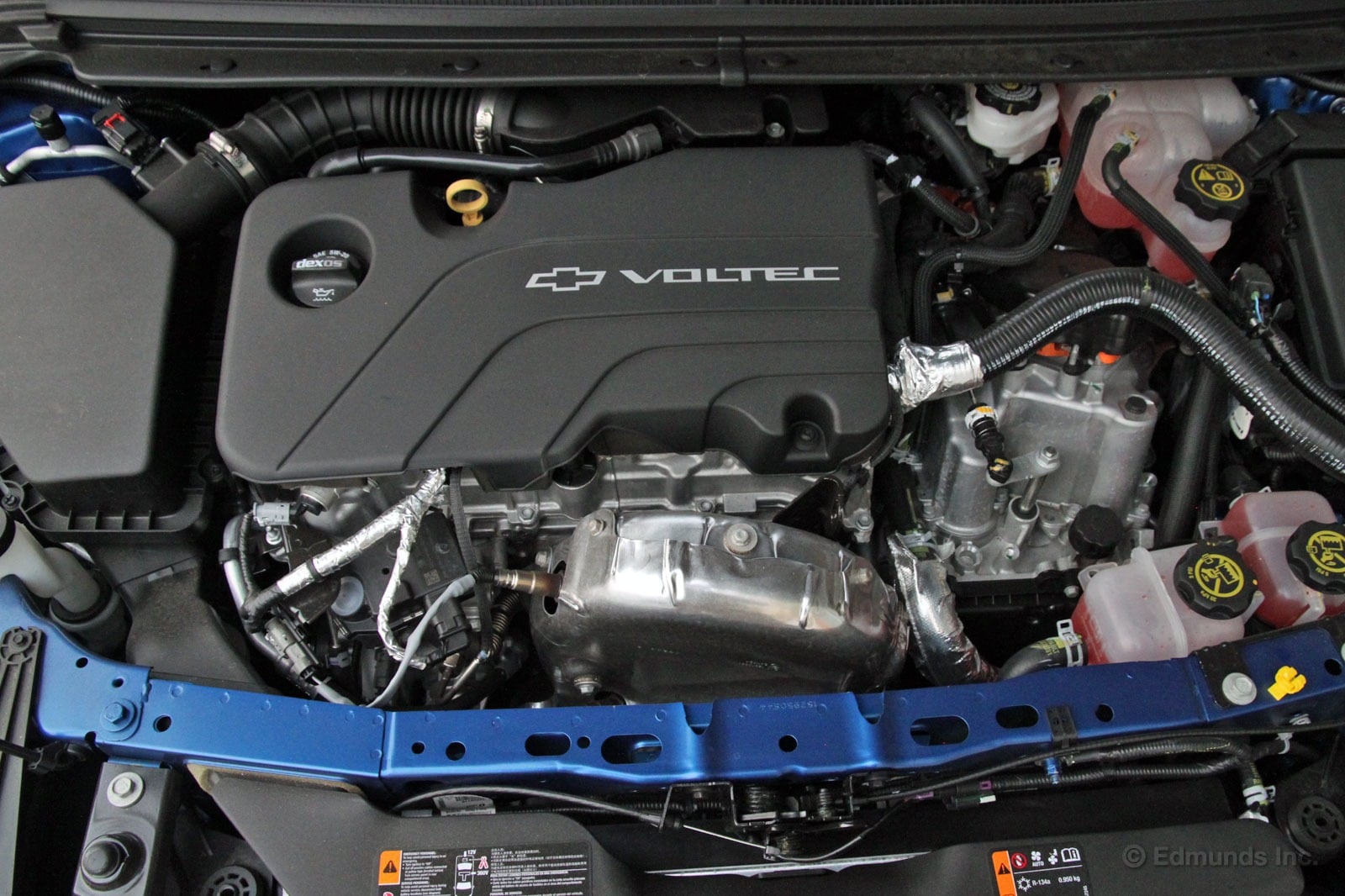
It's easy to forget that our 2016 Chevrolet Volt has a gasoline engine under the hood. Given how often it runs, you barely know it's there. Even when it is running, it's far quieter than the previous Volt.
The previous Volt had an older engine that wasn't known for being particularly smooth. When it fired up you couldn't help but notice the added racket. It gave the high-tech car a decidedly low-tech feel.
This time around, the engine is slightly bigger, more powerful and yet quieter than before. It needed to be given its more prominent role this time around. It's no longer just a generator for the batteries. This engine now drives the Volt when the batteries are depleted.
I drove it around for a big chunk of the weekend with no juice left and didn't mind a bit. The new engine delivers enough power to keep up with traffic and it doesn't rattle the cabin in the process. I can see some buyers driving it around without plugging it in. I don't remember feeling that way about the previous Volt.
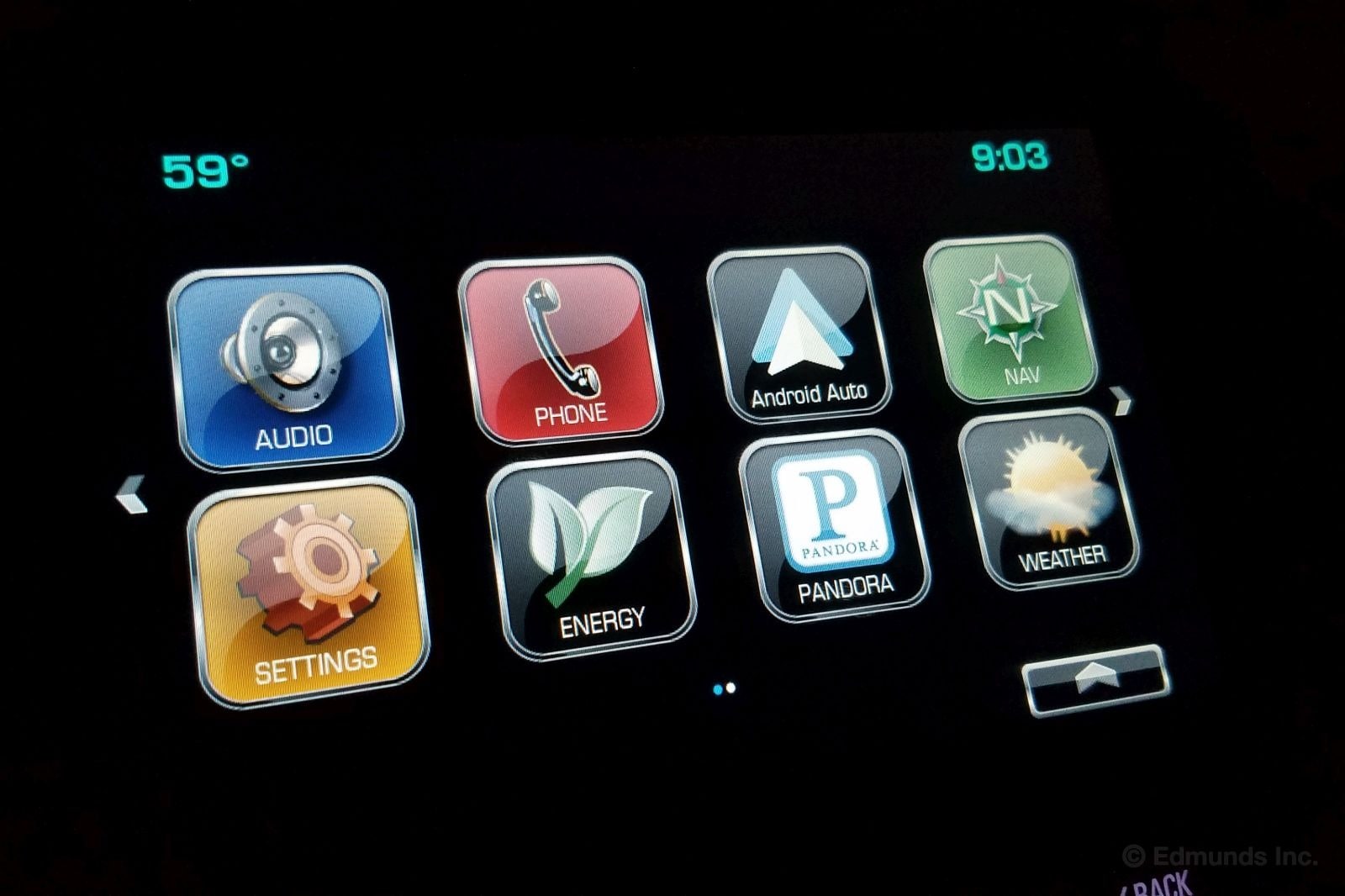
When the 2016 Chevrolet Volt was first introduced to the media, its 8-inch MyLink touchscreen audio system was touted as being able to support Apple CarPlay and Android Auto. But there was an asterisk: CarPlay would work at launch, but Android Auto fell into the automotive abyss called "late availability."
We later learned this meant the necessary reflash would become available to Chevrolet owners with the supported MyLink touchscreen audio systems in March 2016. March was nearly over when I decided to call our Volt dealer to set up a time to bring it in. But the person I talked to seemed unsure and said something about the update being delayed until April. Funny: I hadn't read any such press release.
Unsatisfied, I called Guaranty Chevrolet, which should have been my first choice because it's barely two miles from my home.
"Sure," they said. "Bring it right in." In 15 minutes, I was doing paperwork with Andrew, the service writer.
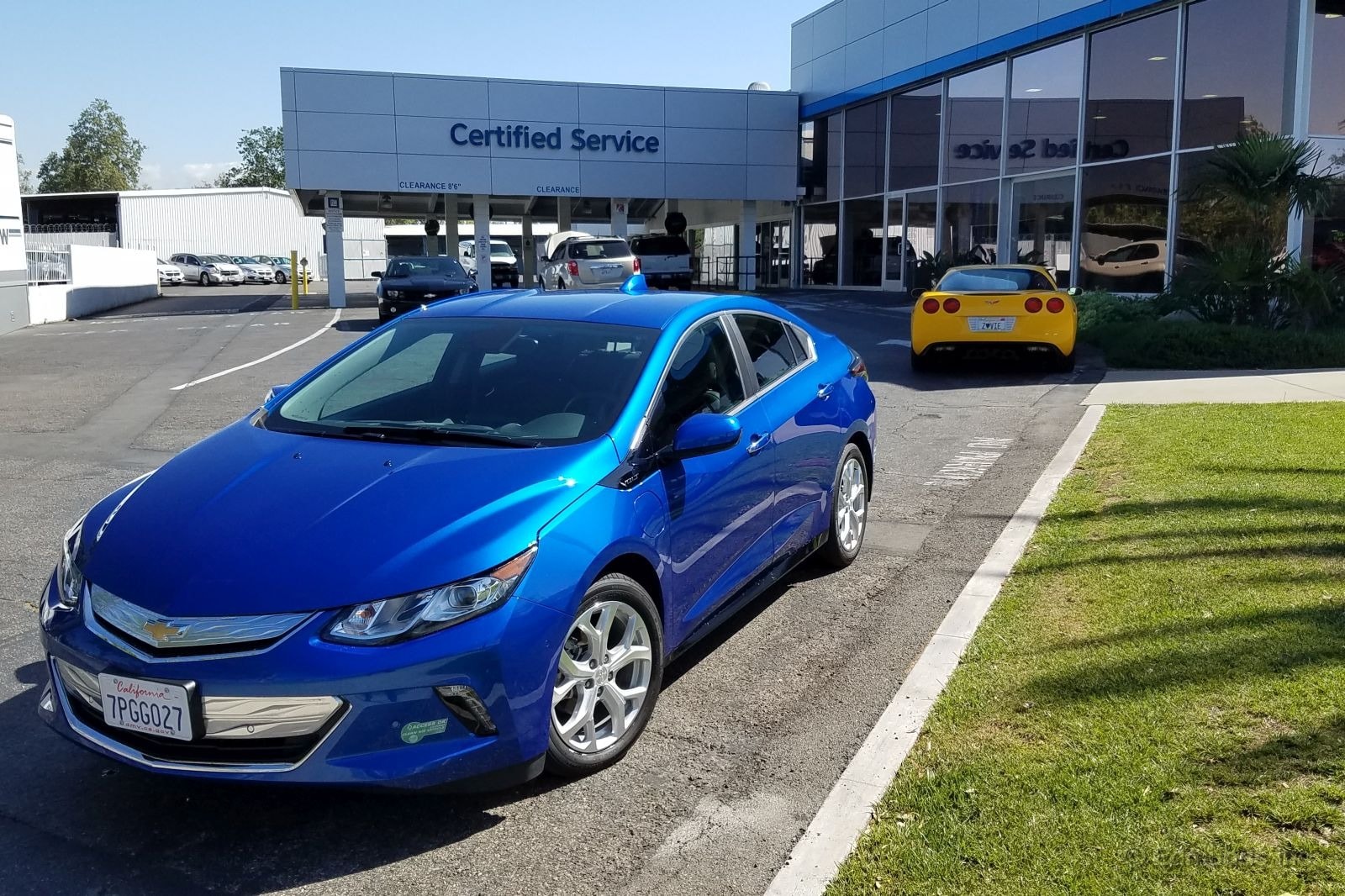
Andrew noticed that our car's VIN was flagged for a service update to correct the potential for an engine misfire. We'd never experienced anything of the sort, but the necessary reflash would only add 10 minutes to the process.
I'd been warned that it might take two hours or so, even though everything I'd read suggested it was a 30-minute job. It didn't matter much because I had my laptop and plenty of work to do, and they had WiFi access, a nice waiting room desks and hot coffee.
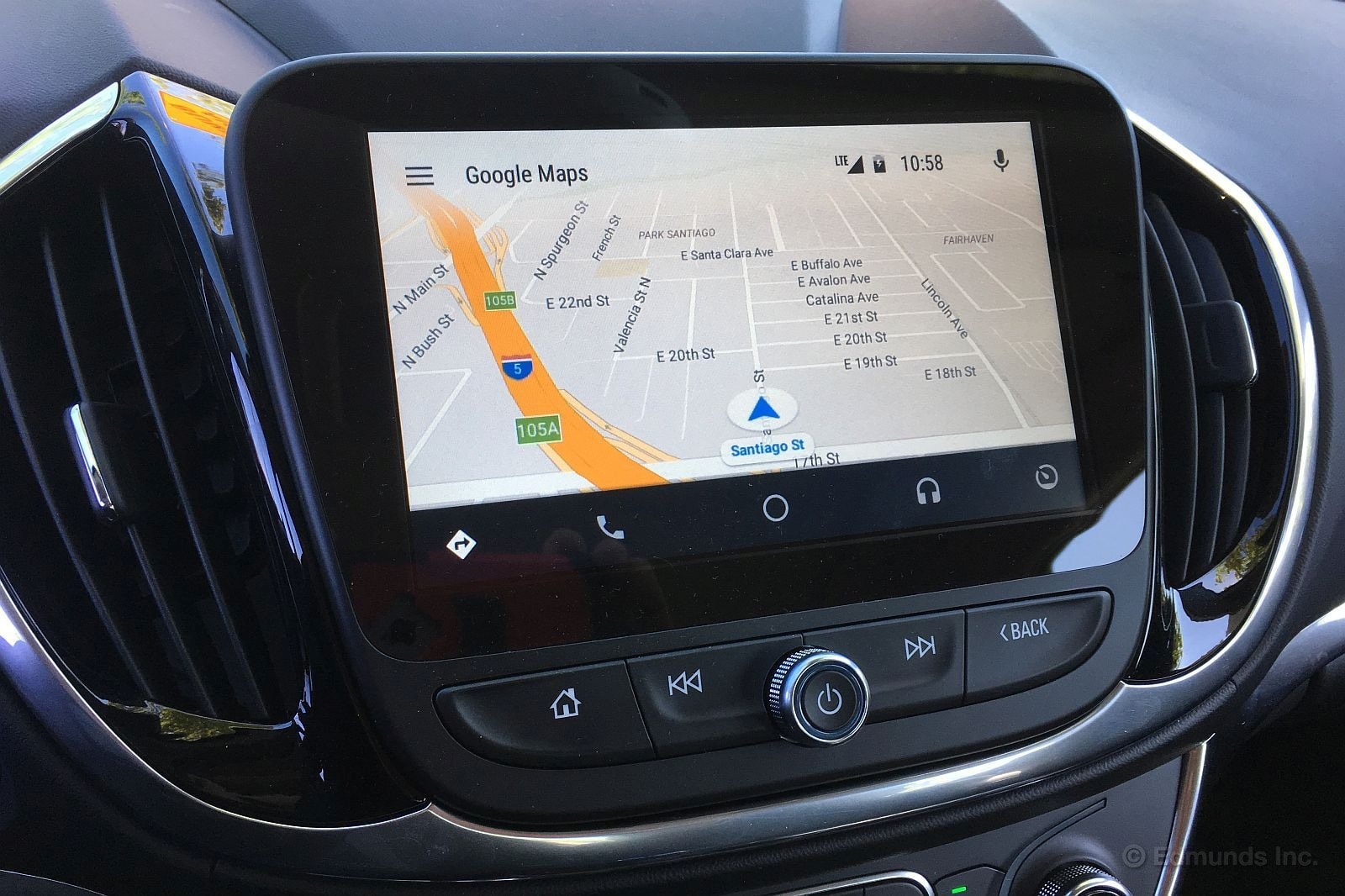
In the end, it didn't take 30 minutes, but it didn't take 2 hours either. The car was back in the drive dripping from a fresh wash a little more than an hour after I'd cracked open my laptop and attempted to ignore The View on the waiting room TV.
I immediately plugged in my new Galaxy S7, but it didn't seem to work. Turns out the car was prompting the phone to download the necessary Android Auto software and get me to accept some Terms and Conditions. This all had to be done in Park with the brake set.

After five minutes I was in business and on the road, where the system worked beautifully. And I mean that literally because the full-width Google Maps and the audio and phone display graphics looked great.
That's right: Google Maps. This alone puts Android Auto on a plane above Apple CarPlay, which forces you to use the dreaded Apple Maps.
As with CarPlay, pressing and holding the voice control button bypasses the GM voicemail and jumps to Android voice commands, which understand natural language amazingly well.
I'm still figuring it all out, including which apps are supported and which aren't. So far it seems the Android Auto update was well worth the wait. It was also worth the price, which was a warranty job that cost zero, zilch, nada.
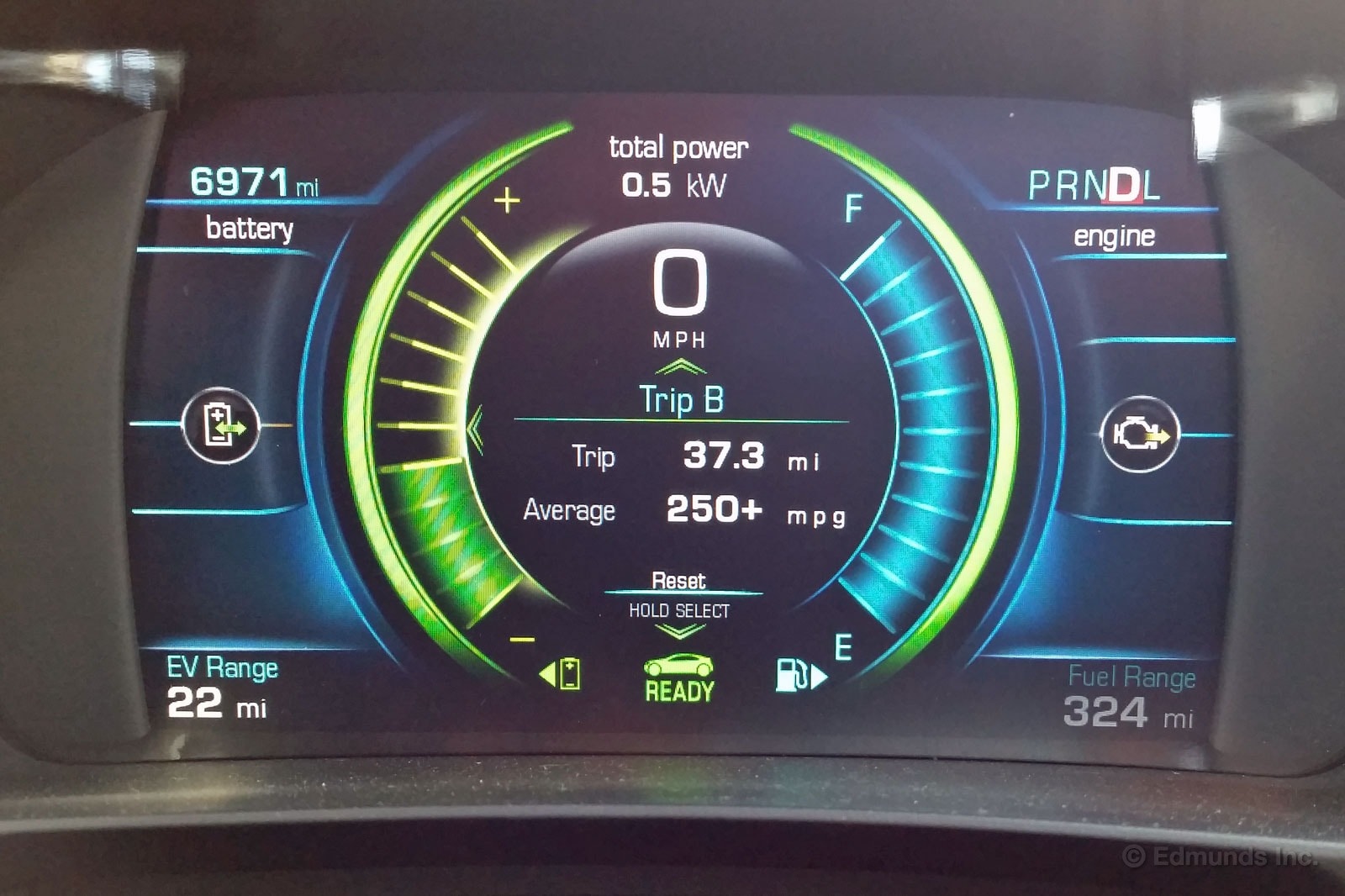
Some of the guys have been bragging about their range accomplishments in our 2016 Chevrolet Volt test car, so I'm going to add my "win" to the mix.
When I unplugged the Volt at the office garage, it showed 50 miles of EV range on the charge meter. With the trip odometer at 0.4, I began my 37-mile drive home. I arrived home with 22 miles to spare.
Higher math tells me I drove 36.9 miles on 28 miles of "fuel," earning a bonus of 8.9 miles or approximately 25 percent of my one-way commute.
Traffic was pretty light, and I was able to drive normally (for So Cal), averaging around 60 mph.
Let the Range Games continue.
Still Has a Mountain Mode, but Seems Less Necessary
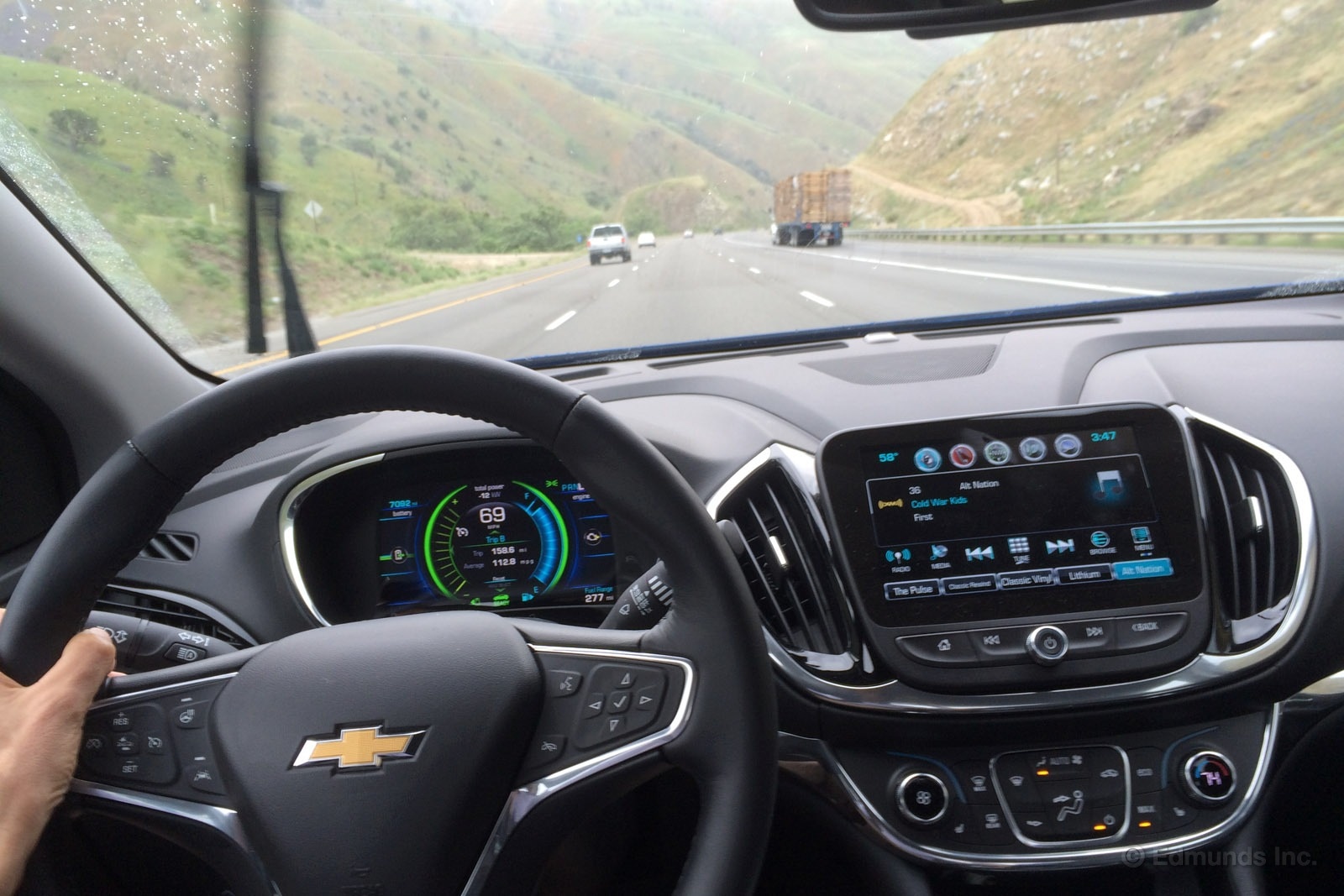
A few days ago, I was driving our 2016 Chevrolet Volt for the first time. I also happened to be driving north on Interstate 5 approaching the Tejon Pass (the "Grapevine"), which is a mountain pass north of Los Angeles that climbs to about 4,100 feet and then eventually dumps motorists out into California's agricultural and bovine heartland. As the mountains loomed in the Volt's windshield, I thought to myself: "Wait, isn't there a mountain mode that you're supposed to use in this thing?" This was based on recollections of our previous long-term 2011 Volt.
Well, it turns out that there still is a special mountain driving mode in the new Volt. But the Volt's mechanical improvements have rendered it less necessary, at least in my mind.
The mountain mode, according to the Volt's owner's manual, "...should be selected at the beginning of a trip before climbing steep, uphill grades and when expecting to drive in very hilly or mountainous terrain. This mode maintains a reserve electrical charge of the high voltage battery to provide better grade climbing performance."
My problem was twofold: A) I was already at the base of the mountains, and B) I was already nearly out of battery power anyway. At that point, I decided I'd just climb the mountain grade using the Volt's normal driving mode and see what happened.
Short answer: Nothing out of the ordinary. The Volt's gasoline engine fired up unobtrusively and kept the Volt powering up the grade at 70 mph, just like a typical car. There was no real engine racket or lack of oomph. "Did it without breaking a sweat," you might say.
I went back and looked at our reporting on our 2011 Volt and discovered James' update about running low on power after encountering hilly terrain. That's likely the nugget of info that stayed in my head all these years. But the 2016 Volt's new 1.5-liter gasoline engine is more powerful than before and now takes on the majority of responsibility for driving the front wheels once the battery is depleted.
I imagine there are still other mountain passes in North America that would warrant using the 2016 Volt's mountain mode. But this drive, at least, stood out to me as a solid example of the Volt's substantial improvement in usability compared to the old model.
Could Reduce the Guilt for Driving To Get the Mail
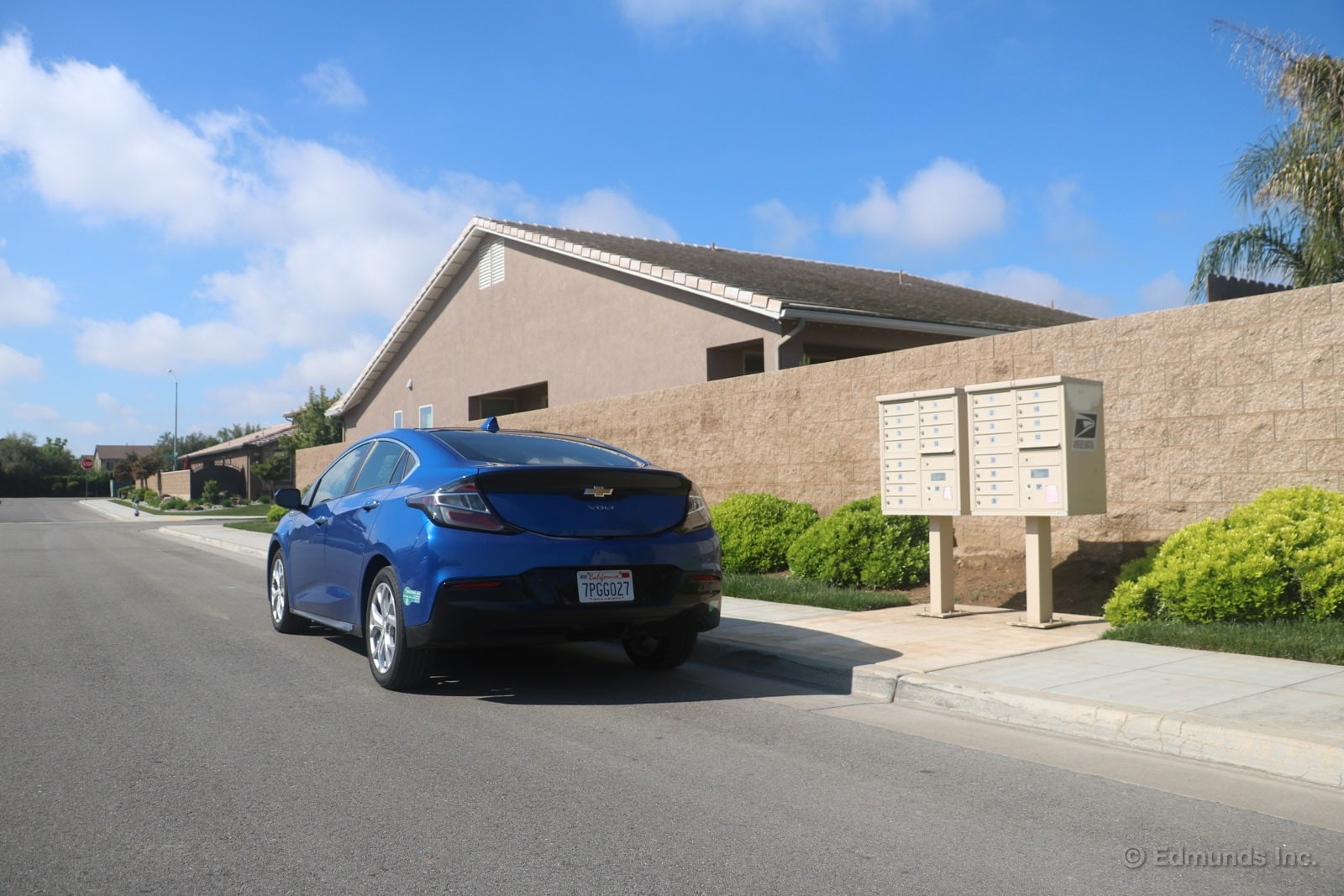
There's a scene in the 1991 movie L.A. Story when Steve Martin's character gets in his Chrysler LeBaron to drive to his friend's house. His friend lives two houses away from his. It's played for comedic effect, yet I've seen a neighbor of mine do essentially the same thing to get her mail from the communal mailbox just a few houses away.
Nobody walks in Edmunds.com's hometown of L.A., or so the saying (or song) goes.
If you're that type of person, odds are you're not worried about wasting gas or incurring the tailpipe emissions that occur mostly at cold engine startup. But that said, it's arguably easier to feel less guilty if you're driving a 2016 Chevrolet Volt to pick up your mail from your mailbox or visit your friend a neighborhood away. Revel in your laziness, in fact!
Most of the time in a Volt, you're just powering around on pure electric power. The Volt's gasoline engine/generator only turns on when the battery pack is drained. So if you're just driving a few hundred feet, for example, the experience can be a lot like zipping down the street in a golf cart.
Unlike with a traditional gasoline-powered car, you're not losing all that potential energy due to heat loss (the heat generated by the burning of the gasoline). Nor is the Volt spewing undesirable pollution out its tailpipe under electric power. An engine puts out the majority of its emissions when it's cold because its catalytic converter has not yet warmed up, and those need to be hot to be at their best.
With the Volt (or similar plug-in hybrid or pure electric vehicle), you'd still likely be generating carbon dioxide or other pollution indirectly through whatever means you used to recharge the battery pack. If your house gets its power primarily from a coal-burning power plant, and you recharge your Volt at home, you're effectively powering it from coal. But overall, the efficiencies of electric power are pretty obvious .
I'll still be walking to get my mail and riding my bike to visit neighborhood friends. But with our long-term Volt in my driveway, the temptation to just hop in and drive is certainly there.
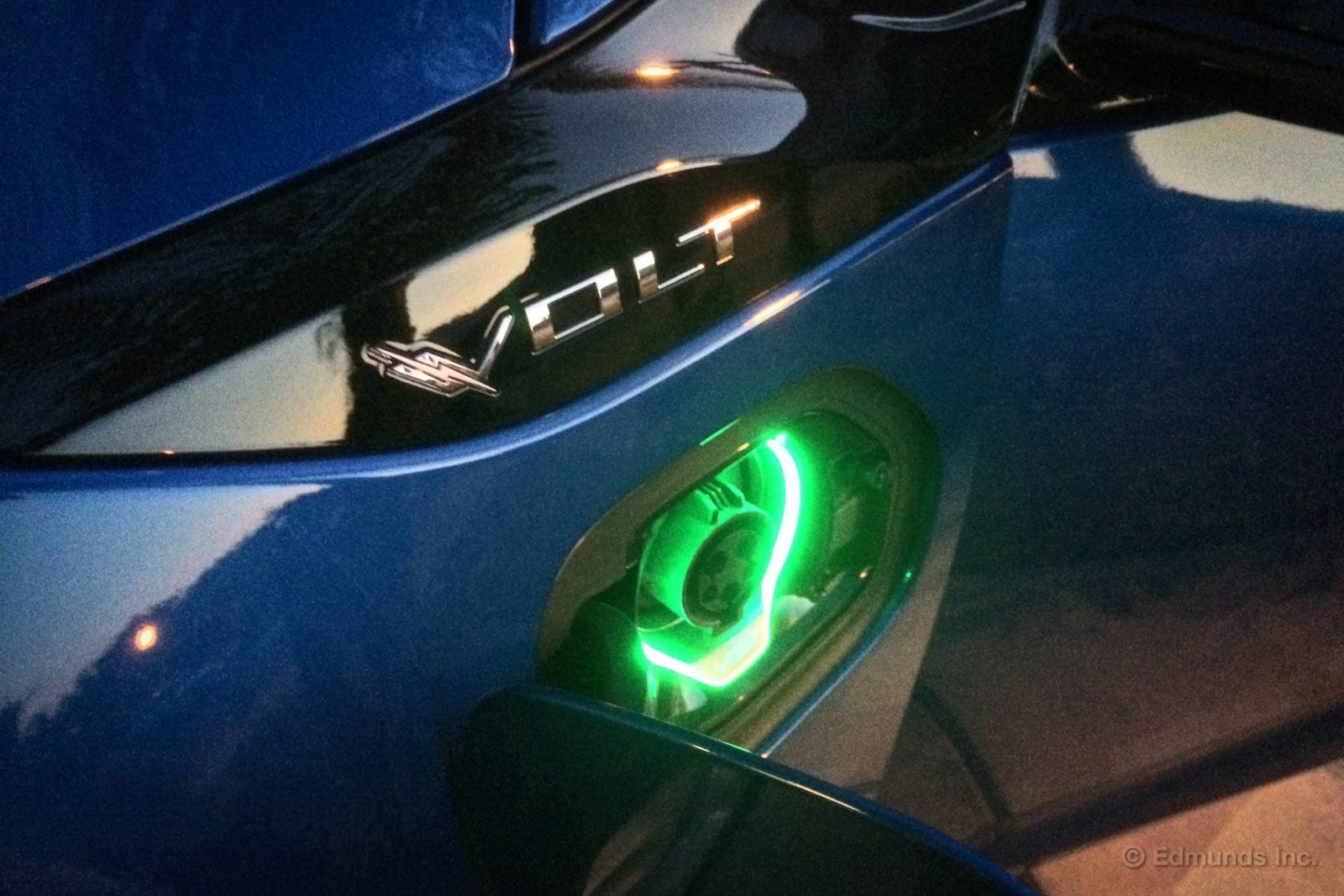
One of the big improvements for the 2016 Chevrolet Volt is greater full-electric driving range. The previous generation Volt had an EPA-estimated range of 38 miles; the new model can go 53 miles typically before switching on its gas engine/generator (and we've already exceeded that easily a few times). The upshot is that we're spending even more of our time driving our Chevy Volt like it was an electric vehicle (EV).
That's pretty neat, but it also made me wonder: When it's just using its electric battery power, how efficient is the Volt compared to other plug-in hybrids or even other EVs? Or, put in the way we would ask a friend about his or her regular new car: what kind of mpg is it getting?
My first stop for learning more was fueleconomy.gov. Each EV or plug-in hybrid has an efficiency estimate. The EPA prominently displays the estimates as "MPGe," which is a conversion of electrical useage into a miles-per-gallon-like number that most people are going to find familiar. In the Volt's case, that's 106 MPGe.
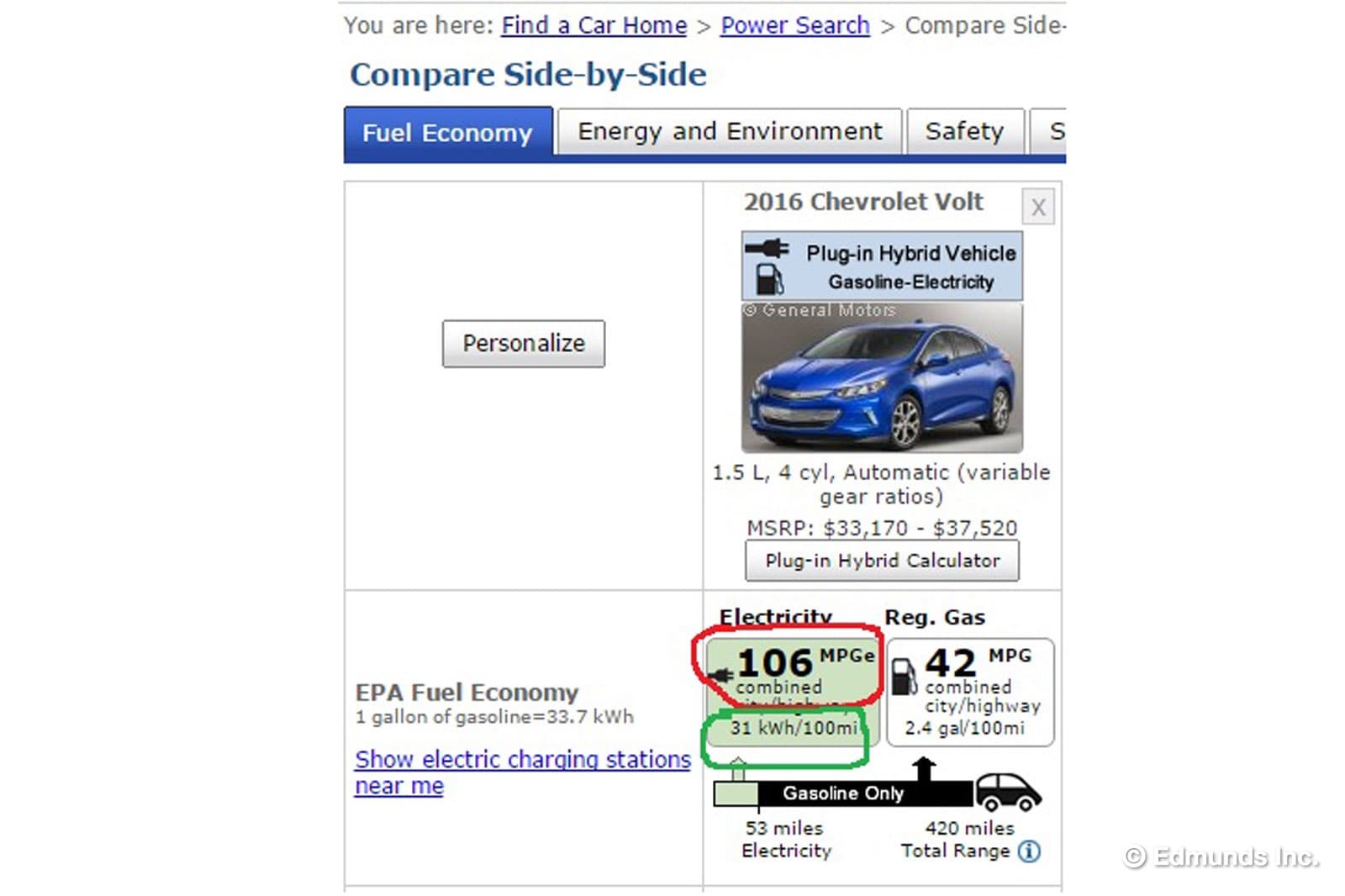
But the real number is actually below that in a smaller font: 31 kWh per 100 miles driven. That means for every 100 miles we drive our Volt in EV mode, the EPA estimates (based on its standardized driving tests) that it will utilize 31 kWh of electrical energy. A lower kWh number means less energy consumed and therefore better efficiency. (The Volt's battery pack can't actually hold 31 kWh of energy, though, which correlates to its fewer than 100-mile range.)
So we've got our 31 kWh/100 miles figure for the Volt. Here are some other samples from the EPA:
2016 Audi A3 eTron (plug-in): 40 kWh/100 miles
2016 Ford Fusion Energi (plug-in): 37 kWh/100 miles
2016 Hyundai Sonata Plug-In: 34 kWh/100 miles
2016 Kia Soul Electric: 32 kWh/100 miles
2016 Fiat 500e: 30 kWh/100 miles
2016 Nissan Leaf: 30 kWh/100 miles
2016 BMW i3: 27 kWh/100 miles
Again, lower is better. As you can see, the Volt, when it's running in pure electric mode, is right in the mix with the dedicated EVs like the Leaf and 500e in terms of energy efficiency. I wouldn't have necessarily expected that given the added complexity and/or weight of being a plug-in vehicle.
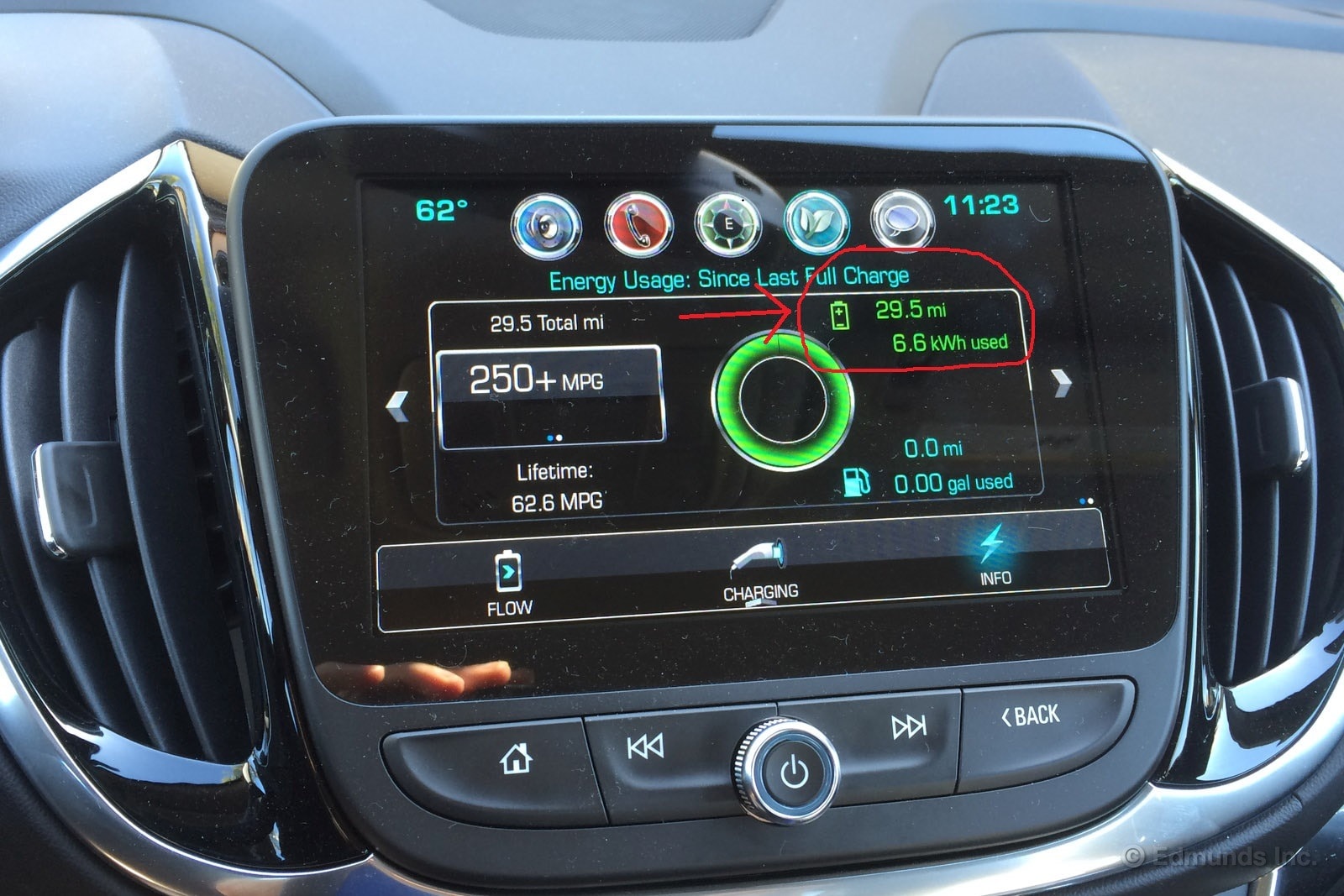
I've also been keeping an eye on what is effectively the Volt's in-car "fuel economy" gauge for electric drive. Available through the touchscreen, it shows the miles driven and the kWh energy used to drive that distance.
You can convert that number to be equal to per 100 miles driven to see how your driving efficiency compares to the EPA's. The pictured numbers above — 29.5 miles and 6.6 kWh used — calculate out to about 22.4 kWh/100 miles. (It's worth noting that there's some inherent inefficiency during the battery recharging process, so I'd end up "putting in" more than 6.6 kWh's worth of electricity to fully recharge the battery, but that's another topic.) When Mike Magrath made his highly impressive 74.8-mile all-electric drive, he averaged about 19.0 kWh/100 miles.
For me, it's just fun to think differently about efficiency in a way that's not miles-per-gallon. And as more people buy plug-in hybrids or dedicated EVs, it's bound to become more of a topic.
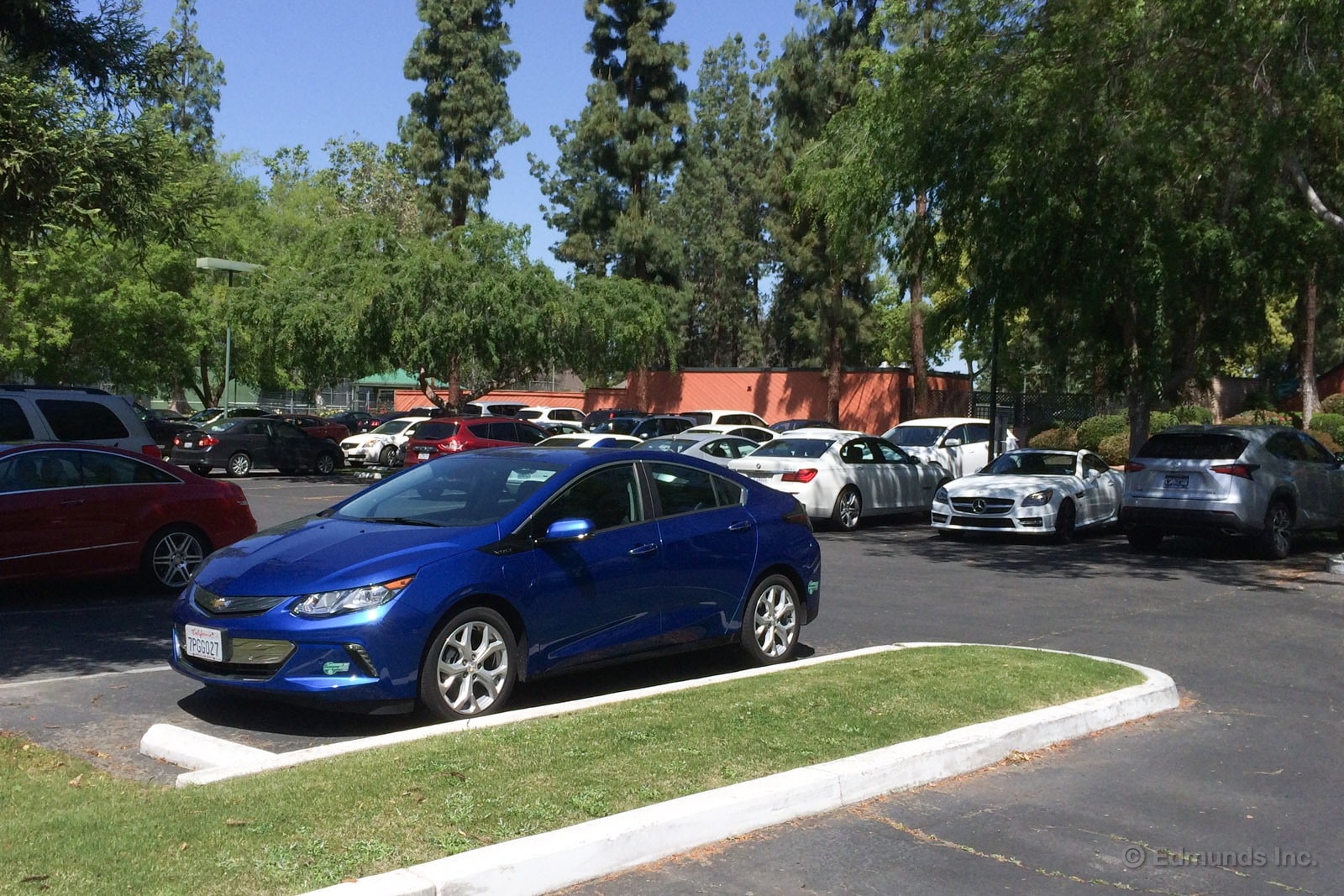
I've been driving our long-term 2016 Chevrolet Volt for more than a week straight now. One of the interesting aspects to me has been how easily the Volt blends in with everything else on the road. Styling the second-generation Volt to look more "normal" was clearly a priority for Chevrolet, and it seems to have worked.
Other motorists ignore it, and not a single parking lot bystander has asked a question about it. It's pretty easy to imagine other people dismissing it as some sort of Chevy Cruze hatchback, or a Honda or Kia.
With the caveat that my experience is just a small sample, I pose the following question: Would you want to buy a Volt because of this, or would you want something that stands out more?
To add to my point, it's not just all about the exterior styling, either. The uninitiated might not even notice anything if he or she is sitting inside the Volt. Example: My mom has been visiting me from out of town. I picked her up at the airport in our Volt, threw her luggage in the hatchback cargo area, and brought her home (all under electric power). I purposely didn't say anything about the car to see if she noticed anything. Nope. She was oblivious.
Personally, I'm fine with being low key. I don't need to be the equivalent to a rolling neon sign blinking "I'm saving the planet!" Plus, this more humble persona also fits the way the Volt drives. From the way it accelerates, brakes and goes around turns, it's a lot like driving a regular car.
But I could also envision a potential owner wanting a bit more status from his or her new plug-in hybrid. A certain appeal to the Tesla Model S and X is the "cool" factor. If your neighbor sees your Volt and just thinks you bought the new Civic hatchback, where's the fun?
5 Reasons You'll Like the MyLink System Interface
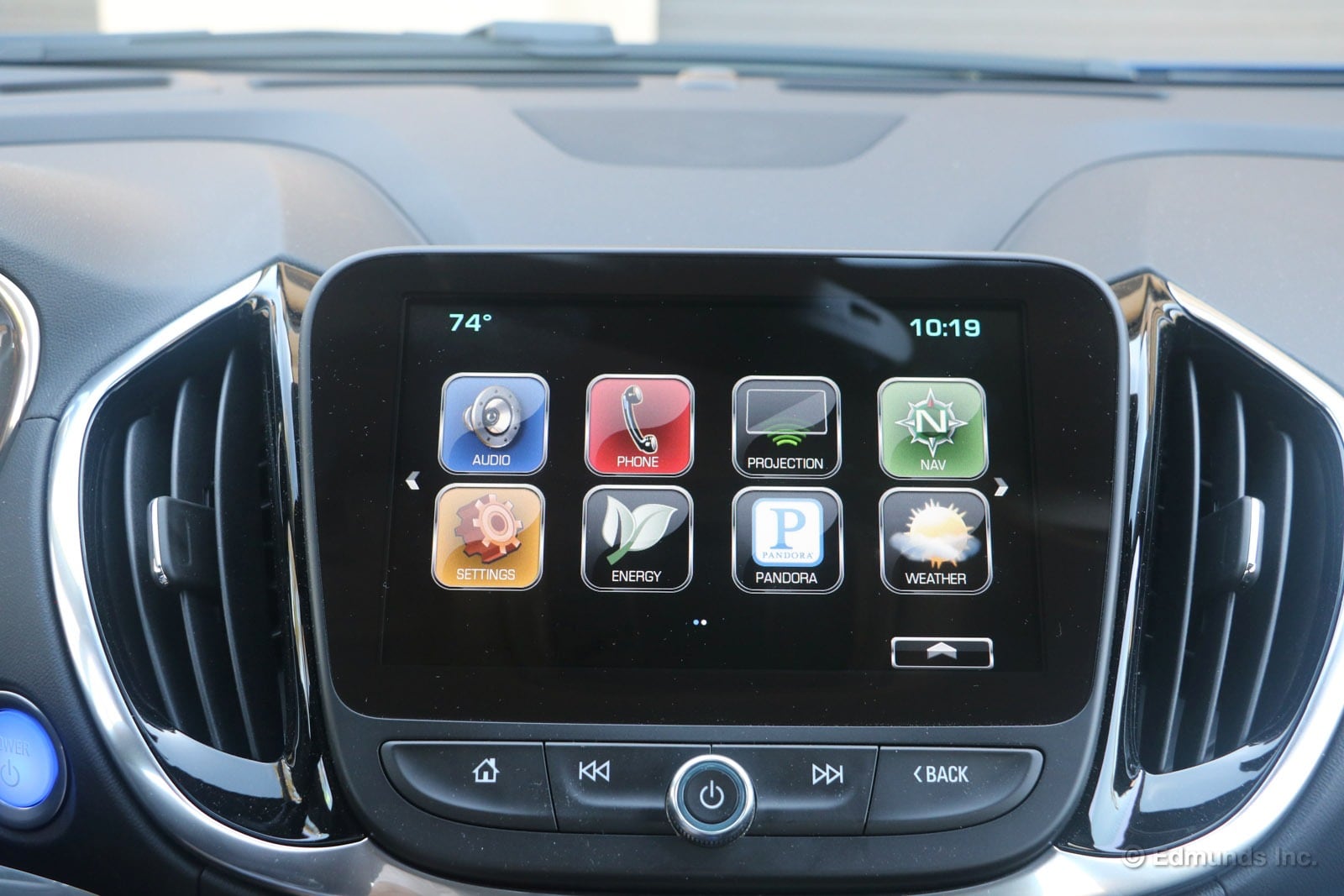
The 2016 Chevrolet Volt comes standard with an 8-inch touchscreen interface. It's the "MyLink" system that Chevy has been utilizing for a few years now. In the past, we were underwhelmed with MyLink, finding it slow and unresponsive at times. But our Volt has the latest iteration, and it has some appealing aspects. Here are five reasons why I think you'll like it.
1) Big screen size. The typical automotive touchscreens range from 4 to 8 inches in diagonal width. (Yes, go ahead and insert your cliched joke here.) When the screen is bigger, it allows the system's designers to make the virtual screen buttons bigger and easier to consistently press. There's more room to display maps and info, too. The 2016 Volt has an 8-inch screen compared to the previous generation's 7-inch screen. That may not sound like much of a difference, but it amounts to a lot more screen area because of math.
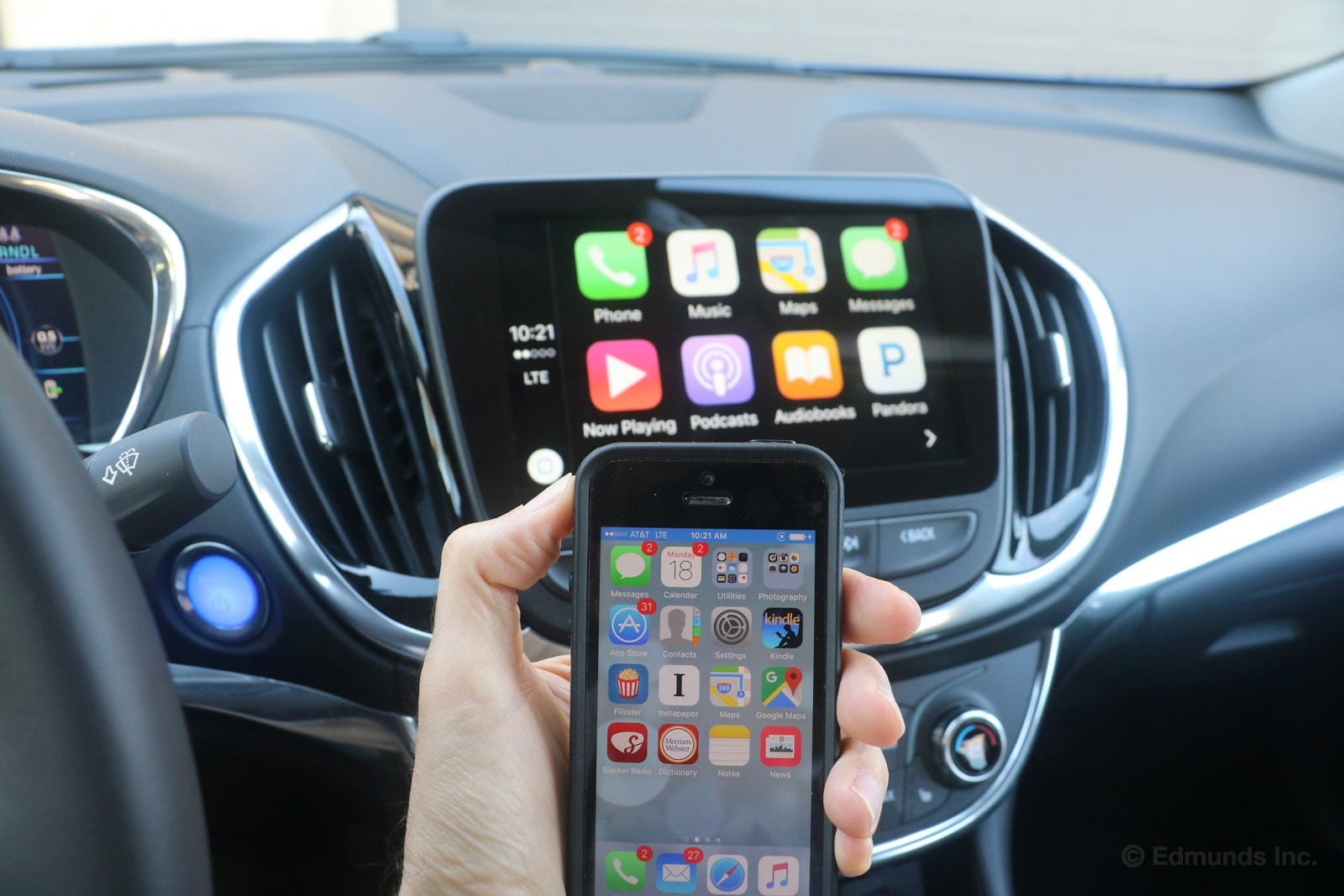
2) Smartphone integration. The newest version of MyLink includes Apple CarPlay and Android Auto. I've only tinkered with CarPlay on our Volt, but it's pleasingly easy to get up and running. Just plug in your phone using a cable and your phone's core functions plus a selection of third-party apps (that you might have on your phone) become available through the car.
3) Quick responses. This is a welcome improvement. I've been impressed by the touchscreen's response times. Press on a virtual button and the system responds crisply. There's no waiting or wondering whether your button press actually registered or not.
4) Simple menu interface. The newest MyLink interface design is pretty similar to what existed before, but it seems to me that it's a little easier to use. (Check out some pictures of our 2014 Chevrolet Silverado's touchscreen here.) The main control icons (audio, phone, navigation, etc.) are always available at the top of the screen. Finger swipe movements move you through optional menus and the radio presets, and pinch and spread works on the navigation map.
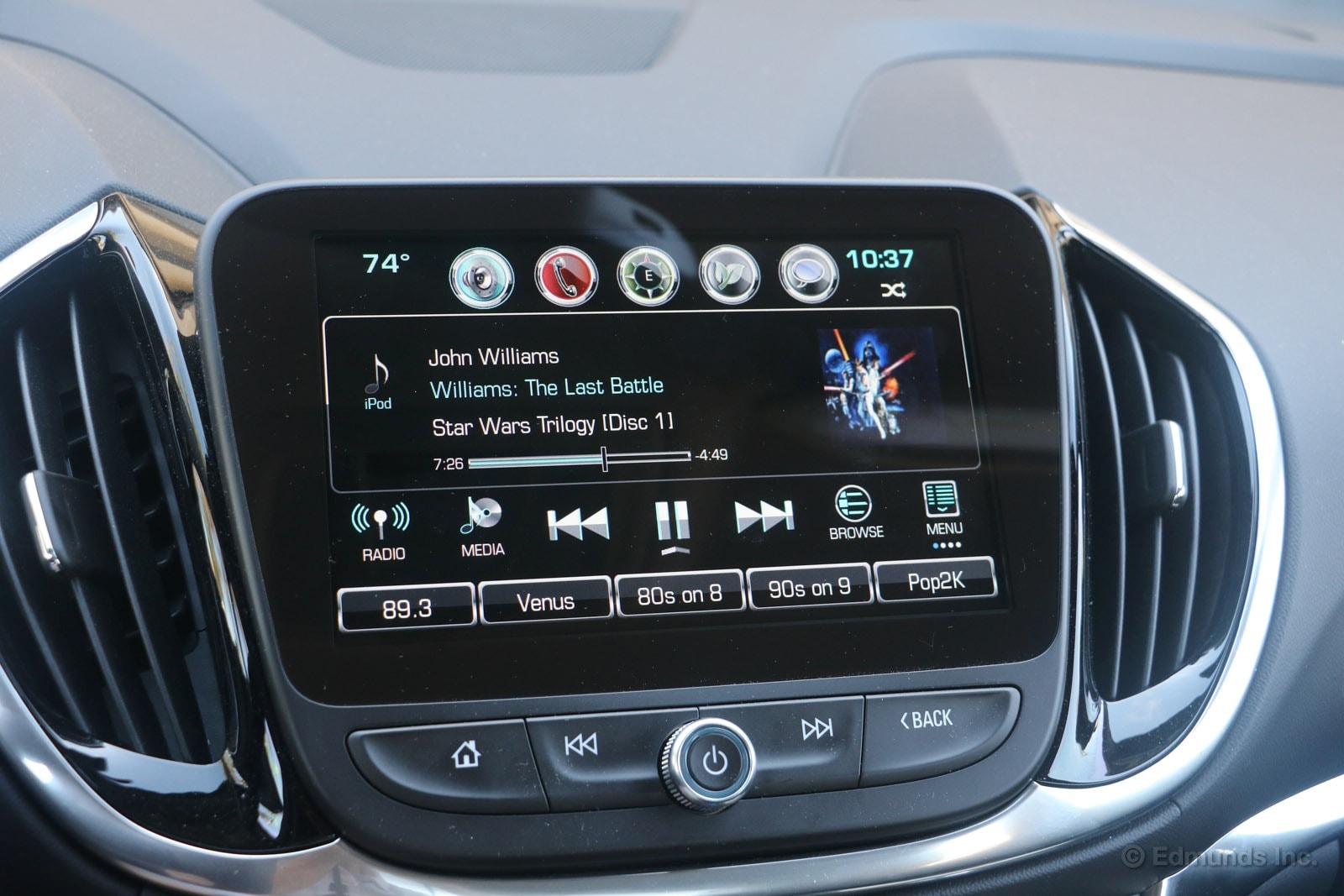
5) Voice controls and media interface. Even if you don't have a smartphone, you can still use MyLink's integrated voice controls to operate various systems. I also like regular digital media player interface (for your older iPod, for example) for its quick file browsing and easily accessible functions.
Brake Pedal Feel Is Consistent, Easy To Modulate
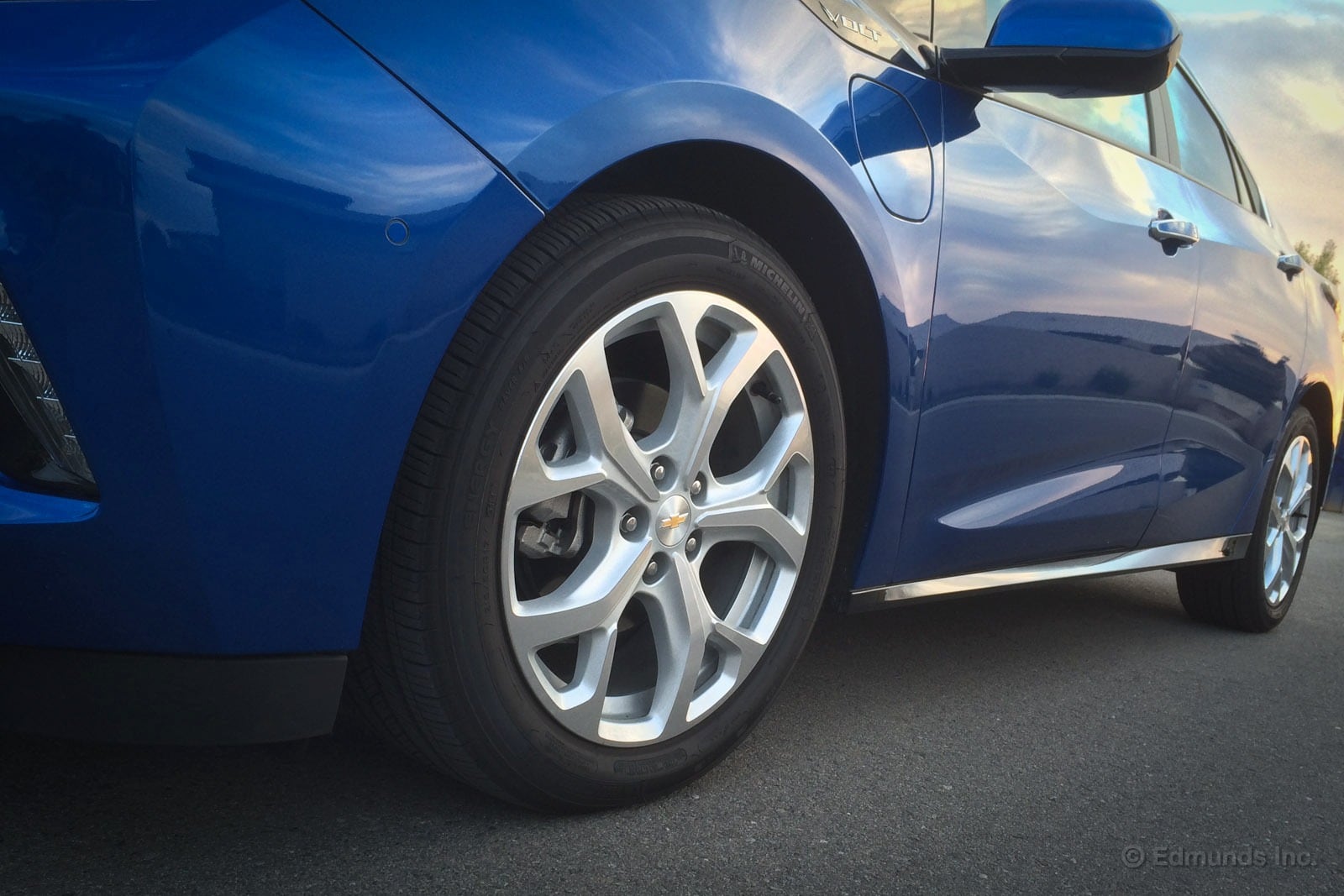
A common annoyance for drivers of hybrid-powered vehicles is a brake pedal feel that's not consistent or easy to modulate. This was an issue we noticed with the previous generation Volt. But the 2016 Chevrolet Volt is noticeably improved. It's now easy to come to a stop smoothly every time.
This particular issue crops up because a hybrid vehicle can utilize two different systems to help slow the car down. One is the traditional friction brakes (i.e., the disc brakes at each wheel). But there's also the electric motor/generator (part of the hybrid powertrain) that is used to convert some of the vehicle's forward momentum into electricity that can be used to recharge the battery pack. This is commonly called regenerative braking.
The regenerative braking can only apply so much stopping power, however, so combining it with the friction brakes in a way that's transparent and linear to the driver has been the struggle for automakers.
But Chevy has gotten it right with the new Volt. If you step on the brake pedal to slow the car down, it feels pretty much just like you'd expect from a regular vehicle. (It's way better than the grabby brakes in our long-term Tacoma, just for comparison's sake.)
There are other ways to reduce speed in the Volt. As we wrote previously, you can also use the gear selector's "L" mode and the paddle on steering wheel. Both apply a specific amount of regenerative braking. But if you just want to keep it simple and use the Volt's regular brake pedal exclusively, I think you'll be pleased.
Charge Time Surprise and the Importance of Power
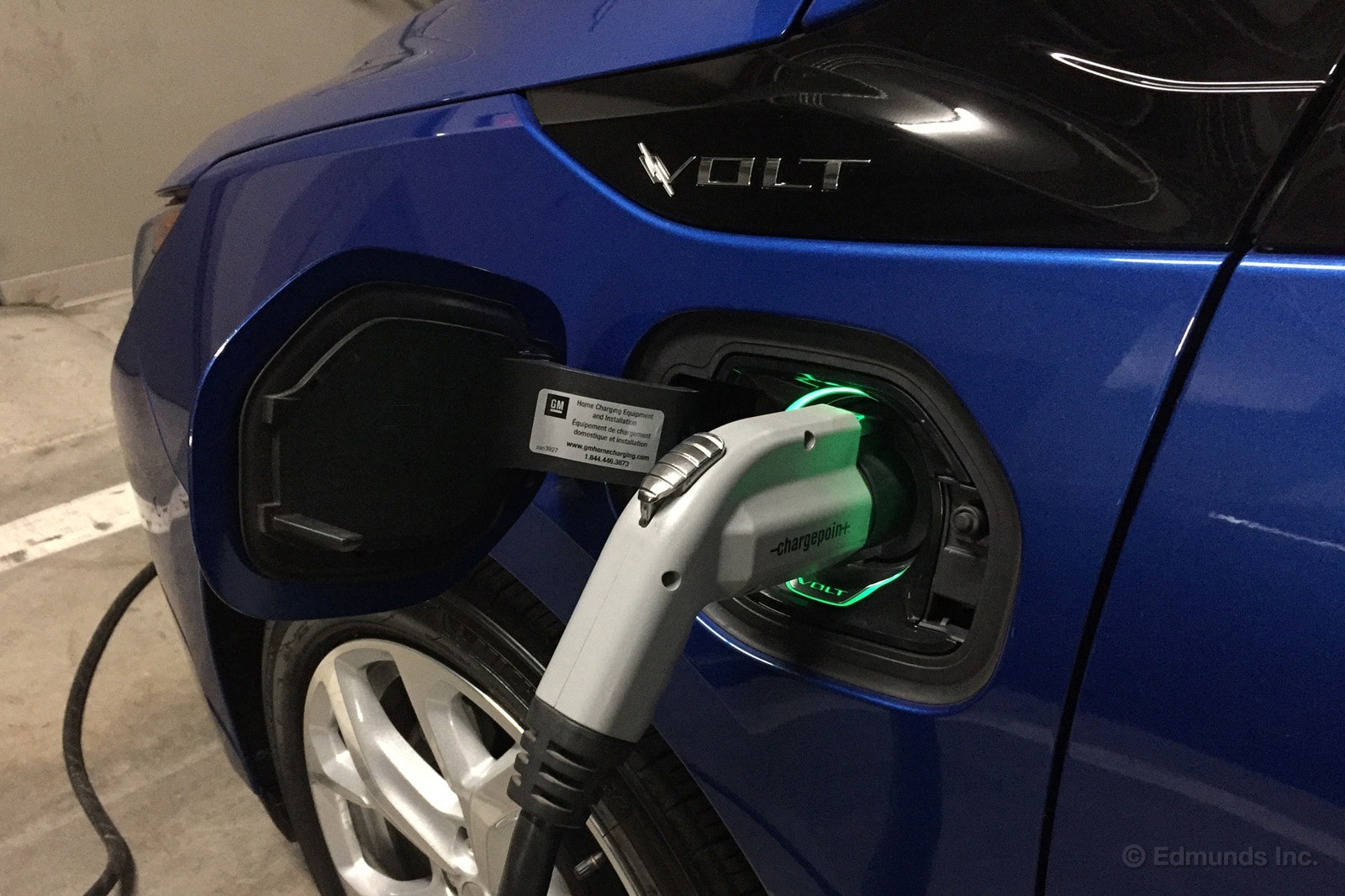
I arrived at Edmunds HQ at 6:45 on Monday morning. The 2016 Chevrolet Volt was in desperate need of a bath, and our preferred car wash wouldn't open for another couple hours. Perfect, I thought. This would (or should) be enough time to fully recharge the Volt's depleted battery
Based on my experience with our old 2014 BMW i3, I estimated I would make it out of the office with the Volt around 10 a.m.. The i3 had a 22 kilowatt-hour battery and an all-electric range of 72 miles. It took about four hours to fully charge.
Our Volt, meanwhile, has a range of 53 miles from an 18.4 kWh battery. Using the i3 as my mental yardstick, I reasoned that it would take less time for the Volt to charge.
Nope. It took five hours.
The difference is all in the capacity of the onboard charger. The i3 has a 7.4 kilowatt charger, while the Volt makes do with a 3.6 kW charger. Assuming it's plugged into a system that accommodates the maximum charging rate, the i3 will "fill" faster than the Volt even though the i3's battery is larger.
Sure, a higher-power onboard charger would be far more convenient, but at least the Volt has a gasoline engine to fall back on when its juice runs out. I only make this point because there are pure electric vehicles out there with low-flow chargers like the Volt's. They include:
2016 Chevrolet Spark EV: 3.3 kW onboard charger (7 hours @ 82 miles of range)
2016 Mitsubishi i-Miev: 3.3 kW onboard charger (7 or 8 hours [claimed vs observed] @ 62 miles of range)
2016 Nissan Leaf S: 3.3 kW onboard charger (8 hours @ 84 miles of range)
2016 Volkswagen e-Golf SE: 3.6 kW onboard charger (7 hours @ 83 miles of range)
All of the above charging times assume a connection to a Level 2 charger.
Keep in mind that the Leaf and e-Golf offer more powerful chargers in upper trim levels that significantly reduce charging times. For example, the Leaf SV and SL have a 6.6 kW onboard charger that cuts the charging time to five hours despite also having a larger battery pack with greater range. The e-Golf SE's DC Fast Charging package (standard on the SEL) includes a 7.2 kW charger that reduces charging time to about four hours.
The benefits to a quick charging time aren't limited to reducing the impact on your personal schedule. While there are public charging stations out there that cost nothing to use, many charge per kilowatt-hour of energy transferred or per hour that the vehicle is plugged in. If you're using a station with per-hour pricing, the higher-capacity onboard chargers mean you'll pay less to charge it.
The old saw "time is money" has never been more true.
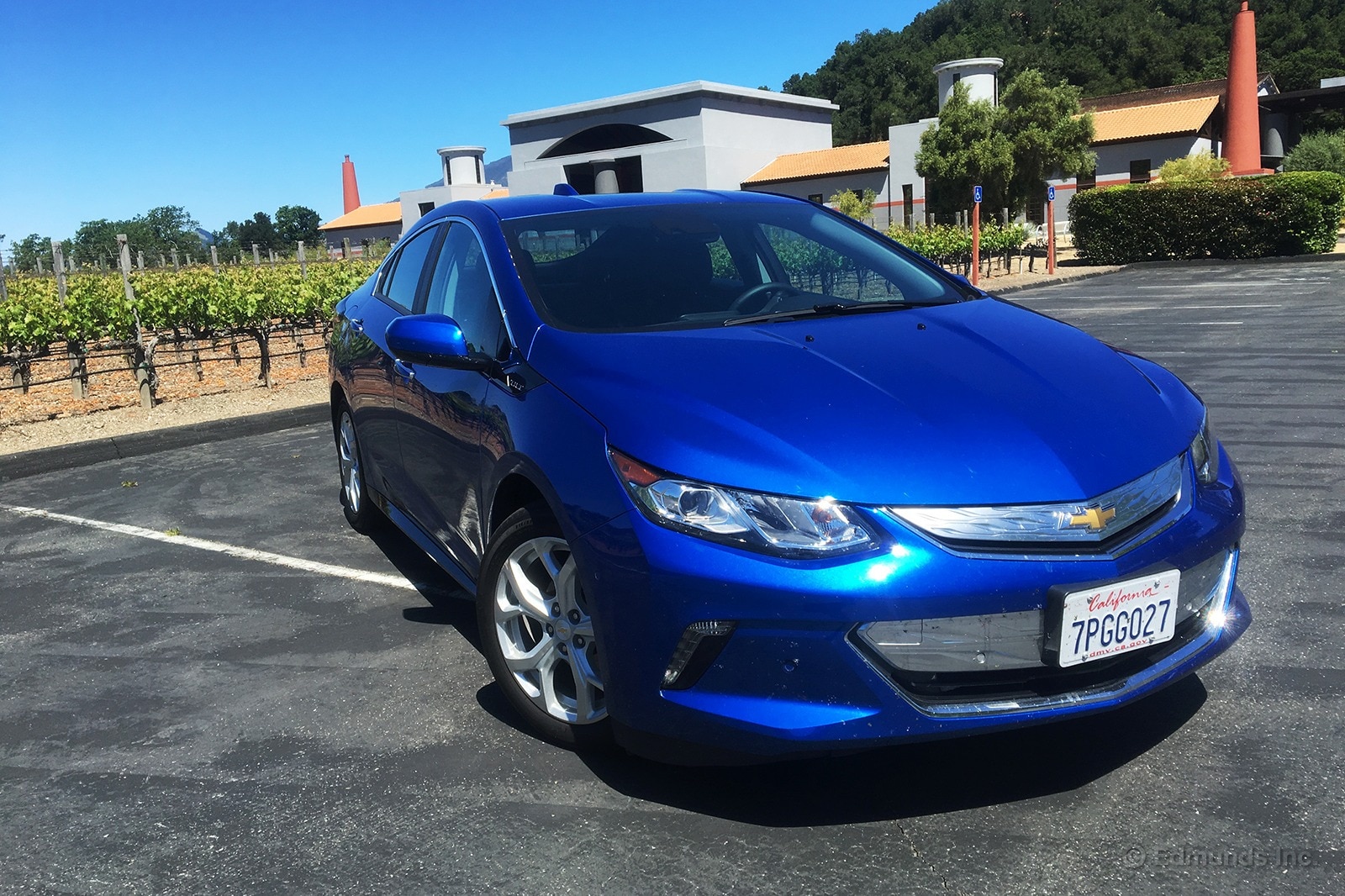
Rather than take a flight up to California's wine country for a work trip, I opted to drive the 425 or so miles each way. So the call went out to our in-house wranglers to see which of our long-termers needed some miles. Since our 2016 Chevrolet Volt has been used primarily as a commuter with a charge station on at least one end of the route, it was lacking in the long-distance part of its life.
I left L.A. in the morning, but not early enough to beat traffic. After 42 or so miles the batteries had depleted and switched over to the gasoline engine. The only indication I had of the switchover was courtesy of the gauges. The engine was nearly as quiet as the electric motors and there was no detectable change in power to the wheels.
"Turn right in 140 miles," was the navigation command.
The Volt is a great road trip car. It's quiet and has just as much power as the typical family sedan. The ride quality is as smooth too, with nothing standing out one way or another and that's a good thing.
Three hundred miles in, I was ready for a break and fuel. 7.657 gallons of 87-octane went in for a 39.2 mpg result. Not bad considering the hills and 70-mph speed limits. I arrived at my hotel in Calistoga four minutes before the meeting. Perfect.
As I handed the keys over to the valet, I asked if they had a charging station I could use. He said they do indeed and also have a Tesla-specific charger. The standard charger was right in front but the valet mentioned he would have to wait a while to use it because that section of the lot was reserved just for the cars in the event I was attending.
I told him that he can charge it whenever is most convenient as I wasn't leaving for a few days. The day before my departure, another valet knocked on my door, handed me the keys and let me know that it was fully charged and parked right outside my door. I love good service.
The next morning I departed but drove only about 120 miles south before stopping in Los Gatos, California, for a super fancy dinner with an old friend. The first 49.9 miles were electric-only, once again followed by gasoline power.
I rolled back into L.A. the following afternoon. The whole round trip added another 874.6 miles to the odometer with 21.957 gallons of gas poured in. That figures out to 39.8 mpg if you only account for gasoline. Electrons are cheaper, but they aren't free.
Considering how comfortable the Volt is and how you really can just treat it like an ordinary car, I wouldn't hesitate to road trip in it again.
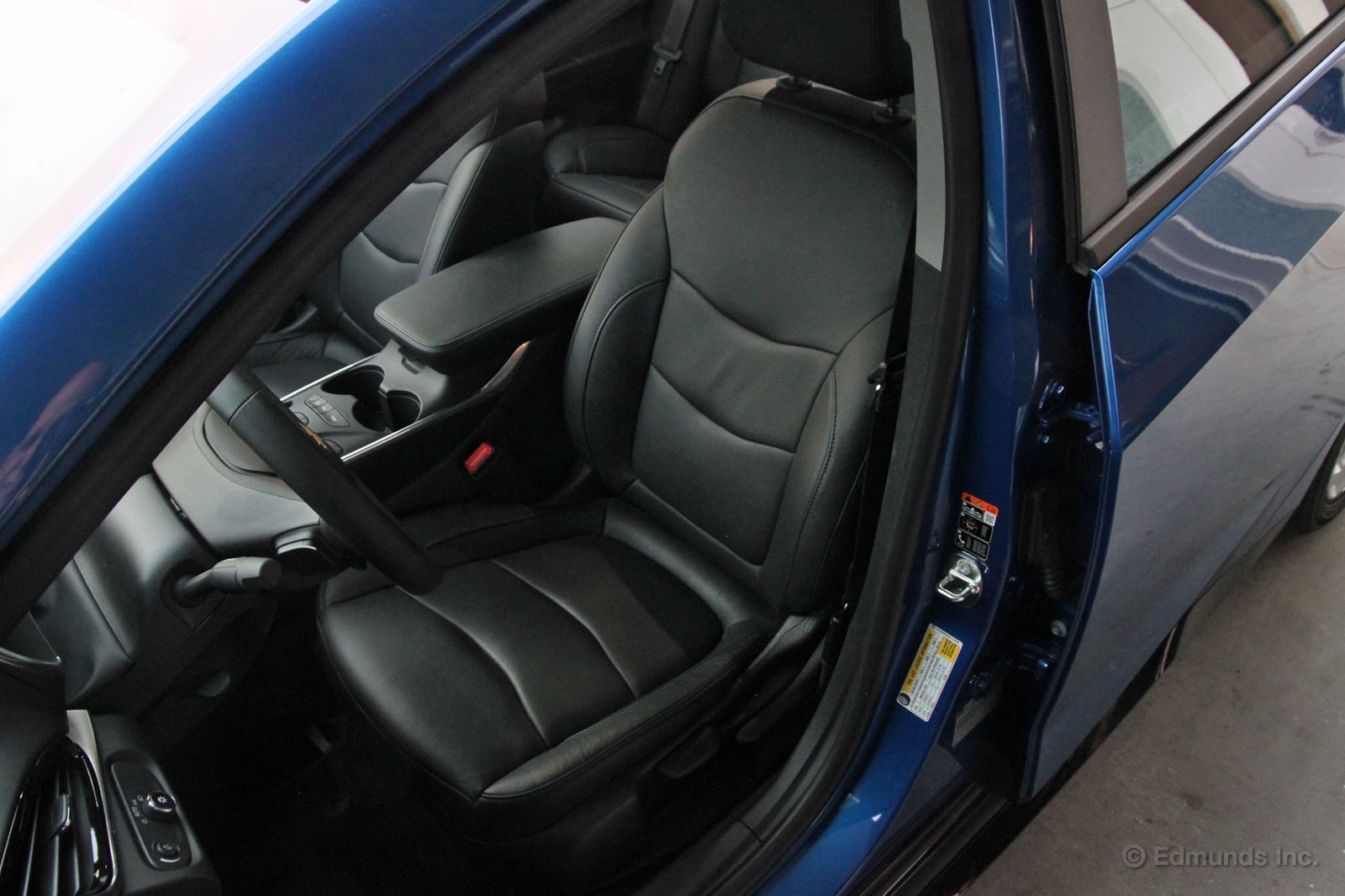
There are many things that make our2016 Chevrolet Volt a great commuter vehicle. Plenty of range, carpool stickers and up-to-date technology that keeps you connected while on the road.
But what about its seats? How do they stack up when you're sitting there staring at the backsides of a few thousand of your fellow commuters?
They are surprisingly comfortable. And I say "surprisingly" because they don't feel all that great when you first sit down in them. They're not covered in particularly nice material nor do they have noticeably firm bolstering.
But after numerous commutes of at least an hour or two, these seats held up well. The urge to fidget did not set in after 45 minutes and I don't remember having to ease the seat back to stretch my legs out as the miles wore on. In other words, I was comfortable enough to not notice them, which is about all I ask for from a commuter car.
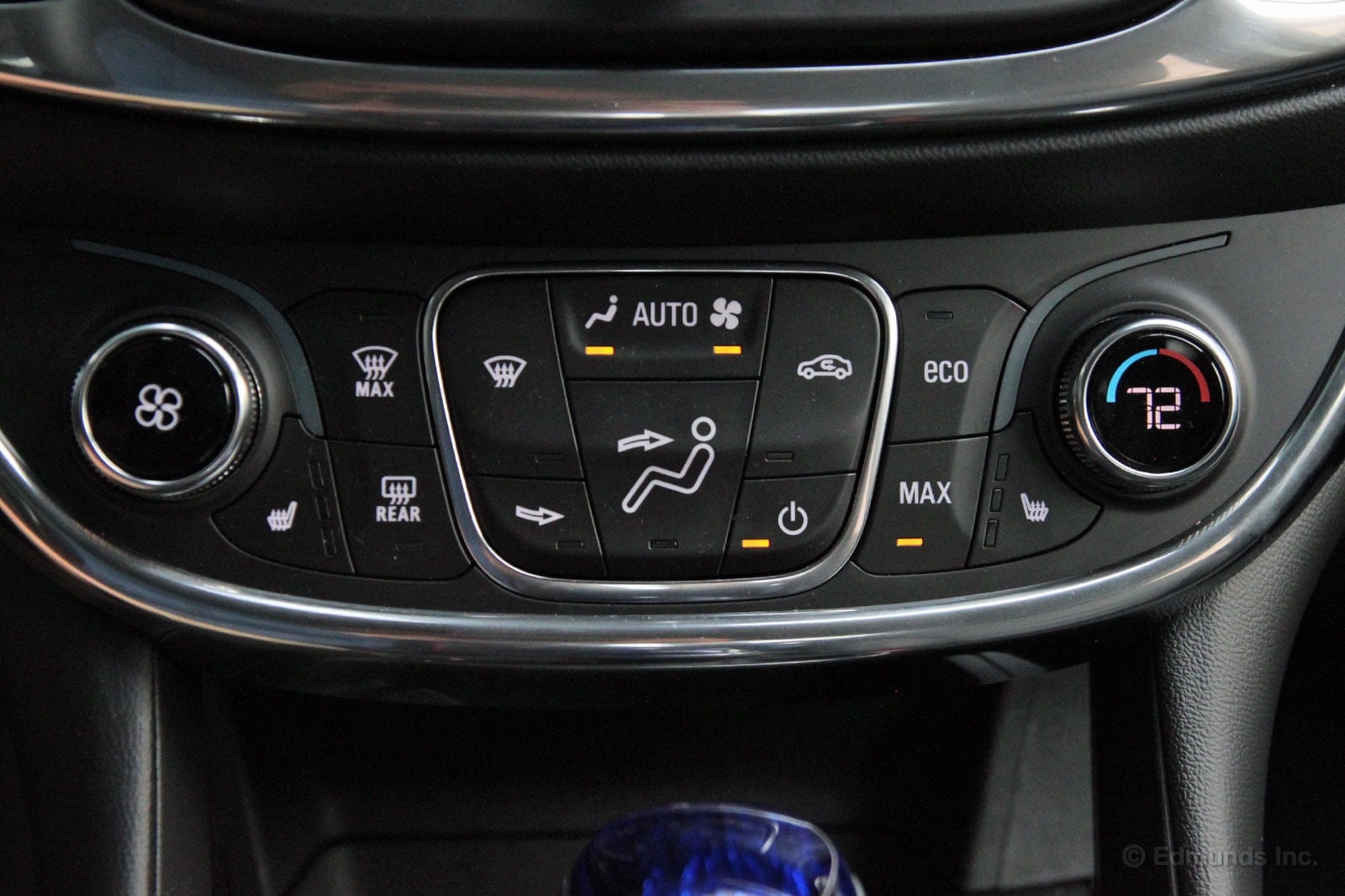
Our 2016 Chevrolet Volt is a technological wonder that rivals any car in the world when it comes to the complexity of its drivetrain. That's why I find its climate control setup so satisfying. It keeps things simple in spite of the car's other high-tech systems.
This might seem like an odd thing to call out. Things like climate control systems should be usable at a glance regardless of the car. Yet all too often carmakers decide to include the climate controls with all the rest of a car's new technology. The result is usually a dashboard full of buttons or a clunky touchscreen that makes setting the temperature and fan speed far more complicated than it needs to be.
Here, the designers made it easy. Big knobs for the temperature and fan controls and easily readable buttons for everything else. They even managed to squeeze the seat heater buttons in there without overcrowding things. Most of the time I just leave it on "auto" so all I need to do is adjust the temperature. It does a good job of maintaining the set temperature without constantly adjusting the fan speed, something that not every automatic setup does well.
Along with the seats I noted earlier, this simple system makes this Volt an extremely comfortable commuter car.
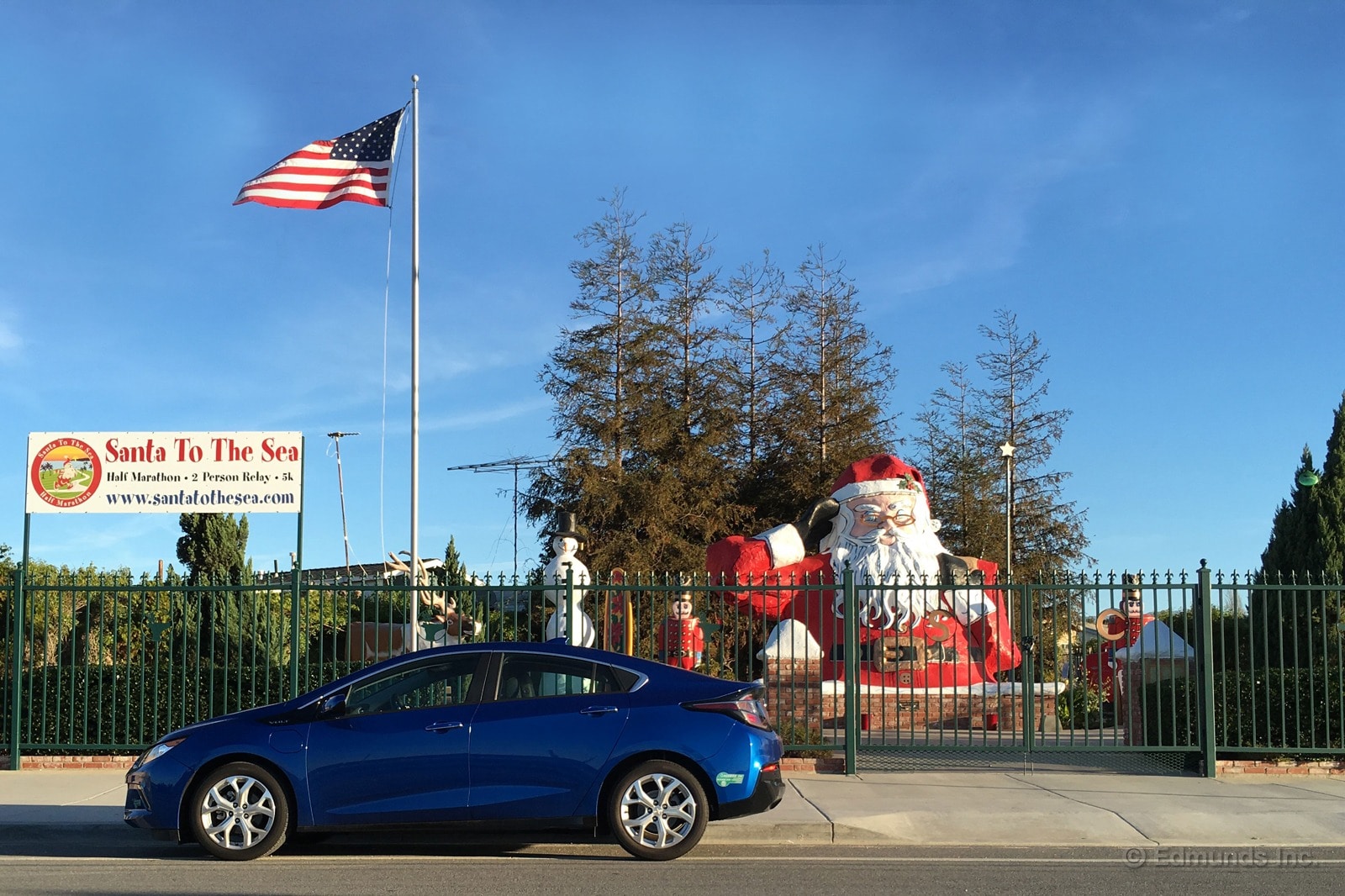
I spent a lot of time in our long-term 2016 Chevrolet Volt recently. In four days I covered just over 600 miles and spent more than 15 hours behind the wheel. Much of the drive included stop-and-go traffic. The majority of this time, the Volt was in hybrid mode rather than full electric. This experience left me with mixed feelings about the Volt.
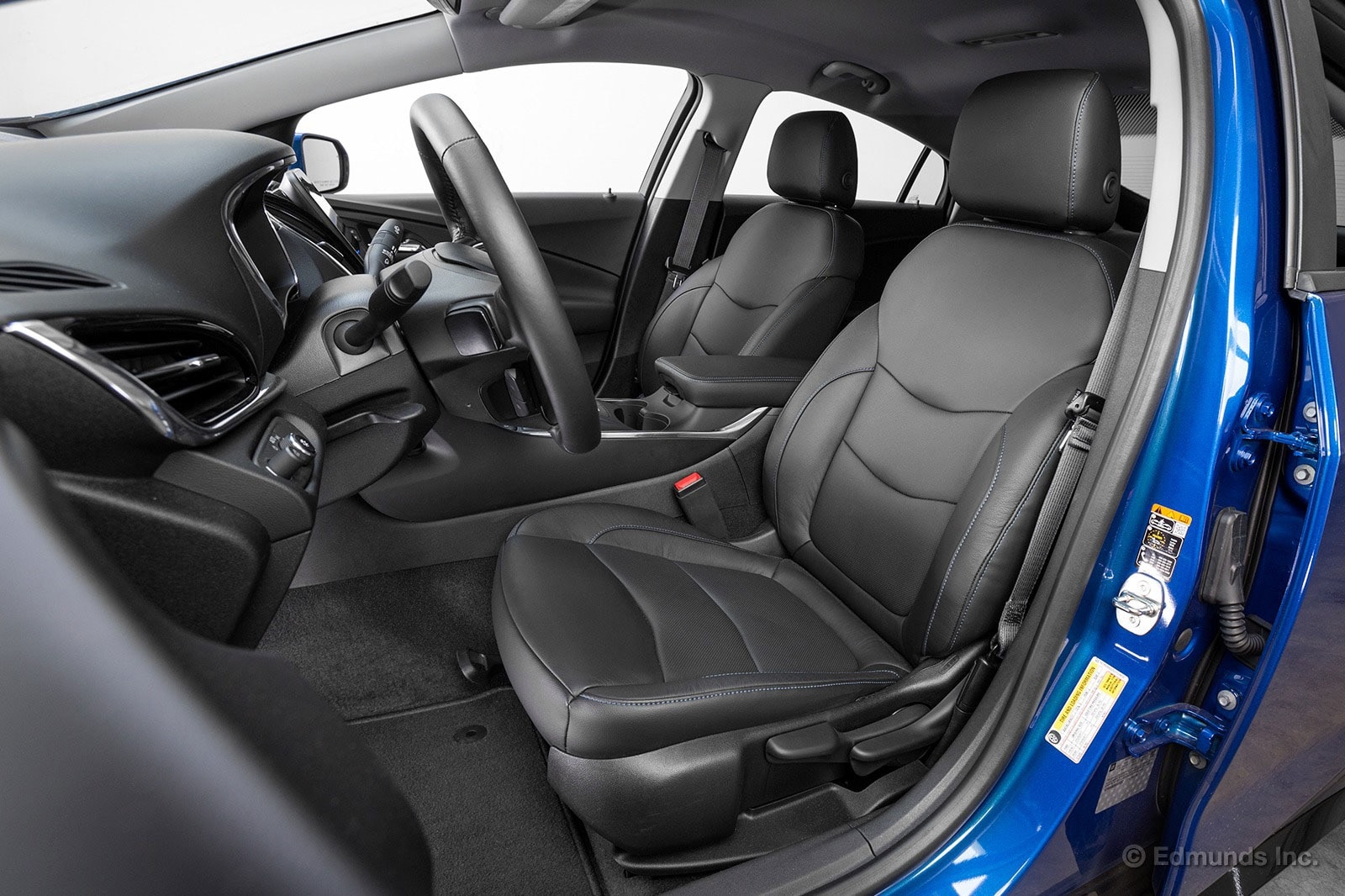
Seat Comfort:
For me, the seating position is not that great. The steering wheel doesn't telescope enough for my preferred arm position so I'm forced to slide the seat forward. This, in turn, butterflies my legs and leaves me with few options to stretch out, which only amplifies long distance discomfort. I try sliding my left leg under the brake pedal. I try wrestling the manual seat-bottom adjuster fore and aft. Neither alternative is particularly convenient so I have to tough it out. My knees suffer the most.
Then there is the driver seat itself. The bottom is flat and the contours of its back arch in the opposite direction of the contours of my back. I tilt the seatback a couple of notches to compensate for the excessive padding against my shoulder blades with some success. And surprisingly, I am able to last a good two hours before my lower reaches grow tired. I'm not sure whether to credit the Volt for this or my own stubbornness.
Ride Quality:
This car rides nicely. Big dips, small bumps, freeway expansion joints, concrete or asphalt. Across across each one the Chevy remains compliant. No issues to report.
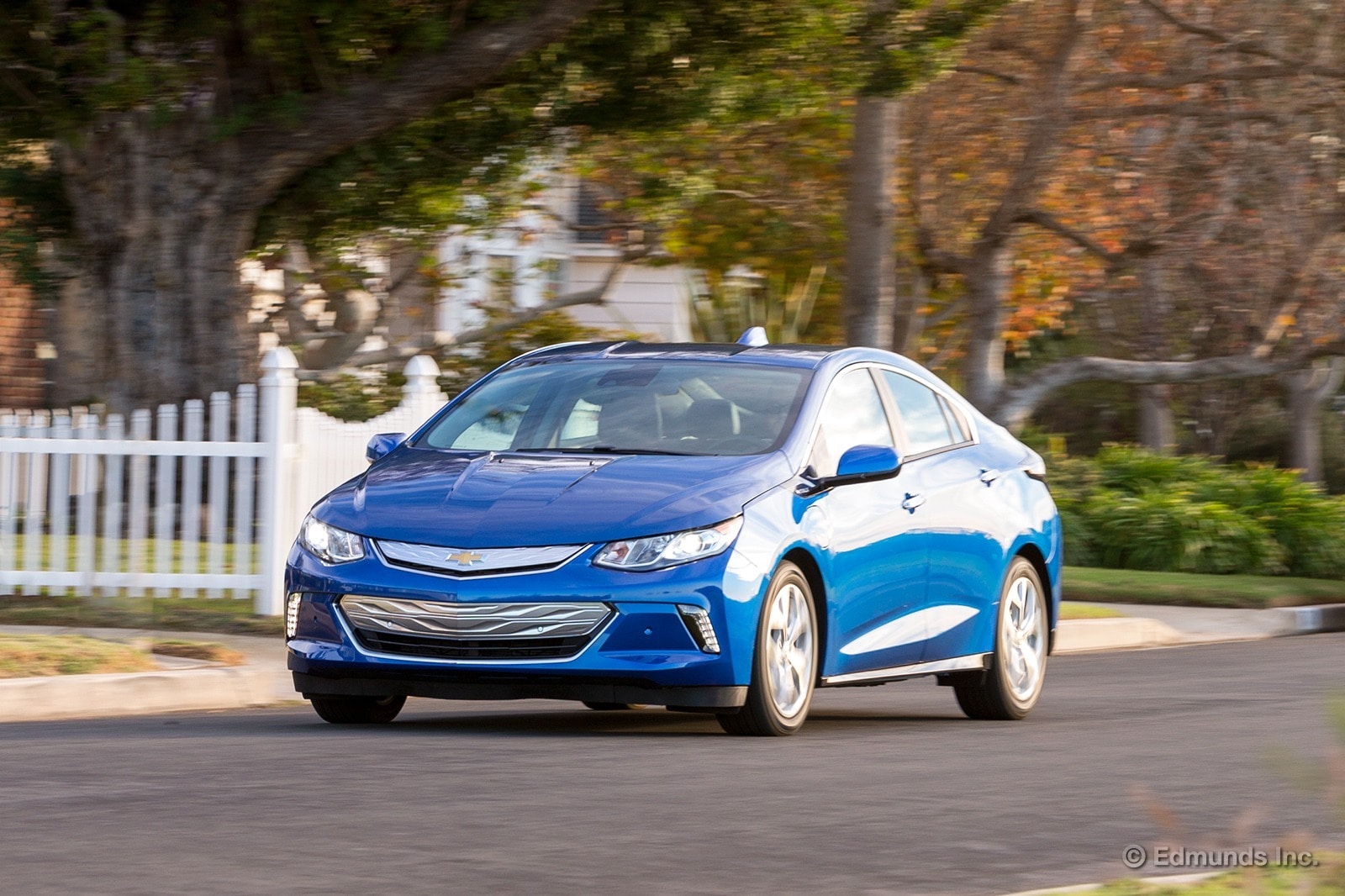
Performance:
In electric mode the Volt has enough torque off the line to rarely feel underpowered. It maneuvers through traffic with ease and simplifies passing maneuvers. But only a sliver of my 600-mile weekend was fully electric. Most was in hybrid mode.
As a hybrid the Chevy drives like most other hybrids. Highway passing maneuvers require extra calculation before execution. And on longer grades, when electric boost is sapped and the engine kicks in to supply power, it falls flat at about 69 mph This doesn't seem to be quick enough for many. So keep an eye on the rearview for motorists coming up from behind.
Overall the Volt is a competent freeway companion. And there is another perk to driving the Chevy that helps us forgive its deficiencies: HOV lane stickers. Those are awfully convenient to have on the traffic-congested freeways of Los Angeles.
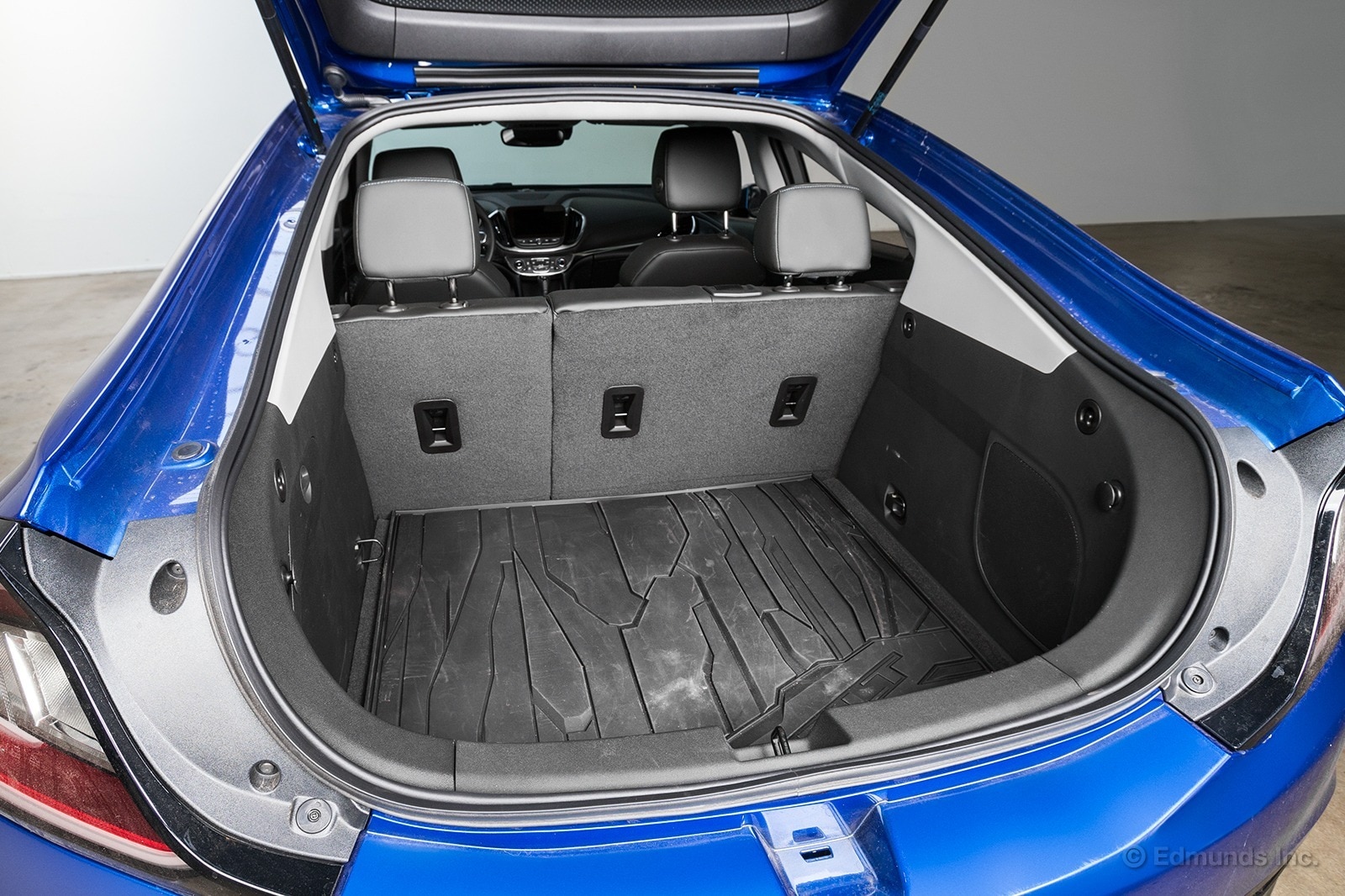
Will the luggage fit? To answer this question we loaded (our 2016 Chevrolet Volt) with bags in different configurations and took photos. What constitutes carry-on luggage varies depending upon who you ask. So for the sake of standardization we used the same blue carry-on bag — size (21 x15x10 inches) and red checked bag — size (30x20x13 inches).
Take the jump for photos and more detail...
Access to the cargo area
The Volt hatchback opens wide to fit all of your stuff. Load height is 33 inches from the ground, which is lower than similarly sized vehicles with traditional trunks. The lid is a bit of a reach when opened. Its handle is 71 inches up.
Behind the second row
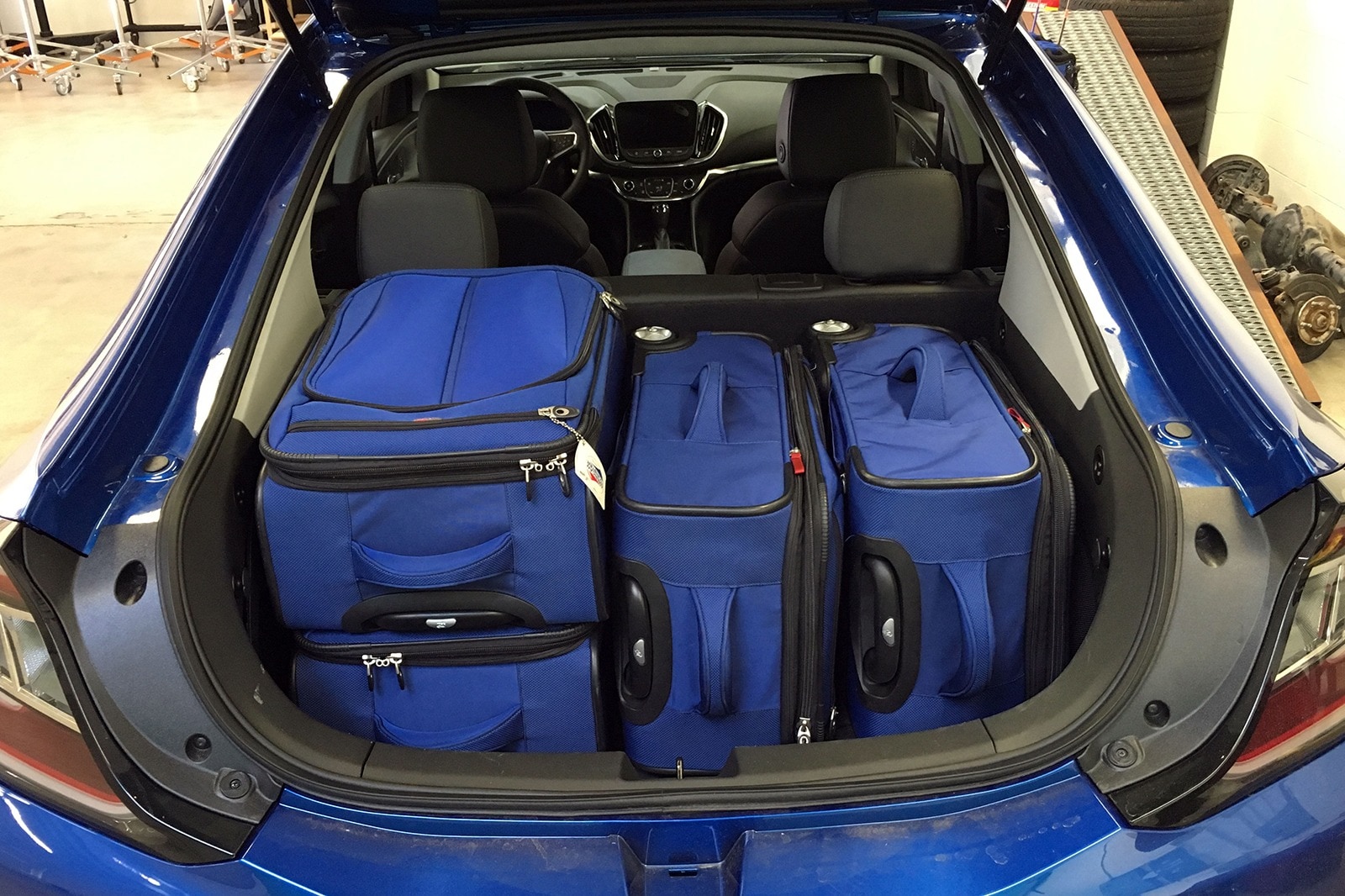
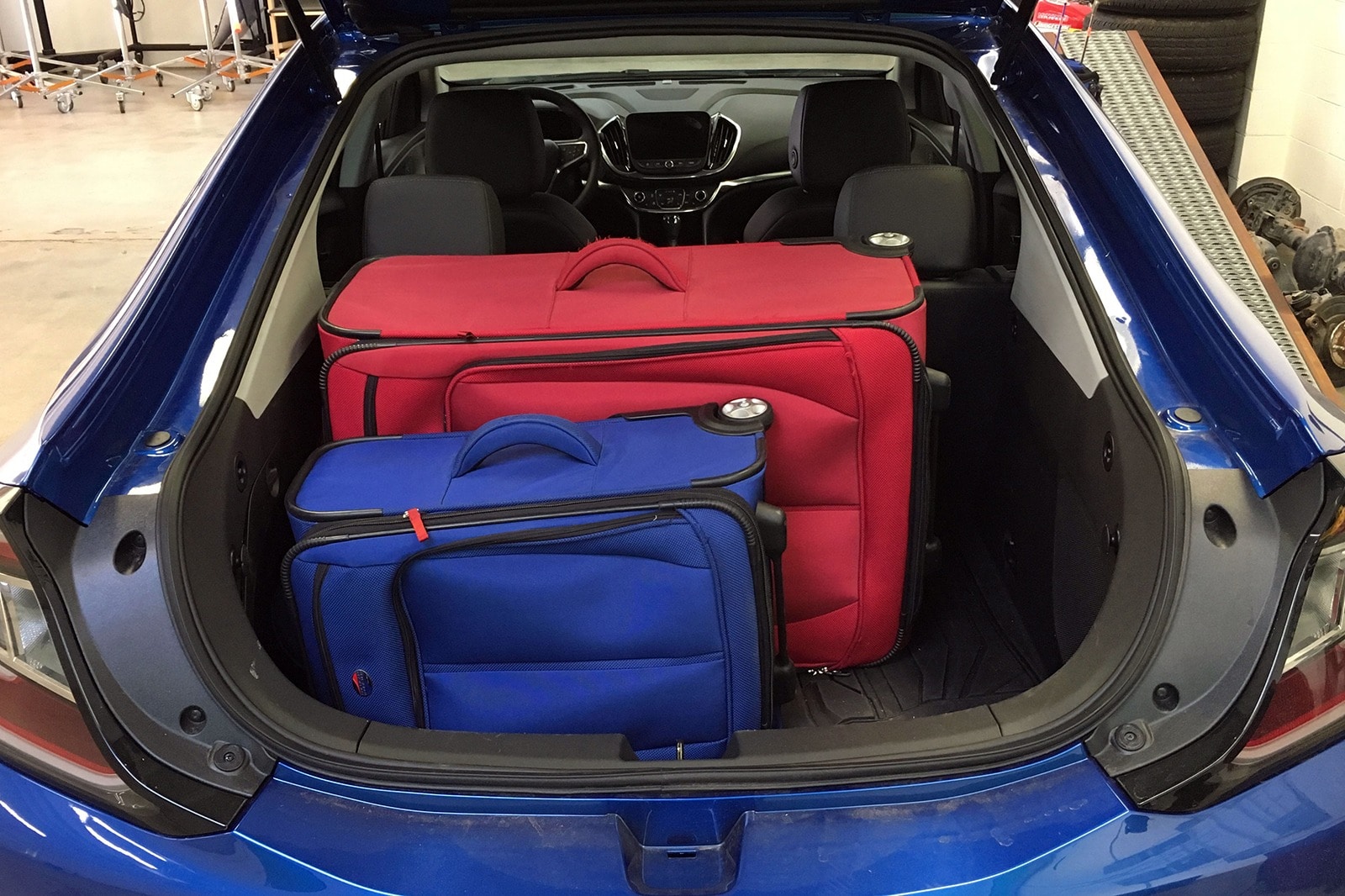
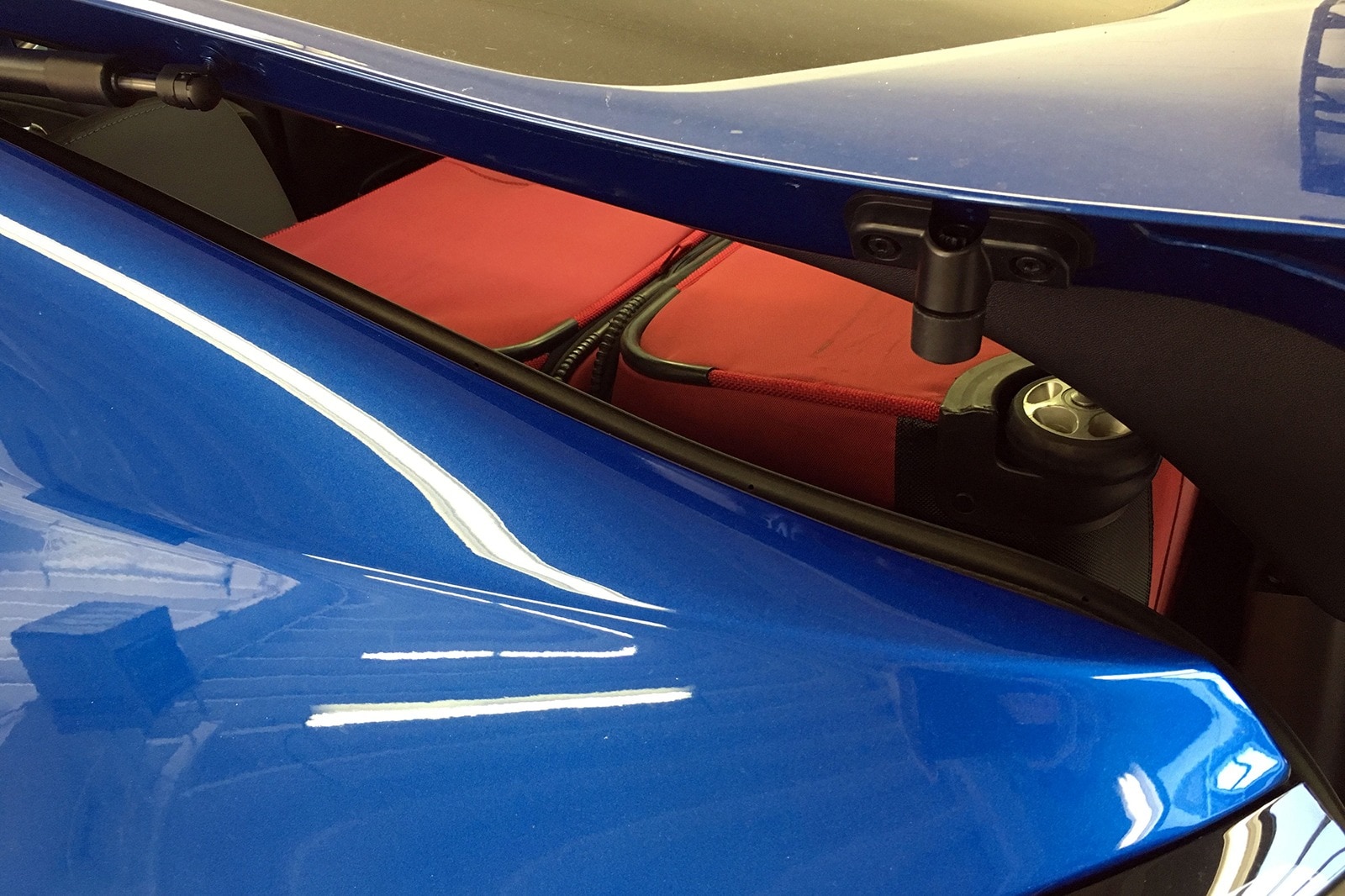
Our luggage fit easily in multiple configurations thanks to the largely square-shaped cargo floor. Interior dimensions with the second-row seatbacks in place measured approximately 29 inches deep by 38 inches wide at the wheel wells.
One limitation within the space is the Volt's sloping rear hatch. We were unable to close the lid with two checked-size bags, though it fit other configurations without issue.
Behind the 1st row
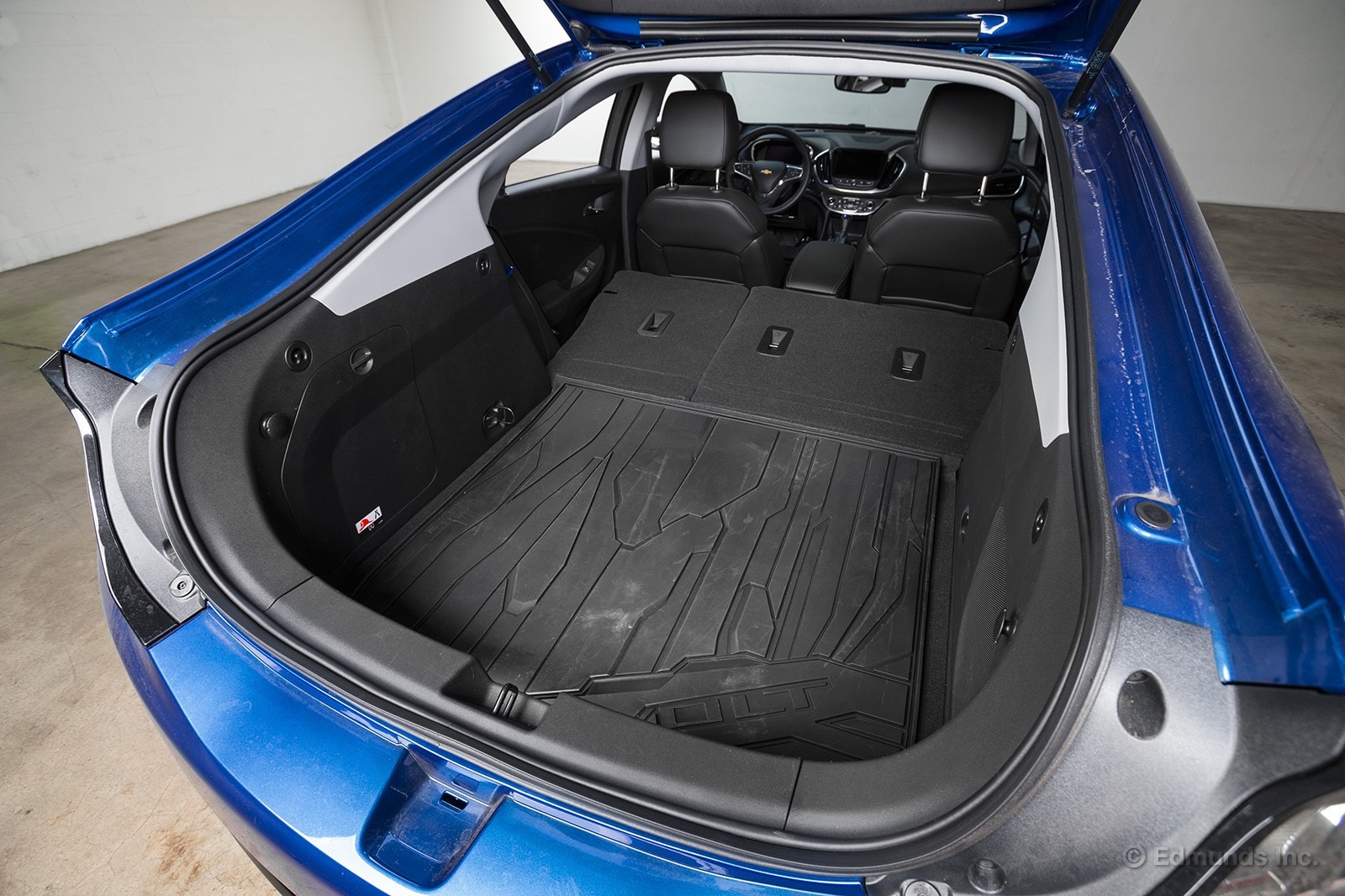
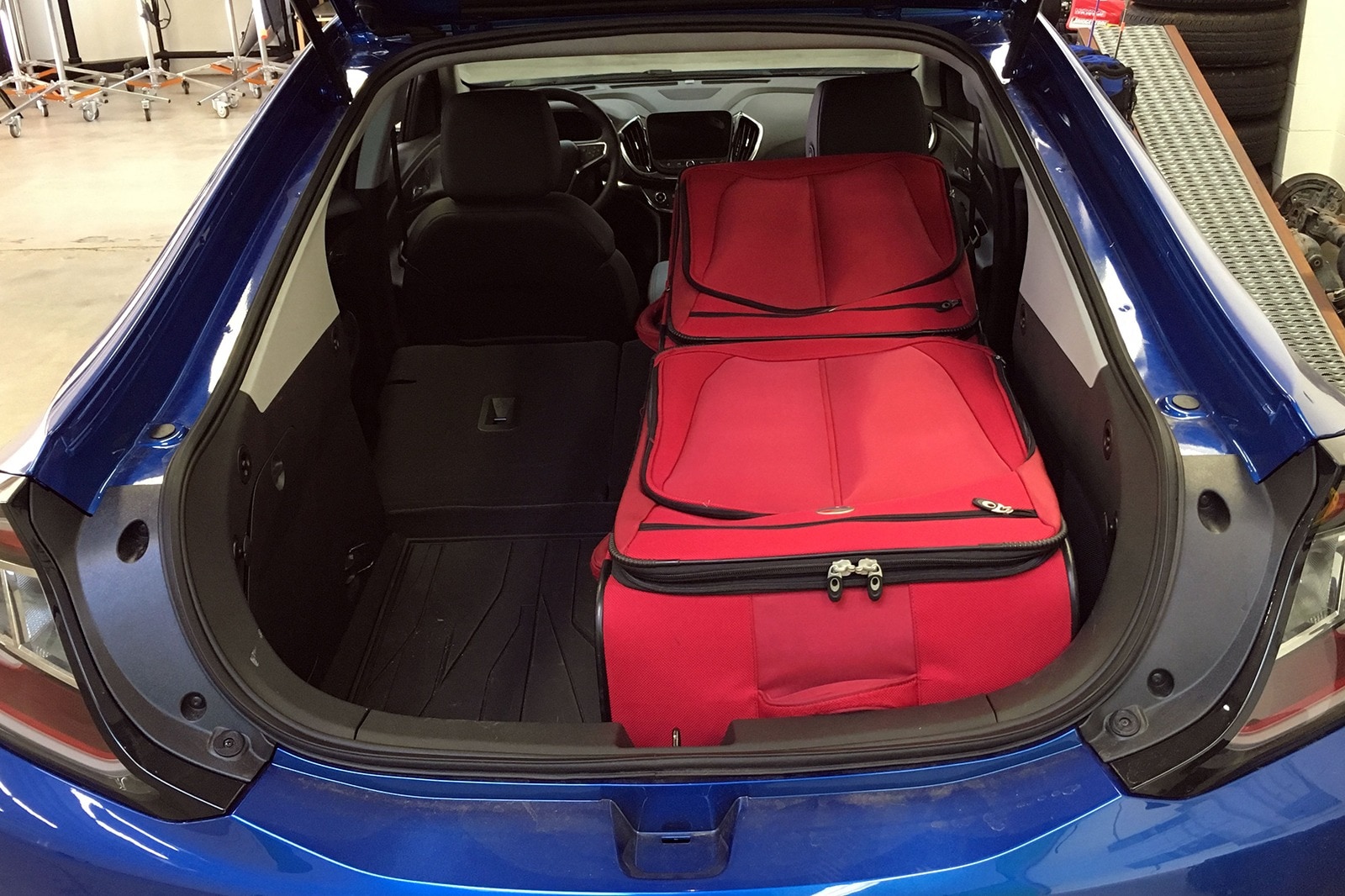
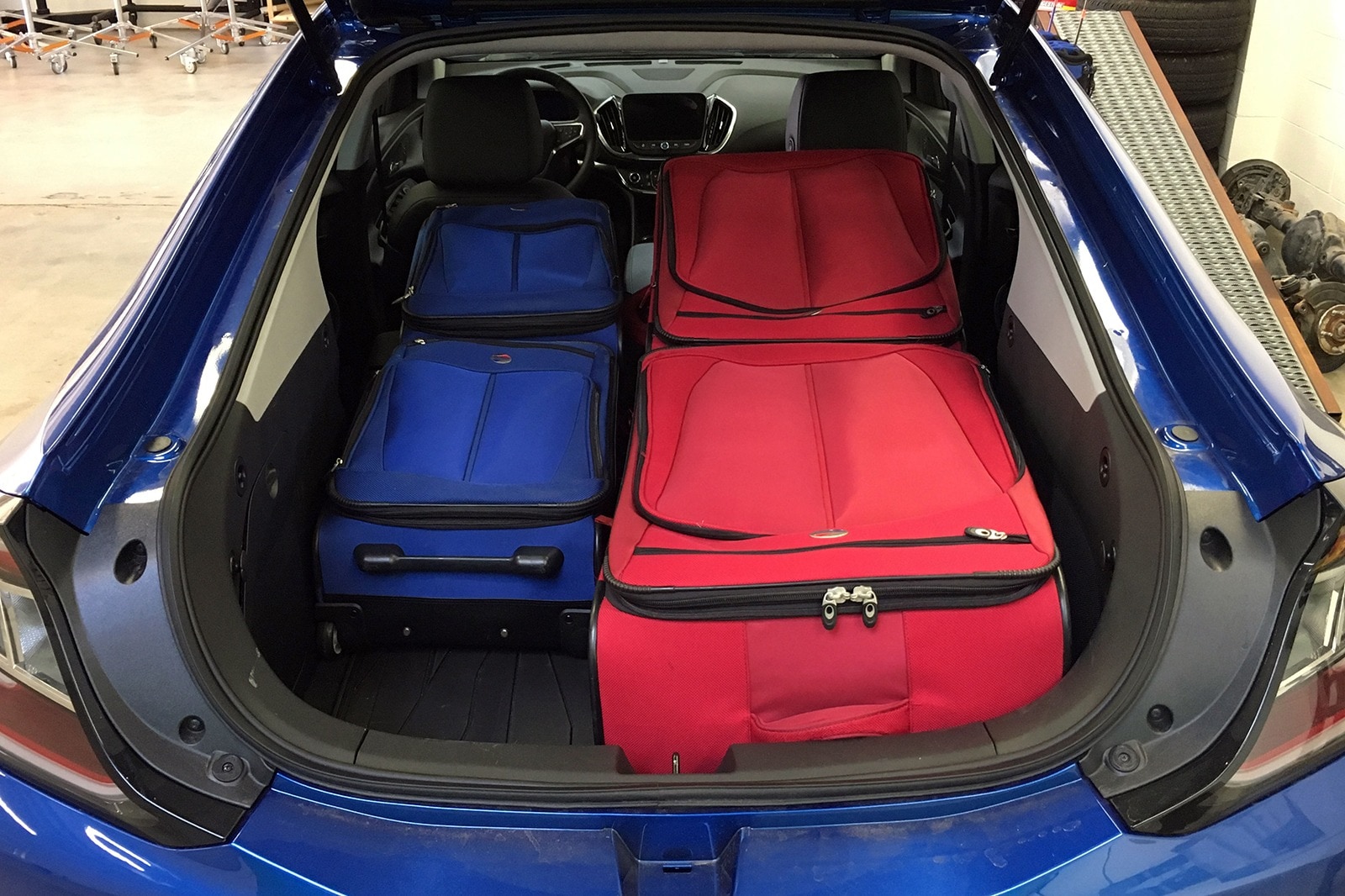
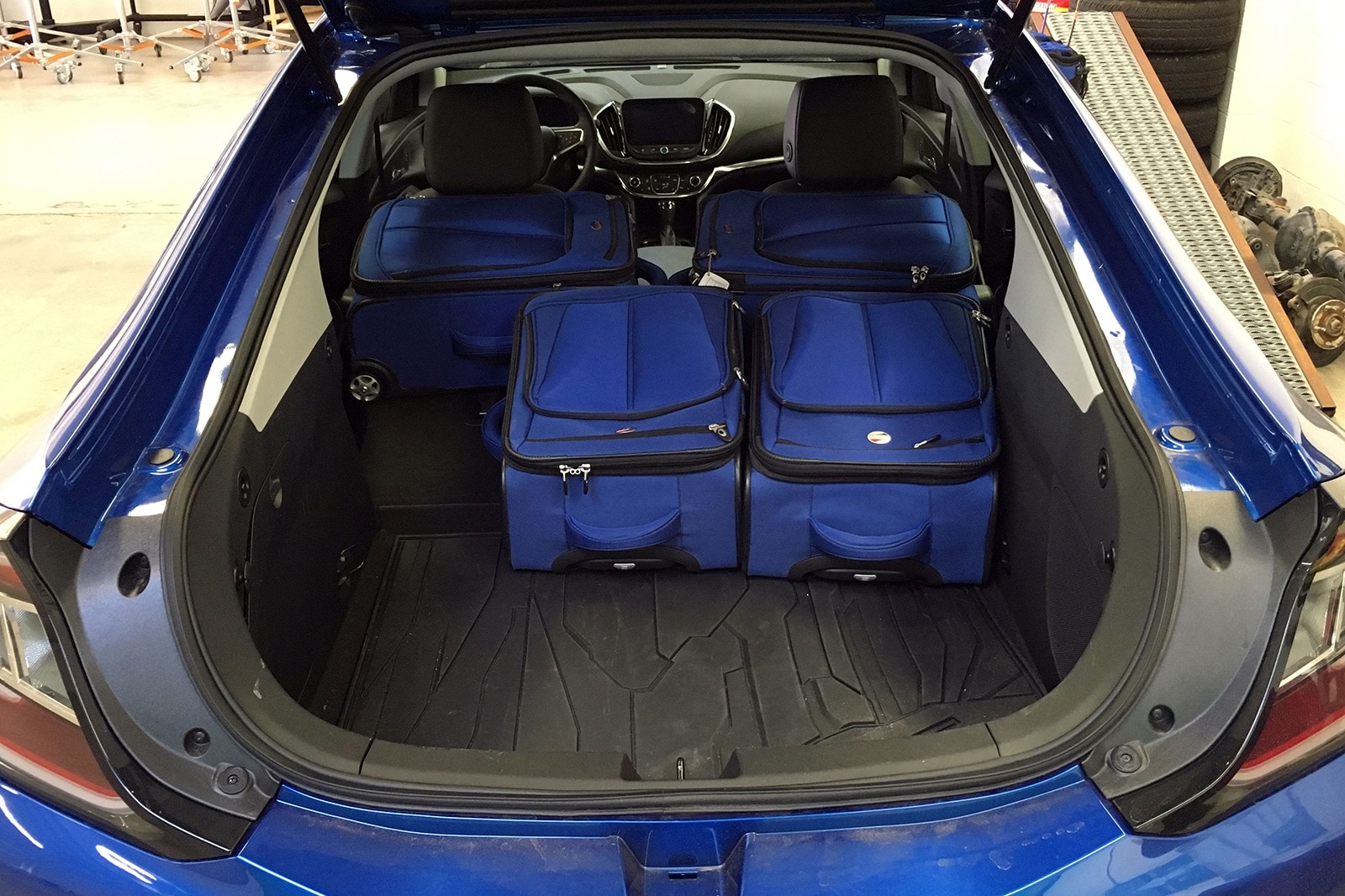
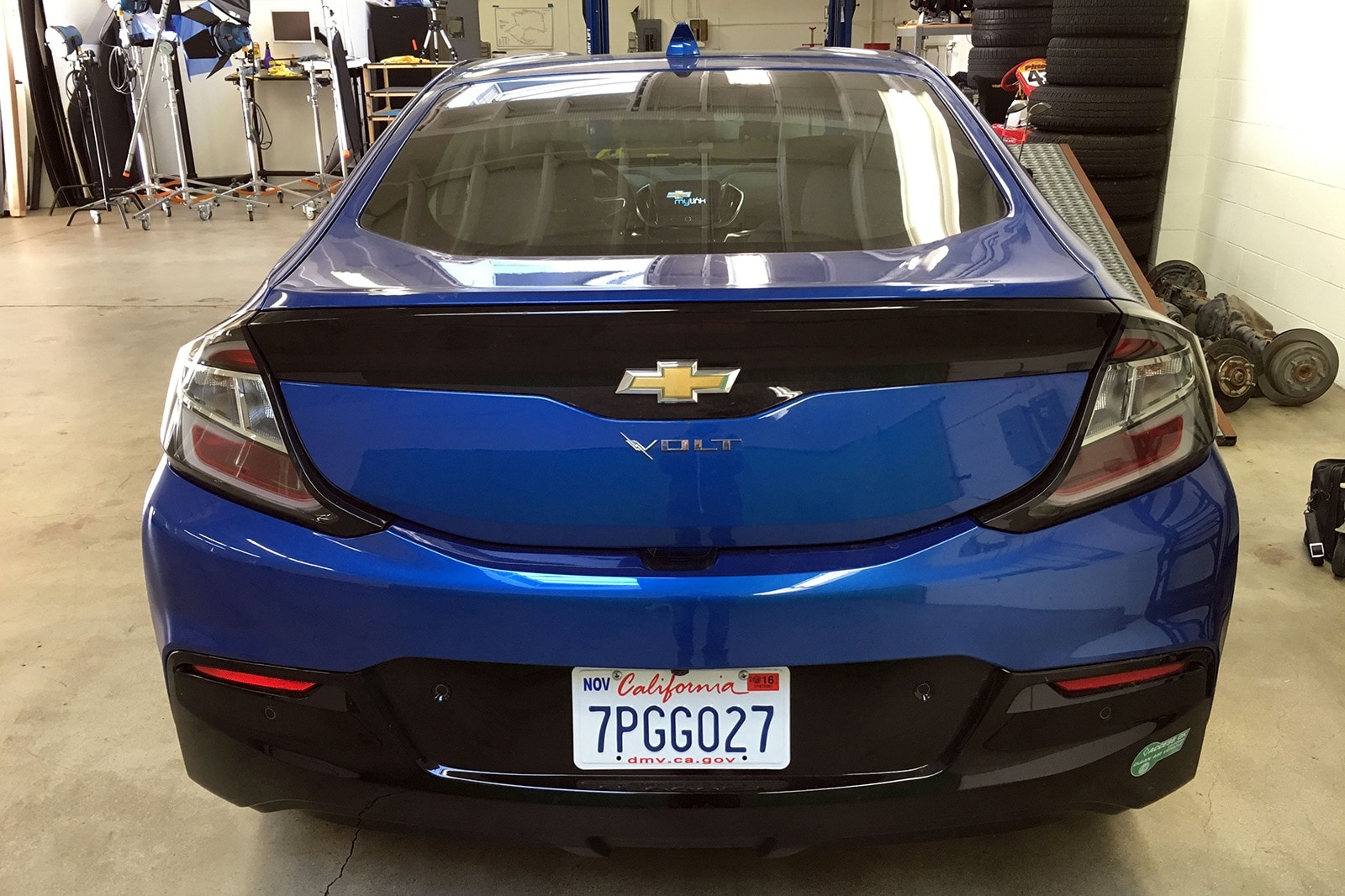
2016 Chevrolet Volt vs 2016 Chevrolet Malibu Hybrid
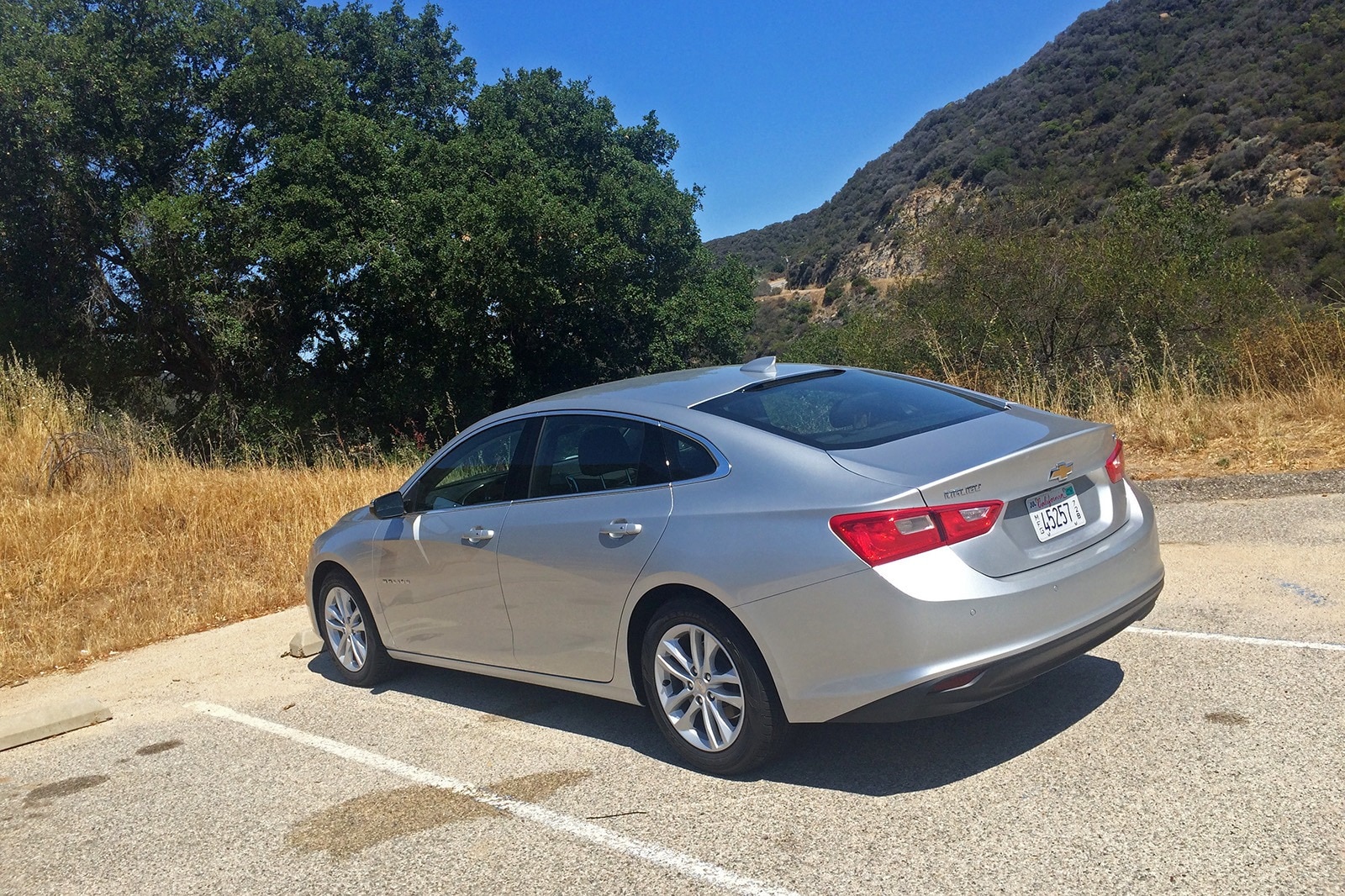
I recently had the chance to drive the 2016 Chevrolet Malibu Hybrid and walked away declaring it my automotive surprise of the year. To put it simply, it's shockingly good to drive, with composed handling and consistent, well-tuned controls. It's especially shocking since it's a hybrid — the gasoline-electric versions of midsize sedans are generally compromised in ways significant enough to make you constantly say, "well, at least it gets 40 mpg."
Aside from its smaller trunk, the Malibu Hybrid just isn't as compromised. Take the brake pedal, for instance, which feels normal and free from the weird, numb, two-stage pedal feel indicative of most other hybrids' regenerative braking. As such, I think the Hybrid is actually the Malibu to get. Not just because it's less compromised than other hybrid sedans, but because its powertrain is so good. The reason for that: it's basically a 2016 Chevrolet Volt without the plug.
Slightly more accurately, it is indicative of Volt depleted of its battery capacity achieved by plugging it in. In that instance, there is still battery power left, but that is replenished by the regenerative brakes and the engine. In that way, it's similar to the Prius and other hybrids. However, unlike most hybrids, power still primarily flows through the electric motor, providing a more EV-like feel when pressing on the throttle pedal. That equates to smooth, quiet, torque-rich acceleration most of the time. When the Malibu's engine does come on, I found it to be quieter than in the Volt, and although there's certainly some noise and vibration present, it's really only overt when gunning the throttle or when on a prolonged grade. In general, it's a far more refined hybrid system than those of its competitors.
Which brings me to the comparison with the Volt itself. Frankly, the Malibu Hybrid is a much better car. It's more comfortable, better equipped (power driver seat!), substantially roomier, sharper to drive and I'd argue it's better looking. If you have a long commute or don't have ready access to an electric outlet, I think it's a much better choice than its Volt sibling. If there was a Malibu Plug-In Hybrid, it would be a slam dunk.
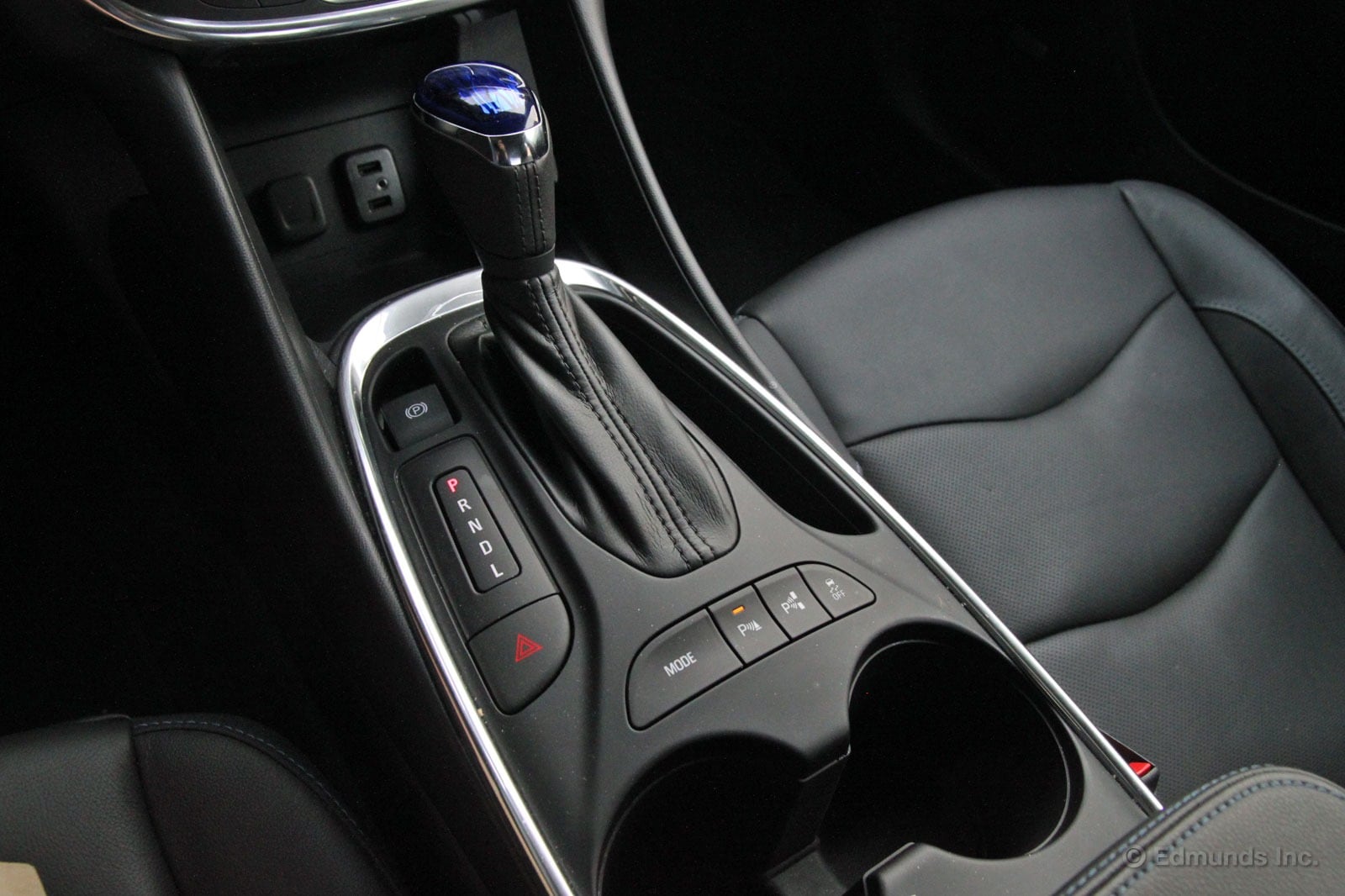
There are several interior design elements of our second-generation 2016 Chevrolet Volt that are far more traditional than their first-generation counterparts. Call it evolution, or the simple realization that the original Volt's cabin had a few features that weren't very practical. Either way, I like the interior of this Volt much better.
A perfect example is the center console. The first Volt used an awkward shifter that was half-buried within the dashboard. It may have looked interesting, but its functionality left something to be desired. The new Volt has a shifter that would look at home in any conventional sedan, other than the cool blue trim piece at the top of the shift lever, of course.
You'll also notice a handy crevice along the right side. It's perfectly placed for holding a cell phone. Even if you're not using it, having a place to put your phone where it's easily accessible is nice. And it doesn't get much more convenient than this.
All in all, I like the way the Volt has evolved. It still has enough unique touches to make it different, yet it doesn't feel like it's trying too hard.

It's easy to forget that our 2016 Chevrolet Volt is a hybrid. After all, with anywhere from 50 to 70 miles of electric range, you can drive for an entire day on electricity without even thinking about it.
I was reminded of this recently when I managed to fully deplete the batteries on the backside of a long commute. It's possible to do my 70-mile round trip in EV mode if I really try, but I had a few side trips in between, so the gas engine kicked in about halfway back to the office.
Suddenly I'm looking at the dash you see above. Went from running out the batteries to having over 250 miles of range available. Oh yeah, there's an engine under the hood.
It's easy to miss since it's pretty quiet on the highway. I didn't even notice when it fired up — a far cry from the first-generation Volt, which made a noticeable vibration once it kicked in. The new engine's refinement and efficiency makes this Volt a seriously versatile hybrid that will work well for most drivers, regardless of their particular driving habits.
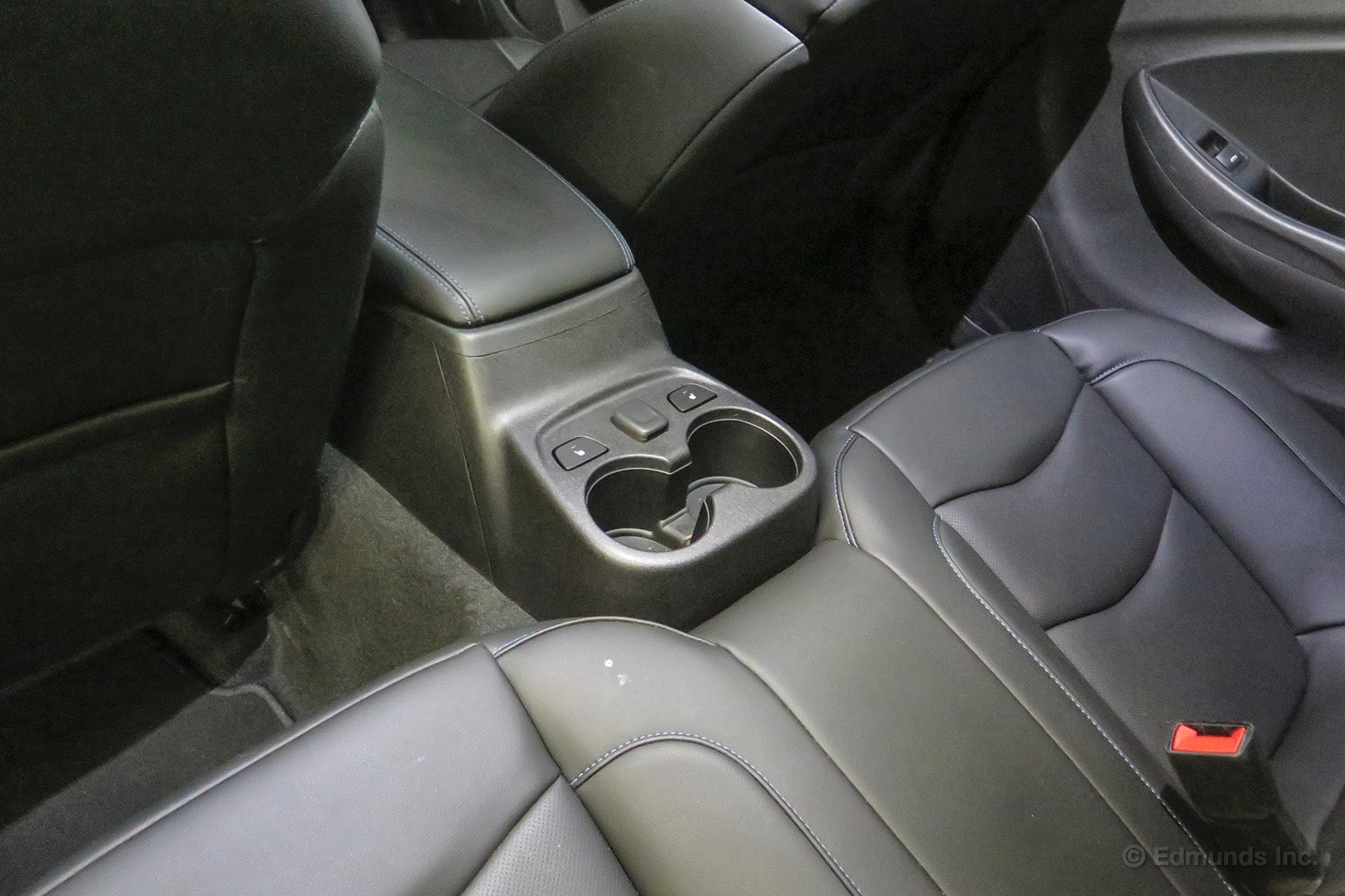
Chevrolet sells the 2016 Volt as a five-seater. It does have three seatbelts in the rear, but it's not a five-seater.
Not with this giant battery-pack hump in the middle of the back row.
Just like our old long-termer, the original 2011 Chevrolet Volt, this car is a four-seater in the real world. At least the 2011 model was realistic about it. Forget the usual small hump in the floor; this is a straight-up beverage cart between your thighs. I wouldn't subject any of my friends to a three-wide ride in the rear of the Volt unless it were absolutely necessary, and even then, I might just call an UberXL instead.
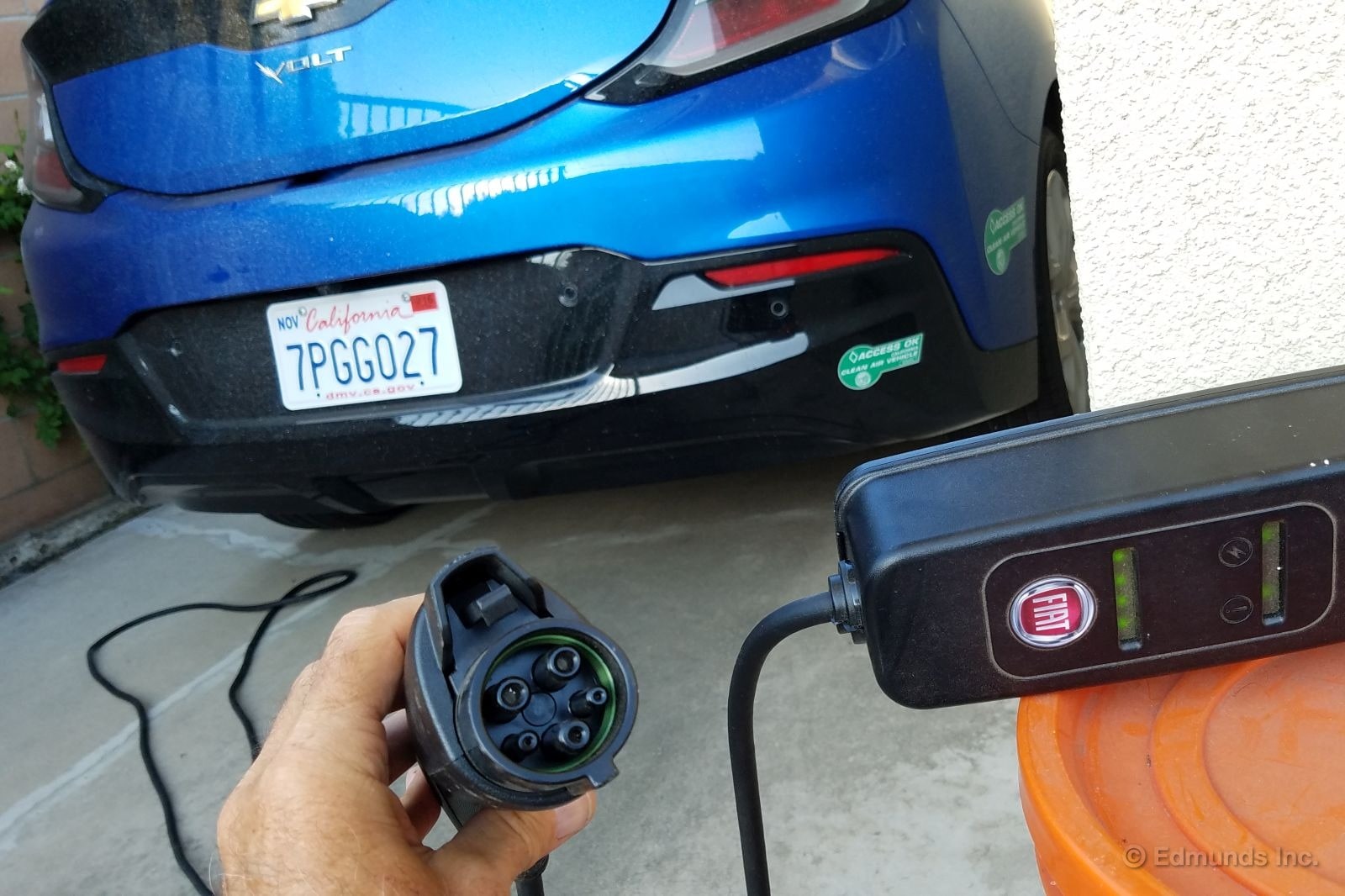
We recently leased a 2016 Fiat 500e for my daughter. In case they don't sell them where you live, the "e" stands for electric. I'm not a fan of the regular 500's engine and transmission, but that stuff gets magically wiped away when they build a 500e, leaving behind a torquey, cute-as-anything pocket rocket with an ultra-low center of gravity.
But I digress. We're supposed to be talking about the 2016 Chevrolet Volt long-term test car I drove home a couple nights ago. The connection, literally, comes in the form of the Fiat's 120-volt Level 1 power cord.
I'm lazy, you see. Why unwind the Volt's Level 1 cord when my daughter's Fiat cord is already plugged in and ready to go?
The Society of Automotive Engineers standardized the plug some years back. Tesla is the only holdout that didn't go along. What this means is, I can use the Fiat 500e Level 1 cord to recharge the Volt. I have and I am — right now.
You may be wondering why my daughter is using a Level 1 charge cord in the first place. She only drives 10 or 12 miles a day. We simply don't need the speed (or the expense) of a 240V Level 2 home setup to top off the Fiat every night.
As for the Volt, I plugged in with 36 miles in the tank. I only need to add 10 more to make it to work tomorrow on electricity.
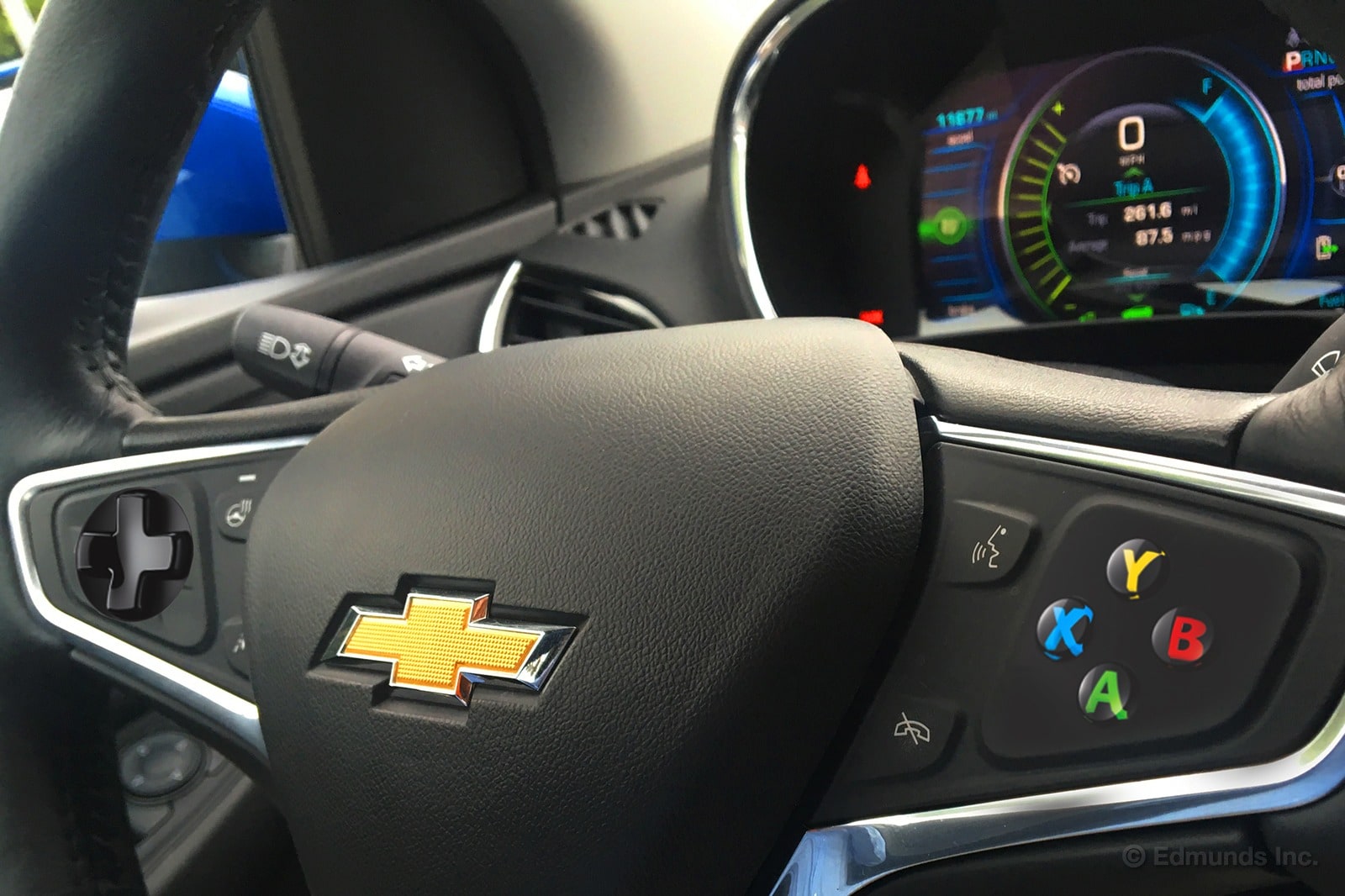
I put in a lot of time on my Xbox, including plenty of driving games. During my most recent stint in our long-term 2016 Chevrolet Volt, I came up with an Xbox-related idea that could improve it.
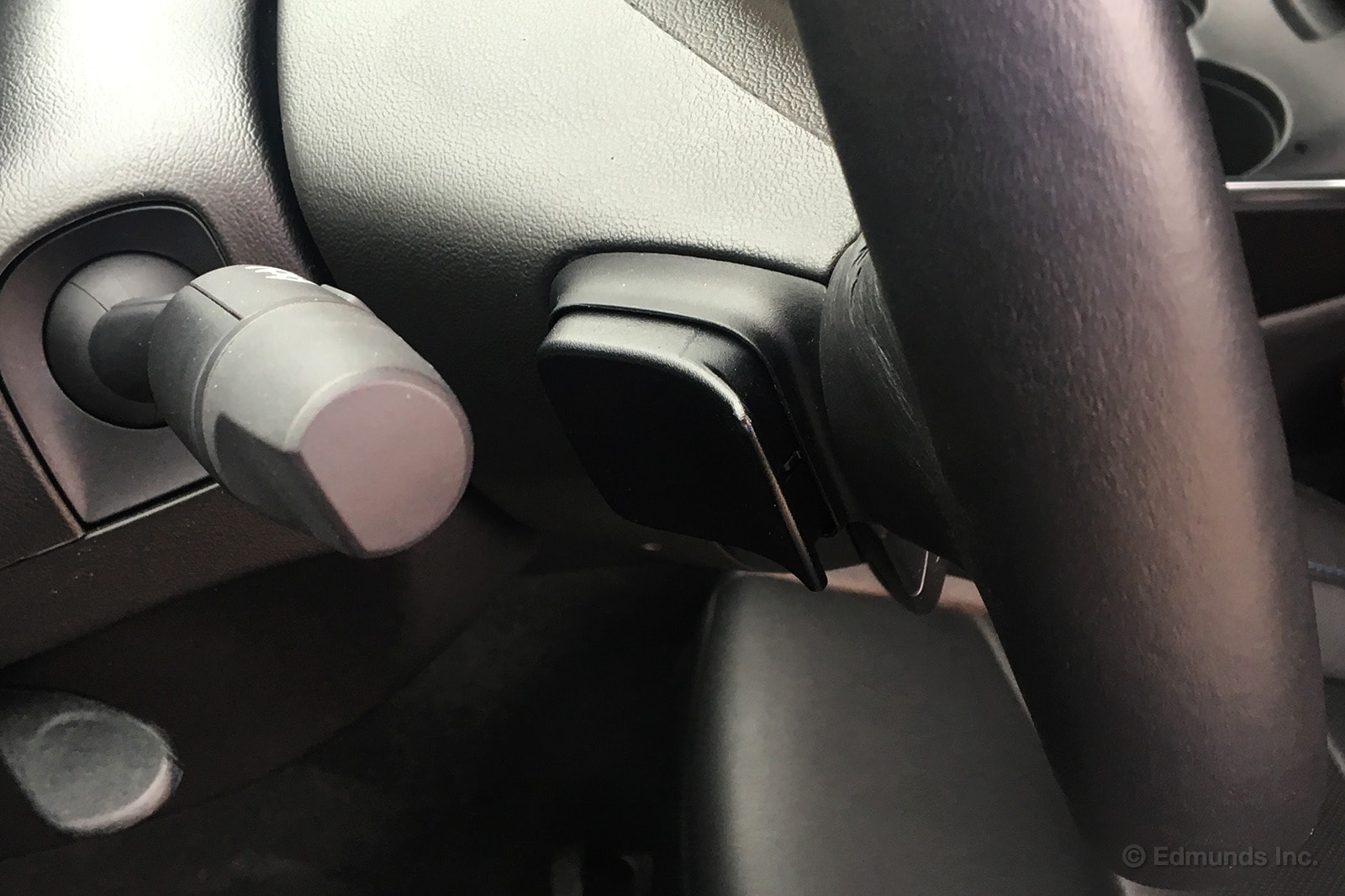
What you see here is the back of the steering wheel. That paddle isn't for manual downshifts, nor is it for audio control. It's a regenerative brake controller. Jonathan touched on it in an earlier post here. Pull on the paddle and it slows you down without using the traditional brakes, sending more juice back into the battery.
But there's a problem I have with it. Caution: nerdliness ahead.
That paddle is either on or off, a bit like how early gaming consoles wouldn't allow you to ease in or out of the throttle or brakes. As the Volt is, it's like instantly stepping on the brake with moderate effort, then hopping right off. I'd prefer if it had a paddle that you could modulate, like current gaming controllers that let you trail the brakes into a corner and roll into the throttle on the way out.
As I'm driving around, I'd like to get as much electric range as possible, but using the existing paddle exclusively creates a lot of clumsy decelerations. If I could modulate it, I'd use it more often.
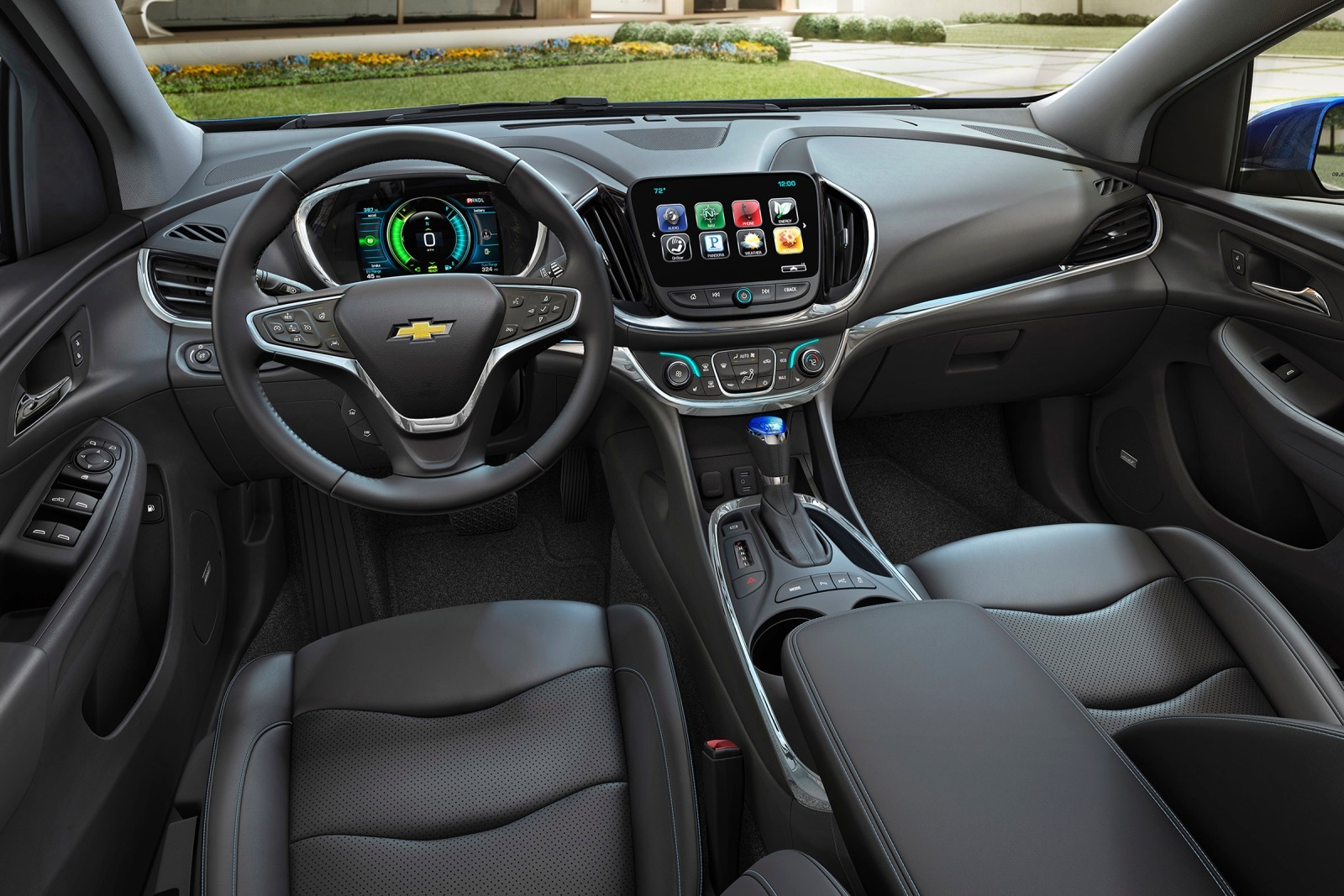
Our long-term 2016 Chevrolet Volt was slow-roasting in the L.A. sun for a few hours. When I opened the door, I could feel the heat pouring from the interior. Not surprisingly, when I started it up, the automatic climate control went into full-power mode to try to cool things down.
With the fans on full blast, there was a rush of white noise throughout the cabin. Then I saw a little notification on the main touchscreen that told me one of my colleagues had sent me a text message. As soon as I switched to the Apple CarPlay messaging screen, the fan speed plummeted to a much lower setting. That allowed me to hear the voice prompts more easily, and I assume it helped the voice recognition system hear me better, too.
Once I was out of the messaging screen, the climate control went back to full strength until the target temperature was reached.
I haven't experienced this feature before in any other vehicle, though I suspect the Volt isn't the first to employ it. In any case, it's a nice example of thoughtful design that gives the driver one less thing to think about.

The top of the trunk on our long-term 2016 Chevrolet Volt is tall. Basically, the beltline and the decklid are both tall on this car, all the way around. As a result, you can't really see the headlights of the vehicle behind you. For me, in a comfortable seating position (I'm 5'9"), it's a windshield-and-up view of cars in the rearview mirror.

Also, the rear window is narrow and short, so visibility suffers doubly. It's not a deal-breaker, and it's certainly not as bad as in our long-term Viper, but it's something you have to keep in mind when you're changing lanes or scanning for tailgaters.
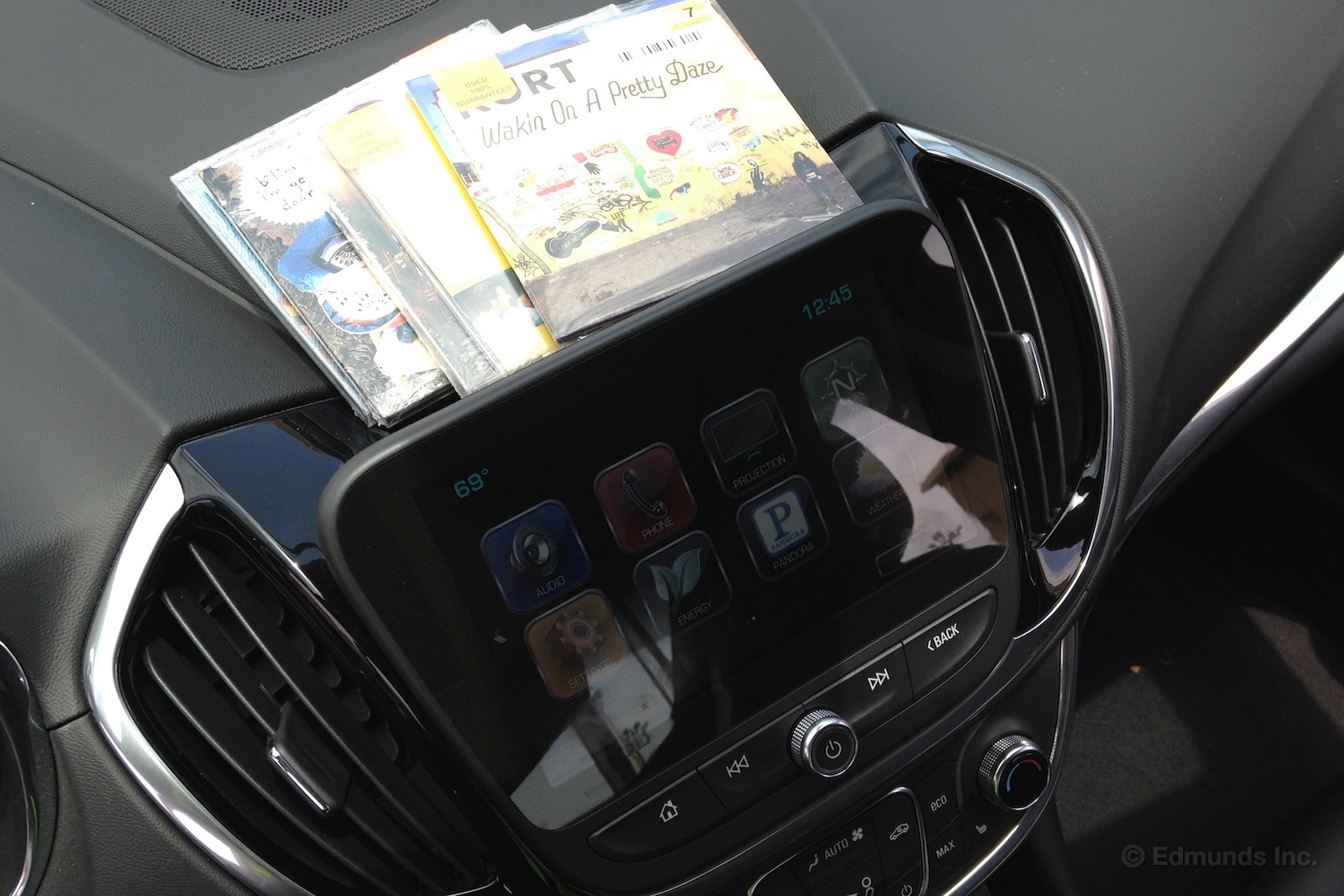
I still buy compact discs. They're cheap, plentiful, and most new releases have abandoned crappy plastic jewel boxes for the cardboard "digi-pack," which lends some nostalgic analog to vinyl records. Helps them consume less space in the home collection, too. I'm not alone in this preference (which for me boils down to the boring discussion of compressed vs. uncompressed audio quality), but the 2016 Chevrolet Volt isn't with me on this one.
I recently went out looking for some new stuff, found it (some old stuff, too), then went out to the Volt looking forward to some drive time listening. Shocker: no CD player. Center console? Nope. Glovebox? No. Hatch? Nope.
It was the first time I'd had any occasion to use the non-existent CD player, but I was still surprised to find it missing.
I shouldn't have been. Chevy's been heading down this path for awhile (Spark, Equinox, Camaro), Scion and Honda, too. And it makes specific sense in a car like the Volt, with all of its future-y image and intent. Fair enough. No reason to keep CD players around for the odd occasion when .01 percent of your customer base walk out of the used music store.
But it did bum me out — for about 60 seconds, long enough to open Spotify and cue up one of the CDs I just bought.
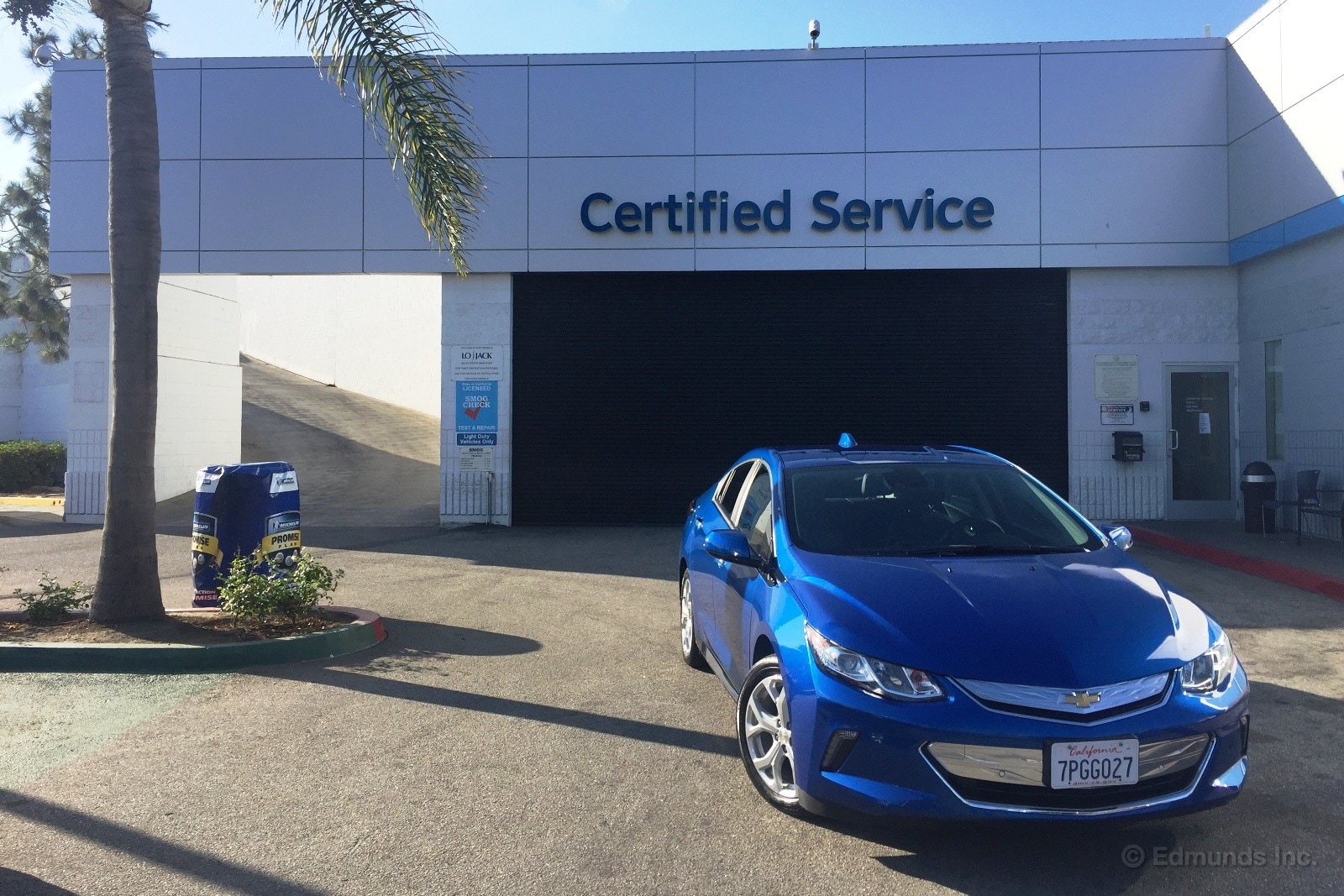
Fleetmaster Schmidt informed me that our 2016 Chevrolet Volt was due for a service before I took it for the long Labor Day weekend. We knew the oil change and tire rotation would be covered gratis by Chevy's Complete Care maintenance plan, but there were also a few open recalls to attend to.
I headed to Hooman Chevrolet in Culver City on Saturday morning to get things done. It was a genuinely pleasant experience.
I didn't tell my Hooman service advisor, Fernando, that I worked for Edmunds, but he gave me the red-carpet treatment anyway. I showed up at 11 a.m. and the place was humming, but he assured me that they could fit the Volt in before the end of the day. After handing over the key, I was offered a complimentary ride back to my place in the dealership's Tahoe shuttle — a five-mile trek through typical LA traffic. I was planning to take an Uber at my own expense, so that was a welcome surprise.
Fernando called around 3 p.m. to say that the Volt was ready to go, but for various reasons (primarily lethargy), I didn't get off the couch until right before the service department closed at 5 p.m. Google Maps said I'd be there at 5:08. I called Fernando to apologize and ask if that could work on his end. He joked that he'd have to hold the cashier hostage, but they'd wait for me. I appreciated that, too, especially since I knew they wouldn't be open again until Tuesday morning.
When I arrived, Fernando cheerfully gave me the key and had me sign an invoice for the oil change, tire rotation and three recall checks. The first recall was for the lockset pins in the front seat tracks, but the technician had inspected our pins and found them to be just fine. The second was for an "engine not available" message, which netted us an updated power inverter module. The third was for an out-of-spec fuel feed pipe crimp, but no leaks were found, and the part's build date determined that no further action was required.
Dealerships catch a lot of online flak for their service operations, but I got nothing but good vibes from the folks at Hooman. I would look forward to visiting them again.
Days Out of Service: 0
Total Cost: $0
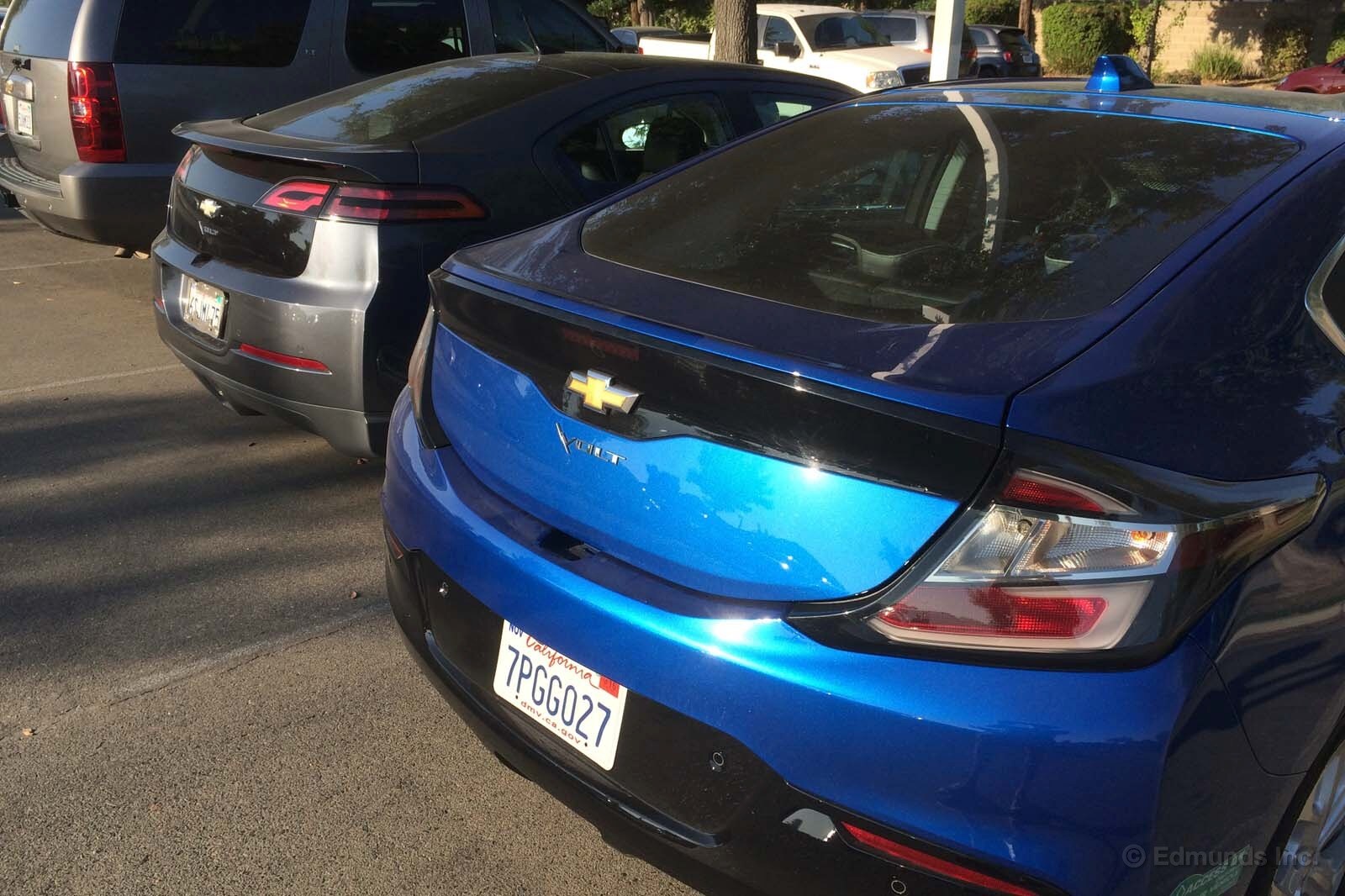
Most redesigned vehicles these days are incrementally improved. A few more horsepower here, an inch more legroom there, and perhaps a "boldly styled!" dashboard to top it all off.
But the 2016 Chevrolet Volt? Just about everything is dramatically better compared to the first-generation model.
Let's take a look.
All-electric range? It's up to a substantial 53 miles (EPA-estimated), compared to 38 miles with the first-gen Volt.
Efficiency? The gains aren't as substantial as they are for range, but the second-gen car is better, posting a 106 MPGe estimate for purely electric driving (compared to 98 MPGe before) and 42 mpg (versus 37 mpg) in the gas-powered drive mode.
Power? It's a full second quicker when accelerating from zero to 60 mph (7.5 seconds, down from 8.5 seconds for the 2011 car we had).
Interior design? Normal and useful has replaced future-tech goofy.
Tech interface? The latest MyLink infotainment interface is quicker, prettier and more functional. It works quite well, in my opinion.
Interior room? The backseat is still cozy, yes, but you can put three people back there, compared to two before.
Charging cord location? It's stored in an easily accessed side compartment instead of being underneath the cargo floor.
Refinement? The latest Volt is smoother and easier to drive. In general, we've had nice things to say about it the entire time we've had it in the fleet.
Safety? Advanced safety features, including automatic emergency braking, became available with the new generation.
Now, it's always easier to get better when you have some obvious flaws to begin with. But that doesn't diminish all the good that the 2016 Volt represents. For a lot of EV and plug-in hybrid shoppers, I think the new-generation car is a great choice.

A large part of the second-generation's Chevrolet Volt's appeal is its normalcy. Yes, it's a plug-in hybrid with more than 50 miles of all-electric range, but you can also just drive it like a regular car and not give a second thought to the electrical wizardry happening underneath.
To me, though, viewing the Volt as a normal car adds some further expectations of functionality. And one of those is the ability to comfortably seat adults in the back.
Thankfully, the Volt is decently comfortable back there. It's not as expansive as a midsize sedan or even the new Honda Civic, but adults up to 6 feet tall should be OK. There's more legroom than I would have thought, and an elevated seating position provides some useful thigh support. There's also suitable padding on both the door and center armrests.
A more questionable aspect, however, is headroom. The angle of the rear seatbacks places the occupants' heads directly below the rear hatchback window. This is both good and bad. It's good because it provides a couple extra inches of headroom that wouldn't be available if your head were right underneath the headliner (which is lower). It's bad because (Captain Obvious here) your head is right below the hatchback glass.

Chevy added a thick sunshade-style tint to the upper part of the glass where your head will be, but even so, I'll guess that you're not going to love sitting back here with a hot sun directly overhead.
Two other things: 1) The sloped roofline means adults will have to duck some to get in and out, and 2) While the new Volt has a center seat in back (the first-gen car did not), it's just not a realistic seating option. The Volt isn't wide enough to support useful three-across seating, and the big center console and hump (underneath is the Volt's battery pack) takes away vital space for the center person's feet.
Still, big picture, the 2016 Volt is roomy and comfortable enough for typical multiple-passenger trips, such as driving your kids to school or going out with a couple friends for lunch or dinner.
Mostly "One-Pedal" Driving Figured Out. But Is It Worth It?
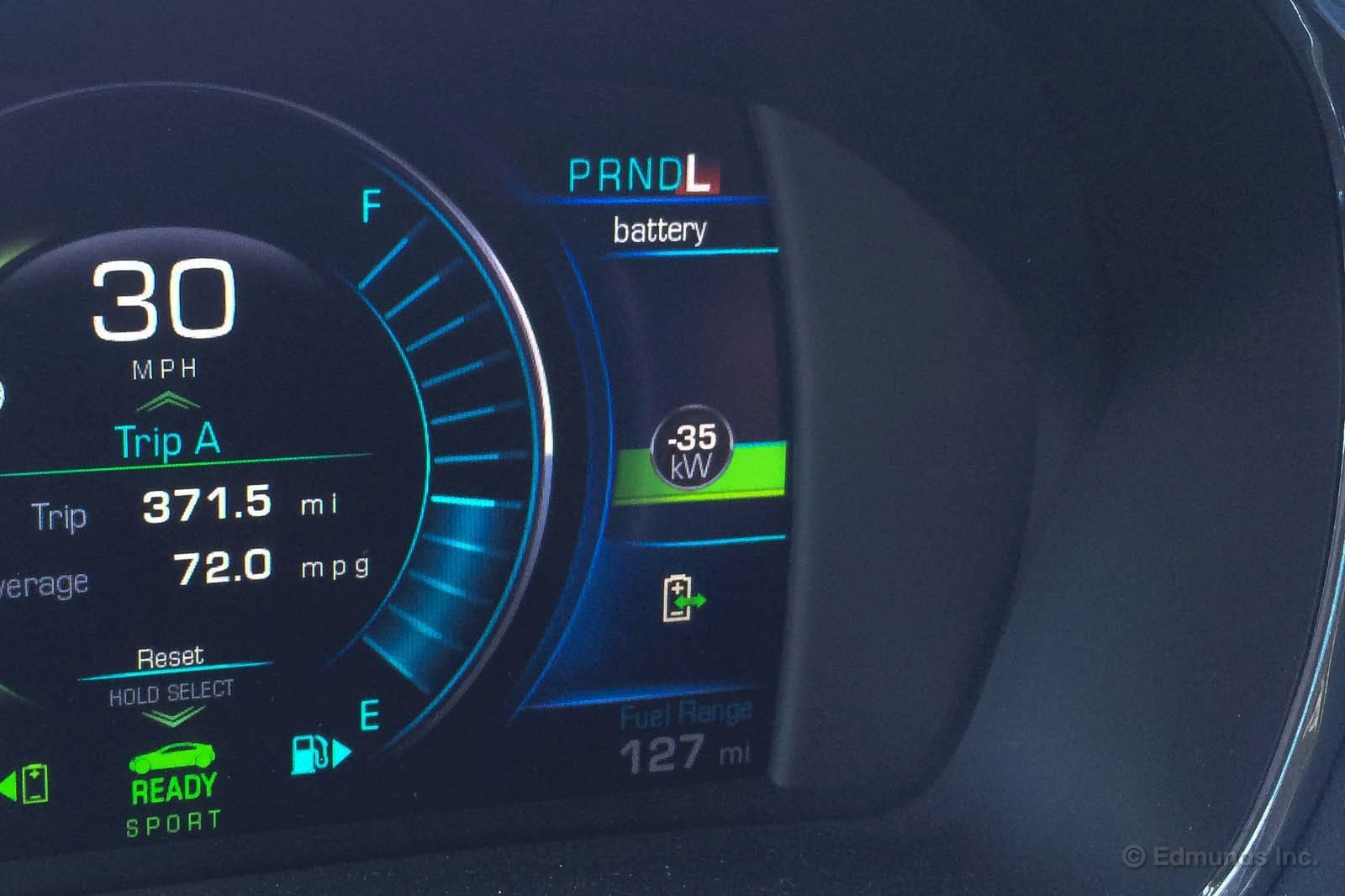
We've written a few prior updates about the regenerative braking paddle on our 2016 Chevrolet Volt's steering wheel. None of them has been positive. After driving our Volt for about two weeks, though, I've found that using the paddle in conjunction with the "Low" driving mode works pretty well.
But is it worth it?
The problem, as my coworkers pointed out, is that the paddle's regenerative braking level is all or nothing. You can't modulate it. But a workaround, as Cameron touched on a few months ago, is to use the Volt's "Low" driving mode. This switches to a more aggressive level of regenerative braking/coasting than in the normal "Drive" mode.
If you assume coasting while in Drive is regen/deceleration level one, then getting off the accelerator while in Low is like level two. Pulling the regen paddle on the steering wheel is therefore level three, which is the highest level of regen/deceleration without engaging the Volt's traditional friction brakes.
Going from level one to three is jarring. But going from two to three isn't so bad.
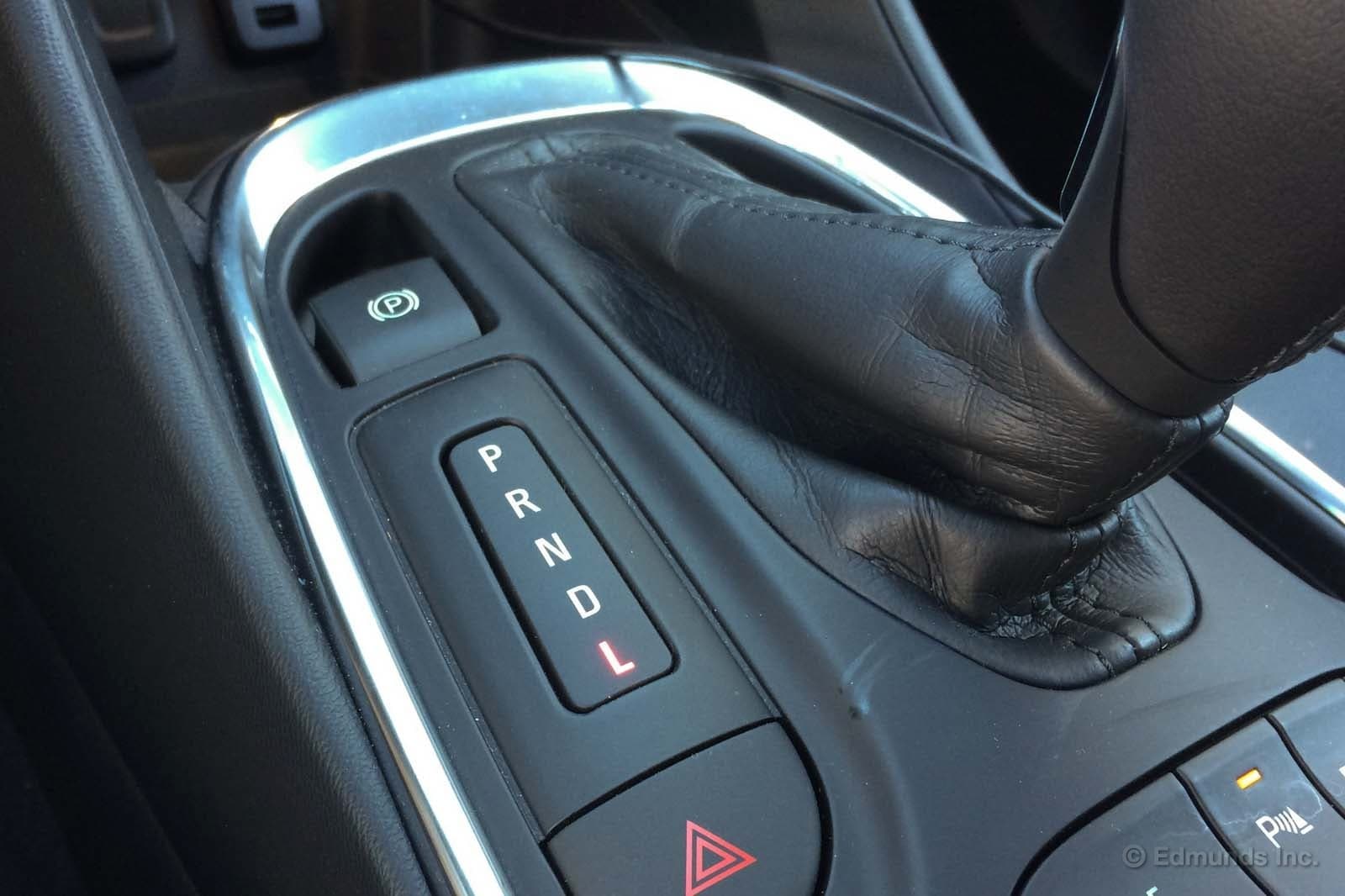
If I'm approaching a stop light and need to slow down, I'll just get off the accelerator (while in Low) and eyeball when I need to apply the paddle for even more regen. At level three, the deceleration is pretty similar to what most other drivers are achieving with their brake pedals.
The Volt doesn't come to a complete stop this way, though. It only slows to creep speed (like you get with a regular car with an automatic transmission). You still have to apply the regular brakes right at the end.
Still, I've been pretty pleased with myself and my Low/paddle two-step. Surely I'm being super-efficient — I'm not using the friction brakes at all! I even pointed out my awesomeness to my wife while we were out on a drive. She was not nearly as impressed. "This seems dumb. Why can't you just use the regular brake pedal?"
Erm, well, that's a good point. I've also watched the Volt's battery regen meter while using the regular brake pedal. The Volt automatically applies plenty of regenerative braking all on its own. How much more efficient can the Low/paddle two-step be?
Devising a viable test on my own would be a challenge. But I read a recent press release on the upcoming 2017 Bolt EV. Chevrolet is promising "one pedal" driving, though it sounds suspiciously like what we have on our Volt — the Bolt will also have Drive and Low modes and a regen paddle on the steering wheel.
In that release is this nugget: "The engineers found that the one-pedal driving can add up to 5 percent of range to the Bolt EV."
Supposing the same holds true for the Volt while you're driving it as a pure electric vehicle, all of the shenanigans I described earlier might extend the car's all-electric range by a mile or three.
Everything helps, I suppose. And using the Low/paddle combo sort of forces you to drive more efficiently if you're otherwise the type of driver who likes jackrabbit starts and stops. But there's a valid argument for just driving the Volt in Drive mode and using the brake pedal like a regular car. You'll still have plenty of EV range and save yourself some hassle in the process.

I like driving our 2016 Chevrolet Volt. It has plenty of all-electric range, it's quick to accelerate at low speeds and its hatchback design provides a fair amount of utility. Logically, this car makes a lot of sense. But given the not-insubstantial sticker price, I'm dissatisfied with the Volt's interior.
While the interior design is attractive in theory, it's swallowed up by the mass of black plastic. Maybe our Volt's interior would look better with the Premier trim's optional two-tone color scheme (you can see what it looks like with Chevy's consumer site configurator), but you'd still have the sprinkling of chrome trim bits, which do little other than reflect sunlight and cause driver distraction.
Regardless of which version you get, the Volt's interior has hard plastic panels for the dashboard and doors. The center-stack grab handles (for lack of a better term) are particularly egregious. They are in plain sight, right next to the USB ports, and their edges are rough and unfinished. Wrapping my hand around one gives me flashbacks of the dark days of General Motors interior design. The insubstantial feel of the door-release handles and some of the buttons is another disappointment.
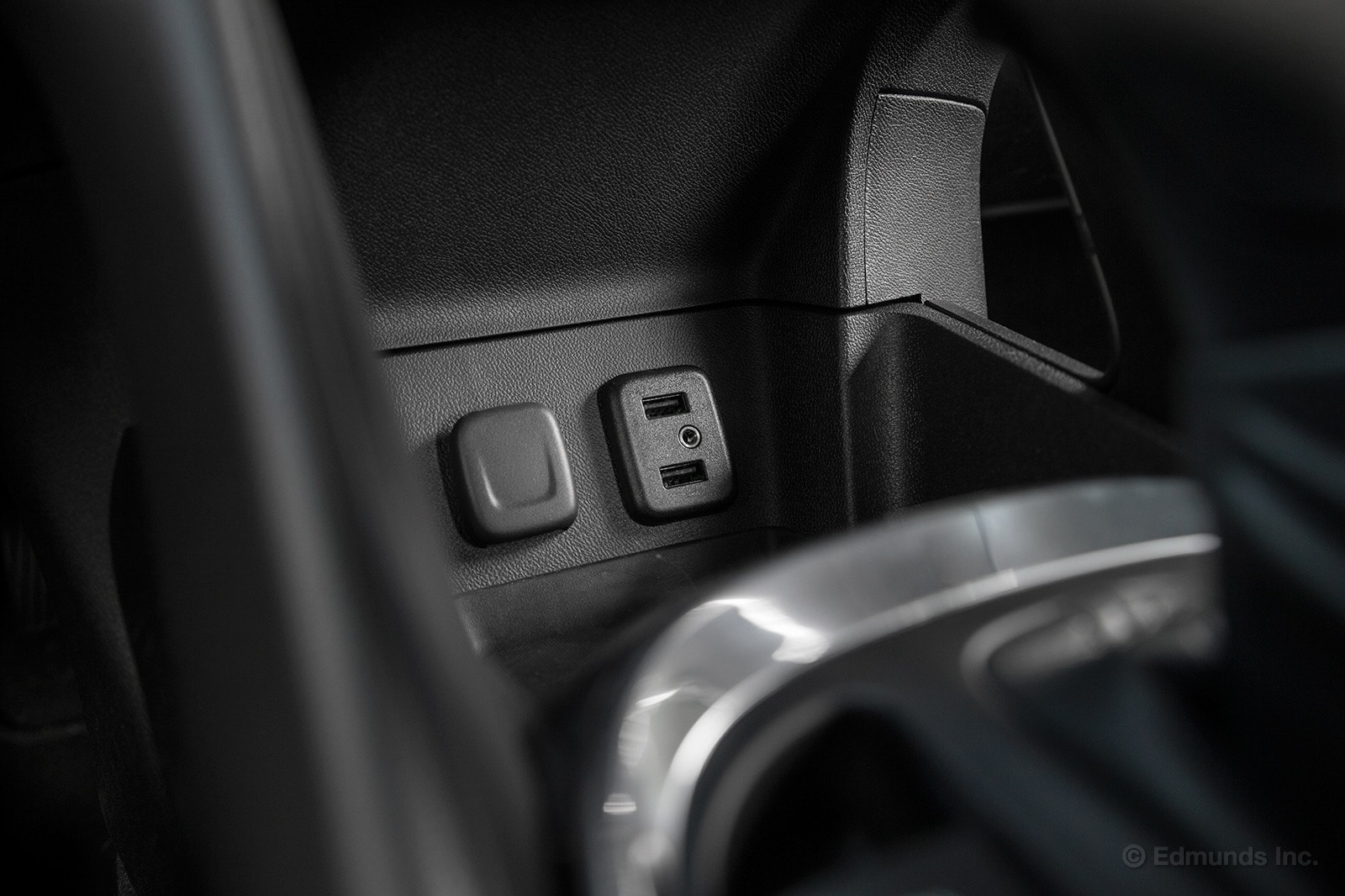
Granted, you're not likely to just sit around and caress your Volt's interior trim pieces. And to Chevy's credit, the armrests are covered with decent padding and the steering wheel is nicely shaped. Perhaps the interior designers knew they had a tight budget and chose to focus their money on the most important bits. I appreciate that. But this is a car that, government rebates aside, stickered at $40,620. If interior quality is a priority for you, the Volt is likely going to disappoint.
Monthly Update for October 2016
Where Did We Drive It?
Our 2016 Chevrolet Volt made the usual rounds this month, mainly ferrying editors to and from our office in Santa Monica on their commutes. We also drove it to Rosamond, California, home of the famous Willow Springs Raceway, for our annual driving school. On the way, the Volt made a cameo appearance at Vasquez Rocks, aka arguably the most exciting sight on the desolate stretch between Santa Clarita and Palmdale.
What Kind of Fuel Economy Did It Get?
October wasn't a particularly remarkable month for the Volt in terms of energy efficiency. If you look at the data below, however, you'll notice that our Volt has never achieved the EPA fuel economy estimate. Not even on its best tank! How could that be? Director of Vehicle Testing Dan Edmunds weighs in:
"We're mostly just driving it. No hyper-tests for it so far. We still need to take it on our standard test loop, for example. Don't forget that the Volt spends a lot of time in notorious L.A. traffic, which is worse than the city driving pattern used by the EPA."
In other words, stay tuned — the Volt's best mpg may be yet to come.
Average lifetime mpg: 38.8 mpg
EPA mpg rating: 42 mpg combined
Best fill mpg: 40.3 mpg
Best range: 531.4 miles
Current odometer: 14,954 miles
Maintenance and Upkeep
A flat tire left one editor on the side of the road. The standard inflator kit didn't fix the flat, so we had to use a tow truck to remedy the situation. The right rear tire cost us $195.37, including labor.
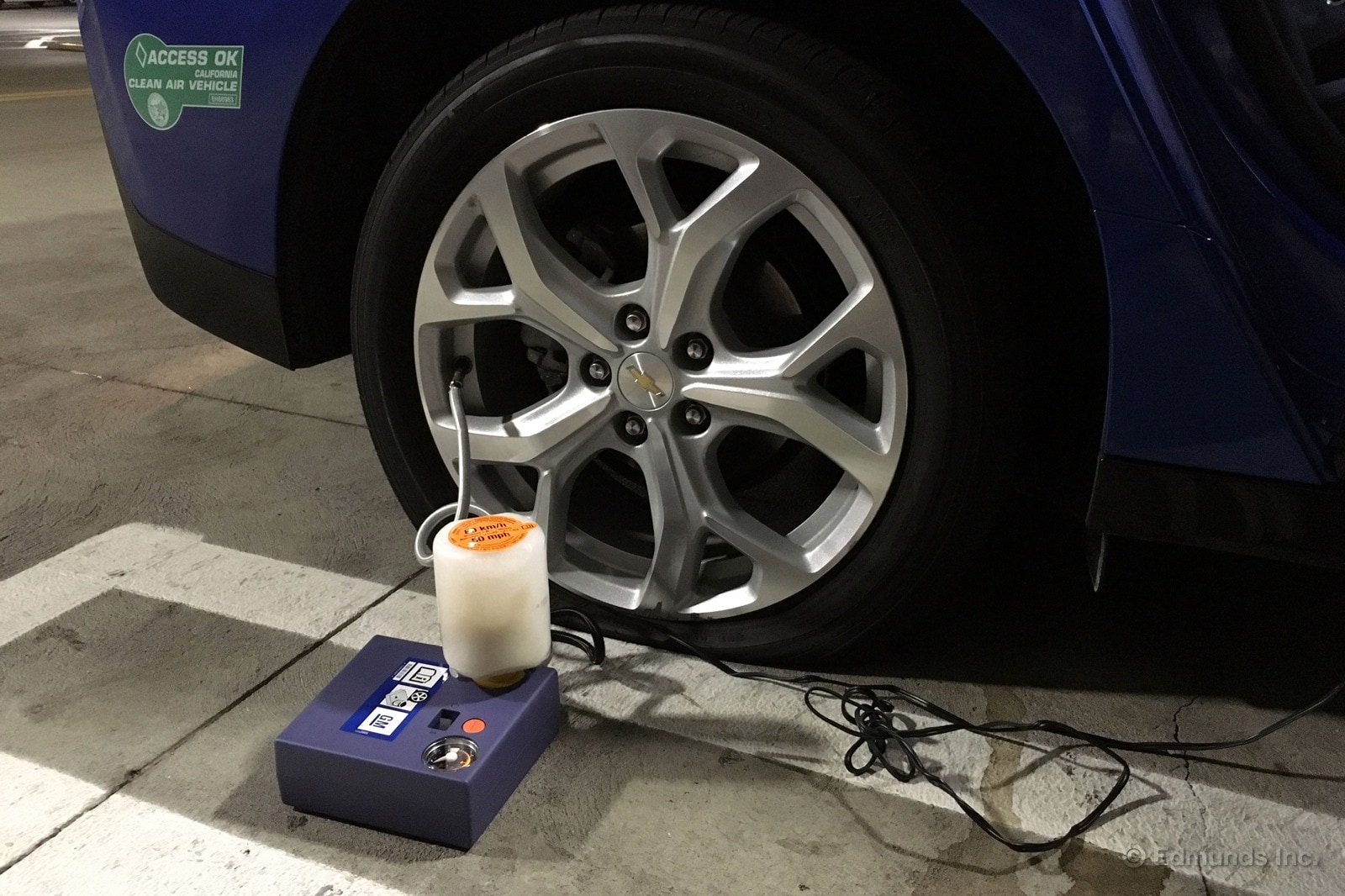
Logbook Highlights
Comfort
"The Volt soaks up small bumps like a typical midsize sedan. It's only when you hit a larger pothole that you feel a harsh jolt through the cabin." — Ed Hellwig, Executive Editor
Miscellaneous
"My wife is currently driving an all-electric Fiat 500e that we leased a few months back. She doesn't drive many miles a day, so we've found that the standard 120-volt Level 1 charge cord that came with the car is more than adequate. Such charge cords are standardized, so I've been able to use it to recharge the Volt even though the cord has Fiat branding on it. No use uncoiling a second cord if you don't have to, right?" — Dan Edmunds, Director of Vehicle Testing
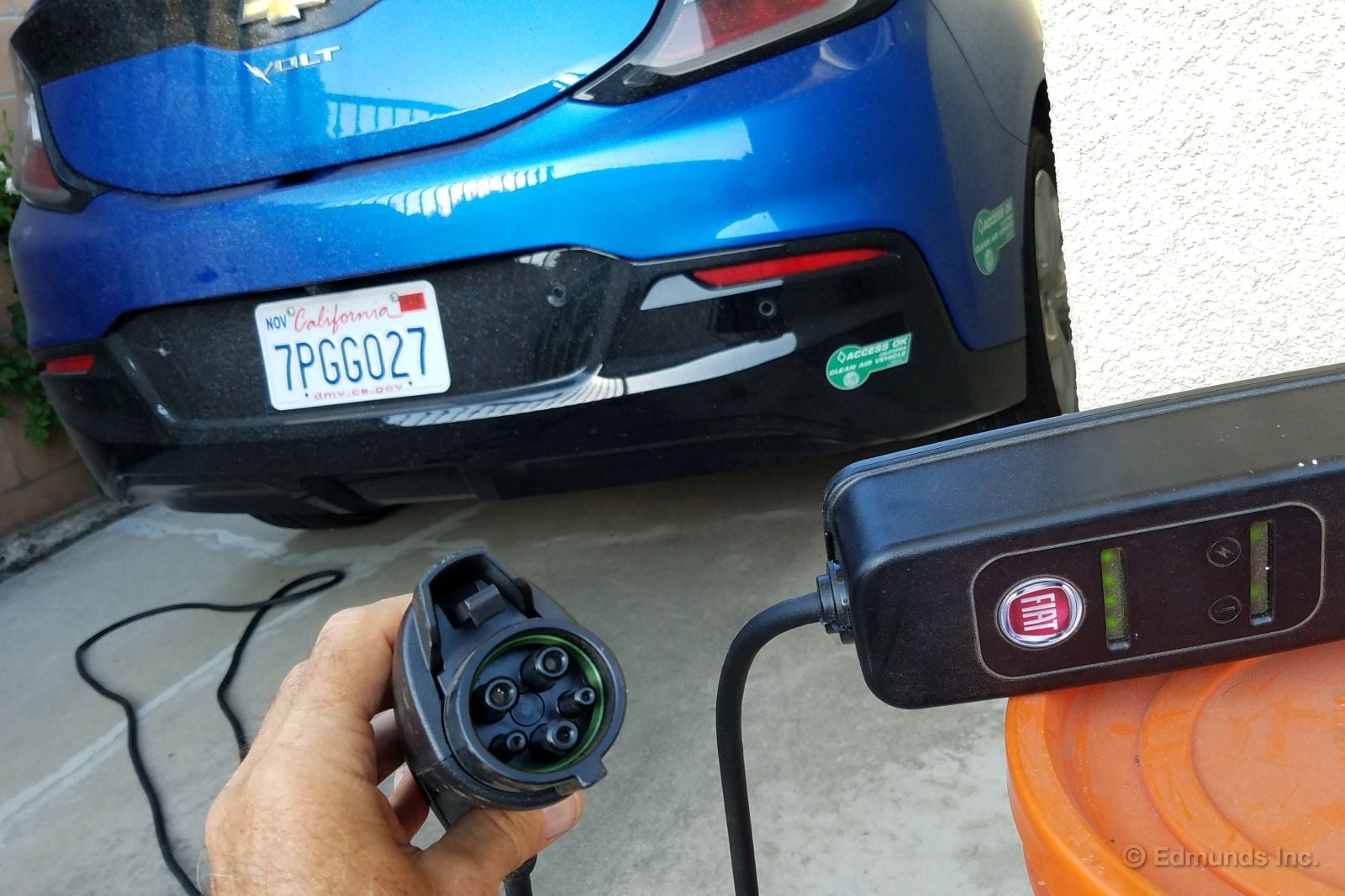
Performance
"I live 46 miles from work, and the 2016 Volt has plenty of electric range to get home on a full charge. I've gone as far as 70 miles when traffic was just bad enough to keep my speed down below 50 mph the entire way. Today's freeway pace was generally higher. Traffic cleared about halfway home and started to move along at the 65 mph speed limit. I made it home on electricity, but 'only' had 13 miles left. That amounts to a projected range of 59 miles. Not too shabby." — Dan Edmunds
"The first-generation Volt was not a particularly smooth-driving car or efficient car when running on gasoline. The engine was coarse, it drank a decent slug of premium fuel and it always seemed to struggle to keep up, especially when climbing hills. But this second-generation Volt is better by leaps and bounds. Its gas engine runs in the dim background to the point where it feels little different than all-electric mode when cruising at moderate speeds or nosing around the city. It starts to be more noticeable when climbing hills or cruising the fast lane on the freeway, but it's still quieter and more subdued than some other gasoline hybrids I can think of. If I had to give one car the Most Improved award, the 2016 Chevrolet Volt would be it. " — Dan Edmunds
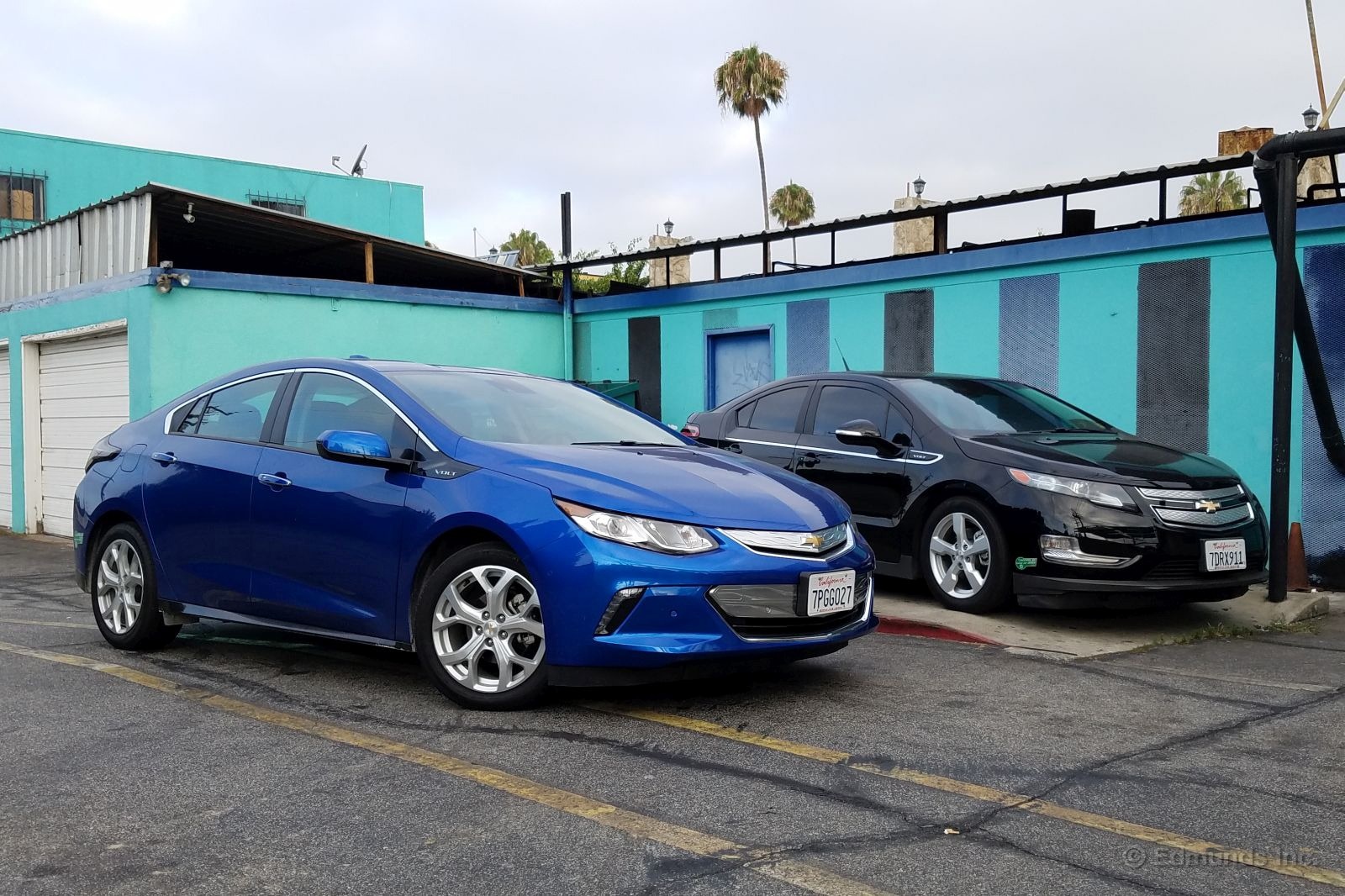
Monthly Update for November 2016
Where Did We Drive It?
Our 2016 Chevrolet Volt started November strong, with most of the drivers only tapping into the gasoline engine for 20 to 30 miles at a time before plugging into a charging station. Michael Massey filled up early in the month for a gas-only average of 40.8 mpg. It stayed around Los Angeles, mostly running on electricity only, until I took it over the Thanksgiving break. Traveling around Orange County for a week made it too difficult to stay hooked up to charging stations, so most of my errands involved running on gas. The Volt closed the month with a 0.2 mpg downtick in overall fuel economy.
What Kind of Fuel Economy Did It Get?
November was a busy month in these parts, what with the LA Auto Show, related press events spread throughout the city and Thanksgiving festivities. The Volt was used mostly for normal commuting duties, while I threw in some traveling on deserted Orange County highways over Thanksgiving.
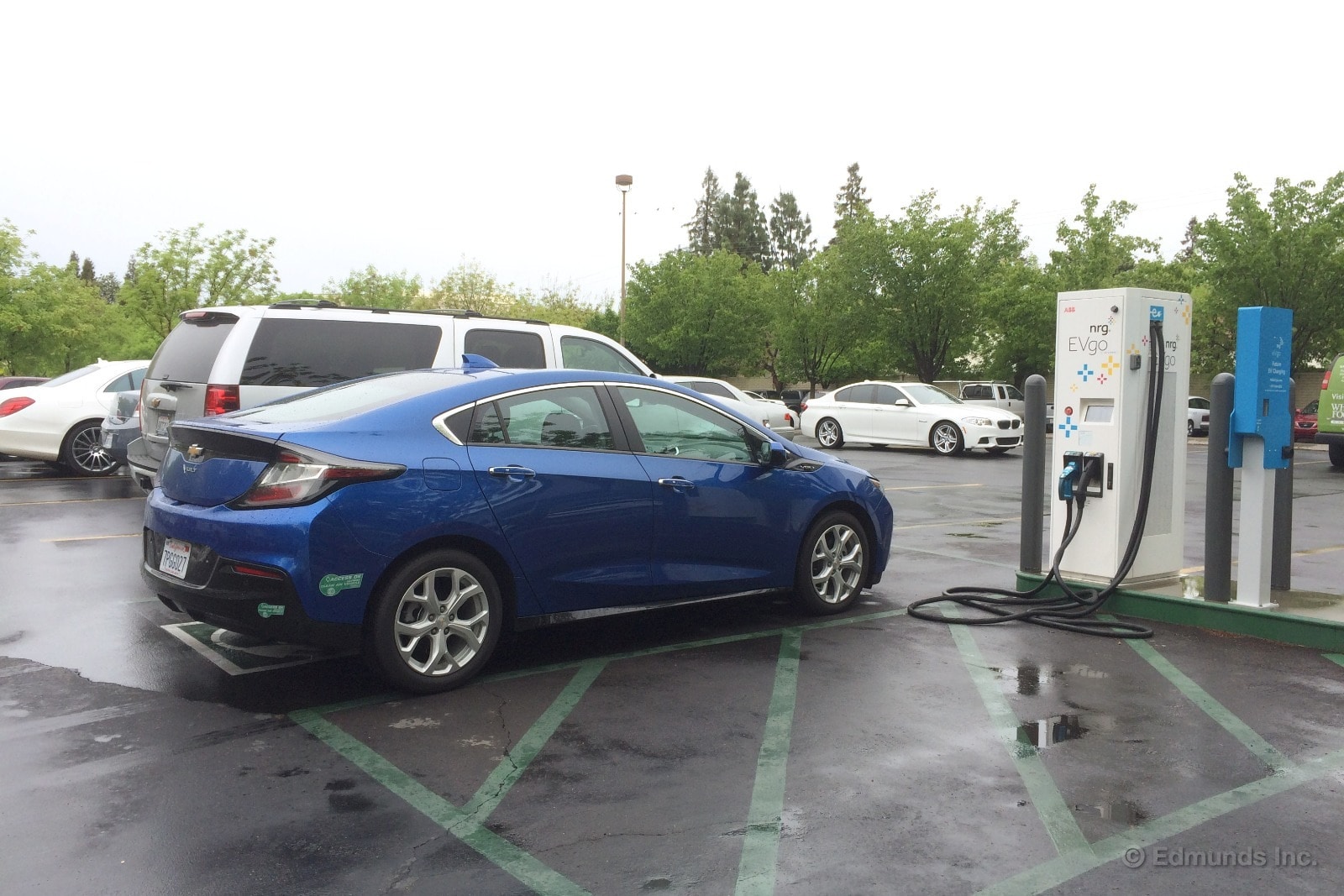
Tracking true fuel economy in a plug-in hybrid is an inherently tricky task because the "crossover point" from electric to gas is what matters for the math, not the odometer reading at each fuel stop. We reviewed our data and identified a new high of 45.1 mpg, so our Volt has now officially outperformed the EPA estimate.
Average lifetime gasoline mpg: 38.6 mpg
Best fill mpg: 45.1 mpg
EPA combined mpg rating: 42 miles
Average electric range: 51.6 miles
Best electric range: 75.0 miles
EPA electric range rating: 53 miles
Best range between gasoline fills (electric fills + gasoline): 681 miles
Current odometer: 16,073 miles
Maintenance and Upkeep
Vehicle Testing Assistant Mike Massey noticed a chip on the Volt's windshield, which Safelite repaired to the tune of $138.65 (see comment below).
Logbook Highlights
Miscellaneous
"With the all-electric Chevrolet Bolt scheduled to hit dealers in a few weeks, I'm curious how many people who currently drive a Volt will make the switch. Sure, there will be those who always want the latest and greatest thing available, but I'm guessing that most Volt owners already realize that they're using battery power most of the time, if not all of the time, already." — Ed Hellwig, Executive Editor
MPG
"I took possession of the Volt with 286 miles on the trip meter and the onboard calculator showing fuel consumption at more than 250 mpg, the highest number the calculator displays. I tried to keep this number as high as possible over the next week, but I couldn't stay tethered to ChargePoint stations forever. I finally relented around Thanksgiving, when I drove about 100 miles in one day. By the time I filled up with gas, the Volt's displayed average was around 95 mpg. Sorry for party foul, everyone." — Cameron Rogers, Associate Editor
Maintenance
"As I settled into the Volt's driver seat, I reached to put my suction-cup phone holder in place and noticed a star chip about the size of a dime in the windshield. I dialed up Safelite. They came to the office and repaired the chip to almost perfect invisibility. They told me that chips like this will leave a scar, but I can't personally find it. The repair cost us $138.65." — Michael Massey, Vehicle Testing Assistant

Monthly Update for December 2016
Where Did We Drive It?
After a spell in Fresno, California, with editor Brent Romans, our long-term 2016 Chevrolet Volt returned to Edmunds' Santa Monica base only briefly. I was then off on a voyage to Corvallis, Oregon, and back a week later. My trip north was the first time we've driven our Volt in conditions with plenty of precipitation, including snow. Then I ventured southeast to Temecula, California, for more rain, and back. In total, we drove almost 3,000 miles in December.
It was an engine-heavy month because there were scant few charging opportunities in between. Such is the beauty of the Volt, though. It can do the daily commute grind solely on battery power and still provide the convenience of a conventionally fueled car when the need arises.
What Kind of Fuel Economy Did It Get?
As always, tracking fuel economy on a plug-in hybrid such as the Volt is not straightforward. We do our best to separate miles driven solely via battery power versus those motivated by gasoline. It's not a perfect system since it means diligently (and accurately) recording the battery-gasoline switchover point when applicable, plus other factors. But here's what we've observed so far:
Average lifetime mpg: 37.2 mpg
Best fill mpg: 45.1 mpg
EPA combined mpg rating: 42 miles
Average electric range: 52.8 miles
Best electric range: 75.0 miles
EPA electric range rating: 53 miles
Best range between gasoline fills (electric fills + gasoline): 681 miles
Current odometer: 19,377 miles
On the 2,000-mile road trip to Oregon and back, the Volt ran exclusively on gasoline and returned 34.6 mpg.
Maintenance and Upkeep
None.
Logbook Highlights
Technology-Audio
"One annoyance is related to the handshake between the Volt and the iPhone 6. The Volt has Apple CarPlay, which is fine, but CarPlay doesn't put Waze on the Volt's screen. No big deal since Waze alerts come over the car's speakers if the phone is plugged in.
"But what happens next is where the annoyance sets in — immediately following a Waze alert (or, I suspect, similar such actions from apps running natively on the phone), the Volt's audio system always switches over to playing your phone's music. Doesn't matter if you were on FM or XM, you're now listening to your phone's music. Constantly switching back to XM after every Waze alert grew particularly aggravating on my long trip. Eventually I simply unplugged my phone. In fairness, this hiccup might be an Apple issue and not a Volt issue." — Jason Kavanagh, Engineering Editor
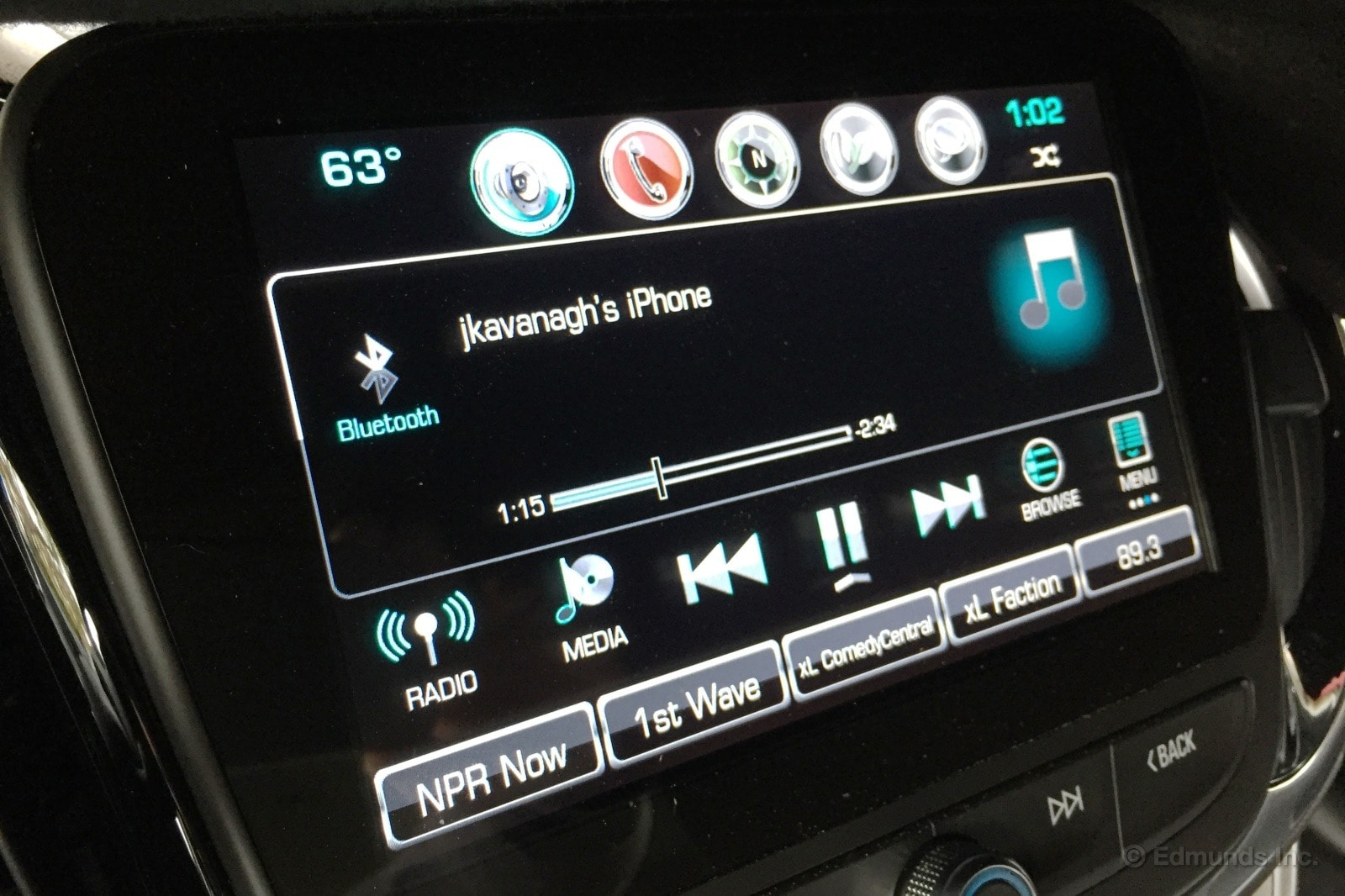
Interior
"One of the supposed advantages of the new-generation Volt is its three-person backseat, as opposed to the original Volt's two-person seat. It's supposed because there's no way you can fit three adults in back. But kids are a different matter. My family currently includes my wife, 5-year-old son, 9-year-old daughter and 17-year-old female foreign exchange student living with us. I had to drive them to a local event recently, so I put my daughter in the middle (without a booster seat), with my son and (temporary) teenage daughter flanking. There isn't a center head restraint in the Volt, which is disappointing, but for this local trip it worked out fine. Think of the Volt's center rear seat as an emergency jump seat." — Brent Romans, Senior Automotive Editor

Performance
"Our Chevrolet Volt is easy to drive around town. Maybe even a little fun. Thanks to its small size and quick and light-effort steering, you can zip in and out of parking lots like an American Ninja Warrior going through an obstacle course. The electric motor's instant torque provides a quick burst of acceleration if you need it, too." — Brent Romans
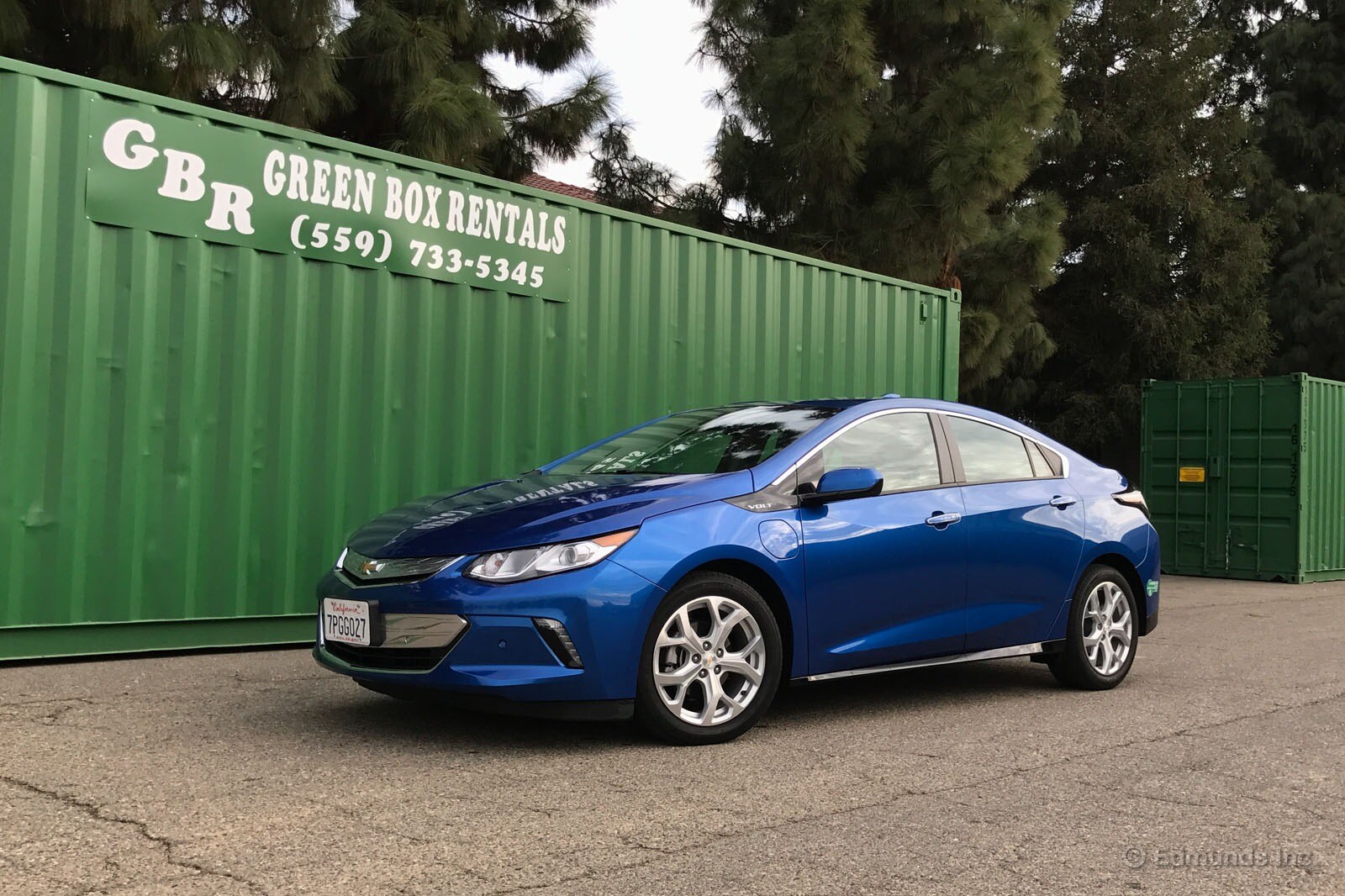
"Related to my previous entry about our Volt being easy to drive, I should add that saying the Volt is fun doesn't necessarily mean it's sporty to drive. Yes, it's nimble in a parking lot, but on a twisting road, the Volt is out of its element. There's not a whole lot of grip from the economy-oriented tires, the steering doesn't give any road feel to the driver, and the Volt unsettlingly bobs and floats around when it drives over some midcorner bumps." — Brent Romans
"On my return trip from Corvallis, Oregon, to Los Angeles, snow was falling on Interstate 5 near Mount Shasta in Northern California. It was a light snowfall that wasn't accumulating on the freeway surface, instead simply wetting down the asphalt. But when I turned off the freeway, I immediately found snow-covered roads. And there I was on all-season tires, which are better described as 'no-season' tires, especially when they're of the Volt's low-rolling-resistance variety. There was very little traction available.
"My driving instincts flipped back to my decades as a New Englander: making measured, smooth inputs; exploiting momentum; and knowing when to turn back. The moral, of course, is to always carry chains if you think you might encounter snow (I didn't encounter snowy roads on this trip outside of this brief foray) or to get a set of real winter tires if you live where snow is part of the usual seasonality. The Volt's tires are good for fuel economy but disappointing when traction and grip are concerned." — Jason Kavanagh
MPG
"In theory, you can drive the Chevrolet Volt like a regular hybrid — just don't ever plug it in! But based on personal experience, I can't recommend that. For logistical reasons, I wasn't able to recharge our Volt's battery pack for a few days. With a depleted battery, the Volt relies on its 1.5-liter engine for power almost all the time. There's still regenerative braking, of course, and acceleration is just as quick. The engine is quiet, too (unless you've got the gas pedal pinned).
"But the resulting fuel economy is mediocre, at least as hybrids go. After driving 264 miles of mostly city miles, our Volt returned 37.8 mpg. Meh. (The EPA doesn't give a gas-only city rating for the Volt, just a combined driving estimate of 42 mpg.) A Chevrolet Malibu Hybrid, which has Volt powertrain guts but without the giant battery, gets 49 mpg city (46 mpg combined). It's also cheaper and roomier. I'm hoping Volt owners are utilizing the car's plug-in recharge ability to its full potential." — Brent Romans
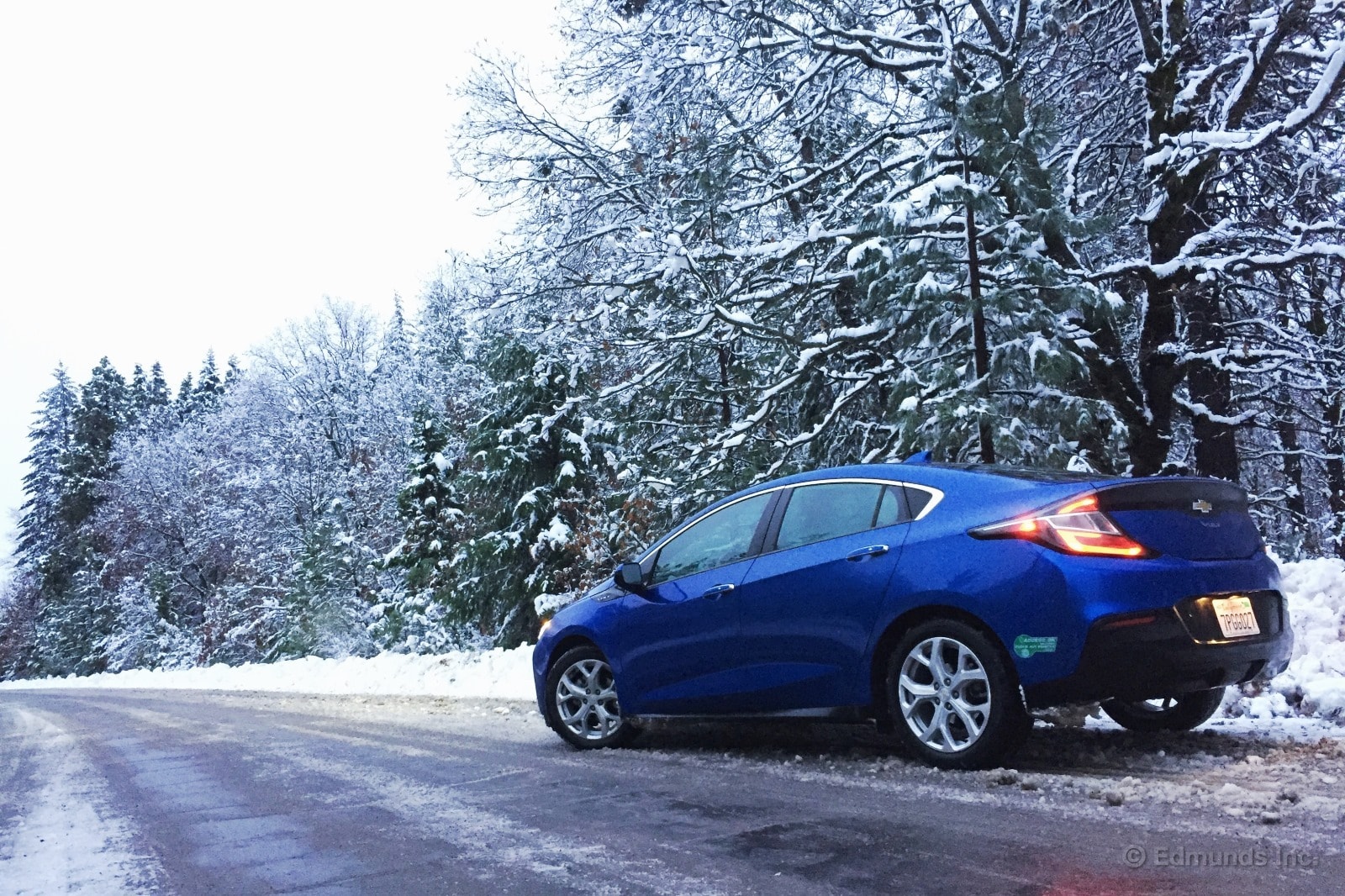
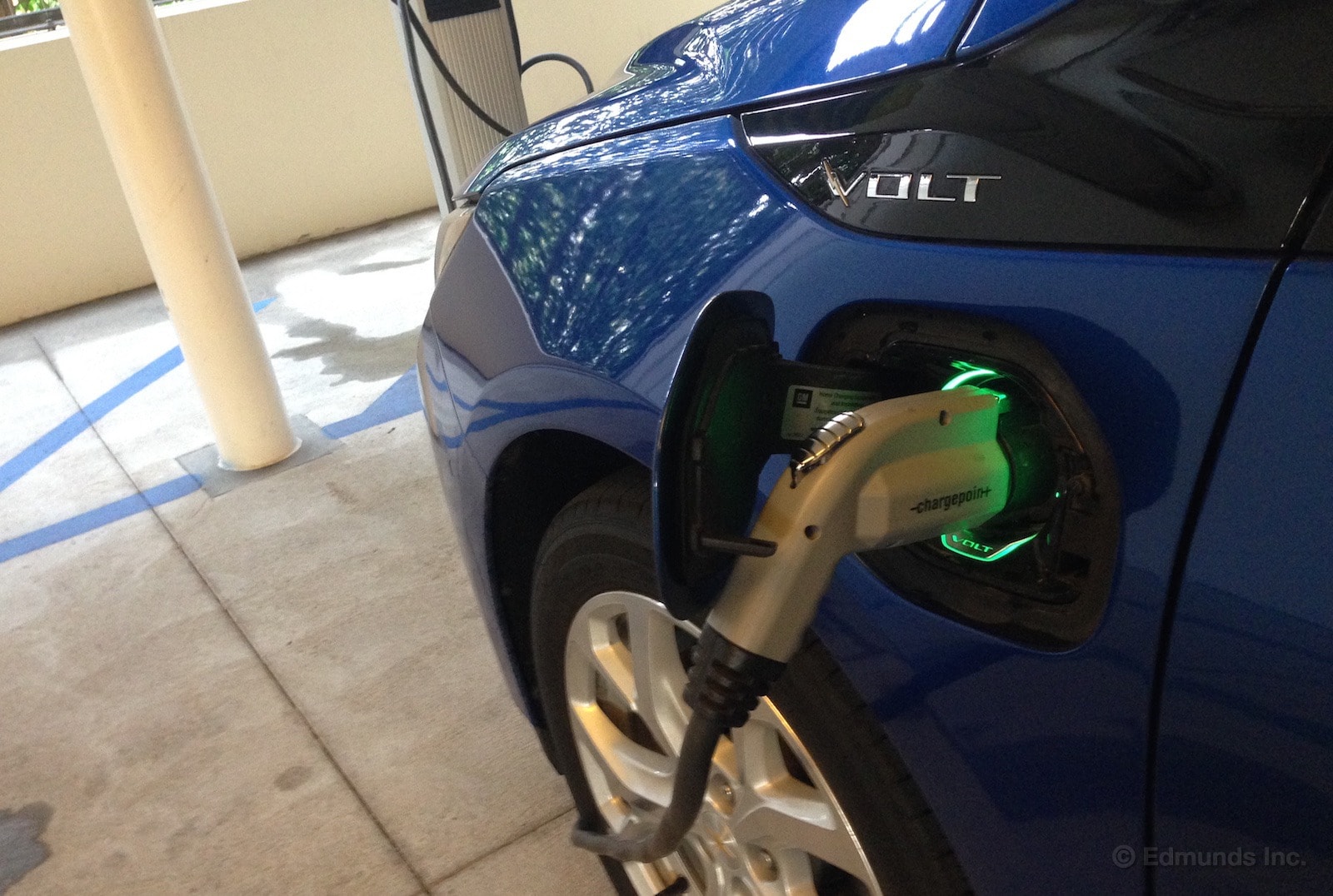
I live pretty far from the office, so my M.O. when driving the 2016 Chevrolet Volt is to milk the charge as far as I can, then run it off the engine until the next time I can get it back to the Edmunds garage charger. Driving the Volt primarily like a hybrid, running solely off the gas engine, isn't really in the spirit of the thing, but I don't have a Level 2 charger at home and I suspect the next-gen Volt would be here by the time I could replenish the battery from the garage outlet.
The other day I needed to get out of the house for a bit, so I tossed the laptop in a bag and headed to a nearby church of consumerism. I figured I'd add some charge to the Volt while having coffee and doing some work — see how the clothes of EV life fit me. The closest ChargePoint was across the street from the mall, in a corporate parking garage.
I couldn't get an app going to monitor the Volt's charge (someone has since told me you can do it on the Volt's OnStar site), so after an hour and 20 minutes, I packed up and headed back to the car.
The Volt had stored up just 13 miles of EV range, which was disappointing. It was enough to get home on electric power alone (8 miles). Although when I headed out for a drive the next day, the meter showed just 3 miles remaining, which dropped to 2 miles almost as soon as I left the driveway. Oh well. It cost about $1.25 for 80 minutes on the charge and 10-ish miles of range.

The 2016 Chevrolet Volt's T-shaped battery pack feels like the EV Age's equivalent of the muscle car's driveshaft tunnel. There's a symmetry to the idea that I like. Still, in comparison, the Volt's pack consumes as much, probably more, of the rear floorboard, nearly rising up to seat level. It's also topped by a portion of the center console with cupholders and seat heater controls, making it impossible to lay any kind of long objects on the floor. At least the hatch is large.
I like the old metal just like anyone who grew up with uncles and other relations who were then-original owners of those types of cars (as well as a father who owned a few, including a Mach 1 in which I may or may not have been conceived. Both parties responsible deny it. I remain suspicious).
But I also like how the electric future looks. You only need to drive the Volt solely on EV power for a while to see how it all makes sense. The instant torque surge is intoxicating. No, a slight electric whine is no substitute for a V8 kicked in anger. But blowing the doors off your neighboring motorists at the light, especially right before that tight freeway on-ramp, is its own satisfaction.
Monthly Update for January 2017
Where Did We Drive It?
January was a quiet month for our 2016 Chevrolet Volt. After December's road-trip adventures we mostly stayed in town this month, yet we still added about 1,500 miles to the odometer. Notably, we passed the 20,000-mile mark, although a bit behind schedule. The Volt will leave the fleet soon, probably with about 22,000 miles.
What Kind of Fuel Economy Did It Get?
As always, tracking fuel economy on a plug-in hybrid such as the Volt is not straightforward. We do our best to separate miles driven solely via battery power versus those motivated by gasoline. It's not a perfect system since it means diligently (and accurately) recording the battery-gasoline switchover point when applicable, plus other factors. Here's what we've observed so far:
Average lifetime mpg: 37.2 mpg
Best fill mpg: 45.1 mpg
EPA combined mpg rating: 42 miles
Average electric range: 52.8 miles
Best electric range: 75 miles
EPA electric range rating: 53 miles
Best range between gasoline fills (electric fills + gasoline): 681 miles
Current odometer: 20,447 miles
Maintenance and Upkeep
None.
Logbook Highlights
Comfort
"I continue to give the Volt a chance. And I continue to be disappointed by its lack of long-distance driver seat comfort. We aren't a good fit for each other." — Mike Schmidt, Senior Manager, Vehicle Testing
Interior
"I like that the Volt's T-shaped battery pack is the EV Age's equivalent of the muscle car's driveshaft tunnel. There's a symmetry there. Still, in comparison, the Volt's pack consumes as much, if not more, of the rear floorboard, nearly rising up to seat level. It's also topped by a portion of the center console with cupholders and seat heat controls, making it impossible to lay any kind of long objects on the floor. At least the hatch is large." — Dan Frio, Automotive Editor

Technology-Audio
"It seems as though audio functions are inconsistent between the steering wheel controls and the on-screen 'skip' buttons. Listening to music on my iPhone, plugged into the USB port, I hit the skip button on the steering wheel. Nothing happened. I hit skip again. Nothing again. Then a few seconds later the music skipped ahead two songs. I hit it once more and timed the response: 40 seconds! Then I hit the skip button on the Apple CarPlay screen and the response was immediate. I tested both methods several times and was met with the same result. It's a weird little glitch." — Mark Takahashi, Automotive Editor
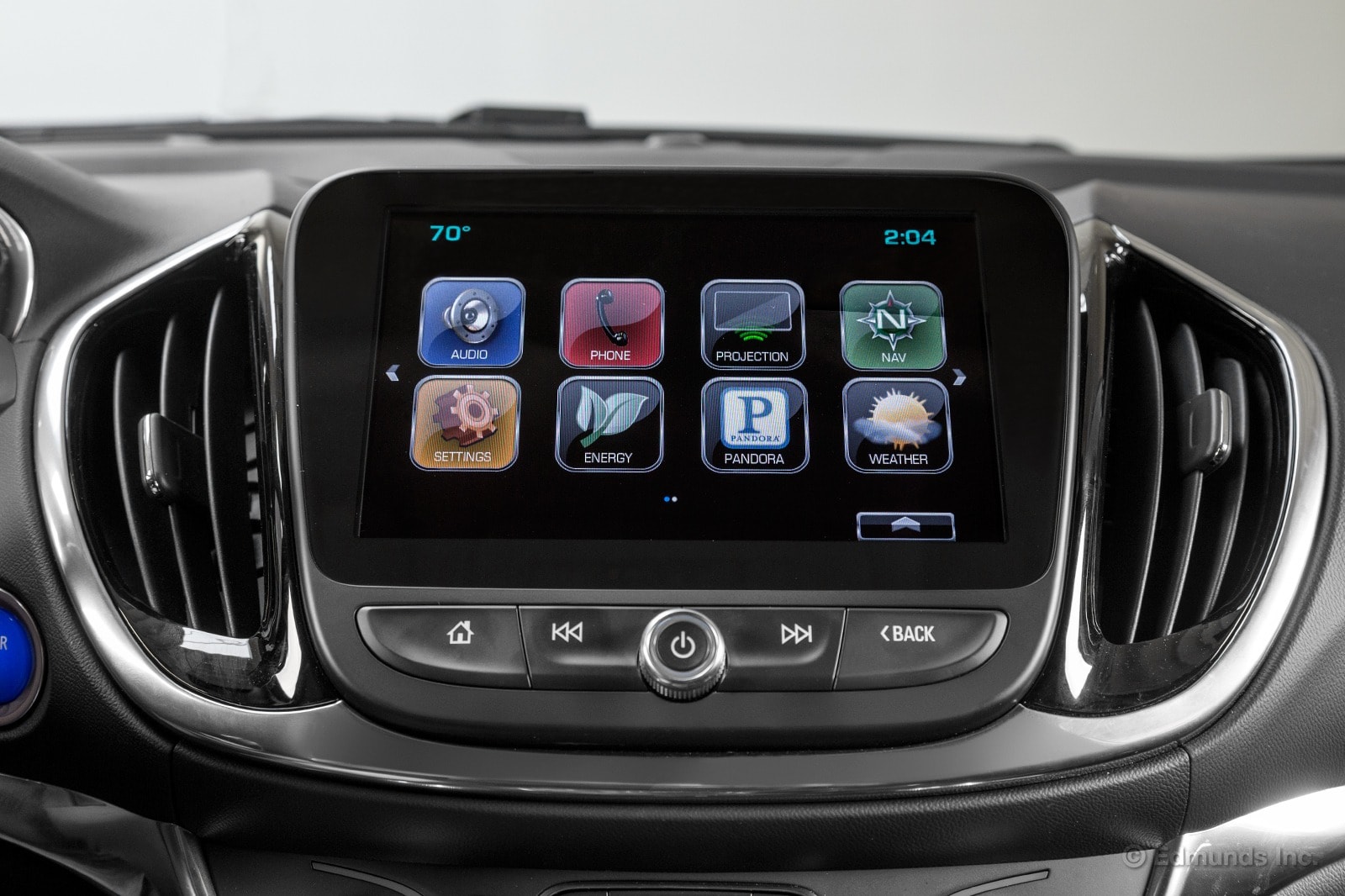
MPG
"I live pretty far from the office, so my M.O. when driving the Volt home is to milk the charge as far as I can, then run it off the engine until the next time I can get it back to the Edmunds garage charger. But that kind of driving isn't really in the spirit of the thing, so I took it to a charge spot at the mall and let it juice up while I took a coffee break. After an hour and 17 minutes, the Volt had ingested only enough for 13 miles of EV range. It seemed disappointing, but a reminder of how to reframe expectations in the electric car era." — Dan Frio

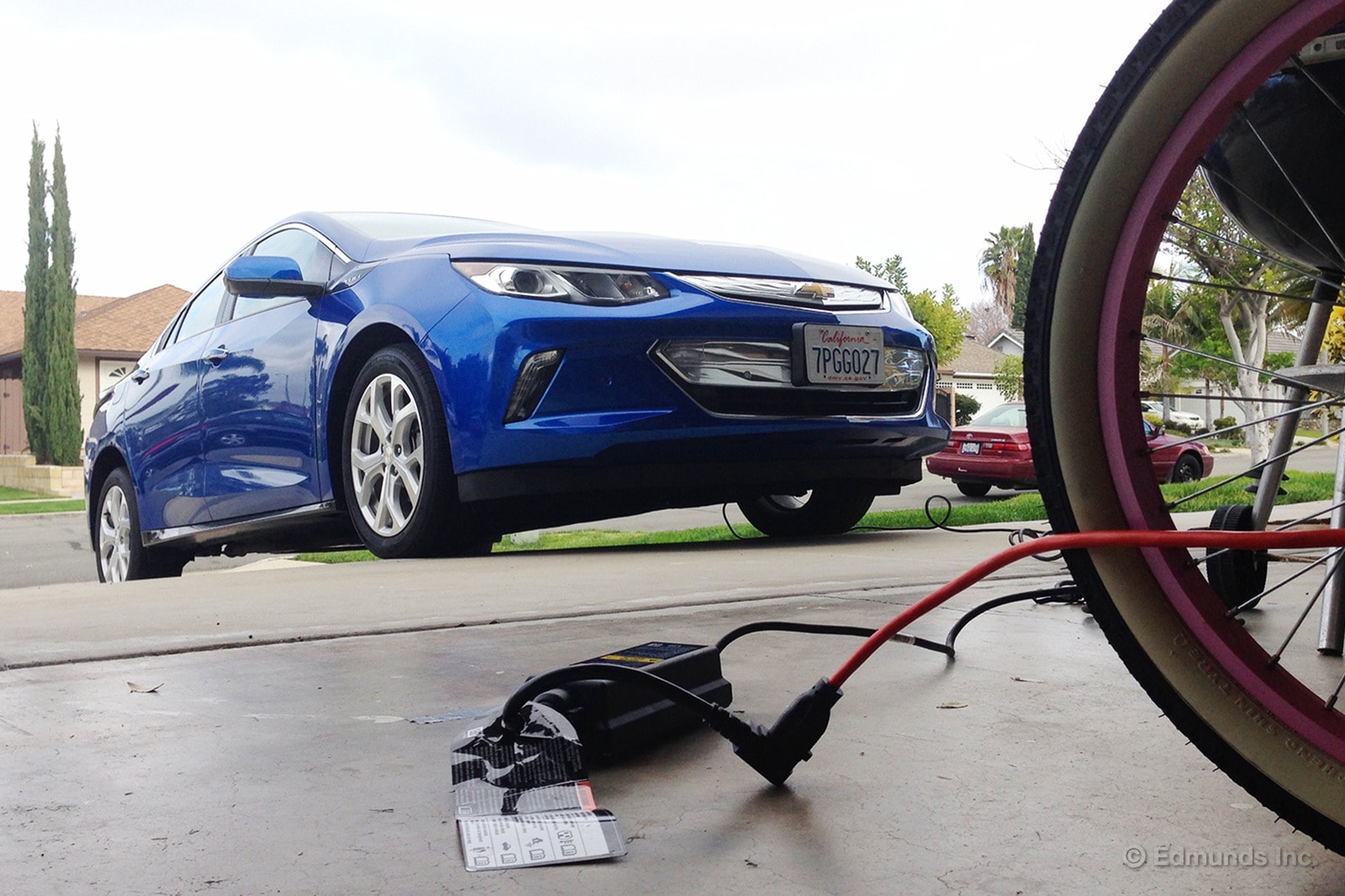
A couple of readers called me out in one of my last posts about trying out the EV life with the 2016 Chevrolet Volt. They argued that my meager attempt at lunch-break recharging didn't constitute real EV living; to do it right, I'd need to try some overnight home charging. Since I don't have a Level 2 charger at home, I'd be stuck with the trickle-charge economics of a 120-volt outlet.
A Volt-owning friend does this, plugging his car into a 120-volt outlet via extension cord at around 7 p.m. He's got a full charge (about 53 miles) when he leaves for work at 5:30 the next morning.
Now it was my turn.
At home, I plugged in the Volt around 10:30 p.m. By 9:30 a.m., the battery had filled to about 60 percent, storing 33 miles of EV range. The Volt indicated it wouldn't be full until 5 p.m. Not quite the outcome I'd hoped for after 11 charging hours, and decidedly behind my friend's typical 10.5-hour pace.
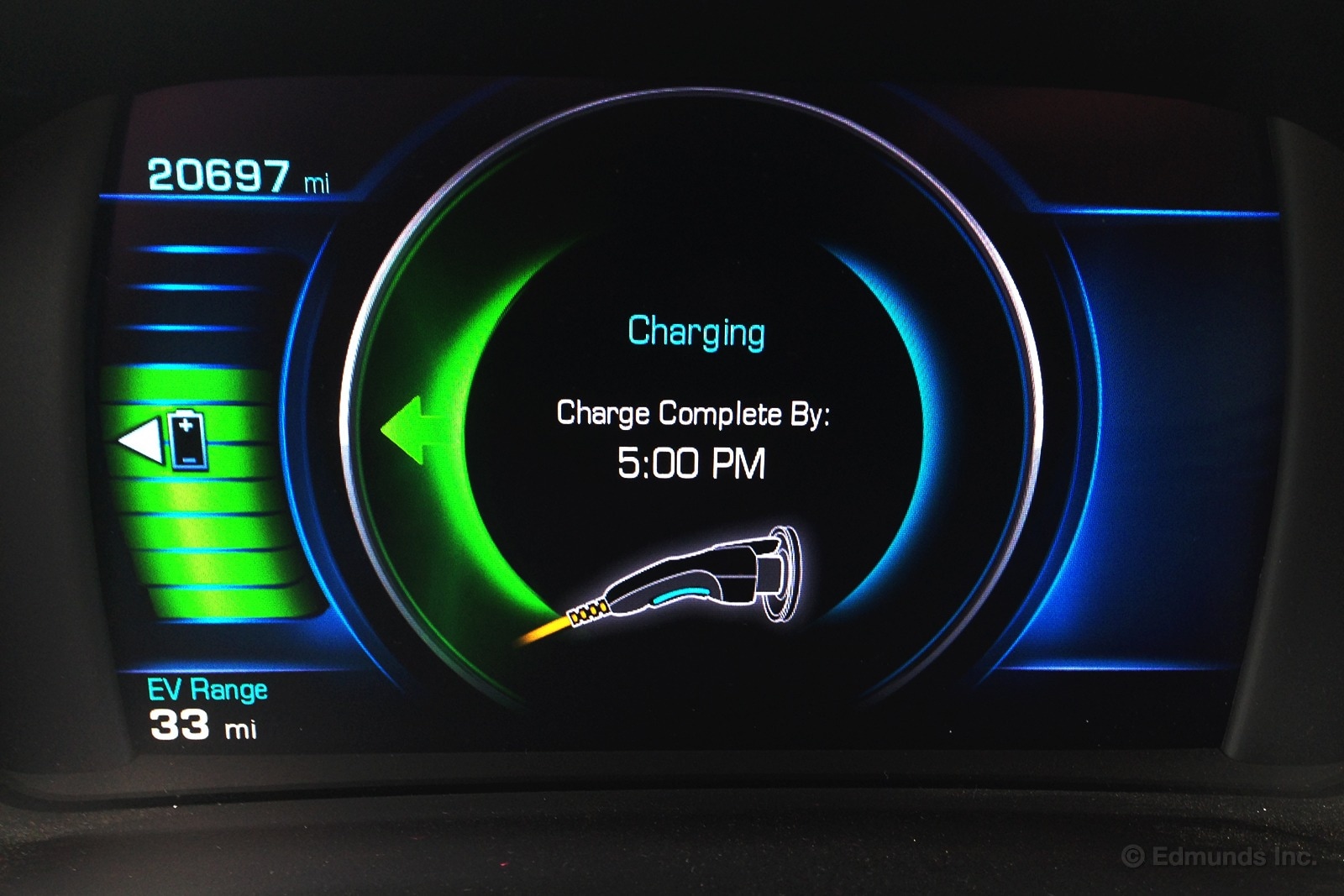
Director of Vehicle Testing Dan Edmunds and I hashed out a few ideas. For one, I'd charged on the 8-amp draw, not the higher 12-amp draw that you can enable using location-based charging. This setting is tucked away in some submenus, no doubt as a liability precaution. By enabling the 12-amp charge, you're telling the Volt that your house or building wiring can handle the higher load without bursting into flames. This likely plays a role in how my friend tops up his battery every night.
Second, the extension cord is a simple and obvious bottleneck in the chain. The Volt's charging cable doesn't want to be on an extension cord (the owner's manual cautions against it), but possibly makes allowances for it based on heat and resistance.
Third, the run between my garage outlet and the house's electrical panel has an effect on charge time and losses. My panel isn't too far from the outlet, separated by a couple of bedrooms, maybe 30 feet.
So we have couple of variables left to test, primarily to see how much more juice we can extract from a 12-amp charge.
Monthly Update for February
Where Did We Drive It?
In the month of February we fed our 2016 Chevrolet Volt a steady diet of commuter miles. It was a lot of heavy lifting for the Volt. But driving wasn't the only work we subjected it to.
Editor Dan Frio and I tag-teamed the entire month with the Chevy. His slog between home and Edmunds HQ is a round trip of 120 miles to my 80. So the majority of the 1,380 miles we drove last month were on the highway, though Dan still made a concerted effort to live the EV life. Additionally, we challenged, and exceeded, the limits of the Volt's cargo hold while running errands locally.
What Kind of Fuel Economy Did It Get?
As always, tracking fuel economy on a plug-in hybrid such as the Volt is not straightforward. We do our best to separate miles driven solely via battery power from those motivated by gasoline. It's not a perfect system because it means diligently (and accurately) recording the battery-gasoline switchover point when applicable, plus other factors. But here's what we've observed so far:
Average lifetime gas mpg: 37.4
Best fill mpg: 45.1
EPA combined mpg rating: 42
Average electric range: 51.4 miles
Best electric range: 75 miles
EPA electric range rating: 53 miles
Current odometer: 21,828 miles
Maintenance and Upkeep
None.
Logbook Highlights
Performance
"The Volt has this odd behavior when it's driving on the gas engine after the battery has been depleted. There's this little symphony of micro-lurches and surges that occur at different points of pedal pressure as the Volt's two motors blend and back off continuously, depending on seemingly hundreds of variables. It's probably not noticeable to anyone else in the car (at least no one who's ridden with me), but it's apparent from the driver seat. Especially if you're active on the pedal and trying to modulate speed smoothly. It's a little distracting, even a little unsettling ... and maybe nothing to worry about. Just the normal workings of the Volt's innovative drivetrain." — Dan Frio, Automotive Editor
Cargo
"I picked up two sheets of 3-by-5-foot cement backer board for a home bathroom remodel. The cargo area of the Chevy measures just over 3 feet so they'd fit fine, I thought. But it turns out the rear-most edge of the cargo space is just under 3 feet. I got everything in, but it was far from graceful." — Mike Schmidt, Senior Manager, Vehicle Testing
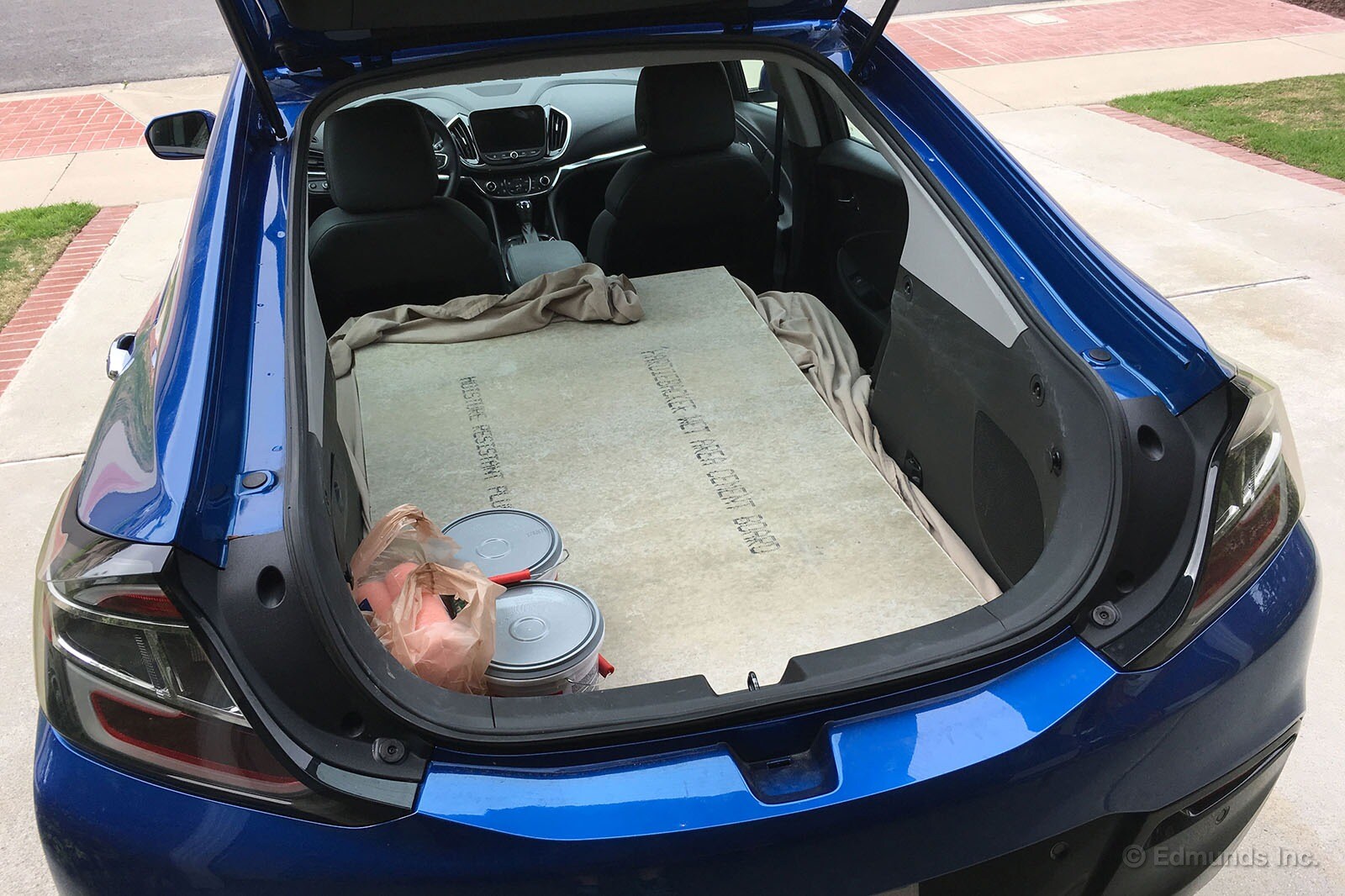
"Here's one for the 'What Was I Thinking?' file. I needed to pick up some practice mats for martial arts, specifically the thick tatami (woven straw) mats used in judo. Designed to cushion the body on impact, the mats are long, wide and not especially light. I underestimated just how long and wide when I figured the Volt could handle the job. It's a hatchback, I thought. We've loaded plenty of gear into it before. Well, the Volt handled the job, but it wasn't pretty. Those are six mats in the photo, each measuring 6.6 by 3.3 feet. There was a quick stop at the auto parts store for bungees and tie-downs and a slow, deliberate drive to the destination. Moral of the story: Don't bring a hybrid to a truck fight." — Dan Frio
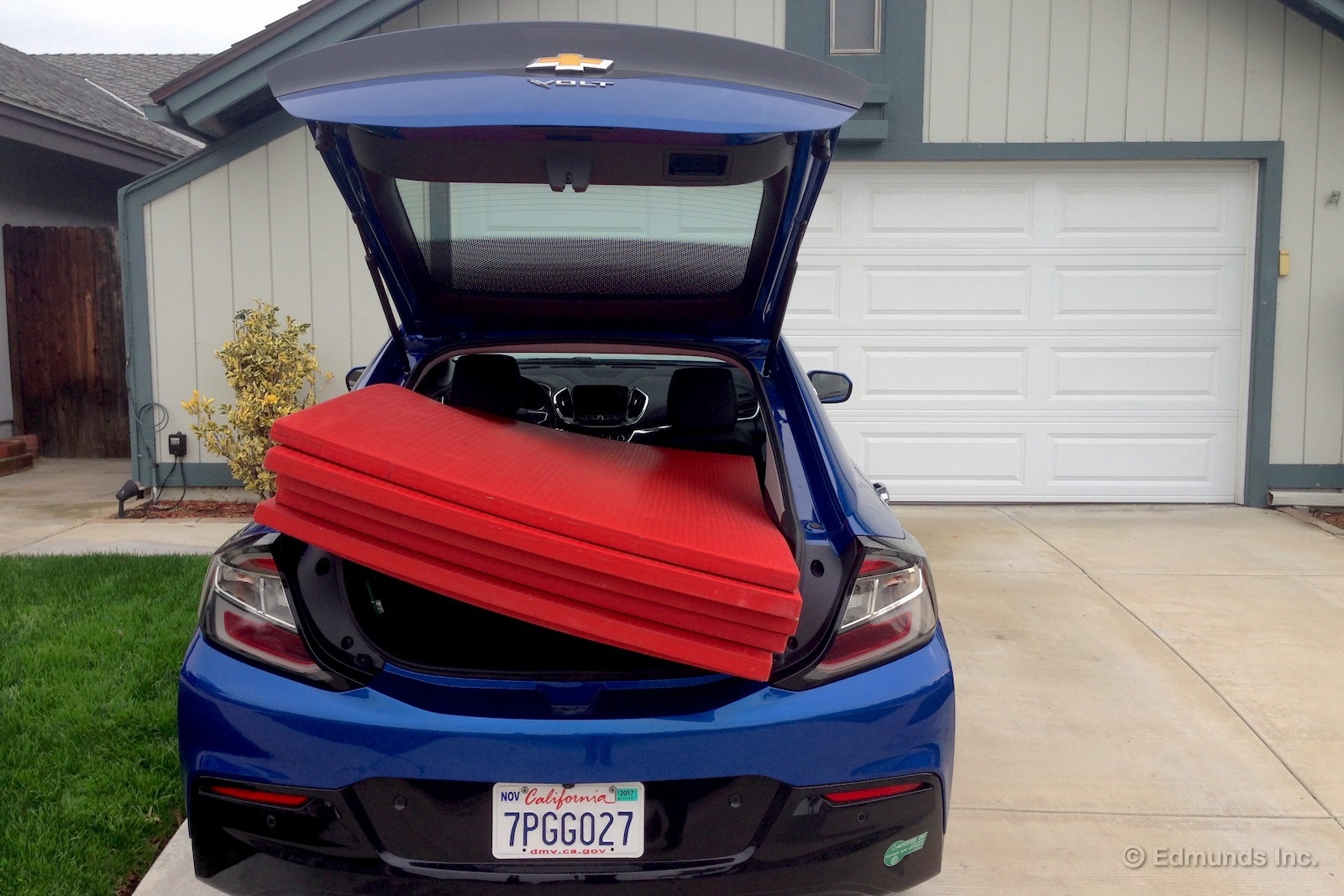
"I just loaded five 8-foot-long two-by-fours into the Volt. It was a piece of cake. I just leaned the front passenger seat all the way back and tucked them into the footwell. It worked better than any open-bed pickup truck would have on this rainy day." — Mike Schmidt
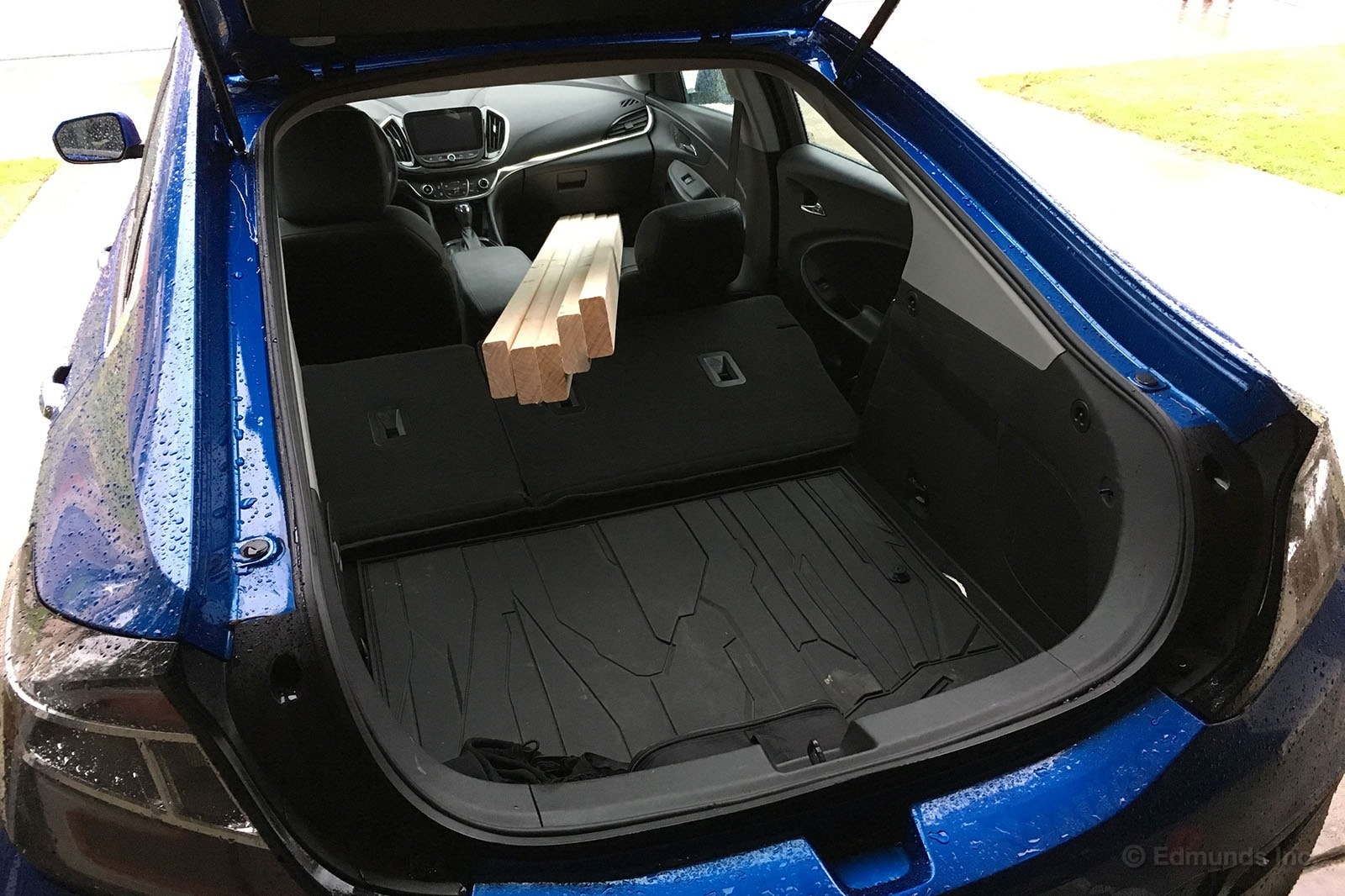

Interior
"The Volt has a big hatch/cargo area, but here's one place the car reveals its compact dimensions: rear-seat footwells. There's not enough room for the two grocery bags shown in the photo to fit lengthwise. And this is with the seat set for a 5-foot-6-inch driver. You might be able to jam them in there, at the risk of crushing your bread and bruisin' your peaches." — Dan Frio

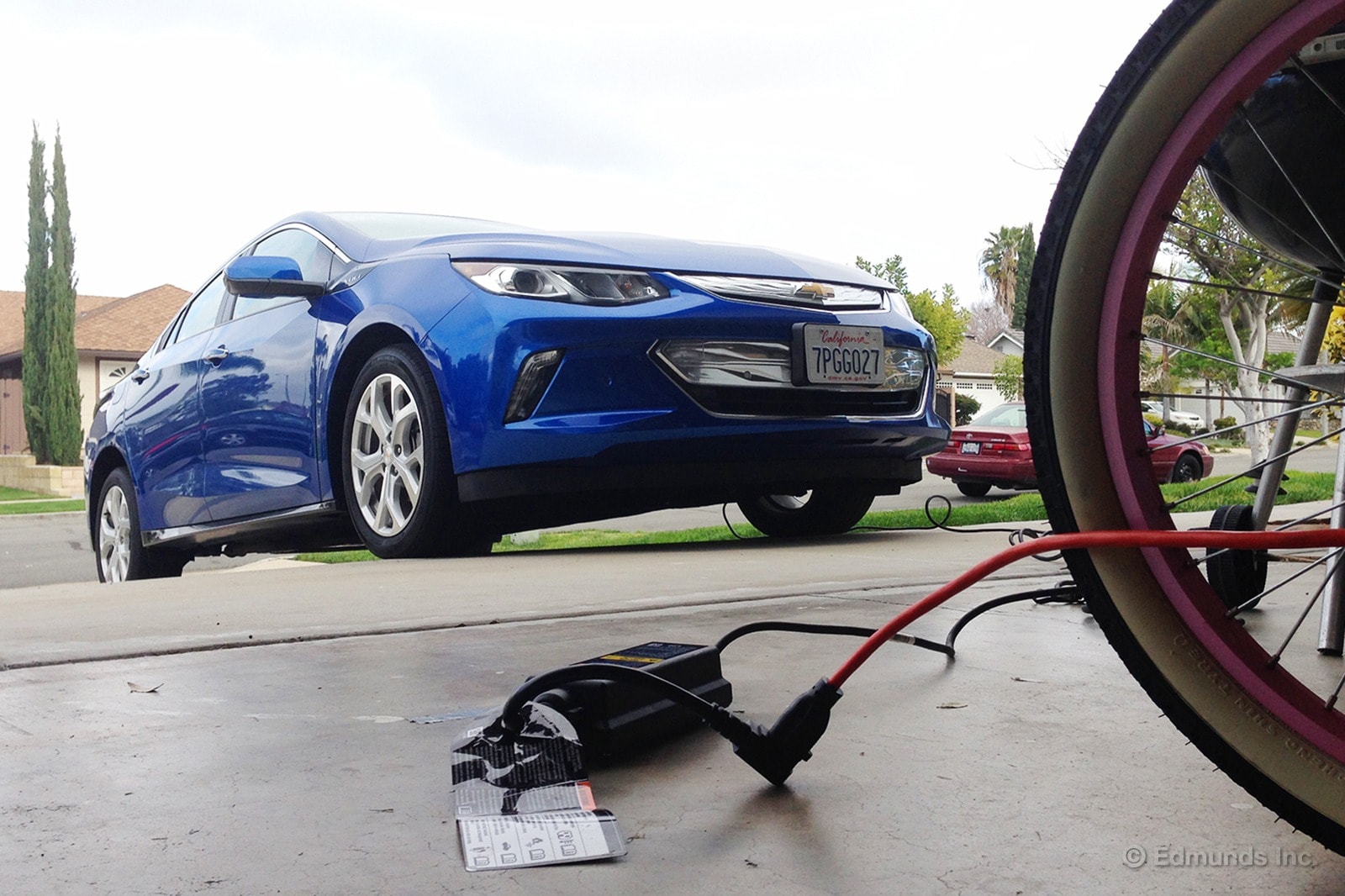
Monthly Update for March 2017
Where Did We Drive It?
We spent most of March driving our 2016 Chevrolet Volt on gasoline. Yet we still managed to set new lifetime marks in average mpg and average electric range. A routine visit to the dealer led to some surprises, in the form of three recalls and over four hours of our day.
What Kind of Fuel Economy Did It Get?
We drove the Volt a total of 1,069 miles in March. This registered as one of our lowest monthly totals. By contrast it was one of our higher electric-use months, with 398 miles, or 37 percent, of the total distance traveled on the juice. It was enough to inch our average gas mpg higher by one-tenth and average electric range by five-tenths of a mile. It certainly wasn't dramatic, but it still moved the needle.
Average lifetime gas mpg: 37.5
Best fill mpg: 45.1
EPA combined mpg rating: 42
Average electric range: 51.9 miles
Best electric range: 75 miles
EPA electric range rating: 53 miles
Current odometer: 22,857 miles
Maintenance and Upkeep
The Volt went to the dealer this month for routine service and a trio of recalls.
We showed up a few minutes early for our 8 a.m. appointment at DeLillo Chevrolet in Huntington Beach. An adviser greeted us immediately, processed the car and gave us an estimate of three hours to complete the work.

The oil change and tire rotation cost $45.70 and took about 30 minutes. Three recalls fell under warranty but took almost four hours themselves. Recall 16055 reflashed the drive-motor power inverter module; 39570 recalibrated the front view camera to keep it from freezing; and 16055 reflashed the hybrid computer (HPCM2) to remedy a reduced propulsion power error.
Logbook Highlights
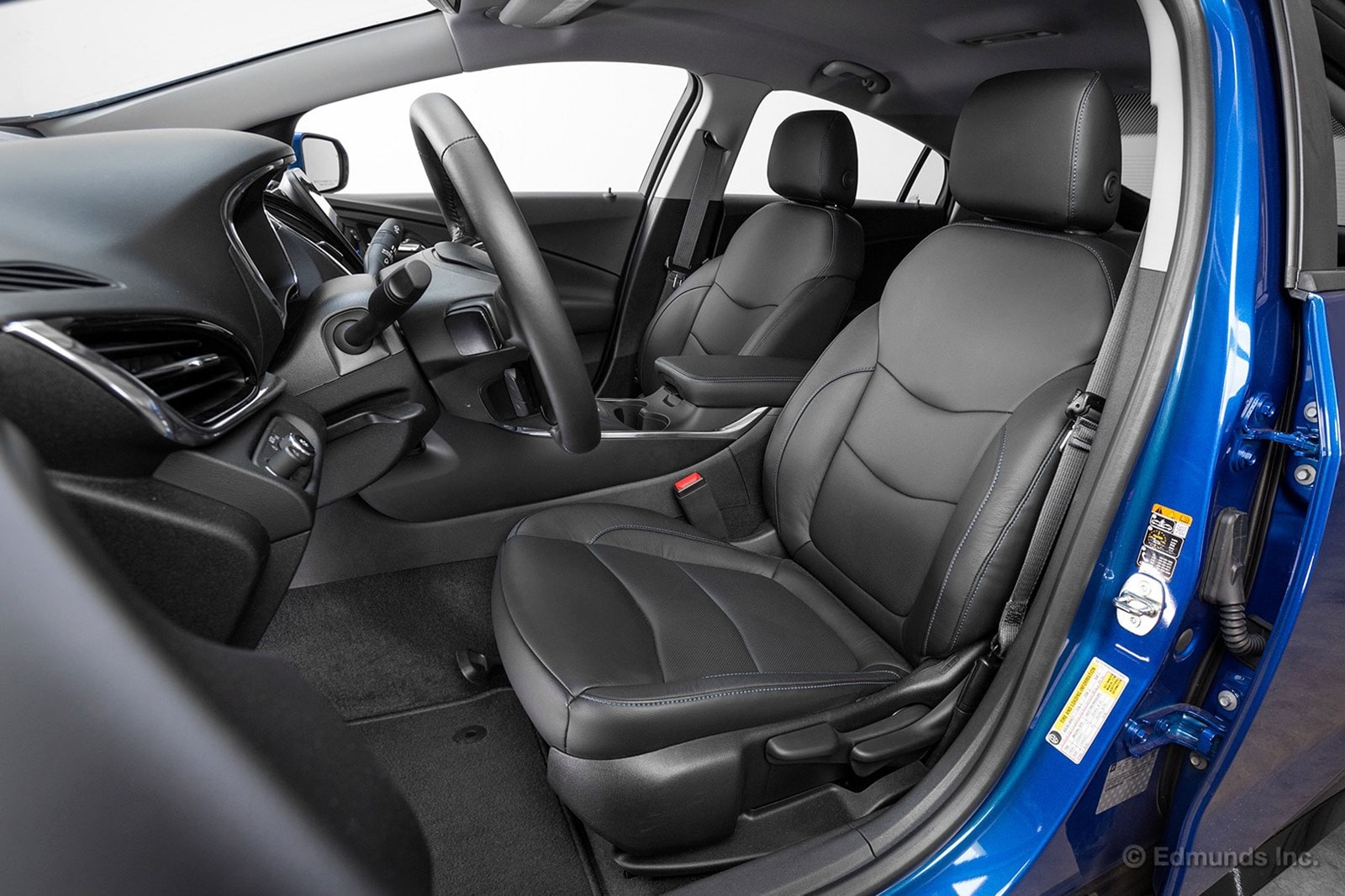
Comfort
"I'm very picky about seats. This is a big problem in most hybrids and electric cars because they tend to go with a more one-size-fits-all design to limit adjustability and, therefore, weight. Usually, this is terrible for me because I'm large. The Volt seats, though, are quite comfortable for me. My 5-foot-6 wife, on the other hand, complained about her comfort in the passenger seat." — Will Kaufman, Associate Automotive Editor
"I knocked the driver's seat of the Volt for its long-distance comfort before. So I gave it another chance. For the past five days it was my daily commuter. In my case that is at least an hour in each direction. I came to the same conclusion. But this time I discovered my breaking point: 45 minutes. The seat is just too flat and firm to go any longer without a break. I can't live with that." — Mike Schmidt, Senior Manager, Vehicle Testing

Interior
"Why, why, oh why, is there so much faux chrome (faume?) in the Volt's interior? I give this car a lot of credit for being comfortable (P.S. thank you, Chevy, for the extendable sun visors), but on my commute there were moments when the chrome surround of the bowtie on the steering wheel reflected the afternoon sun directly into my eyeballs. If this were my car, there'd be a piece of tape permanently affixed to the center of the steering wheel." — Will Kaufman
"I fully expected the Volt, with its funky almost a 2+2 seating position, to be a bear when it comes to installing a child seat. It's not. Though the LATCH anchors aren't the easiest to get to, the rear door opens nice and wide and the actual seat itself isn't too far back. ... There's a ton more front/rear space than I expected, and my front passenger had plenty of space. Sure, there's not a lot of headroom for you to lean down into and the seat bottom is angled slightly back, which may mis-angle some car seats … but that's easy to work around. Overall, this is a setup I, and most parents with infant seats, could live with every day. ... Now if only I could live with the rest of the car." — Mike Magrath, Content Strategist
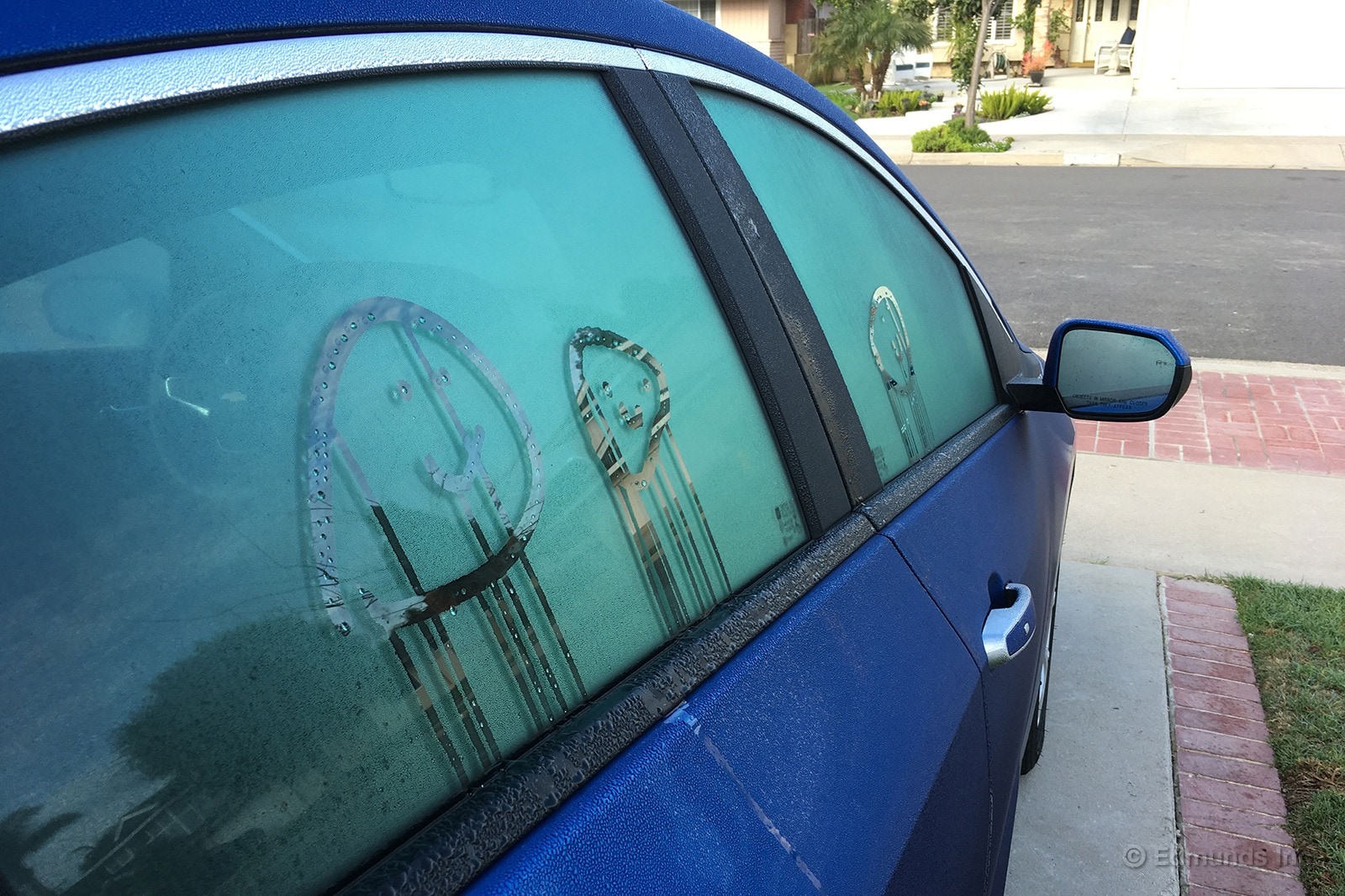
Monthly Update for April 2017
Where Did We Drive It?
We drove our 2016 Chevrolet Volt 2,305 miles in April. It was a busy month. The unfortunate result of accumulating so many miles was that almost all of our time was on the freeway. Such freeway-heavy driving was consequently less reflective of the city-dwelling habits of typical Volt owners.
The Chevy remained in the hands of our long-distance commuters all month. It is hard to turn down the lure of HOV-lane stickers when you live over 40 miles, or up to two hours, from the office. So we didn't. And that meant our Volt's eyes rarely looked up from the 405 freeway all month.
What Kind of Fuel Economy Did It Get?
We've said it before and will here again. Tracking fuel economy for a plug-in hybrid such as the Volt is not straightforward. We do our best to separate miles driven solely on battery power from those using the gasoline engine. It is a system easily sabotaged by simple oversights. A failure to record the switchover from electric to gas modes means a loss of useful data. Fill up with gas before the electric power is fully depleted, and there is another data gap. Other factors also come into play. Still here is what we've observed after 18 months.
Average lifetime gas mpg: 37.5
Best fill mpg: 45.1
EPA combined mpg rating: 42
Average electric range: 51.9 miles
Best electric range: 75 miles
EPA electric range rating: 53 miles
Current odometer: 24,133 miles
Maintenance and Upkeep
None.
Logbook Highlights
Performance
"After driving the Bolt EV for a weekend, I got used to using the steering wheel paddle to control the regenerative braking. When I got into the Volt recently, I remembered that it used the same system and immediately started using it. It works well, but it takes a little practice to consistently get the Volt to stop right where you want it. While inching through traffic, it works well for briefly slowing the car down, but if I knew I had to come to a stop I would just use the brake pedal. I also noticed that holding the paddle doesn't keep it stopped, so you have to eventually push the pedal if you're stopped for a few seconds. It's still a nice feature to have, however, so I'm glad it carried over to the Bolt EV." — Ed Hellwig, senior editor
"I really enjoy our Volt as a commuter. My drive is roughly 10 miles one way, but it can take 30 to 40 minutes as I navigate tight surface streets. I've spent most of the week in the car, charging when I reach the office, and I've yet to hear the engine start. Under electric power, the Volt accelerates hard when you need it, letting you silently out-accelerate slower cars during lane merges. You don't appreciate the quietness and absence of engine vibrations until you spend time with an EV. You don't have to try and cover the din of an economy car powertrain with loud music. It's relaxing." — Carlos Lago, senior writer
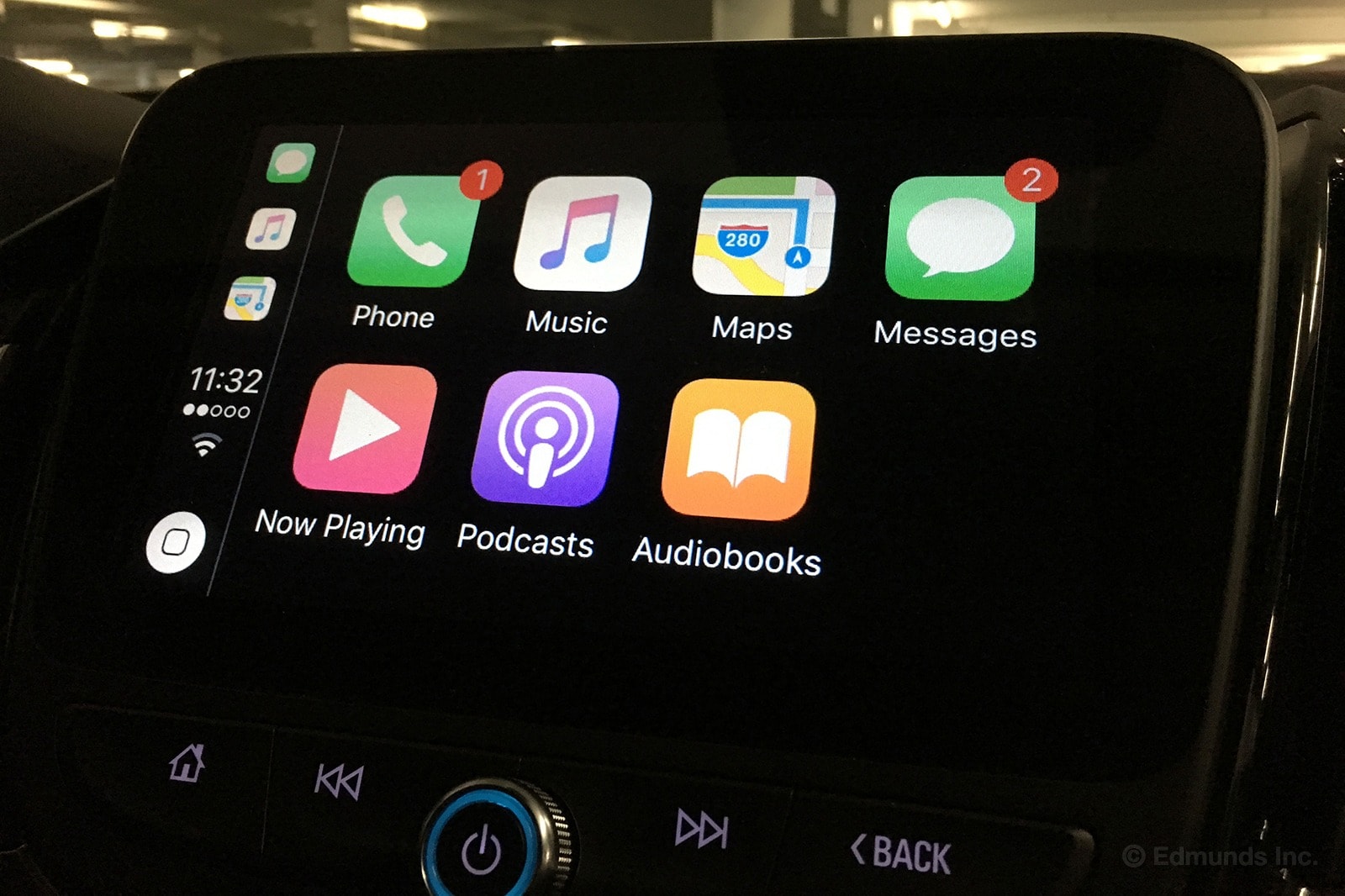
Technology-Audio
"Android Auto integration rocks. I can ignore Chevy's entertainment and nav system entirely, relying instead on Google Maps and my favorite podcasts." — Carlos Lago
Miscellaneous
"The only downside is the smell. When left in the sun for a few hours, the Volt's interior develops an off-putting and musty stink. Not sure if it's the seat material, plastics, or if something got spilled inside (didn't see anything when I checked), but the smell is disappointing, especially when you're trying to show off how much you like the car to a neighbor." — Carlos Lago
"Most importantly (and unlike the Bolt EV), the Volt doesn't look dorky." — Carlos Lago
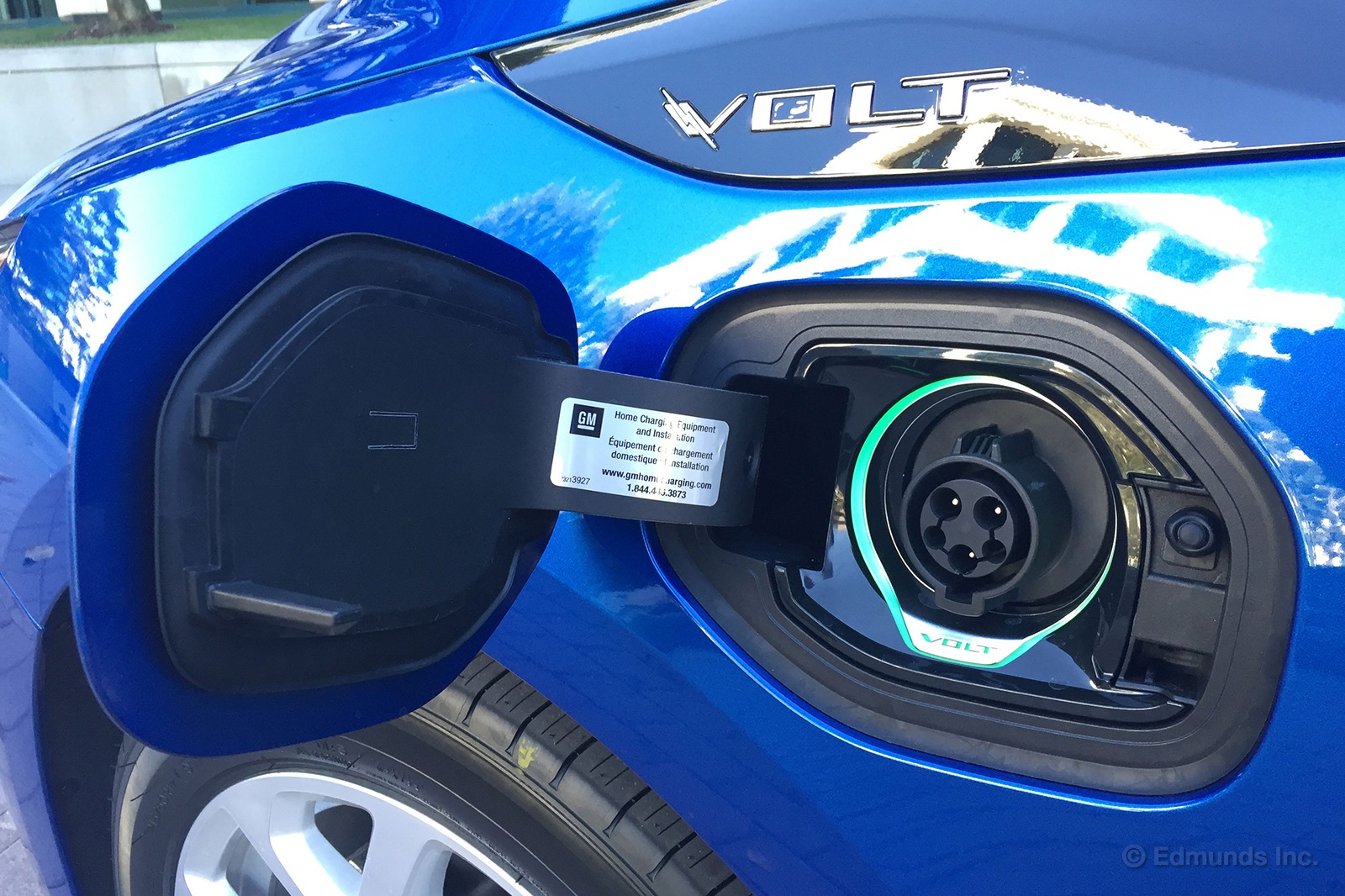
Monthly Update for May 2017
Where Did We Drive It?
Compared against its extraordinarily busy April, May was a return to the norm for our 2016 Chevrolet Volt. The Volt spent most of its time in April with our long-distance commuters, but the majority of the miles racked up in May were from editors close to our Santa Monica headquarters. As such, just under 800 miles were added to the Volt's odometer.
The entire month was largely drama-free, except for a flat tire incurred by Senior Writer Carlos Lago. On the bright side, this allowed Carlos to familiarize himself with a Pep Boys lobby for the better part of four hours.
What Kind of Fuel Economy Did It Get?
Tracking fuel economy for a plug-in hybrid such as the Volt is not exactly straightforward, and we do our best to separate miles driven solely on battery power from those using the gasoline engine. Still, simple oversights, such as failing to record the switchover point from battery power to gas or filling up the gas tank with battery in reserve, mean a loss of useful data. Other factors also come into play. That said, here are the fuel economy results we've observed over the last year and a half, with corrupted data omitted.
Average lifetime mpg: 37.6
Best fill mpg: 45.1
EPA combined mpg rating: 42
Average electric range: 51.9 miles
Best electric range: 75 miles
EPA electric range rating: 53 miles
Current odometer: 25,050 miles
Maintenance and Upkeep
A tire patch set us back $20.
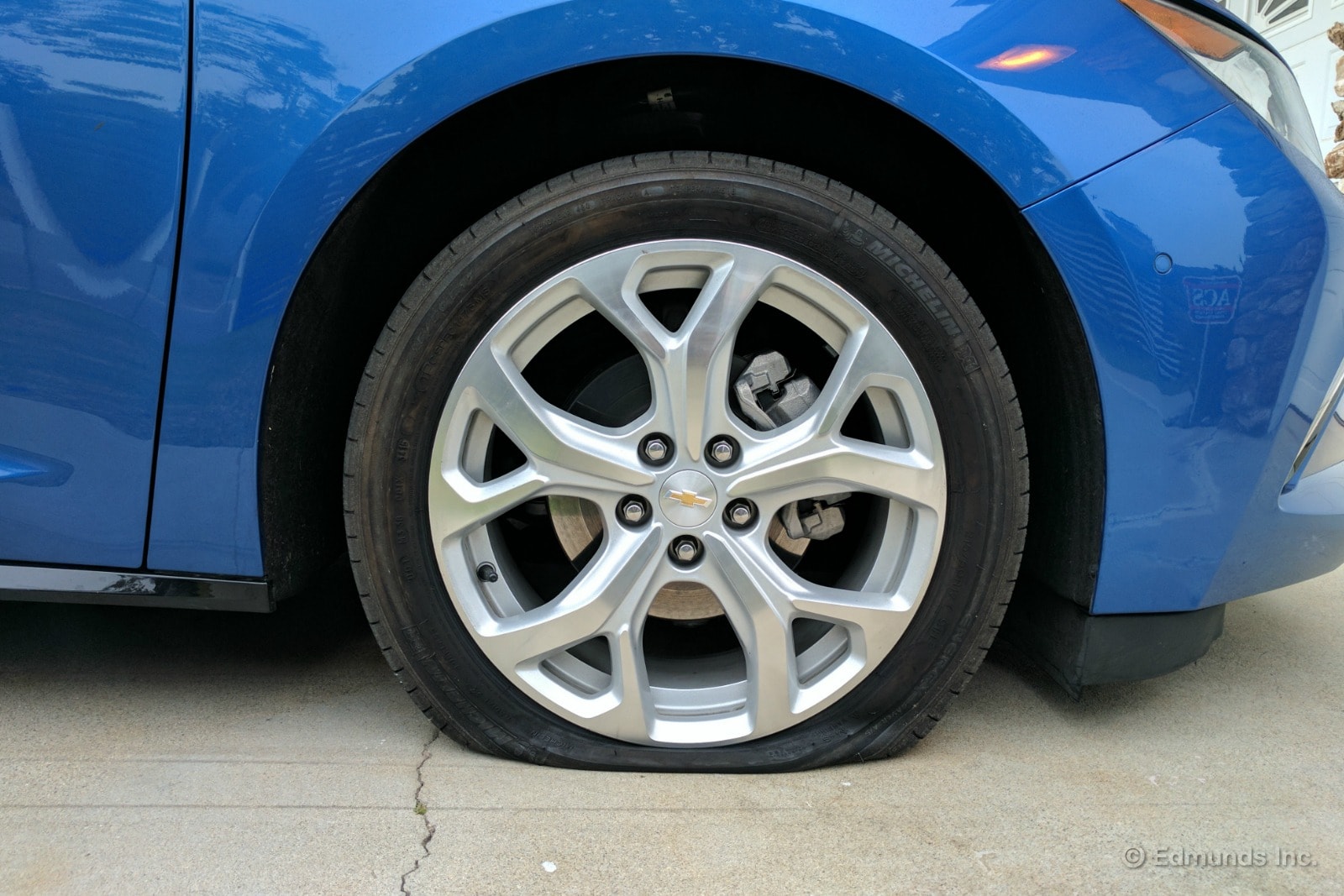
Logbook Highlights
Performance
"I swear I'm not trying to do a burnout in our Chevy Volt. Since it's my first time behind the wheel of this plug-in, I'm still getting used to its idiosyncrasies. But one thing I quickly learned was to not press the accelerator too excitedly from a dead stop lest I squeal the tires. I did this a couple times before I got the hang of it and felt so embarrassed." — Caroline Pardilla, copy editor
Cargo Space
"Hi, I'm Mike's back. Today he loaded two 50-pound bags of mortar into the Volt and nearly broke me. I want to blame him for not using his legs but it wasn't that. It's the design of the cargo area. For one, its load floor sits 8 inches below the lip where the hatch opens. So to rest a bag on the lip and slide it down would break the bag. For another, the inside of that lip is 11 inches from the back of the bumper. So no matter how he bent his knees they went into the bumper and he was forced to stretch me in a way I don't go. Now I need some rest." — coccyx of Mike Schmidt, senior manager, vehicle testing
Miscellaneous
"Since this was my first time taking the Volt for the weekend, I was given specific instructions on how to log when I fuel/charge it up. No big deal. The only real thing I was warned about was having to keep an eye on when the car switches over from EV to the engine; we use that number to calculate how far the Volt runs on battery-only power. Apparently the switchover is so subtle that you wouldn't notice when it happens. It turns out this is true.
"When I was coming back from a Mother's Day excursion, I saw that the Volt only had 9 miles left of its EV range. So in case I didn't notice that the switchover took place, I asked my passenger to keep an eye out for the moment it happened. Sure enough, there wasn't a shudder or an engine drone when the last EV mile clicked off. It was totally seamless." — Caroline Pardilla

"I was coming back from brunch one morning when my passenger noticed there was a mysterious pimple on the roof of the Volt. I found this odd, considering most car exteriors get dimples and dents from things thrown, bumped or dropped on them. For this pimple to happen it would have had to been caused from inside the car, right? But the interior headliner didn't indicate any sort of disturbance. I also noticed the groove running from front to rear on the Volt near the pimple seemed to be scuffed, just adding more to the mystery." — Caroline Pardilla
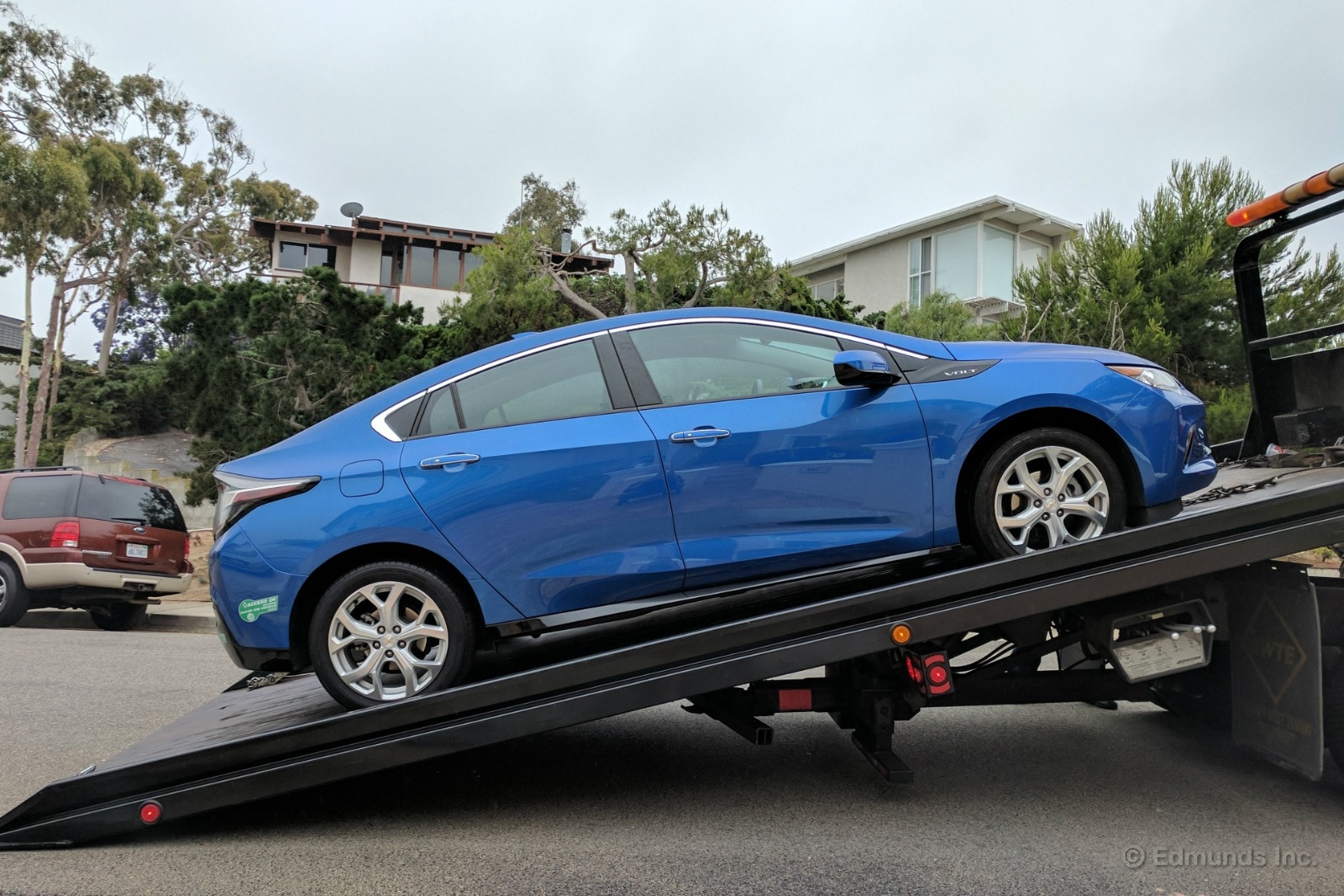
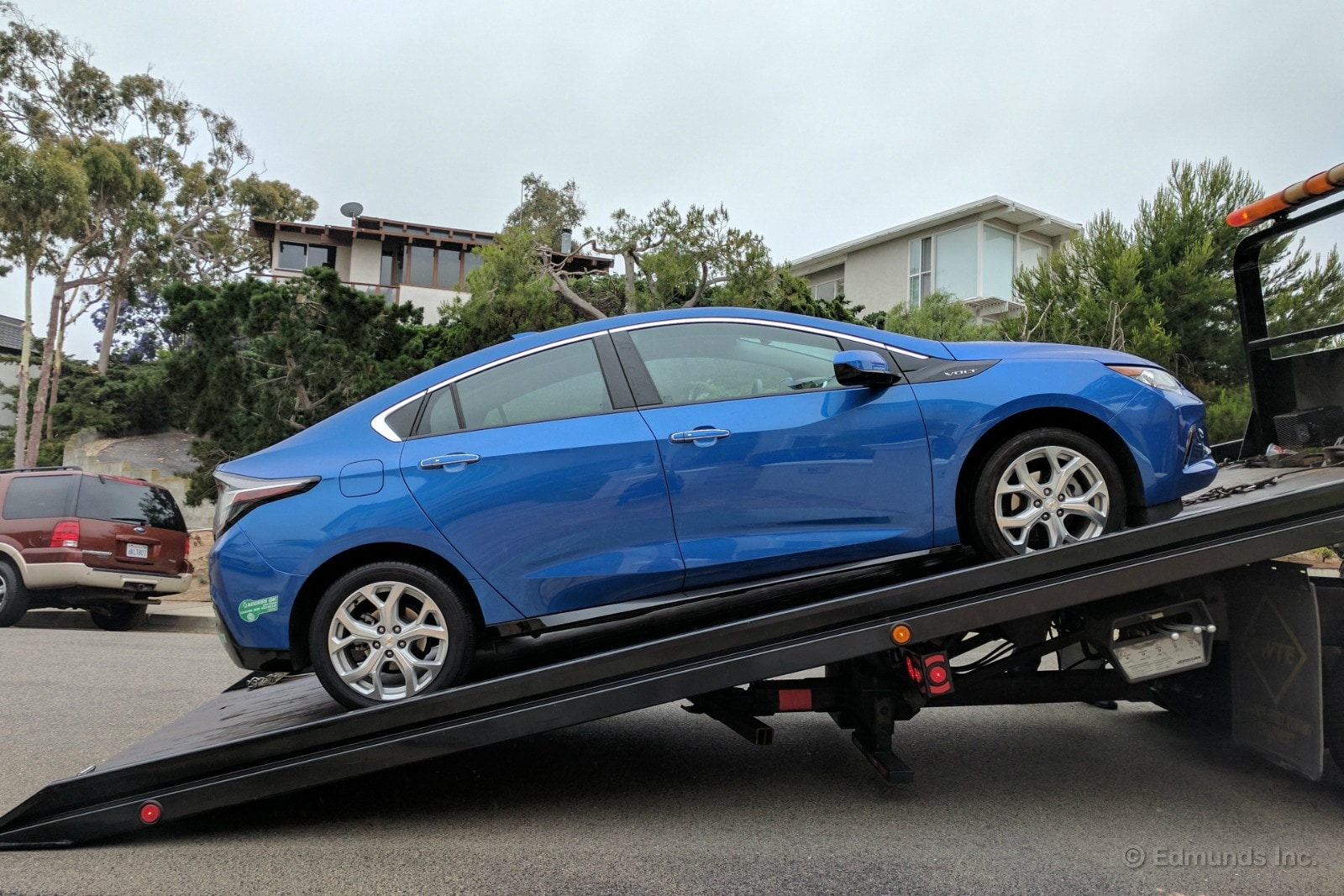
A flat tire may not top the official list of "Bad Ways to Start Your Morning," but it's certainly among the more frustrating. Alas, that's how my Wednesday started with our 2016 Chevrolet Volt.
The embarrassing thing is I didn't notice the severity of the flat until I was halfway down the driveway and heard the front airdam scrape. It never does that. Upon turning the wheel, I felt the telltale shudder. Cue palm to forehead.
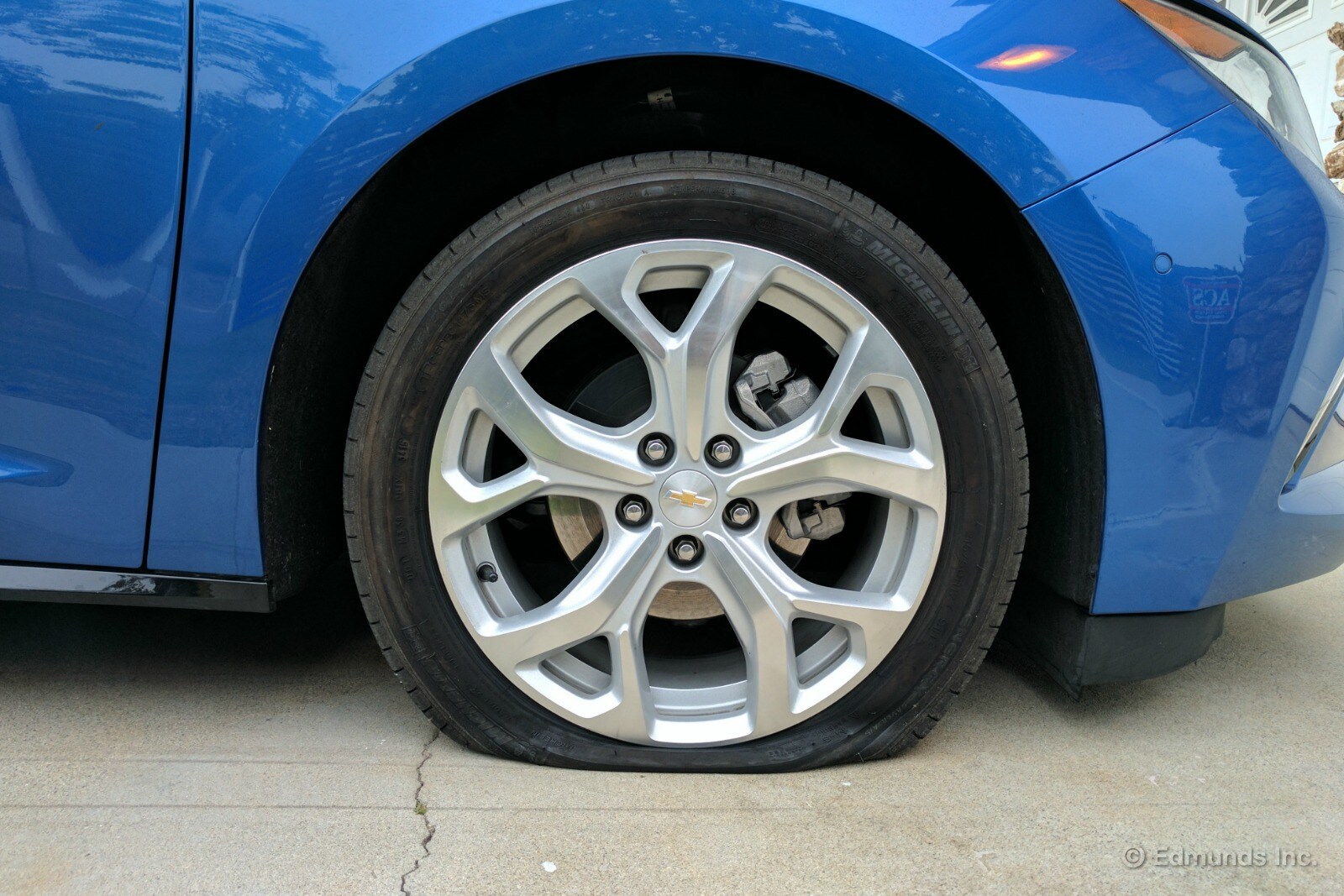
I drove back up the driveway and surveyed the damage. Fortunately the wheel rim didn't separate from the tire, so no need to worry about scarred aluminum. Alas the tire couldn't have been flatter unless it was two-dimensional.
The trunk offered few solutions for repair. Chevy Volts come with a small air compressor and tire sealant goo. Though the compressor was in the right spot, the goo was absent. Mike Schmidt got a flat tire in October last year, and we likely forgot to replace the goo. The dealer I called sells replacement containers (part number: 23119009) for around $50, but you can find it online for as low as $20. It's even on Amazon.com, so rejoice, Prime members.
None of this helped my situation. I had AAA tow the Volt to a nearby Pep Boys. And let me tell you: When you're sitting in the cab of a tow truck plodding along through traffic to a Pep Boys, the benefits of a compact spare take far greater significance over the added trunk space and ever slight increases in fuel economy that a small air compressor and a can of goo provide. If the Volt had a compact spare, I'd have infinitely more flexibility in repairing the flat.
Of course, the soonest Pep Boys could take a look at the car was noon, and of course, the Volt was already off the flatbed. And once again: When you're faced with the prospect of sitting in a Pep Boys waiting room for four hours, the benefits of a compact spare tire outweigh pretty much everything else.
What was the damage after all this? A small, pluggable hole that they fixed for $20, and another reminder that spare tires are wonderful things.
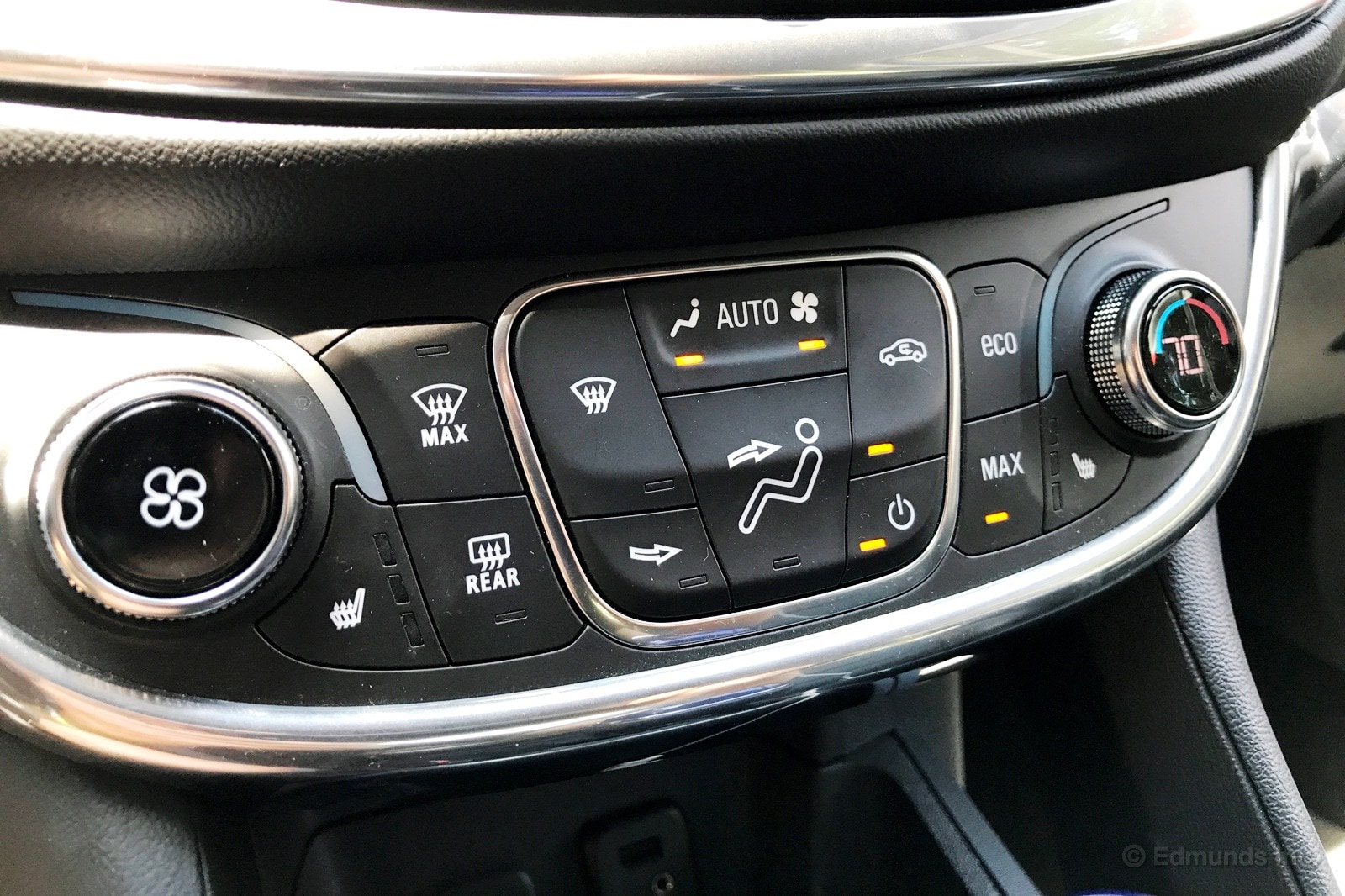
Where Did We Drive It?
Our 2016 Chevrolet Volt didn't see much action in June as we only logged about 700 miles. Those miles came from run-of-the mill around-town driving even though the Volt is certainly capable of longer trips.
Still, our carpool lane-eligible plug-in continues to impress. Even with the modest miles added to the Volt, we were able to form more opinions about the Volt thanks to some all-gas driving and test the A/C system in our hot summertime Southern California weather.
What Kind of Fuel Economy Did It Get?
Our Volt's lifetime fuel economy increased one-tenth of a mile per gallon compared to May, while our average best range dipped a more significant half-mile in the same time frame.
The best fill mpg and best electric range remain unchanged.
Average lifetime mpg: 37.7
Best fill mpg: 45.1
EPA combined mpg rating: 42
Average electric range: 51.9 miles
Best electric range: 75 miles
EPA electric range rating: 53 miles
Current odometer: 25,730 miles
Maintenance and Upkeep
None.
Logbook Highlights
Performance
"This week marked my first non-EV experience in the Volt. The only noteworthy thing about the experience was how uneventful it was. You hear a little thrum from the engine and maybe a small vibration, but otherwise the Volt behaves almost exactly like it does in EV mode. Pretty remarkable stuff, especially compared to the noisy range-extender engine in the BMW i3." — Carlos Lagos, senior writer
"I ran out of charge after 55 miles of driving the Volt. Since I live in an apartment, I can't charge. So I drove around the remainder of the weekend on the Volt's 101-horsepower gas engine and was very impressed. It did a nice job of preserving an EV-like feel and had enough power to climb hills and reach highway speeds. It is much quieter than the previous generation, which would rev at seemingly random points. Now the engine sounds more in line with what the car is trying to do." — Ron Montoya, senior consumer advice editor
Interior
"Jump into the Volt on a hot day and you'll have to hit the Max A/C button to cool the cabin. Otherwise, the normal mode will take too long. Once the interior is cooled down to your temperature of choice, the Eco mode does a nice job of maintaining the temperature and you probably won't feel like you're making a huge sacrifice in the name of fuel economy." — Ron Montoya


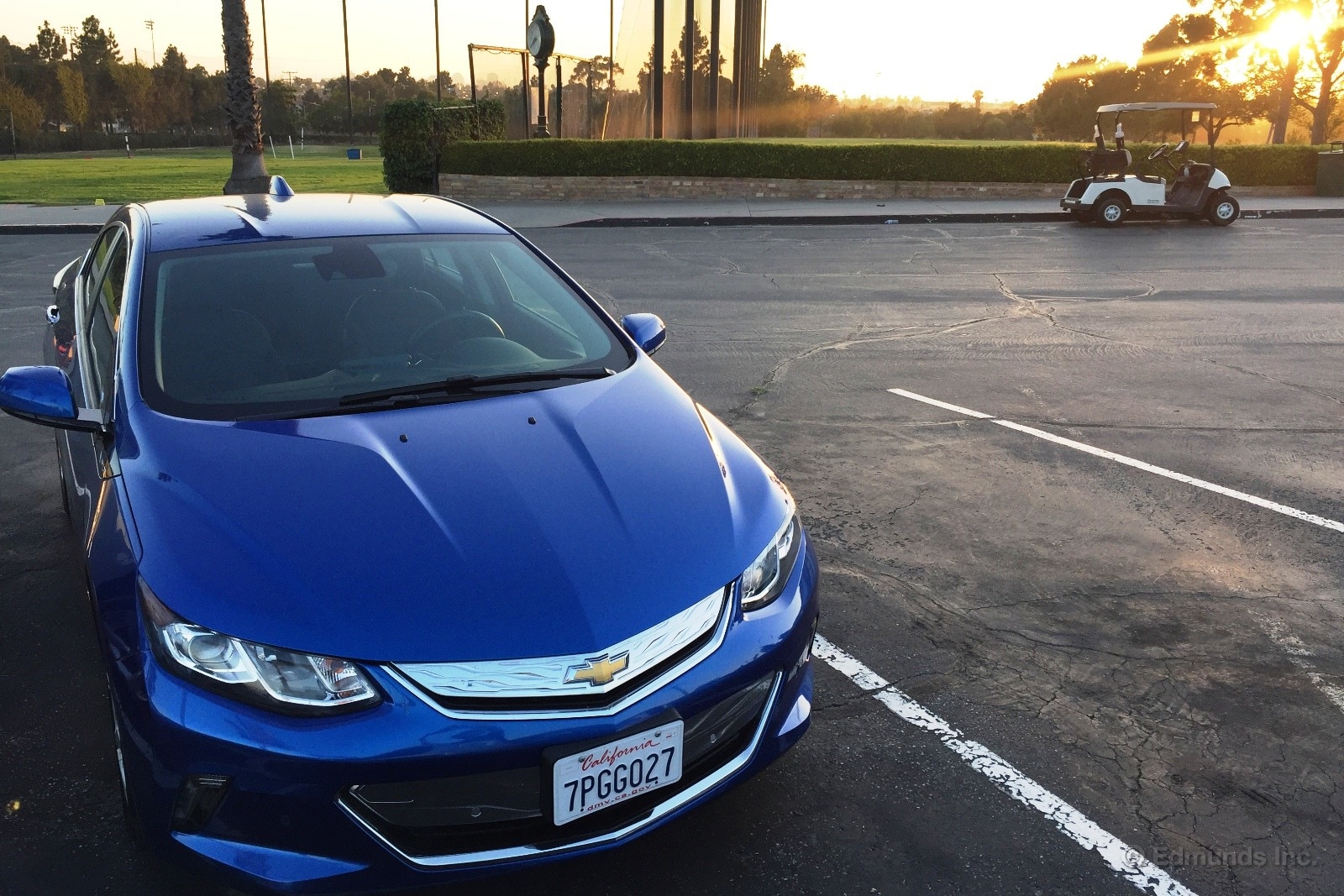
Where Did We Drive It?
It's been over a year and a half since we bought our long-term 2016 Chevrolet Volt, well over our usual yearlong testing period. This mpg-friendly and, crucially, carpool-qualifying economy car has proved an excellent daily driver, serving faithfully as a commuter, errand runner, grocery getter, what have you.
Even so, it's been spending more and more time parked at our office at night. I default to it when I can since it suits my stop-and-go commute in city traffic perfectly. I often get home having only used a few miles of electric range. Outside of commuting duties, editor Josh Sadlier took it golfing, which looked neat.
What Kind of Fuel Economy Did It Get?
Fuel economy didn't change much this month as the Volt put on less than 1,000 miles. Lifetime engine-on fuel economy stayed at the 37.7 mpg average from last month. While we almost had a new best all-electric range at 69.4 miles, it was shy of the Volt's 75-mile best.
Average lifetime mpg: 37.7
EPA mpg rating: 42 combined
Average electric range: 51.4
Best electric range: 75 miles
EPA electric range rating: 53 miles
Current odometer: 26,413 miles
Maintenance and Upkeep
None.
Logbook Highlights
Performance
"Chevy deserves particular praise for the Volt's nearly seamless transition from EV to hybrid operation. The seat of my pants says acceleration is about the same — i.e., very good, with willing torque always on tap — and while you can hear the gasoline engine revving up, it's never intrusive. With the BMW i3 range-extender model, for example, performance and refinement suffer mightily once the gas engine kicks in. Not so with the Volt. As an owner, I'd happily drive it every day in hybrid mode if I had to." — Josh Sadlier, senior manager, content strategy
Miscellaneous
"I continue to recommend the Volt widely to people who ask me for shopping advice. It's a legit EV with 60-plus miles of electric range, it's an equally legit hybrid once the battery runs down, it's admirably refined on the road, and its compact size makes it a cinch to park. I still wish it looked cooler, and I could do without the ginormous gold bow-tie badges (seriously, I wonder if Chevy's lost some sales because of that dorky emblem). But from an engineering and driving perspective, this car is a home run. Deserves so much more attention than it gets." — Josh Sadlier
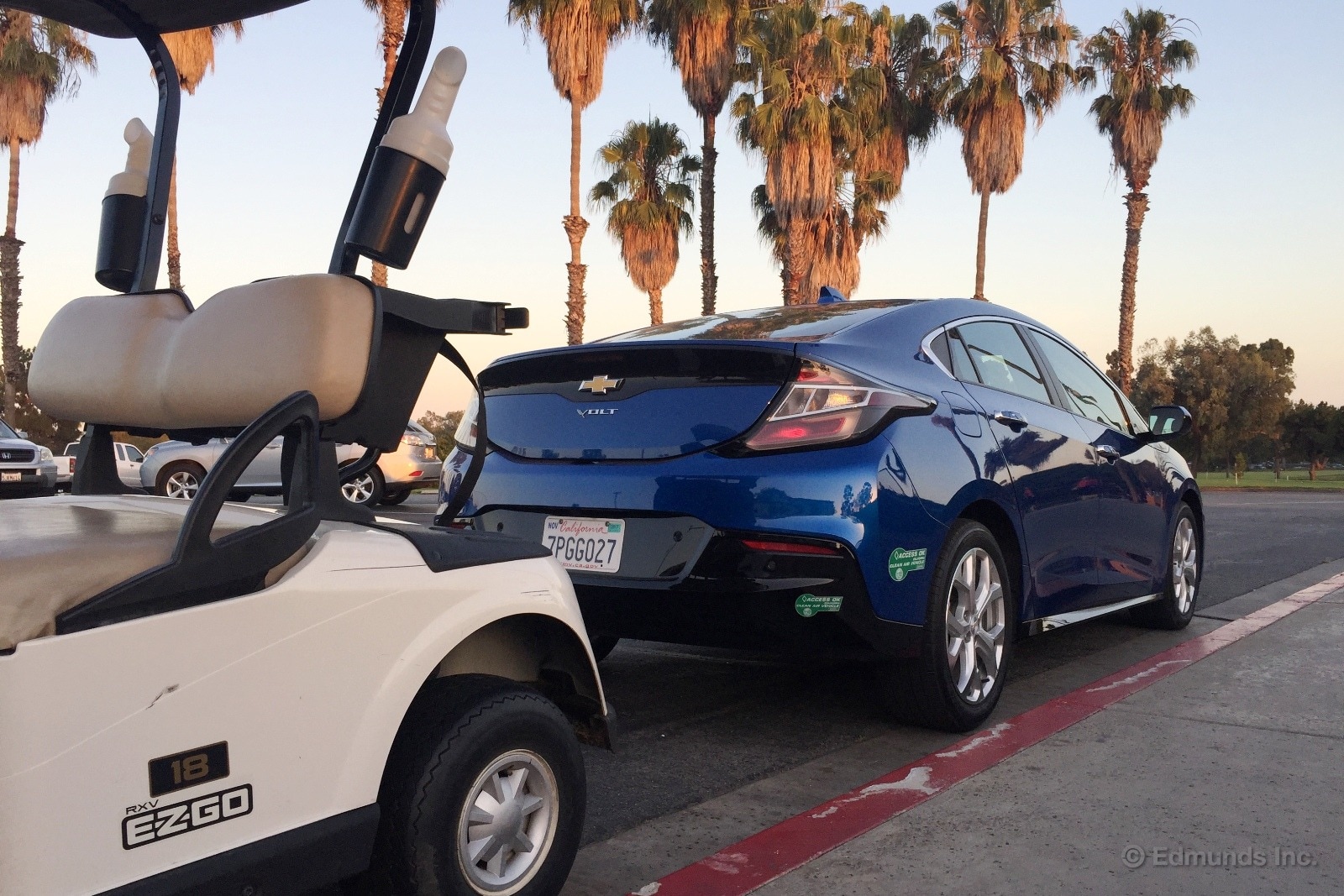
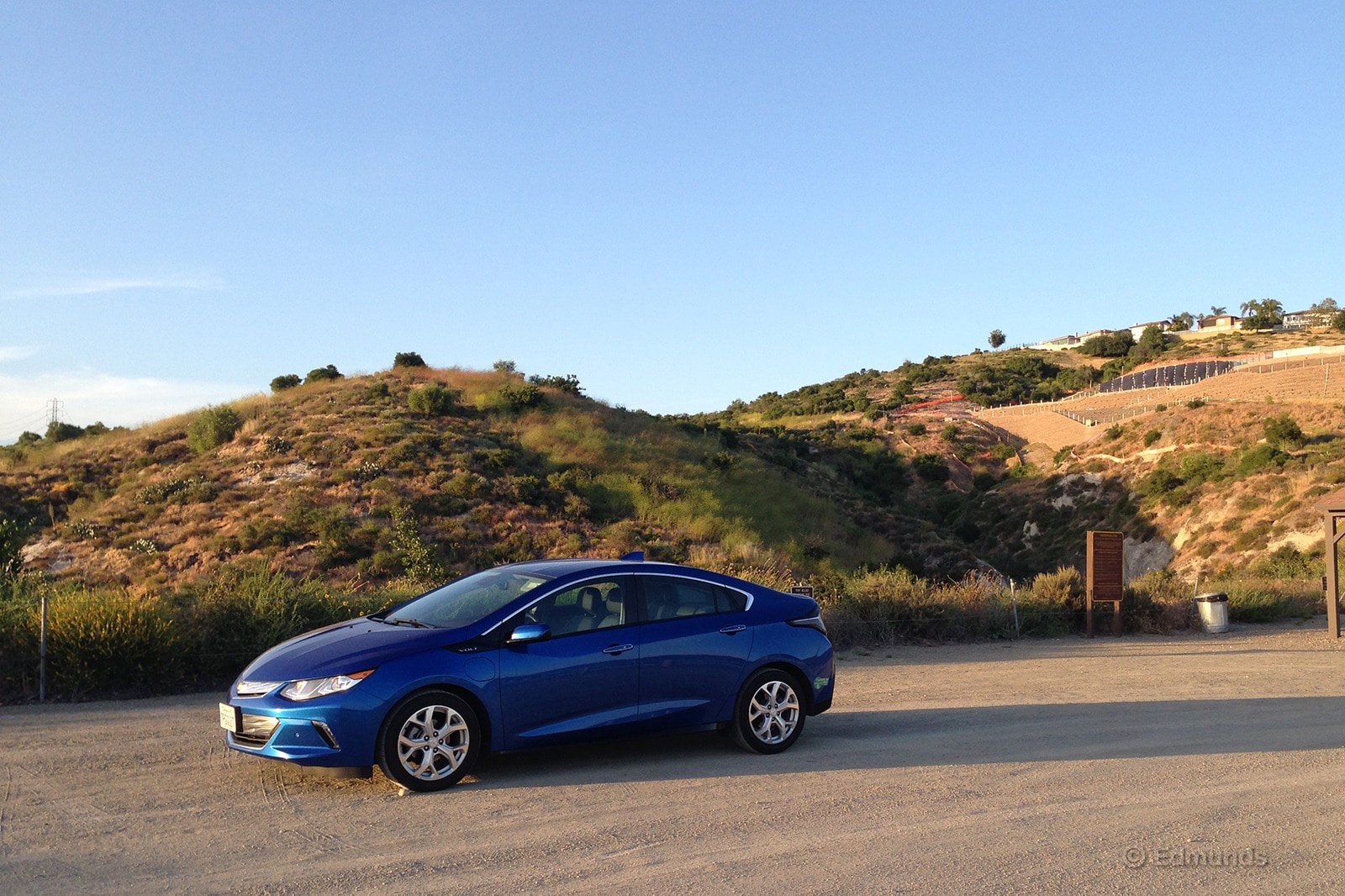
Where Did We Drive It?
Our 2016 Chevrolet Volt has been in our fleet for what seems like forever (our fuel book indicates that the beginning of "forever" is November 2015), but we still manage to add a respectable number of miles to our elder statesman's odometer each month. As usual, our plug-in hybrid was used primarily for around-town duties, whether it was solo commuting in the carpool lane or, in my case, traveling at normal highway speeds on Interstate 10 through downtown L.A. (traffic is totally clear at 10 p.m.). Without any long-distance trips, the Volt traveled just over 800 miles in August.
What Kind of Fuel Economy Did It Get?
Of the 816 miles driven, 211.1 miles were driven on electric power alone. We didn't set any records in terms of electric range, but I noticed my sustained highway-speed EV travel produced an all-electric range of 46.3 miles, compared to the EPA's estimated 53 miles. I wasn't surprised; with no traffic, I couldn't use the regenerative brakes to recharge the battery and extend the EV range. Our monthly gas-only fuel economy averaged out to about 40 mpg, good enough to increase the Volt's overall gas-only economy from 37.7 to 37.8 mpg.
Average lifetime mpg: 37.8
EPA mpg rating: 42 combined
Average electric range: 51.4 miles
Best electric range: 75 miles
EPA electric range rating: 53 miles
Current odometer: 27,600 miles
Maintenance and Upkeep
None.
Logbook Highlights
Performance
"I wish the Volt's brakes were a bit more robust. Compared to the accelerator pedal (which you barely have to press when driving under battery power, the electric thrust is so readily available), the brake pedal requires a fair shove to slow the Volt. On more than one occasion, I had to slam the brakes to get it to stop where I wanted." — Abigail Bassett, senior director, video & social media
"I drive the Volt in D (rather than L) because I have a long (all of 17 miles), mostly highway commute from where I live to the office. L is great when you are tooling around town and want to utilize the regenerative braking paddle on the steering wheel, but when coming from a standard dinosaur-burning vehicle, using a paddle to stop takes some getting used to. For now, I'll stick to using my foot rather than my fingers." — Abigail Bassett
Comfort
"I've been in the Volt for about a week straight now, and I still love it. I have, however, found something to complain about. When the gasoline engine kicks on, I can feel some faint vibrations in the seat and floor, and I wish Chevy had worked harder to edit all of those vibrations out. After all, the engine comes on quite frequently in non-EV operation, and that's how I've been driving it for a number of days. (The charger at work has been in high demand due to the number of short-term EVs we've evaluated recently.) As a Volt buyer, I would gladly pay a little extra for some more advanced motor mounts to keep those vibes completely out of my space." — Josh Sadlier, senior manager, content strategy
Miscellaneous
"The Volt is a good commuter car, but what is up with the rear hatch? This thing is so long and heavy that, once opened, it's pretty darn hard to close it. It swings way too far upward, to the point where I actually reached my body's stretch limit trying to get the handle. Short people will clearly have a difficult time reaching the hatch when it's open. A power-closing feature is necessary here." — Sal Meda, imagery production specialist
Monthly Update for September 2017
Where Did We Drive It?
This is the last update for our 2016 Chevrolet Volt. Though we normally like to retire a vehicle quickly to make room for the next long-termer, our Volt saw one last month of driving.
What Kind of Fuel Economy Did It Get?
Our last full month of use involved 1,390 miles of city and highway driving, with more than 300 miles of those in electric mode. Seemingly as a testament to its range-anxiety nullifying capability, we started September off with a full tank of fuel and only purchased 23.7 gallons of California's finest 87-octane to fuel the remaining miles. But the most noteworthy aspect is that there's really nothing to report. Aside from routine service and an errant flat tire, our Volt has trucked on with no complaints.
Average lifetime mpg: 37.3 mpg
EPA mpg rating: 42 mpg combined
Average electric range: 51.6 miles
Best electric range: 75 miles
EPA electric range rating: 53 miles
Current odometer: 28,990 miles
Maintenance and Upkeep
None.
Logbook Highlights
Cargo Space
"A reader commented that he wouldn't want to stack heavy items such as 50-pound bags of concrete inside the cargo area, but the area is well-supported underneath, so that whatever weight is placed is surprisingly well-distributed. It doesn’t hurt that we also have a rubber cargo mat." — Calvin Kim, road test editor
Performance
"While crunching fuel numbers for this log, I noticed there were a few switchover points (the point when it stops being an electric car and starts being a hybrid) left unrecorded. Speaking to some of the drivers, it seems as if some drivers are expecting the switchover and are ready to log the information, while others just drive and completely forget about it. This speaks to how smooth the switchovers can be, in particular if they occur at slower speeds." — Calvin Kim
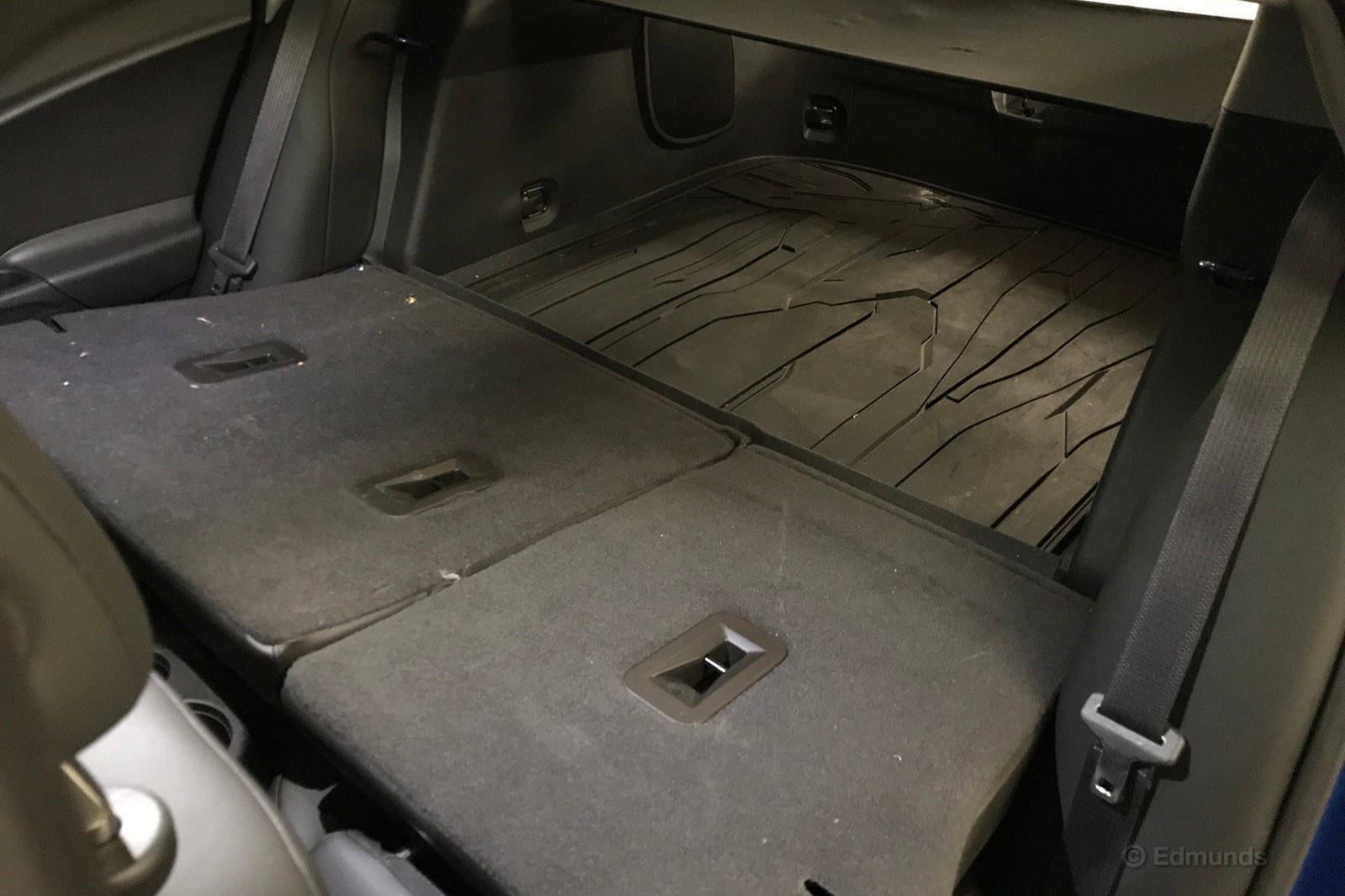
Comfort
"While I think a bench rear seat would've made the Volt perfect, I understand the compromise needed for range. Having said that, I found I drove our Volt with the rear seats down, turning it into a mini-truck. Sweet." — Calvin Kim
Wrap-Up
What We Got
At the time of its release, the 2016 Chevrolet Volt was the champion of plug-in hybrids. It was in its second generation, and it not only had more electric range than its competitors but also a reasonably gutsy engine to lean on when the juice ran out. Our experience with a long-term 2011 Volt further influenced our decision to buy one.
The new Volt represented a step above the first-gen car in every way. The 18.4-kWh battery pack allowed for more range, and the 1.5-liter engine generated 17 horsepower more than the outgoing four-cylinder while improving efficiency to 42 mpg.
The 2016 Volt was available in two trim levels. We passed on the LT and opted for the top-level Premier, which gave us a lot of standard equipment: a backup camera, an 8-inch touchscreen, keyless entry, automatic climate control, leather upholstery, heated seats and a Bose audio system.
The Premier trim also unlocked additional options. We selected the Driver Confidence 1 package, with blind-spot, lane departure and cross-traffic alerts and the Driver Confidence 2 package, with lane keeping assist, low-speed auto-braking, auto high beams and forward collision warning. We also added navigation, Kinetic Blue paint, an illuminated charge port, a cargo mat and a cargo net.
We wrote a check for $38,114 and the 2016 Chevrolet Volt Premier was ours. Factoring in tax rebates ($7,500 federal, $1,500 California), the Chevy was a far more attractive purchase.
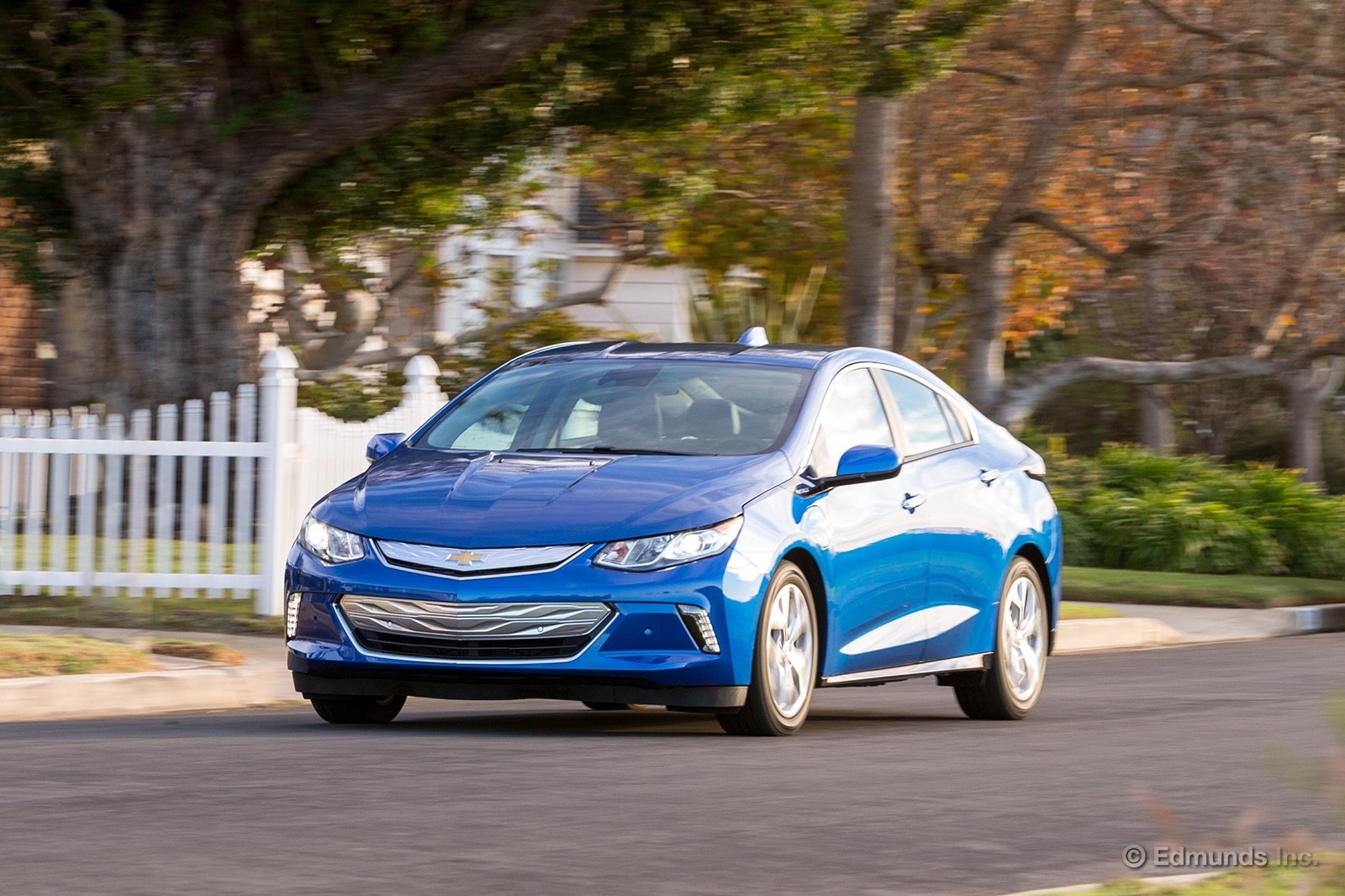
Performance
"I decided I'd just climb the mountain grade using the Volt's Normal driving mode and see what happened. Short answer: nothing out of the ordinary. The Volt's gasoline engine fired up unobtrusively and kept the Volt powering up the grade at 70 mph, just like a typical car. There was no real engine racket or lack of oomph. 'Did it without breaking a sweat,' you might say." — Brent Romans, senior editor
"In electric-only mode, accelerator response is immediate with a nice amount of torque right off the line. Acceleration is strong until about 30 mph, then begins to drop off pretty significantly. In this mode, the Volt is quicker to 30 mph compared to running on the gas engine." — Jonathan Elfalan, road test manager
MPG
"The benefits to a quick charging time aren't limited to reducing the impact on your personal schedule. While there are public charging stations out there that cost nothing to use, many charge per kilowatt-hour of energy transferred or per hour that the vehicle is plugged in. If you're using a station with per-hour pricing, the higher-capacity onboard chargers mean you'll pay less to charge it." — Cameron Rogers, staff writer
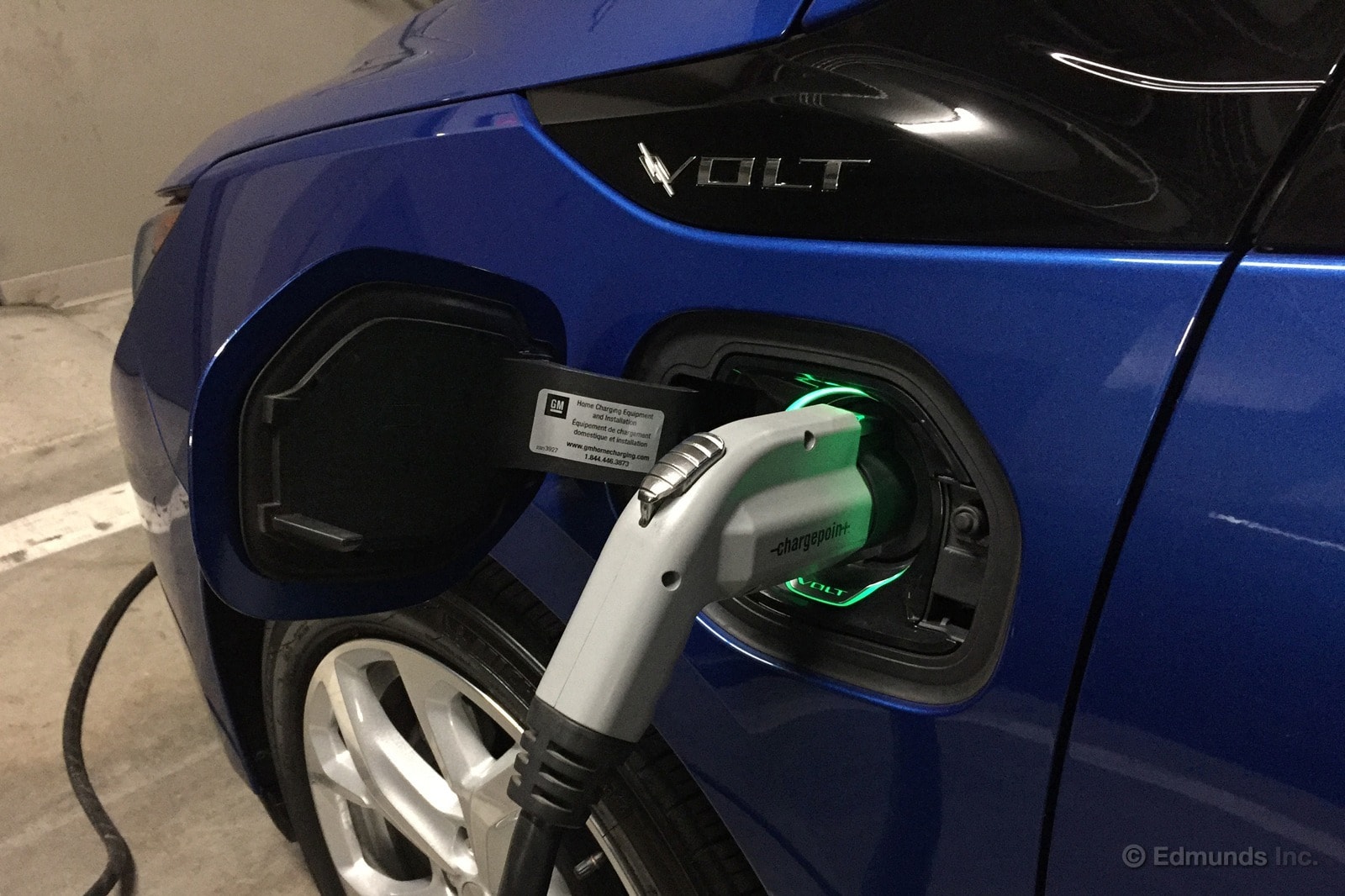
"The Volt hovered at '1 mile remaining' for about 3 miles, then the range ran out at 74.8 miles. This on a car rated at 53 miles of electric range." — Mike Magrath, features editor
Comfort
"The Volt is decently comfortable (in the back seats). Adults up to 6 feet tall should be OK. There's more legroom than I would have thought, and an elevated seating position provides some useful thigh support. There's also suitable padding on both the door and center armrests.
"A more questionable aspect, however, is headroom. The angle of the rear seatbacks places the occupants' heads directly below the rear hatchback window. This is both good and bad. It's good because it provides a couple extra inches of headroom that wouldn't be available if your head were right underneath the headliner (which is lower). It's bad because (Captain Obvious here) your head is right below the hatchback glass." — Brent Romans
"Then there is the driver's seat itself. The bottom is flat and the contours of its back arch in the opposite direction of the contours of my back. I tilt the seatback a couple of notches to compensate for the excessive padding against my shoulder blades with some success. And surprisingly, I am able to last a good two hours before my lower reaches grow tired. I'm not sure whether to credit the Volt or my own stubbornness for this." — Mike Schmidt, senior manager, vehicle testing operations
Cargo Space
"A reader commented that he wouldn't want to stack heavy items such as 50-pound bags of concrete inside the cargo area, but the area is well-supported underneath, so that whatever weight is placed there is surprisingly well-distributed. It doesn't hurt that we also have a rubber cargo mat." — Calvin Kim, road test editor
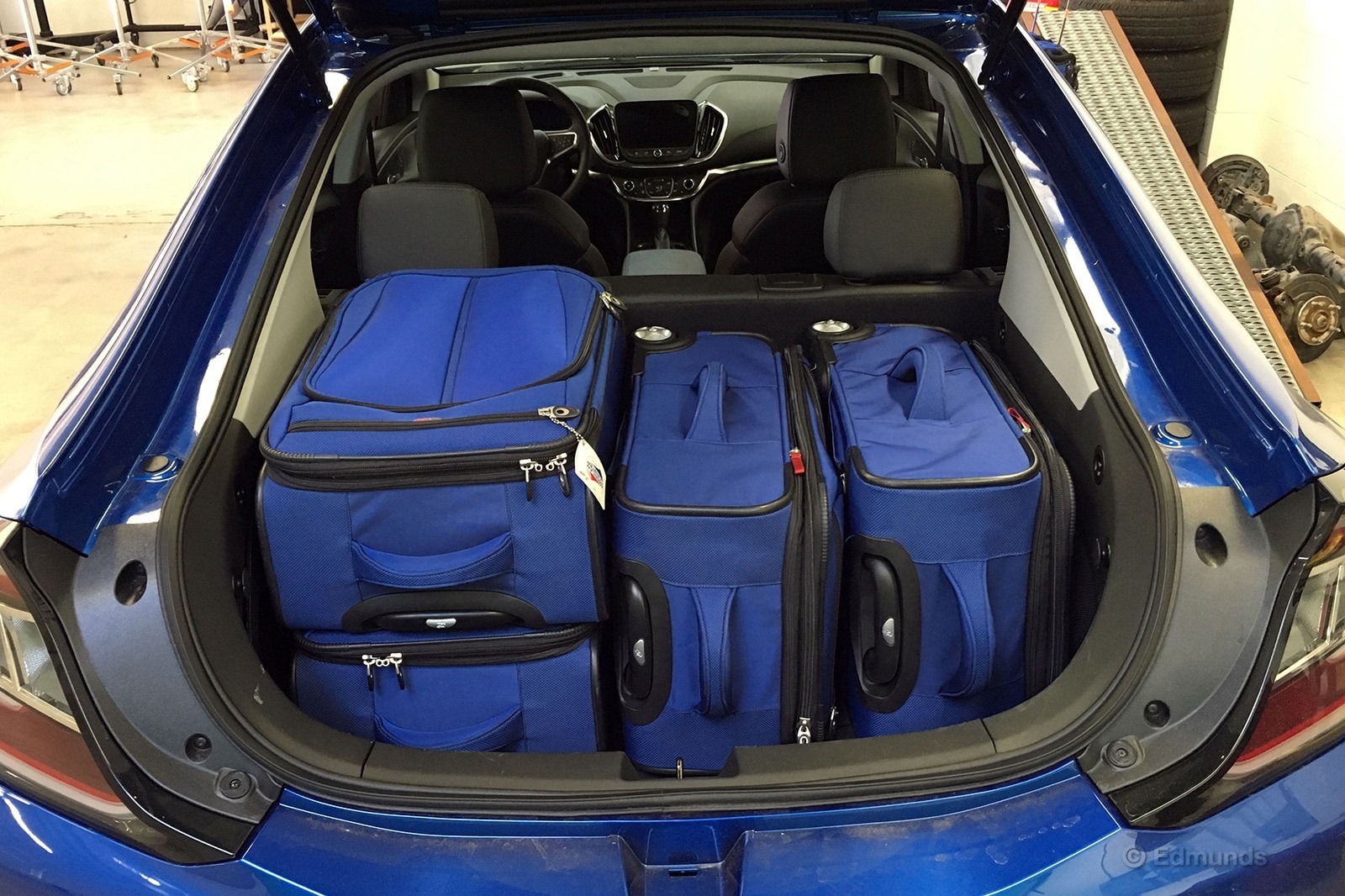
"Our luggage fit easily (behind the second row of seats) in multiple configurations, thanks to the largely square-shaped cargo floor. Interior dimensions with the second-row seatbacks in place measured approximately 29 inches deep by 38 inches wide at the wheelwells. One limitation within the space is the Volt's sloping rear hatch. We were unable to close the lid with two checked-size bags, though it fit other configurations without issue." — Mike Schmidt
Interior
"The Volt has a big hatch/cargo area, but here's one place the car reveals its compact dimensions: rear-seat footwells. There's not enough room for two grocery bags to fit lengthwise. And this is with the seat set for a 5-foot-6-inch driver. You might be able to jam them in there, at the risk of crushing your bread and bruisin' your peaches." — Dan Frio, staff writer
"Why, why, oh why, is there so much faux chrome (faume?) in the Volt's interior? I give this car a lot of credit for being comfortable (P.S. thank you, Chevy, for the extendable sun visors), but on my commute there were moments when the chrome surround of the bowtie on the steering wheel reflected the afternoon sun directly into my eyeballs. If this were my car, there'd be a piece of tape permanently affixed to the center of the steering wheel." — Will Kaufman, associate staff writer
Audio and Technology
"After five minutes I was in business and on the road, where the system worked beautifully. And I mean that literally because the full-width Google Maps and the audio and phone display graphics looked great. That's right: Google Maps. This alone puts Android Auto on a plane above Apple CarPlay, which forces you to use the dreaded Apple Maps. As with CarPlay, pressing and holding the voice control button bypasses the GM voicemail and jumps to Android voice commands, which understand natural language amazingly well." — Dan Edmunds, director of vehicle testing
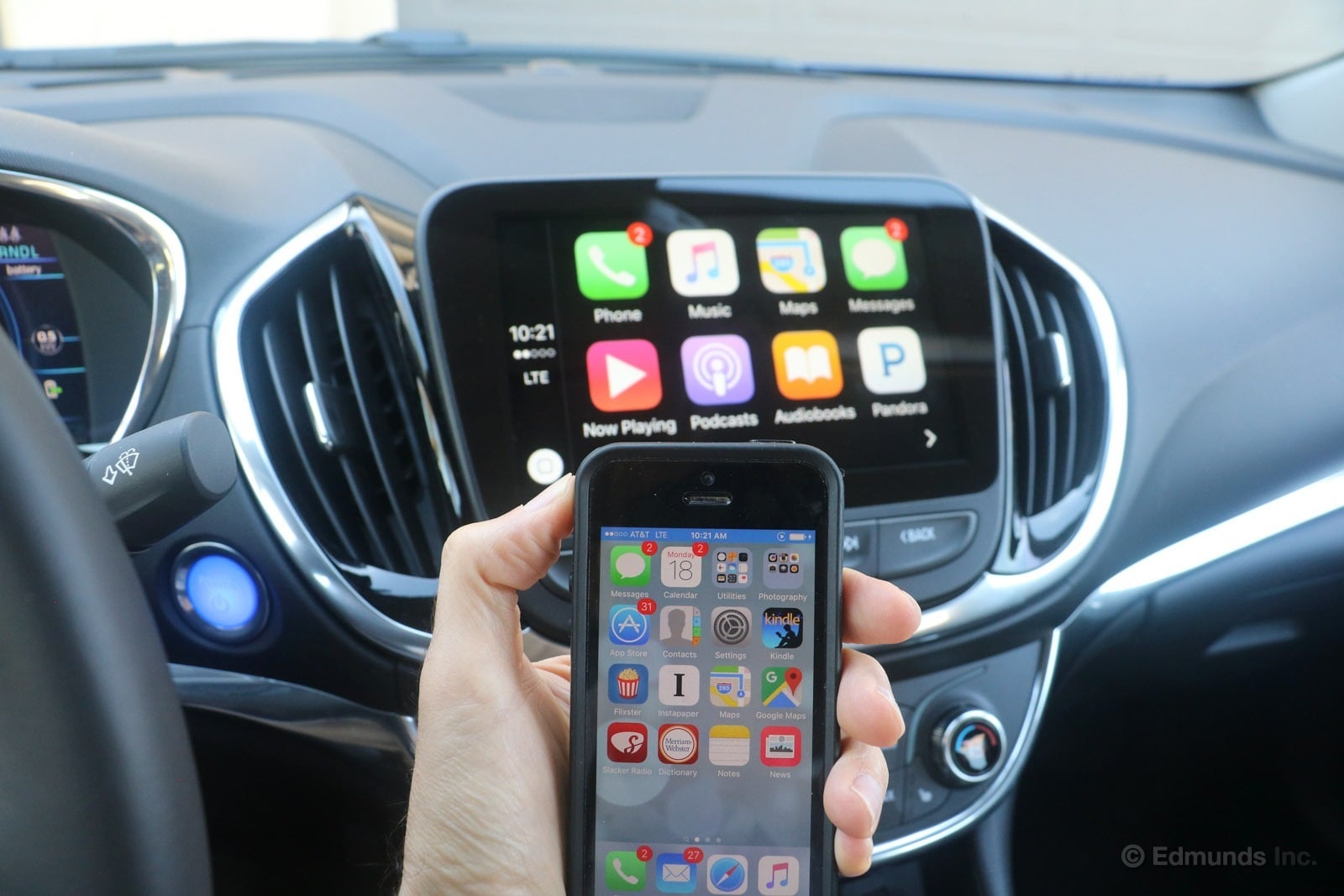
"One annoyance is related to the handshake between the Volt and the iPhone 6. The Volt has Apple CarPlay, which is fine, but CarPlay doesn't put Waze on the Volt's screen. No big deal since Waze alerts come over the car's speakers if the phone is plugged in.
"But what happens next is where the annoyance sets in. Immediately following a Waze alert (or, I suspect, similar such actions from apps running natively on the phone), the Volt's audio system always switches over to playing your phone's music. Doesn't matter if you were on FM or XM, you're now listening to your phone's music. Constantly switching back to XM after every Waze alert grew particularly aggravating on my long trip. Eventually I simply unplugged my phone. In fairness, this hiccup might be an Apple issue and not a Volt issue." — Jason Kavanagh, senior road test engineer
Maintenance
"When I arrived, Fernando cheerfully gave me the key and had me sign an invoice for the oil change, tire rotation and three recall checks. Dealerships catch a lot of online flak for their service operations, but I got nothing but good vibes from the folks at Hooman. I would look forward to visiting them again." — Josh Sadlier, senior manager, content strategy
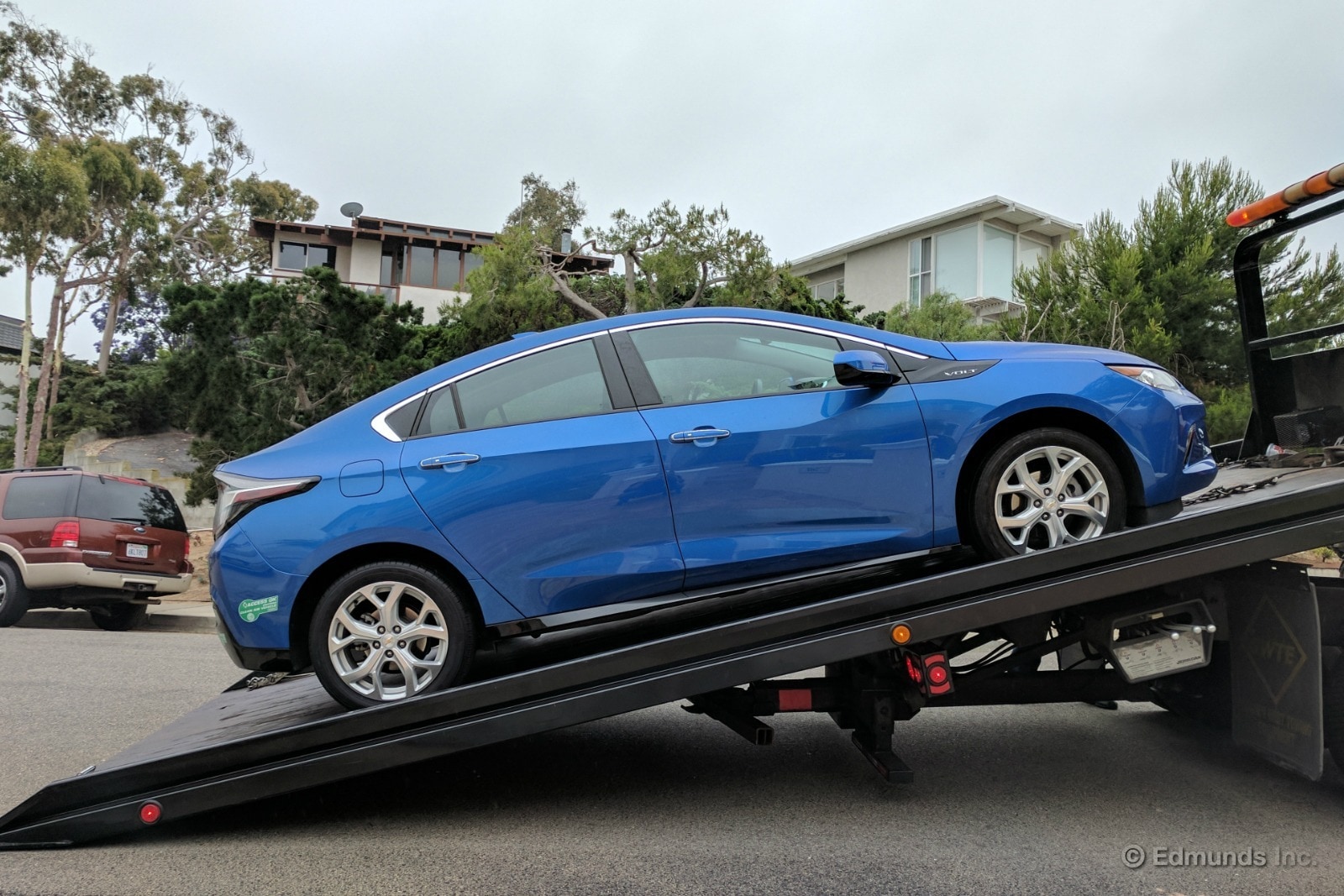
"A flat tire may not top the official list of 'Bad Ways to Start Your Morning,' but it's certainly among the more frustrating. Alas, that's how my Wednesday started." — Carlos Lago, senior writer
Miscellaneous
"I continue to recommend the Volt widely to people who ask me for shopping advice. It's a legit EV with 60-plus miles of electric range, it's an equally legit hybrid once the battery runs down, it's admirably refined on the road, and its compact size makes it a cinch to park. I still wish it looked cooler, and I could do without the ginormous gold bow-tie badges (seriously, I wonder if Chevy's lost some sales because of that dorky emblem). But from an engineering and driving perspective, this car is a home run. Deserves so much more attention than it gets." — Josh Sadlier
"This week marked my first non-EV experience in the Volt. The only noteworthy thing about the experience was how uneventful it was. You hear a little thrum from the engine and maybe a small vibration, but otherwise the Volt behaves almost exactly like it does in EV mode. Pretty remarkable stuff, especially compared to the noisy range-extender engine in the BMW i3." — Carlos Lago
Maintenance & Repairs
Regular Maintenance:
GM recommends routine service in 7,500-mile intervals. Under the Chevrolet Complete Care free maintenance plan, our 7,500- and 15,000-mile visits were free. Due to some confusion at 22,500 miles, we paid $45 even though the visit fell within the free period.
As for non-routine maintenance, we had that, too. We bought a new Michelin Premier A/S tire after a flat damaged the original irreparably and the emergency tire goo wouldn't seal. A second flat called for a second tow, stranding us again. But at least it could be patched. A dead 12-volt battery left us hanging for the third time during our test, though we eventually limped it to the dealer for replacement. A windshield chip repair and traffic accident rounded out the last of our extracurricular excitement.
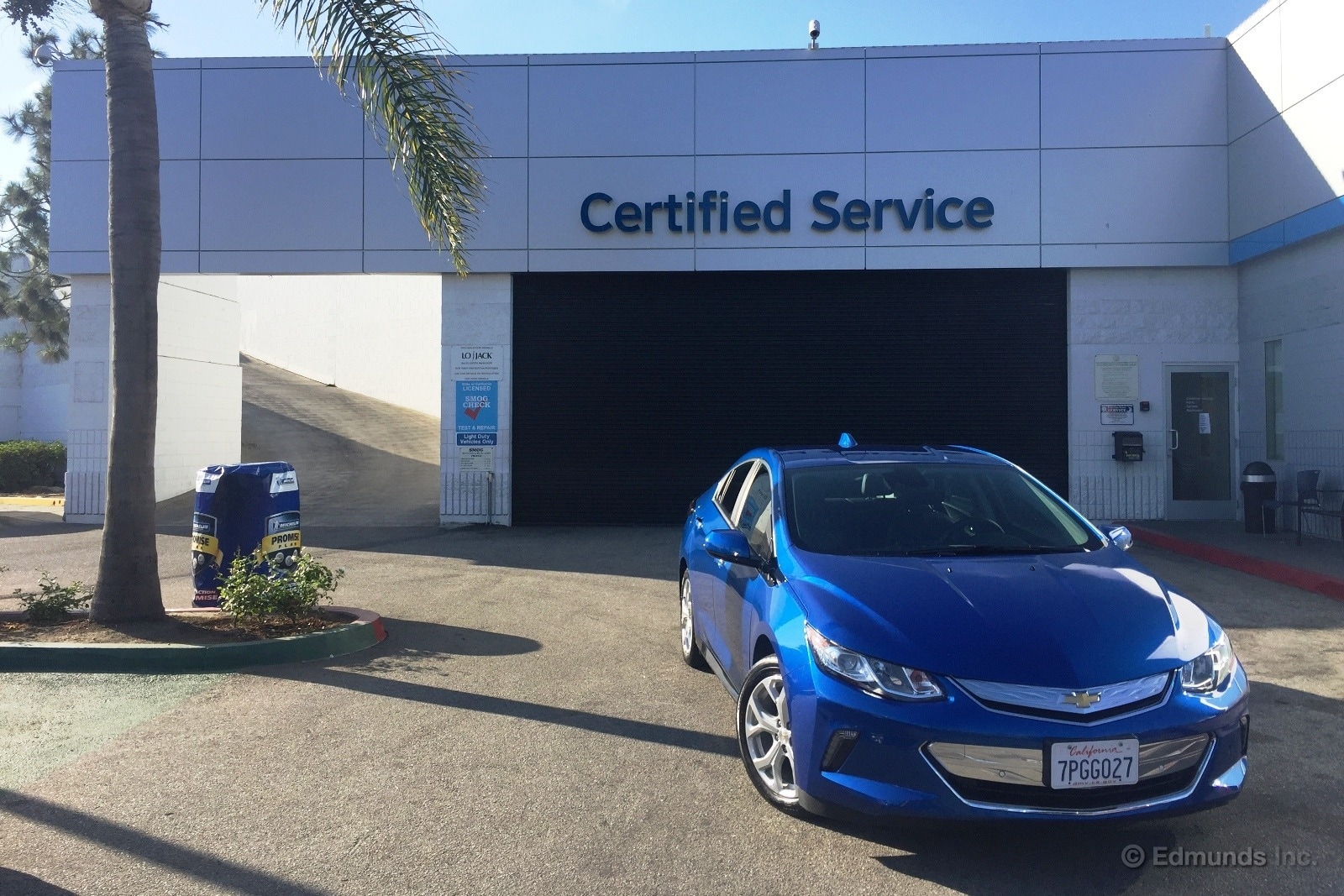
Service Campaigns:
Recalls were resolved in a timely manner, and in our case, each was performed during routine service. In order of repair:
Recall 38240: Confirm seat track locking pin is intact.
Recall 27660: Update power inverter module software.
Recall 40240: Inspect the fuel feed pipe for leaks.
Recall 16055: Reprogram the hybrid computer.
Recall 17058: Reprogram power inverter module.
Recall 39570: Recalibrate front view camera.
Recall P0442: Correct emission pipe contacting A/C hose.
Fuel Economy and Resale Value
Observed Fuel Economy:
According to EPA estimates, the Volt's gas engine is rated at 42 mpg. We averaged a bit less — 37.3 mpg — while covering almost 29,000 miles. The EPA estimates the Volt's all-electric range at 53 miles. At 51.8 miles, we came pretty close, and twice we managed to drive the Volt more than 70 miles on a full charge.
Resale and Depreciation:
We purchased the Volt for $38,114 two years ago. After 28,992 miles, the Edmunds TMV Calculator valued the car at $19,763. We headed to CarMax and accepted its offer of $20,000. At a glance, this 48 percent depreciation was brutal and reflects both high miles and low demand since used-car buyers don't enjoy the tax credit that new-car buyers do. So let's factor in the rebates.
If we subtract the $7,500 federal and $1,500 California rebates from the price, our Volt cost us $29,114. At this price, depreciation was 31 percent. Our 2011 Volt depreciated just 14 percent, although it had half as many miles at the time of sale.
Summing Up
Pros:
Free scheduled maintenance. Max electric-only range upward of 70 miles. Gasoline-only fuel economy around 40 mpg. Innovative tech. Available federal and state tax rebates.
Cons:
Lacked long-distance seat comfort. Several recall campaigns. CarPlay and Android Auto hiccups. No spare tire.
Bottom Line:
If we look past the series of recalls, seat discomfort and occasional phone integration glitches, this Volt is arguably the best plug-in hybrid on the road.
| Total Body Repair Costs: | $7123.24 |
| Total Routine Maintenance Costs: | $45.70 (over 23 months) |
| Additional Maintenance Costs: | $354.02 |
| Warranty Repairs: | Replace 12-volt battery; recalls: 38240, 27660, 40240, 16055, 17058, 39570, P0442 |
| Non-Warranty Repairs: | Replace tire; patch tire; repair windshield chip |
| Scheduled Dealer Visits: | 3 |
| Unscheduled Dealer Visits: | 3 |
| Days Out of Service: | 37 |
| Breakdowns Stranding Driver: | 3 |
| EPA Fuel Economy Rating: | 42 mpg |
| Average Lifetime Fuel Economy: | 37.3 mpg |
| EPA Electric Range Rating: | 53 miles |
| Average Electric Range: | 51.8 miles |
| Best Electric Range: | 74.8 miles |
| True Market Value at service End: | $19,763 (private-party sale) |
| What It Sold For: | $20,000 |
| Depreciation, ignoring tax credits: | $18,114 (48% of paid price) |
| Depreciation, including tax credits: | $9,114 (31% of price, less tax credit) |
| Final Odometer Reading: | 28,992 miles |
Edmunds purchased this vehicle for the purposes of evaluation.